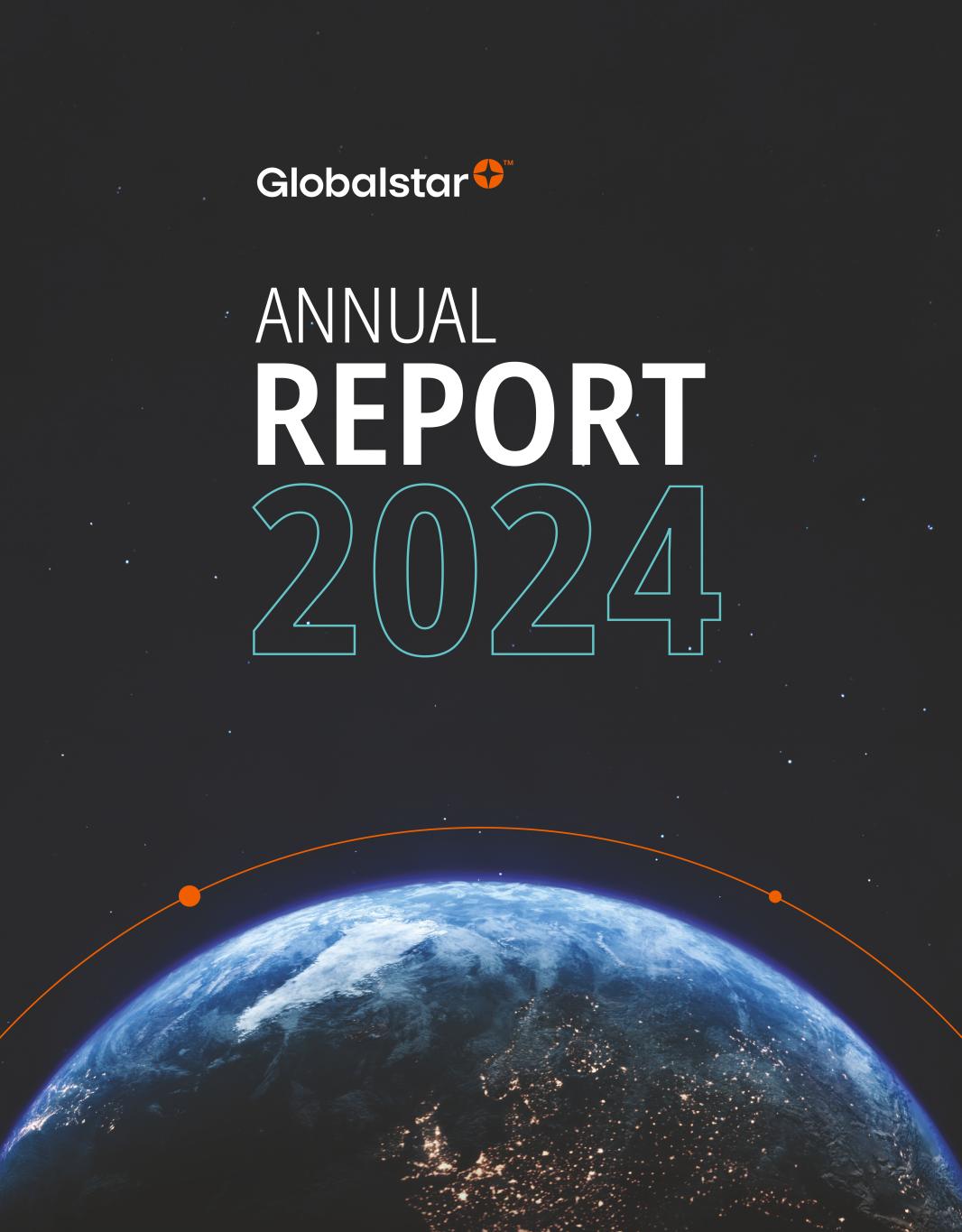
2 Dear Stockholders, As we reflect on the achievements of 2024, I am proud of our strengthened position as a leader in both satellite and terrestrial connectivity markets. This past year has been transformative, marked by strategic milestones, technological advancements, and financial growth that have collectively enhanced our competitive edge, enabling our next phase of growth. During the last twelve months, we have actively engaged with you - our stockholders - as well as industry leaders and other supporters of Globalstar in various forums. In December, it was a pleasure meeting with so many of you during our analyst and investor day, where our executive leadership team outlined our strategic priorities and growth strategy as well as provided updates to our short and long-term financial outlook. These presentations and several customer panels during the event are available for replay on Globalstar’s investor relations website under “Events and Presentations”. Globalstar also had a strong presence at Mobile World Congress in Barcelona, Spain in March 2025. At this premier mobile technology event, we were able to showcase our diverse solution set of connectivity products and services, including a live demonstration of XCOM RAN utilizing Globalstar’s Band 53TM, a milestone described in more detail below. We also hosted the International Telecommunication Union (ITU) Secretary General, Doreen Bogdan-Martin, and her delegation at Globalstar’s booth to express our support for the ITU’s Partner2Connect initiative, as well as held meetings with other international administrations’ delegations who were in attendance. Also in March, we held a grand opening of Globalstar’s new satellite operations control center at the Company’s headquarters in Covington, Louisiana. This milestone marks a significant expansion of our operational capabilities and reinforces our strategic growth as we extend our current network with capabilities for next-generation satellite and connectivity solutions. The grand opening event was attended by notable representatives and local dignitaries, including House Majority Leader Steve Scalise and FCC Chairman Brendan Carr. Operational Highlights and Strategic Developments During the last twelve months, we have seen remarkable progress in our product development capabilities. Under new leadership, our team successfully delivered a full two-way satellite commercial IoT solution, transitioning from our previous one-way tracking and telemetry applications. We believe that this advancement positions us to compete aggressively for subscribers in existing markets ripe for disruption. The globally harmonized L- and S-band mobile satellite spectrum that has been licensed to us for over 30 years continues to provide a stable platform for innovating connectivity solutions. We believe that we have the most successful and well-utilized mobile satellite service (“MSS”) band, with plans to further intensify the usage of our licensed spectrum. Our bent pipe architecture further differentiates Globalstar, allowing for rapid deployment of new innovations while others either borrow spectrum or deploy additional satellites to match our capabilities. ANNUAL REPORT 2024 1 2024 ANNUAL REPORT Globalstar.com 1351 Holiday Square Blvd | Covington, LA 70433 | 877-452-5782
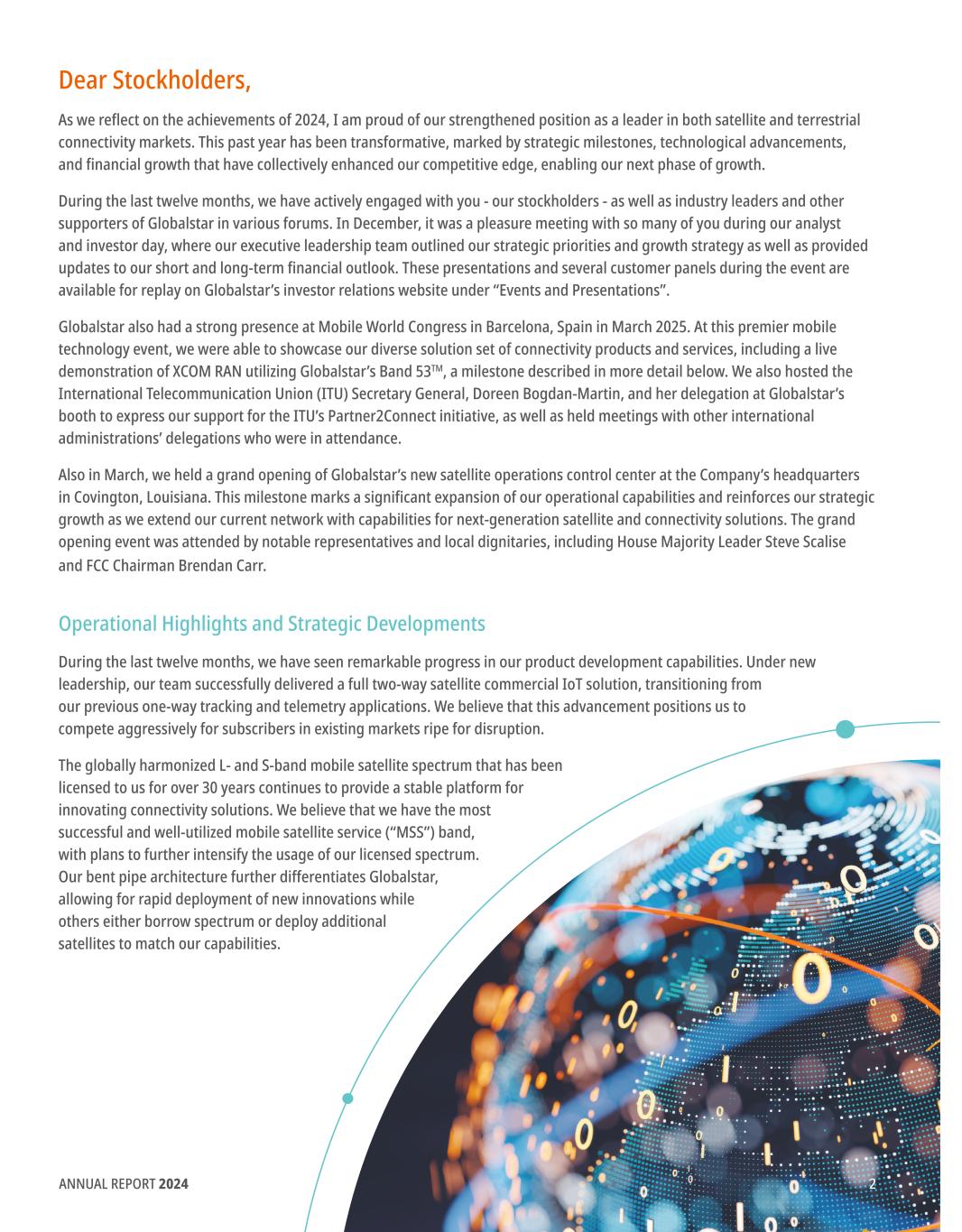
2 Dear Stockholders, As we reflect on the achievements of 2024, I am proud of our strengthened position as a leader in both satellite and terrestrial connectivity markets. This past year has been transformative, marked by strategic milestones, technological advancements, and financial growth that have collectively enhanced our competitive edge, enabling our next phase of growth. During the last twelve months, we have actively engaged with you - our stockholders - as well as industry leaders and other supporters of Globalstar in various forums. In December, it was a pleasure meeting with so many of you during our analyst and investor day, where our executive leadership team outlined our strategic priorities and growth strategy as well as provided updates to our short and long-term financial outlook. These presentations and several customer panels during the event are available for replay on Globalstar’s investor relations website under “Events and Presentations”. Globalstar also had a strong presence at Mobile World Congress in Barcelona, Spain in March 2025. At this premier mobile technology event, we were able to showcase our diverse solution set of connectivity products and services, including a live demonstration of XCOM RAN utilizing Globalstar’s Band 53TM, a milestone described in more detail below. We also hosted the International Telecommunication Union (ITU) Secretary General, Doreen Bogdan-Martin, and her delegation at Globalstar’s booth to express our support for the ITU’s Partner2Connect initiative, as well as held meetings with other international administrations’ delegations who were in attendance. Also in March, we held a grand opening of Globalstar’s new satellite operations control center at the Company’s headquarters in Covington, Louisiana. This milestone marks a significant expansion of our operational capabilities and reinforces our strategic growth as we extend our current network with capabilities for next-generation satellite and connectivity solutions. The grand opening event was attended by notable representatives and local dignitaries, including House Majority Leader Steve Scalise and FCC Chairman Brendan Carr. Operational Highlights and Strategic Developments During the last twelve months, we have seen remarkable progress in our product development capabilities. Under new leadership, our team successfully delivered a full two-way satellite commercial IoT solution, transitioning from our previous one-way tracking and telemetry applications. We believe that this advancement positions us to compete aggressively for subscribers in existing markets ripe for disruption. The globally harmonized L- and S-band mobile satellite spectrum that has been licensed to us for over 30 years continues to provide a stable platform for innovating connectivity solutions. We believe that we have the most successful and well-utilized mobile satellite service (“MSS”) band, with plans to further intensify the usage of our licensed spectrum. Our bent pipe architecture further differentiates Globalstar, allowing for rapid deployment of new innovations while others either borrow spectrum or deploy additional satellites to match our capabilities. ANNUAL REPORT 2024 Headquarters Globalstar, Inc. 1351 Holiday Square Blvd. Covington, LA 70433 USA (985) 335-1500 Company Website www.globalstar.com Stockholder Information For further information about the Company, hard copies of this Report, SEC filings, and other published corporate information, please visit the Company ’s website noted above. Additionally, copies will be furnished, without charge, to any stockholder of the Company entitled to vote at the Annual Meeting, upon written request to the investor relations department at email provided below. Transfer Agent Computershare Canton, MA Independent Auditors Ernst & Young, LLP New Orleans, LA Legal Counsel Jones Walker, LLP New Orleans, LA Investor Relations investorrelations@globalstar.com Board of Directors James Monroe III Executive Chairman of the Board Thermo Companies Dr. Paul E. Jacobs Director and Chief Executive Officer, Globalstar, Inc. James F. Lynch Director Thermo Companies William A. Hasler Director Benjamin G. Wolff Director Palladyne AI Keith O. Cowan Director Rivada Networks, Inc. Timothy E. Taylor Director and Vice President, Finance, Business Operations, & Strategy Globalstar, Inc. Thermo Companies Executive Officers Dr. Paul E. Jacobs Director and Chief Executive Officer, Globalstar, Inc. James Monroe III Executive Chairman of the Board Rebecca S. Clary Vice President, Chief Financial Officer L. Barbee Ponder IV General Counsel and Vice President, Regulatory Affairs Corporate Secretary Richard S. Roberts Corporate Secretary Common Stock The Company’s common stock is traded on The Nasdaq Stock Market LLC under the symbol “GSAT.” As of March 25, 2025, the Company had 126,582,094 shares outsta nding and 287 holders of record.

Further, in 2024, we secured a 15-year renewal of our HIBLEO-4 Satellite and Blanket Mobile Earth Terminal Authorizations from the FCC, ensuring continued authority to operate our low Earth orbit constellation and mobile earth terminals throughout the United States and its territories. This achievement follows our earlier success in obtaining terrestrial authority in Mexico during the fourth quarter of 2024, reinforcing our operational foundation and expanding our market reach. On the operational front, we completed two significant corporate actions that underscore our strategic evolution. First, we successfully uplisted to the NASDAQ Global Select Market, increasing our visibility within the investment community. Concurrently, we implemented a 1-for-15 reverse stock split designed to normalize our outstanding shares relative to industry peers, improve trading fundamentals, and meet institutional minimum stock price requirements, aligning with our strategy to attract a broader investor base. Commercial Developments Across Key Business Areas Wholesale Consumer We continue to support direct-to-device service to our wholesale capacity customer and remain on track to deliver scheduled milestones for the service. During 2024, we executed updated services agreements with our wholesale customer, which include the development of a next-generation satellite constellation, expanded ground infrastructure, and MSS rights in additional countries (the “Expanded MSS Network”). To date, we have received $0.9 billion of the total $1.7 billion investment from our customer under these updated services agreements. We will retain 100% of all terrestrial, MSS, and other revenue while continuing to allocate 85% of our network capacity for satellite services to the customer across both existing and new satellites. The remaining 15% capacity will continue serving our direct MSS customers, ensuring we maintain our commitment to our diverse and growing service offerings and customer base. XCOM RAN Our XCOM RAN technology is a differentiated, high-performance 5G architecture enabling automation, industrial 5G, and critical infrastructure applications. We have strategically focused on high-value market segments, including warehouse automation, dense industrial 4.0 environments, manufacturing facilities, ports, and logistics operations. A major global retailer is currently deploying our technology as a proof of concept, with ongoing implementation expected. Band n53 Our Band n53 spectrum asset has expanded its reach and is now deployed in 12 countries covering nearly 1 billion people, including 100% coverage across the United States, Canada, and Mexico. This strategic spectrum asset enables mission-critical applications and offers potential for aggregation with CBRS for expanded capabilities. XCOM RAN and Band n53 Integration We achieved a significant milestone at our analyst and investor day in December 2024, when we successfully completed the first 5G data call on our Band n53 spectrum. In March 2025, we again showcased this integration at Mobile World Congress in a full-scale, over-the-air demonstration, delivering impressive speeds of 400 megabits per second in 10 megahertz of spectrum. This breakthrough enables advanced applications such as robotics, autonomous vehicles, and augmented reality while offering our partners a versatile, fully licensed channel for enhanced wireless connectivity. The test, conducted using XCOM RAN radios and state-of-the-art 5G modules, validates the utility of the Band n53 spectrum for even the most cutting-edge mobile applications. We expect this system to be available for commercial deployment in the second quarter of 2025. ANNUAL REPORT 2024
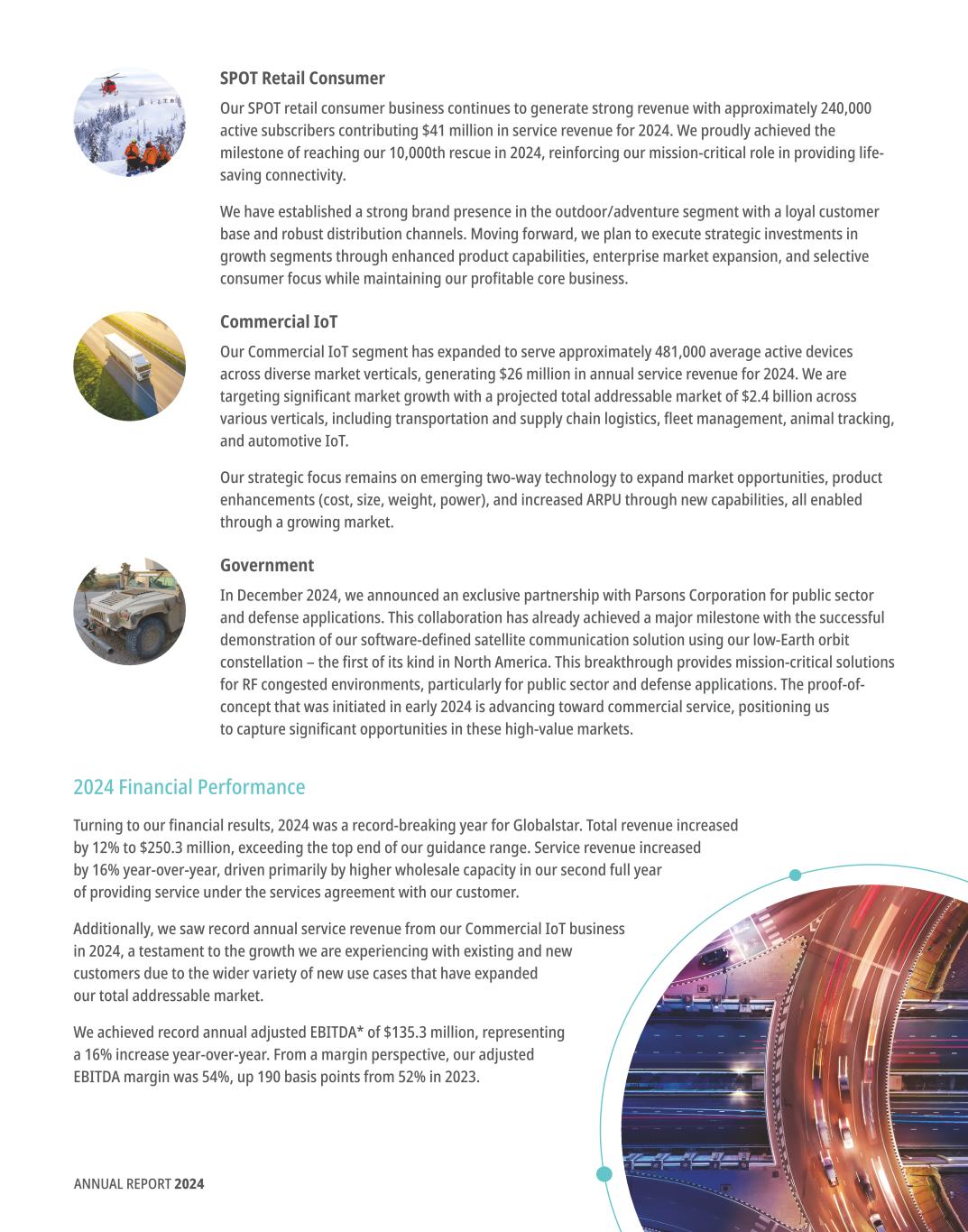
SPOT Retail Consumer Our SPOT retail consumer business continues to generate strong revenue with approximately 240,000 active subscribers contributing $41 million in service revenue for 2024. We proudly achieved the milestone of reaching our 10,000th rescue in 2024, reinforcing our mission-critical role in providing life- saving connectivity. We have established a strong brand presence in the outdoor/adventure segment with a loyal customer base and robust distribution channels. Moving forward, we plan to execute strategic investments in growth segments through enhanced product capabilities, enterprise market expansion, and selective consumer focus while maintaining our profitable core business. Commercial IoT Our Commercial IoT segment has expanded to serve approximately 481,000 average active devices across diverse market verticals, generating $26 million in annual service revenue for 2024. We are targeting significant market growth with a projected total addressable market of $2.4 billion across various verticals, including transportation and supply chain logistics, fleet management, animal tracking, and automotive IoT. Our strategic focus remains on emerging two-way technology to expand market opportunities, product enhancements (cost, size, weight, power), and increased ARPU through new capabilities, all enabled through a growing market. Government In December 2024, we announced an exclusive partnership with Parsons Corporation for public sector and defense applications. This collaboration has already achieved a major milestone with the successful demonstration of our software-defined satellite communication solution using our low-Earth orbit constellation – the first of its kind in North America. This breakthrough provides mission-critical solutions for RF congested environments, particularly for public sector and defense applications. The proof-of- concept that was initiated in early 2024 is advancing toward commercial service, positioning us to capture significant opportunities in these high-value markets. 2024 Financial Performance Turning to our financial results, 2024 was a record-breaking year for Globalstar. Total revenue increased by 12% to $250.3 million, exceeding the top end of our guidance range. Service revenue increased by 16% year-over-year, driven primarily by higher wholesale capacity in our second full year of providing service under the services agreement with our customer. Additionally, we saw record annual service revenue from our Commercial IoT business in 2024, a testament to the growth we are experiencing with existing and new customers due to the wider variety of new use cases that have expanded our total addressable market. We achieved record annual adjusted EBITDA* of $135.3 million, representing a 16% increase year-over-year. From a margin perspective, our adjusted EBITDA margin was 54%, up 190 basis points from 52% in 2023. ANNUAL REPORT 2024 ANNUAL REPORT 2024

2025 Outlook For 2025, we are forecasting revenue between $260 million and $285 million, representing 9% year-over-year growth at the midpoint, with an adjusted EBITDA margin of approximately 50%. The projected margin reflects short-term compression driven by strategic investments to support long-term growth initiatives, primarily relating to further development of our XCOM RAN terrestrial solution and expansion of our MSS product portfolio. Looking further ahead, during the first full year of service provided over the Expanded MSS Network, we expect total revenue to double from the 2024 amount, reaching $500 million, and to generate robust margins in excess of 54%. This forecast excludes certain key growth opportunities that are difficult to forecast with precision, such as large terrestrial spectrum and XCOM RAN deployments, although we remain confident in their future contributions. Closing Remarks In summary, Globalstar is well-positioned to continue executing on its long-term growth strategy. The investments we’ve made are yielding tangible results, and we are excited about the opportunities that lie ahead in 2025 and beyond. We have spent significant time identifying markets where we can grow and design proprietary solutions to address customer needs for years to come. We have strengthened our team with professionals who know how to win, grow, and scale businesses, and I cannot be more excited about our future. Our direct-to-device leadership, spectrum advantages, and innovative technologies set us apart in an increasingly competitive landscape. With our strong financial foundation and clear strategic direction, we remain committed to creating sustainable, long-term value for our stockholders. Thank you for your continued support and confidence in Globalstar. Sincerely, Paul Jacobs Chief Executive Officer Globalstar, Inc. ANNUAL REPORT 2024 * Adjusted EBITDA is a non-GAAP financial measure. For more information, refer to “Reconciliation of GAAP Net Loss to Non-GAAP Adjusted EBITDA” following this letter.

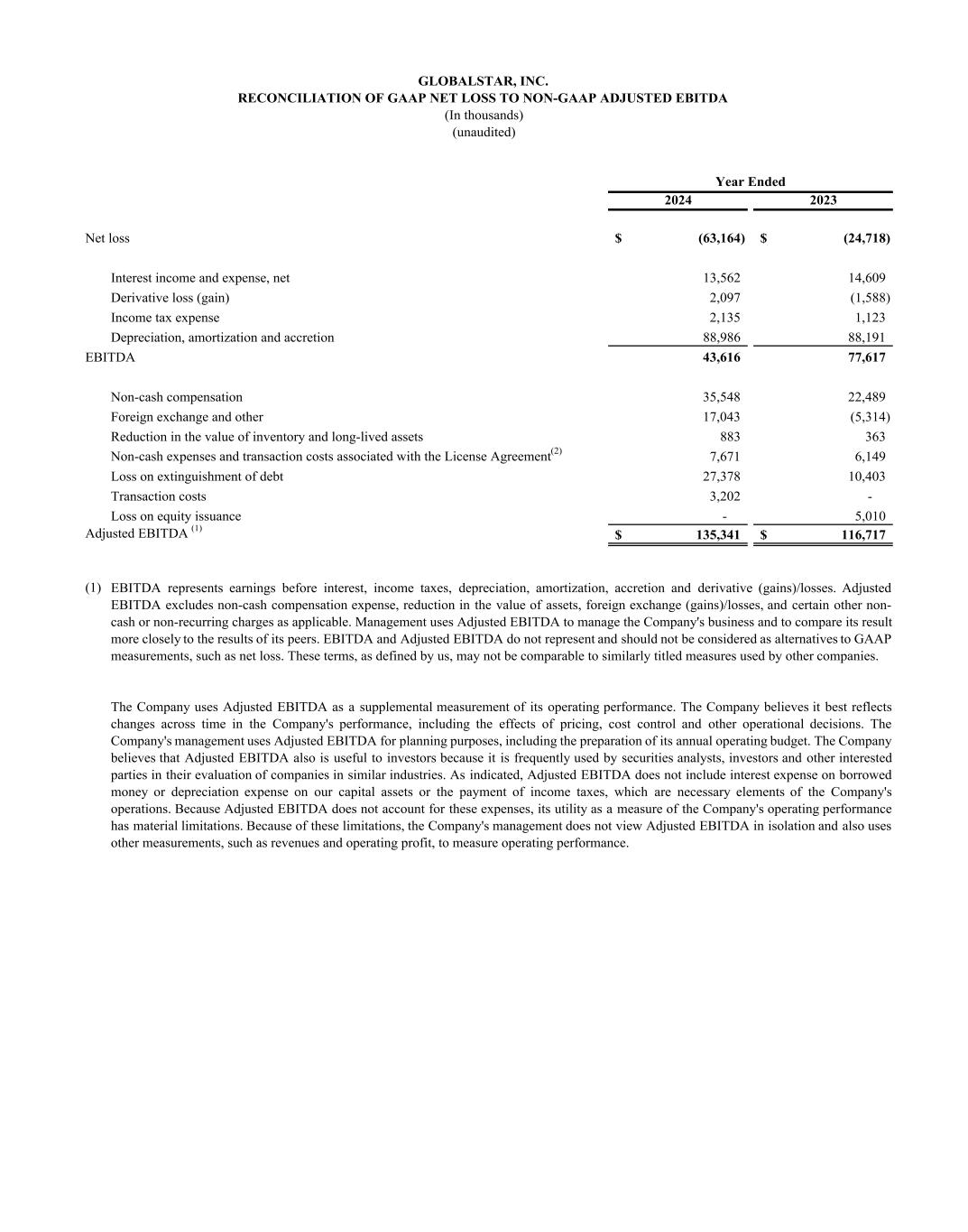
2024 2023 Net loss (63,164)$ (24,718)$ Interest income and expense, net 13,562 14,609 Derivative loss (gain) 2,097 (1,588) Income tax expense 2,135 1,123 Depreciation, amortization and accretion 88,986 88,191 EBITDA 43,616 77,617 Non-cash compensation 35,548 22,489 Foreign exchange and other 17,043 (5,314) Reduction in the value of inventory and long-lived assets 883 363 Non-cash expenses and transaction costs associated with the License Agreement (2) 7,671 6,149 Loss on extinguishment of debt 27,378 10,403 Transaction costs 3,202 - Loss on equity issuance - 5,010 Adjusted EBITDA (1) 135,341$ 116,717$ (1) EBITDA represents earnings before interest, income taxes, depreciation, amortization, accretion and derivative (gains)/losses. Adjusted EBITDA excludes non-cash compensation expense, reduction in the value of assets, foreign exchange (gains)/losses, and certain other non- cash or non-recurring charges as applicable. Management uses Adjusted EBITDA to manage the Company's business and to compare its result more closely to the results of its peers. EBITDA and Adjusted EBITDA do not represent and should not be considered as alternatives to GAAP measurements, such as net loss. These terms, as defined by us, may not be comparable to similarly titled measures used by other companies. The Company uses Adjusted EBITDA as a supplemental measurement of its operating performance. The Company believes it best reflects changes across time in the Company's performance, including the effects of pricing, cost control and other operational decisions. The Company's management uses Adjusted EBITDA for planning purposes, including the preparation of its annual operating budget. The Company believes that Adjusted EBITDA also is useful to investors because it is frequently used by securities analysts, investors and other interested parties in their evaluation of companies in similar industries. As indicated, Adjusted EBITDA does not include interest expense on borrowed money or depreciation expense on our capital assets or the payment of income taxes, which are necessary elements of the Company's operations. Because Adjusted EBITDA does not account for these expenses, its utility as a measure of the Company's operating performance has material limitations. Because of these limitations, the Company's management does not view Adjusted EBITDA in isolation and also uses other measurements, such as revenues and operating profit, to measure operating performance. GLOBALSTAR, INC. RECONCILIATION OF GAAP NET LOSS TO NON-GAAP ADJUSTED EBITDA (In thousands) (unaudited) Year Ended

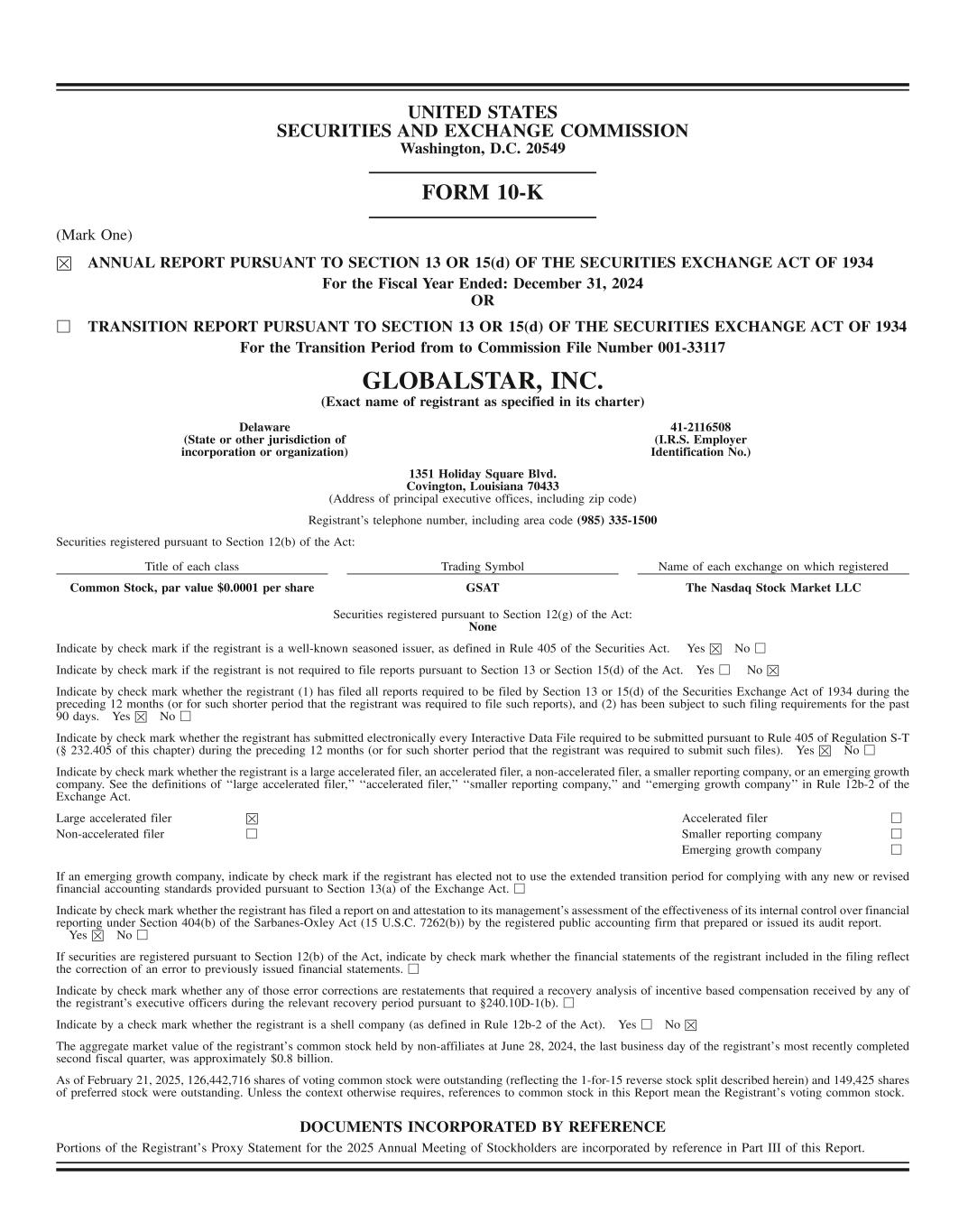
UNITED STATES SECURITIES AND EXCHANGE COMMISSION Washington, D.C. 20549 FORM 10-K (Mark One) ☒ ANNUAL REPORT PURSUANT TO SECTION 13 OR 15(d) OF THE SECURITIES EXCHANGE ACT OF 1934 For the Fiscal Year Ended: December 31, 2024 OR □ TRANSITION REPORT PURSUANT TO SECTION 13 OR 15(d) OF THE SECURITIES EXCHANGE ACT OF 1934 For the Transition Period from to Commission File Number 001-33117 GLOBALSTAR, INC. (Exact name of registrant as specified in its charter) Delaware (State or other jurisdiction of incorporation or organization) 41-2116508 (I.R.S. Employer Identification No.) 1351 Holiday Square Blvd. Covington, Louisiana 70433 (Address of principal executive offices, including zip code) Registrant’s telephone number, including area code (985) 335-1500 Securities registered pursuant to Section 12(b) of the Act: Title of each class Trading Symbol Name of each exchange on which registered Common Stock, par value $0.0001 per share GSAT The Nasdaq Stock Market LLC Securities registered pursuant to Section 12(g) of the Act: None Indicate by check mark if the registrant is a well-known seasoned issuer, as defined in Rule 405 of the Securities Act. Yes ☒ No □ Indicate by check mark if the registrant is not required to file reports pursuant to Section 13 or Section 15(d) of the Act. Yes □ No ☒ Indicate by check mark whether the registrant (1) has filed all reports required to be filed by Section 13 or 15(d) of the Securities Exchange Act of 1934 during the preceding 12 months (or for such shorter period that the registrant was required to file such reports), and (2) has been subject to such filing requirements for the past 90 days. Yes ☒ No □ Indicate by check mark whether the registrant has submitted electronically every Interactive Data File required to be submitted pursuant to Rule 405 of Regulation S-T (§ 232.405 of this chapter) during the preceding 12 months (or for such shorter period that the registrant was required to submit such files). Yes ☒ No □ Indicate by check mark whether the registrant is a large accelerated filer, an accelerated filer, a non-accelerated filer, a smaller reporting company, or an emerging growth company. See the definitions of ‘‘large accelerated filer,’’ ‘‘accelerated filer,’’ ‘‘smaller reporting company,’’ and ‘‘emerging growth company’’ in Rule 12b-2 of the Exchange Act. Large accelerated filer ☒ Accelerated filer □ Non-accelerated filer □ Smaller reporting company □ Emerging growth company □ If an emerging growth company, indicate by check mark if the registrant has elected not to use the extended transition period for complying with any new or revised financial accounting standards provided pursuant to Section 13(a) of the Exchange Act. □ Indicate by check mark whether the registrant has filed a report on and attestation to its management’s assessment of the effectiveness of its internal control over financial reporting under Section 404(b) of the Sarbanes-Oxley Act (15 U.S.C. 7262(b)) by the registered public accounting firm that prepared or issued its audit report. Yes ☒ No □ If securities are registered pursuant to Section 12(b) of the Act, indicate by check mark whether the financial statements of the registrant included in the filing reflect the correction of an error to previously issued financial statements. □ Indicate by check mark whether any of those error corrections are restatements that required a recovery analysis of incentive based compensation received by any of the registrant’s executive officers during the relevant recovery period pursuant to §240.10D-1(b). □ Indicate by a check mark whether the registrant is a shell company (as defined in Rule 12b-2 of the Act). Yes □ No ☒ The aggregate market value of the registrant’s common stock held by non-affiliates at June 28, 2024, the last business day of the registrant’s most recently completed second fiscal quarter, was approximately $0.8 billion. As of February 21, 2025, 126,442,716 shares of voting common stock were outstanding (reflecting the 1-for-15 reverse stock split described herein) and 149,425 shares of preferred stock were outstanding. Unless the context otherwise requires, references to common stock in this Report mean the Registrant’s voting common stock. DOCUMENTS INCORPORATED BY REFERENCE Portions of the Registrant’s Proxy Statement for the 2025 Annual Meeting of Stockholders are incorporated by reference in Part III of this Report.
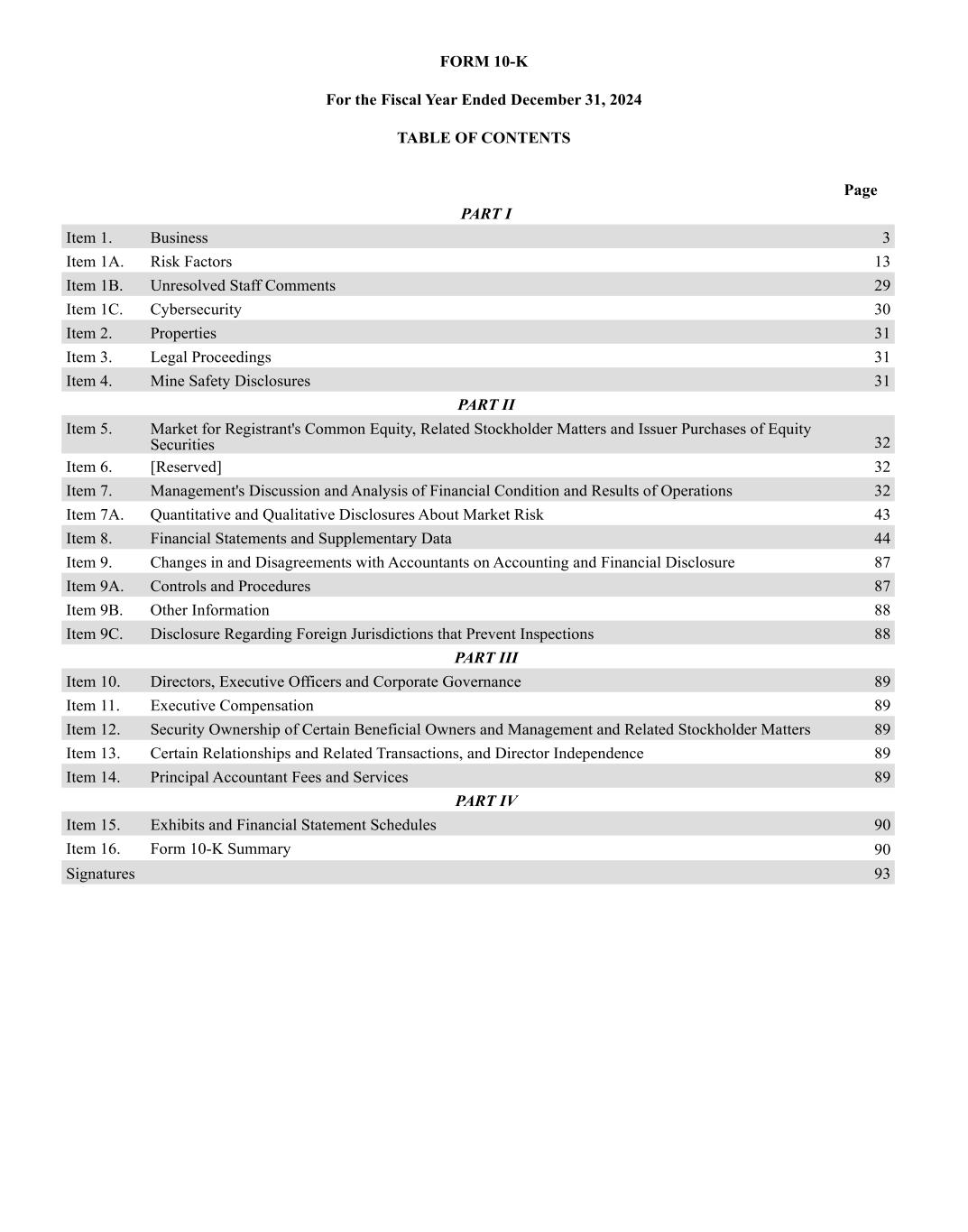
FORM 10-K For the Fiscal Year Ended December 31, 2024 TABLE OF CONTENTS Page PART I Item 1. Business 3 Item 1A. Risk Factors 13 Item 1B. Unresolved Staff Comments 29 Item 1C. Cybersecurity 30 Item 2. Properties 31 Item 3. Legal Proceedings 31 Item 4. Mine Safety Disclosures 31 PART II Item 5. Market for Registrant's Common Equity, Related Stockholder Matters and Issuer Purchases of Equity Securities 32 Item 6. [Reserved] 32 Item 7. Management's Discussion and Analysis of Financial Condition and Results of Operations 32 Item 7A. Quantitative and Qualitative Disclosures About Market Risk 43 Item 8. Financial Statements and Supplementary Data 44 Item 9. Changes in and Disagreements with Accountants on Accounting and Financial Disclosure 87 Item 9A. Controls and Procedures 87 Item 9B. Other Information 88 Item 9C. Disclosure Regarding Foreign Jurisdictions that Prevent Inspections 88 PART III Item 10. Directors, Executive Officers and Corporate Governance 89 Item 11. Executive Compensation 89 Item 12. Security Ownership of Certain Beneficial Owners and Management and Related Stockholder Matters 89 Item 13. Certain Relationships and Related Transactions, and Director Independence 89 Item 14. Principal Accountant Fees and Services 89 PART IV Item 15. Exhibits and Financial Statement Schedules 90 Item 16. Form 10-K Summary 90 Signatures 93
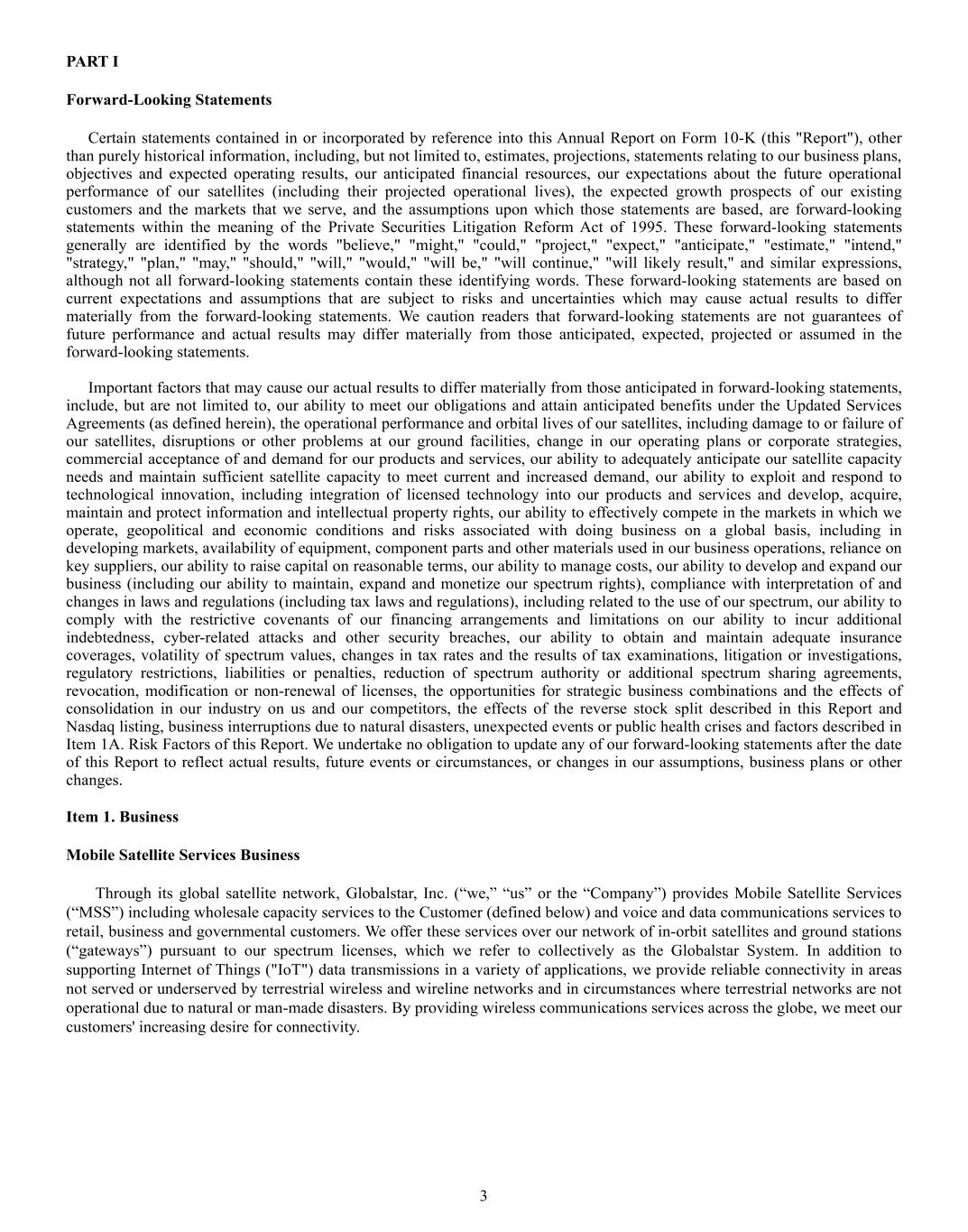
3 PART I Forward-Looking Statements Certain statements contained in or incorporated by reference into this Annual Report on Form 10-K (this "Report"), other than purely historical information, including, but not limited to, estimates, projections, statements relating to our business plans, objectives and expected operating results, our anticipated financial resources, our expectations about the future operational performance of our satellites (including their projected operational lives), the expected growth prospects of our existing customers and the markets that we serve, and the assumptions upon which those statements are based, are forward-looking statements within the meaning of the Private Securities Litigation Reform Act of 1995. These forward-looking statements generally are identified by the words "believe," "might," "could," "project," "expect," "anticipate," "estimate," "intend," "strategy," "plan," "may," "should," "will," "would," "will be," "will continue," "will likely result," and similar expressions, although not all forward-looking statements contain these identifying words. These forward-looking statements are based on current expectations and assumptions that are subject to risks and uncertainties which may cause actual results to differ materially from the forward-looking statements. We caution readers that forward-looking statements are not guarantees of future performance and actual results may differ materially from those anticipated, expected, projected or assumed in the forward-looking statements. Important factors that may cause our actual results to differ materially from those anticipated in forward-looking statements, include, but are not limited to, our ability to meet our obligations and attain anticipated benefits under the Updated Services Agreements (as defined herein), the operational performance and orbital lives of our satellites, including damage to or failure of our satellites, disruptions or other problems at our ground facilities, change in our operating plans or corporate strategies, commercial acceptance of and demand for our products and services, our ability to adequately anticipate our satellite capacity needs and maintain sufficient satellite capacity to meet current and increased demand, our ability to exploit and respond to technological innovation, including integration of licensed technology into our products and services and develop, acquire, maintain and protect information and intellectual property rights, our ability to effectively compete in the markets in which we operate, geopolitical and economic conditions and risks associated with doing business on a global basis, including in developing markets, availability of equipment, component parts and other materials used in our business operations, reliance on key suppliers, our ability to raise capital on reasonable terms, our ability to manage costs, our ability to develop and expand our business (including our ability to maintain, expand and monetize our spectrum rights), compliance with interpretation of and changes in laws and regulations (including tax laws and regulations), including related to the use of our spectrum, our ability to comply with the restrictive covenants of our financing arrangements and limitations on our ability to incur additional indebtedness, cyber-related attacks and other security breaches, our ability to obtain and maintain adequate insurance coverages, volatility of spectrum values, changes in tax rates and the results of tax examinations, litigation or investigations, regulatory restrictions, liabilities or penalties, reduction of spectrum authority or additional spectrum sharing agreements, revocation, modification or non-renewal of licenses, the opportunities for strategic business combinations and the effects of consolidation in our industry on us and our competitors, the effects of the reverse stock split described in this Report and Nasdaq listing, business interruptions due to natural disasters, unexpected events or public health crises and factors described in Item 1A. Risk Factors of this Report. We undertake no obligation to update any of our forward-looking statements after the date of this Report to reflect actual results, future events or circumstances, or changes in our assumptions, business plans or other changes. Item 1. Business Mobile Satellite Services Business Through its global satellite network, Globalstar, Inc. (“we,” “us” or the “Company”) provides Mobile Satellite Services (“MSS”) including wholesale capacity services to the Customer (defined below) and voice and data communications services to retail, business and governmental customers. We offer these services over our network of in-orbit satellites and ground stations (“gateways”) pursuant to our spectrum licenses, which we refer to collectively as the Globalstar System. In addition to supporting Internet of Things ("IoT") data transmissions in a variety of applications, we provide reliable connectivity in areas not served or underserved by terrestrial wireless and wireline networks and in circumstances where terrestrial networks are not operational due to natural or man-made disasters. By providing wireless communications services across the globe, we meet our customers' increasing desire for connectivity.
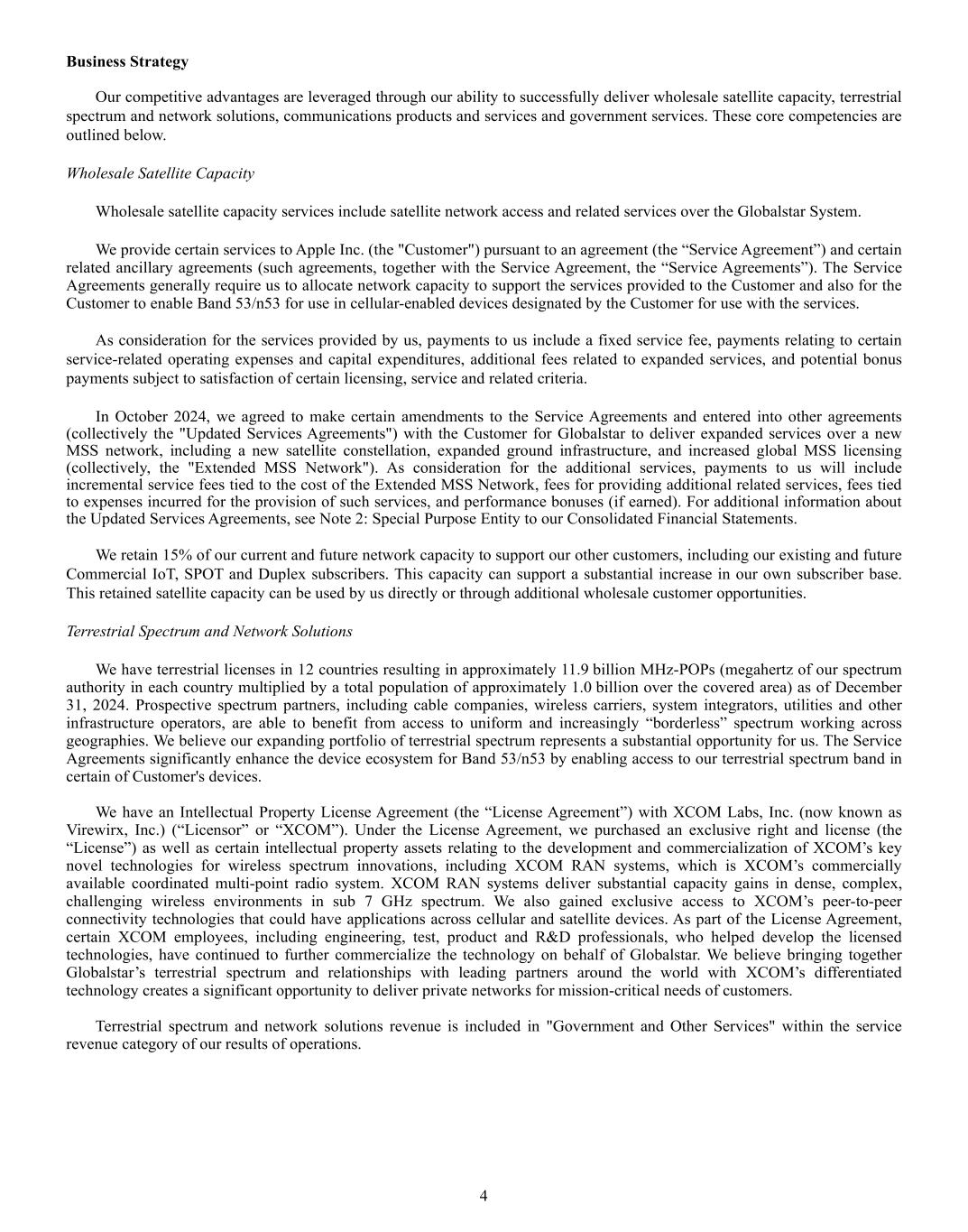
4 Business Strategy Our competitive advantages are leveraged through our ability to successfully deliver wholesale satellite capacity, terrestrial spectrum and network solutions, communications products and services and government services. These core competencies are outlined below. Wholesale Satellite Capacity Wholesale satellite capacity services include satellite network access and related services over the Globalstar System. We provide certain services to Apple Inc. (the "Customer") pursuant to an agreement (the “Service Agreement”) and certain related ancillary agreements (such agreements, together with the Service Agreement, the “Service Agreements”). The Service Agreements generally require us to allocate network capacity to support the services provided to the Customer and also for the Customer to enable Band 53/n53 for use in cellular-enabled devices designated by the Customer for use with the services. As consideration for the services provided by us, payments to us include a fixed service fee, payments relating to certain service-related operating expenses and capital expenditures, additional fees related to expanded services, and potential bonus payments subject to satisfaction of certain licensing, service and related criteria. In October 2024, we agreed to make certain amendments to the Service Agreements and entered into other agreements (collectively the "Updated Services Agreements") with the Customer for Globalstar to deliver expanded services over a new MSS network, including a new satellite constellation, expanded ground infrastructure, and increased global MSS licensing (collectively, the "Extended MSS Network"). As consideration for the additional services, payments to us will include incremental service fees tied to the cost of the Extended MSS Network, fees for providing additional related services, fees tied to expenses incurred for the provision of such services, and performance bonuses (if earned). For additional information about the Updated Services Agreements, see Note 2: Special Purpose Entity to our Consolidated Financial Statements. We retain 15% of our current and future network capacity to support our other customers, including our existing and future Commercial IoT, SPOT and Duplex subscribers. This capacity can support a substantial increase in our own subscriber base. This retained satellite capacity can be used by us directly or through additional wholesale customer opportunities. Terrestrial Spectrum and Network Solutions We have terrestrial licenses in 12 countries resulting in approximately 11.9 billion MHz-POPs (megahertz of our spectrum authority in each country multiplied by a total population of approximately 1.0 billion over the covered area) as of December 31, 2024. Prospective spectrum partners, including cable companies, wireless carriers, system integrators, utilities and other infrastructure operators, are able to benefit from access to uniform and increasingly “borderless” spectrum working across geographies. We believe our expanding portfolio of terrestrial spectrum represents a substantial opportunity for us. The Service Agreements significantly enhance the device ecosystem for Band 53/n53 by enabling access to our terrestrial spectrum band in certain of Customer's devices. We have an Intellectual Property License Agreement (the “License Agreement”) with XCOM Labs, Inc. (now known as Virewirx, Inc.) (“Licensor” or “XCOM”). Under the License Agreement, we purchased an exclusive right and license (the “License”) as well as certain intellectual property assets relating to the development and commercialization of XCOM’s key novel technologies for wireless spectrum innovations, including XCOM RAN systems, which is XCOM’s commercially available coordinated multi-point radio system. XCOM RAN systems deliver substantial capacity gains in dense, complex, challenging wireless environments in sub 7 GHz spectrum. We also gained exclusive access to XCOM’s peer-to-peer connectivity technologies that could have applications across cellular and satellite devices. As part of the License Agreement, certain XCOM employees, including engineering, test, product and R&D professionals, who helped develop the licensed technologies, have continued to further commercialize the technology on behalf of Globalstar. We believe bringing together Globalstar’s terrestrial spectrum and relationships with leading partners around the world with XCOM’s differentiated technology creates a significant opportunity to deliver private networks for mission-critical needs of customers. Terrestrial spectrum and network solutions revenue is included in "Government and Other Services" within the service revenue category of our results of operations.
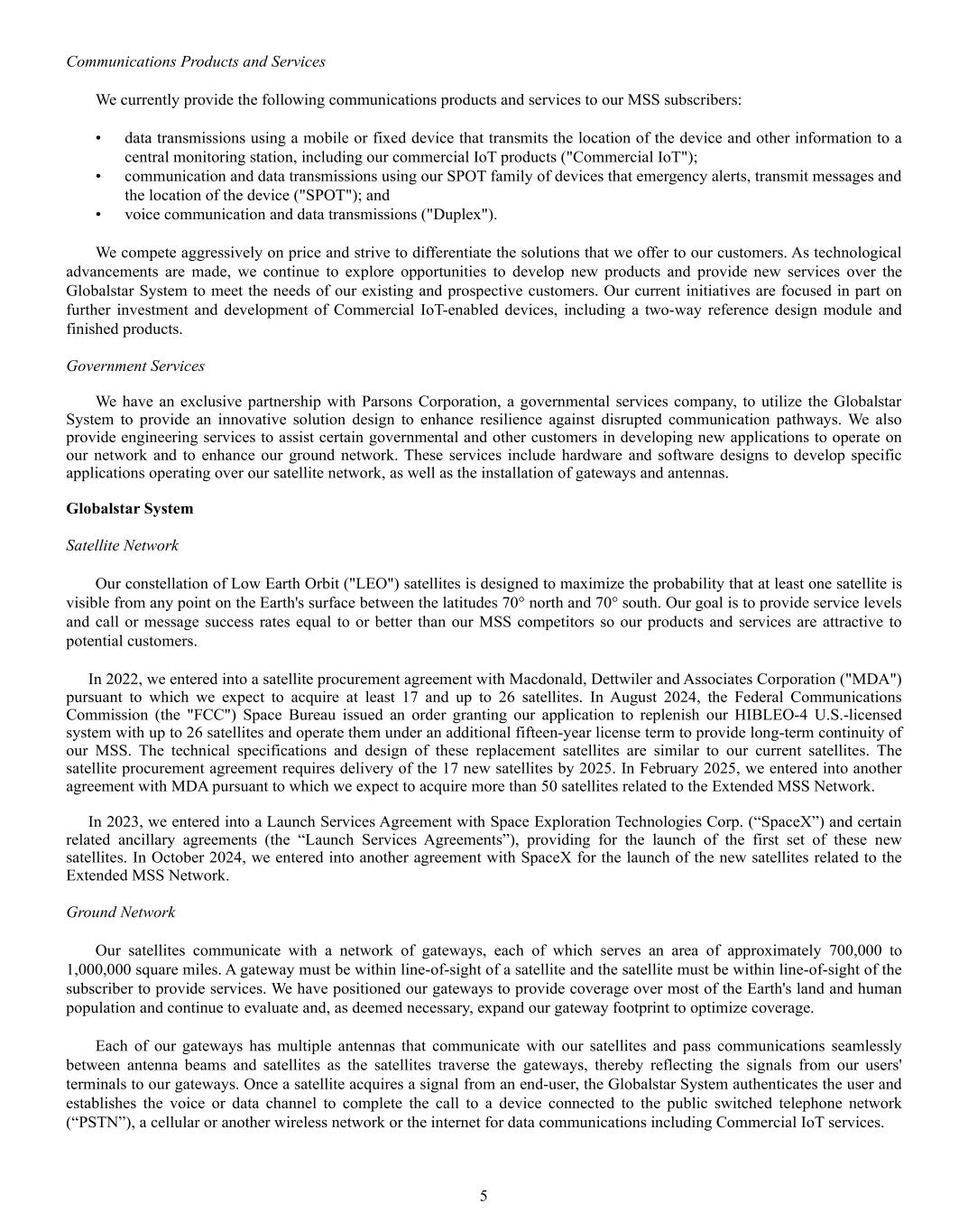
5 Communications Products and Services We currently provide the following communications products and services to our MSS subscribers: • data transmissions using a mobile or fixed device that transmits the location of the device and other information to a central monitoring station, including our commercial IoT products ("Commercial IoT"); • communication and data transmissions using our SPOT family of devices that emergency alerts, transmit messages and the location of the device ("SPOT"); and • voice communication and data transmissions ("Duplex"). We compete aggressively on price and strive to differentiate the solutions that we offer to our customers. As technological advancements are made, we continue to explore opportunities to develop new products and provide new services over the Globalstar System to meet the needs of our existing and prospective customers. Our current initiatives are focused in part on further investment and development of Commercial IoT-enabled devices, including a two-way reference design module and finished products. Government Services We have an exclusive partnership with Parsons Corporation, a governmental services company, to utilize the Globalstar System to provide an innovative solution design to enhance resilience against disrupted communication pathways. We also provide engineering services to assist certain governmental and other customers in developing new applications to operate on our network and to enhance our ground network. These services include hardware and software designs to develop specific applications operating over our satellite network, as well as the installation of gateways and antennas. Globalstar System Satellite Network Our constellation of Low Earth Orbit ("LEO") satellites is designed to maximize the probability that at least one satellite is visible from any point on the Earth's surface between the latitudes 70° north and 70° south. Our goal is to provide service levels and call or message success rates equal to or better than our MSS competitors so our products and services are attractive to potential customers. In 2022, we entered into a satellite procurement agreement with Macdonald, Dettwiler and Associates Corporation ("MDA") pursuant to which we expect to acquire at least 17 and up to 26 satellites. In August 2024, the Federal Communications Commission (the "FCC") Space Bureau issued an order granting our application to replenish our HIBLEO-4 U.S.-licensed system with up to 26 satellites and operate them under an additional fifteen-year license term to provide long-term continuity of our MSS. The technical specifications and design of these replacement satellites are similar to our current satellites. The satellite procurement agreement requires delivery of the 17 new satellites by 2025. In February 2025, we entered into another agreement with MDA pursuant to which we expect to acquire more than 50 satellites related to the Extended MSS Network. In 2023, we entered into a Launch Services Agreement with Space Exploration Technologies Corp. (“SpaceX”) and certain related ancillary agreements (the “Launch Services Agreements”), providing for the launch of the first set of these new satellites. In October 2024, we entered into another agreement with SpaceX for the launch of the new satellites related to the Extended MSS Network. Ground Network Our satellites communicate with a network of gateways, each of which serves an area of approximately 700,000 to 1,000,000 square miles. A gateway must be within line-of-sight of a satellite and the satellite must be within line-of-sight of the subscriber to provide services. We have positioned our gateways to provide coverage over most of the Earth's land and human population and continue to evaluate and, as deemed necessary, expand our gateway footprint to optimize coverage. Each of our gateways has multiple antennas that communicate with our satellites and pass communications seamlessly between antenna beams and satellites as the satellites traverse the gateways, thereby reflecting the signals from our users' terminals to our gateways. Once a satellite acquires a signal from an end-user, the Globalstar System authenticates the user and establishes the voice or data channel to complete the call to a device connected to the public switched telephone network (“PSTN”), a cellular or another wireless network or the internet for data communications including Commercial IoT services.

6 We believe that the design of the Globalstar System enables faster and more cost-effective system maintenance and upgrades because the software and much of the hardware are located on the ground. Our multiple gateways allow us to reconfigure the Globalstar System quickly to extend another gateway's coverage to make up for lost coverage from a disabled gateway or to increase capacity resulting from surges in demand. Our ground network includes our ground equipment, which uses technology permitting communication to multiple satellites. The architecture of the Globalstar System provides full frequency re-use. This maximizes satellite diversity (which maximizes quality) and network capacity as we can reuse the assigned spectrum in every satellite beam in every satellite. In addition, we have developed a proprietary technology for our SPOT and Commercial IoT services. Throughout the past few years, we have built additional gateways around the world, including new antennas and appliques, to improve our ability to pursue significant new opportunities to deploy the Globalstar System as technologies and customer needs evolve and to ensure the performance of the Globalstar System continues to excel as these opportunities increase demand on our capacity. Customers We provide services to customers in each area of our business, including wholesale satellite capacity, terrestrial spectrum and network solutions, communications products and services and government services. We enable direct-to-cellular connectivity over the Globalstar System to the Customer under the Updated Services Agreements through a wholesale capacity arrangement. We also provide communications products and services to our MSS subscribers. As of December 31, 2024, we had approximately 774,000 subscribers worldwide. Our subscriber count only includes our MSS subscribers using devices sold and manufactured by Globalstar. For our subscriber driven revenue, the specialized needs of our global customers span many industries. The Globalstar System is able to offer our customers cost-effective communications solutions completely independent of cellular coverage. Although traditional users of wireless telephony and broadband data services have access to such services in developed locations, our MSS customers often operate, travel and/or live in remote regions or regions with under-developed telecommunications infrastructure where such services are not readily available or are not provided on a reliable basis. For the year ended December 31, 2024, 2023 and 2022, the Customer under the Updated Services Agreements was responsible for 58%, 49%, and 24%, respectively, of our total revenue. No other customer was responsible for more than 10% of our revenue. The loss of the Customer under the Updated Services Agreements could have an adverse impact to our financial condition, results of operations and cash flows. See Item 1A:Risk Factors, “Revenue under the Updated Services Agreements constitutes a substantial portion of our current revenues, and there is no assurance that we will receive the revenue expected under the Updated Services Agreements.” for further discussion. Communications Products and Services Commercial IoT Transmission Products Satellite IoT connectivity has become more critical to a growing number of sectors and use cases. Our Commercial IoT service is currently a one-way data service from an IoT device over the Globalstar System that can be used to track and monitor assets. Our subscribers use our Commercial IoT devices for a host of applications, including to track assets, such as: cargo containers and rail cars; monitor utility meters; and monitor oil and gas assets. At the heart of our Commercial IoT services is a demodulator and RF interface, called an appliqué, which is located at a gateway and an application server in our facilities. The appliqué-equipped gateways provide coverage over vast areas of the globe. The small size of the IoT devices makes them attractive for use in tracking asset shipments, monitoring unattended remote assets, trailer tracking and mobile security. We provide Commercial IoT services to customers operating in a variety of industries, primarily government, transportation, construction, agriculture and forestry. Current customers include various governmental agencies, such as the Federal Emergency Management Agency, U.S. Army, U.S. Air Force, National Oceanic and Atmospheric Administration, U.S. Forest Service and U.K. Ministry of Defence, as well as other organizations, such as BP, Shell and The Salvation Army. We designed our Commercial IoT services to address demand in the market for a small and cost-effective solution for sending data, such as geographic coordinates, from assets or individuals in remote locations to a central monitoring station. Customers realize an efficiency advantage from tracking assets on a single global system as compared to several regional systems.
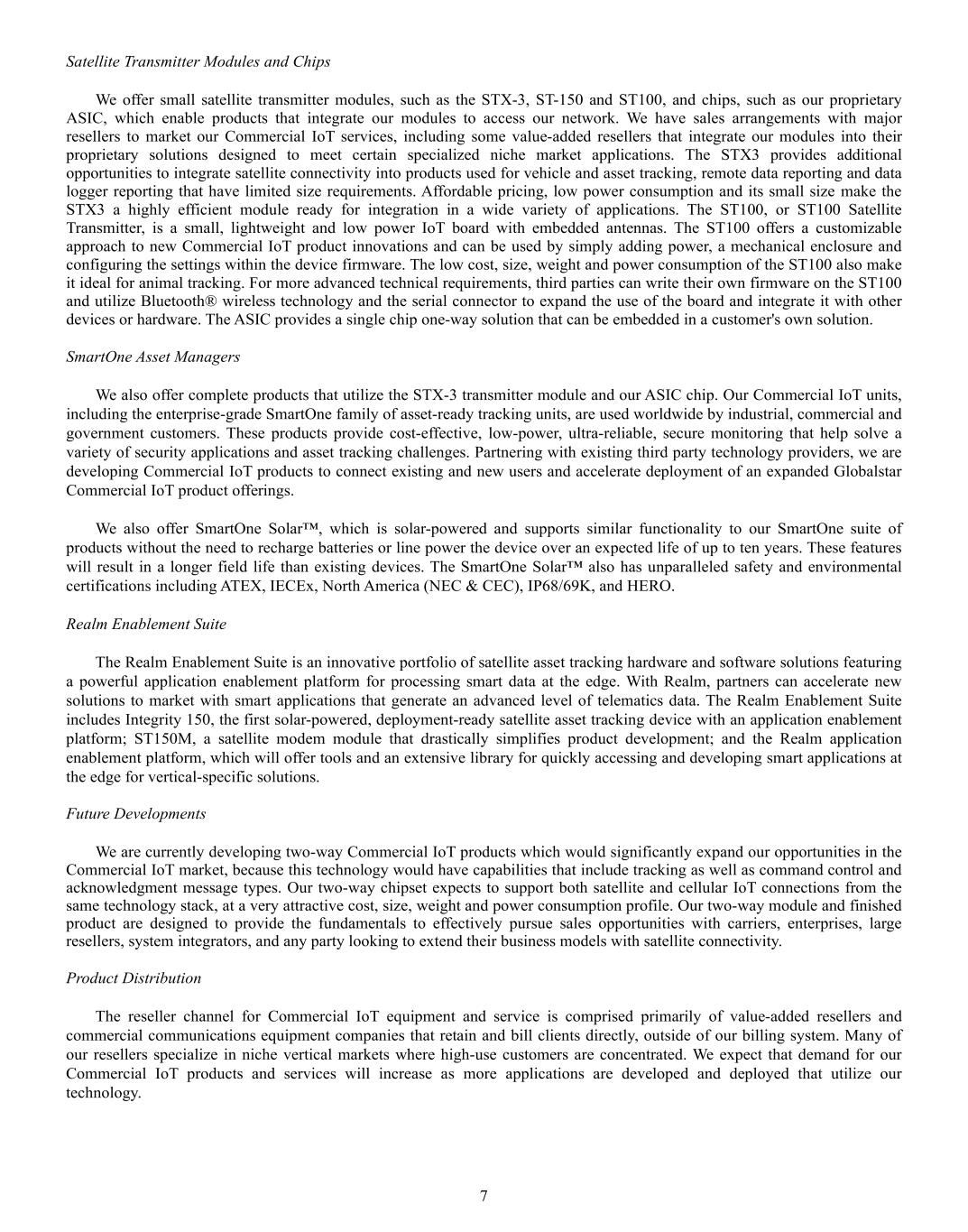
7 Satellite Transmitter Modules and Chips We offer small satellite transmitter modules, such as the STX-3, ST-150 and ST100, and chips, such as our proprietary ASIC, which enable products that integrate our modules to access our network. We have sales arrangements with major resellers to market our Commercial IoT services, including some value-added resellers that integrate our modules into their proprietary solutions designed to meet certain specialized niche market applications. The STX3 provides additional opportunities to integrate satellite connectivity into products used for vehicle and asset tracking, remote data reporting and data logger reporting that have limited size requirements. Affordable pricing, low power consumption and its small size make the STX3 a highly efficient module ready for integration in a wide variety of applications. The ST100, or ST100 Satellite Transmitter, is a small, lightweight and low power IoT board with embedded antennas. The ST100 offers a customizable approach to new Commercial IoT product innovations and can be used by simply adding power, a mechanical enclosure and configuring the settings within the device firmware. The low cost, size, weight and power consumption of the ST100 also make it ideal for animal tracking. For more advanced technical requirements, third parties can write their own firmware on the ST100 and utilize Bluetooth® wireless technology and the serial connector to expand the use of the board and integrate it with other devices or hardware. The ASIC provides a single chip one-way solution that can be embedded in a customer's own solution. SmartOne Asset Managers We also offer complete products that utilize the STX-3 transmitter module and our ASIC chip. Our Commercial IoT units, including the enterprise-grade SmartOne family of asset-ready tracking units, are used worldwide by industrial, commercial and government customers. These products provide cost-effective, low-power, ultra-reliable, secure monitoring that help solve a variety of security applications and asset tracking challenges. Partnering with existing third party technology providers, we are developing Commercial IoT products to connect existing and new users and accelerate deployment of an expanded Globalstar Commercial IoT product offerings. We also offer SmartOne Solar™, which is solar-powered and supports similar functionality to our SmartOne suite of products without the need to recharge batteries or line power the device over an expected life of up to ten years. These features will result in a longer field life than existing devices. The SmartOne Solar™ also has unparalleled safety and environmental certifications including ATEX, IECEx, North America (NEC & CEC), IP68/69K, and HERO. Realm Enablement Suite The Realm Enablement Suite is an innovative portfolio of satellite asset tracking hardware and software solutions featuring a powerful application enablement platform for processing smart data at the edge. With Realm, partners can accelerate new solutions to market with smart applications that generate an advanced level of telematics data. The Realm Enablement Suite includes Integrity 150, the first solar-powered, deployment-ready satellite asset tracking device with an application enablement platform; ST150M, a satellite modem module that drastically simplifies product development; and the Realm application enablement platform, which will offer tools and an extensive library for quickly accessing and developing smart applications at the edge for vertical-specific solutions. Future Developments We are currently developing two-way Commercial IoT products which would significantly expand our opportunities in the Commercial IoT market, because this technology would have capabilities that include tracking as well as command control and acknowledgment message types. Our two-way chipset expects to support both satellite and cellular IoT connections from the same technology stack, at a very attractive cost, size, weight and power consumption profile. Our two-way module and finished product are designed to provide the fundamentals to effectively pursue sales opportunities with carriers, enterprises, large resellers, system integrators, and any party looking to extend their business models with satellite connectivity. Product Distribution The reseller channel for Commercial IoT equipment and service is comprised primarily of value-added resellers and commercial communications equipment companies that retain and bill clients directly, outside of our billing system. Many of our resellers specialize in niche vertical markets where high-use customers are concentrated. We expect that demand for our Commercial IoT products and services will increase as more applications are developed and deployed that utilize our technology.
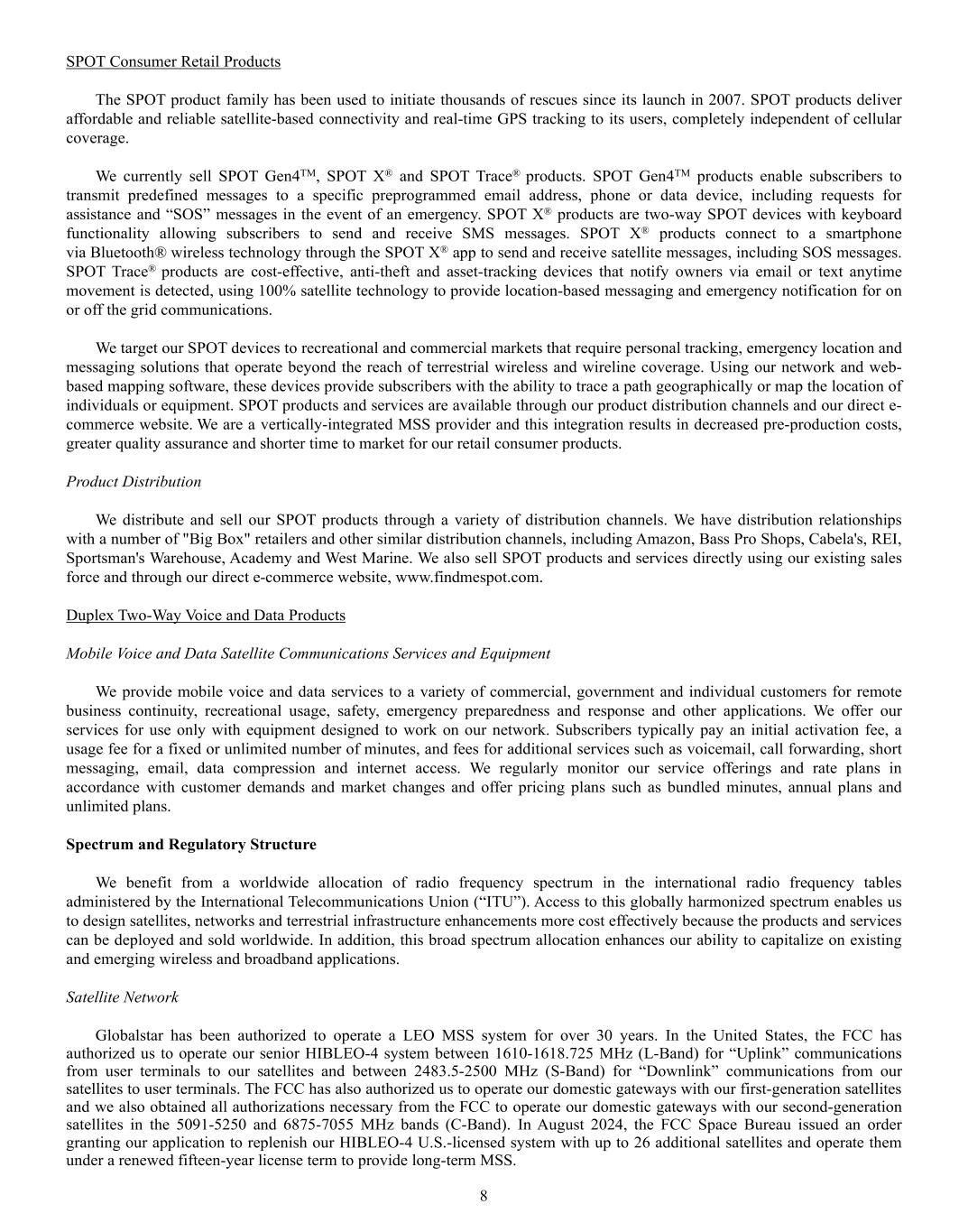
8 SPOT Consumer Retail Products The SPOT product family has been used to initiate thousands of rescues since its launch in 2007. SPOT products deliver affordable and reliable satellite-based connectivity and real-time GPS tracking to its users, completely independent of cellular coverage. We currently sell SPOT Gen4TM, SPOT X® and SPOT Trace® products. SPOT Gen4TM products enable subscribers to transmit predefined messages to a specific preprogrammed email address, phone or data device, including requests for assistance and “SOS” messages in the event of an emergency. SPOT X® products are two-way SPOT devices with keyboard functionality allowing subscribers to send and receive SMS messages. SPOT X® products connect to a smartphone via Bluetooth® wireless technology through the SPOT X® app to send and receive satellite messages, including SOS messages. SPOT Trace® products are cost-effective, anti-theft and asset-tracking devices that notify owners via email or text anytime movement is detected, using 100% satellite technology to provide location-based messaging and emergency notification for on or off the grid communications. We target our SPOT devices to recreational and commercial markets that require personal tracking, emergency location and messaging solutions that operate beyond the reach of terrestrial wireless and wireline coverage. Using our network and web- based mapping software, these devices provide subscribers with the ability to trace a path geographically or map the location of individuals or equipment. SPOT products and services are available through our product distribution channels and our direct e- commerce website. We are a vertically-integrated MSS provider and this integration results in decreased pre-production costs, greater quality assurance and shorter time to market for our retail consumer products. Product Distribution We distribute and sell our SPOT products through a variety of distribution channels. We have distribution relationships with a number of "Big Box" retailers and other similar distribution channels, including Amazon, Bass Pro Shops, Cabela's, REI, Sportsman's Warehouse, Academy and West Marine. We also sell SPOT products and services directly using our existing sales force and through our direct e-commerce website, www.findmespot.com. Duplex Two-Way Voice and Data Products Mobile Voice and Data Satellite Communications Services and Equipment We provide mobile voice and data services to a variety of commercial, government and individual customers for remote business continuity, recreational usage, safety, emergency preparedness and response and other applications. We offer our services for use only with equipment designed to work on our network. Subscribers typically pay an initial activation fee, a usage fee for a fixed or unlimited number of minutes, and fees for additional services such as voicemail, call forwarding, short messaging, email, data compression and internet access. We regularly monitor our service offerings and rate plans in accordance with customer demands and market changes and offer pricing plans such as bundled minutes, annual plans and unlimited plans. Spectrum and Regulatory Structure We benefit from a worldwide allocation of radio frequency spectrum in the international radio frequency tables administered by the International Telecommunications Union (“ITU”). Access to this globally harmonized spectrum enables us to design satellites, networks and terrestrial infrastructure enhancements more cost effectively because the products and services can be deployed and sold worldwide. In addition, this broad spectrum allocation enhances our ability to capitalize on existing and emerging wireless and broadband applications. Satellite Network Globalstar has been authorized to operate a LEO MSS system for over 30 years. In the United States, the FCC has authorized us to operate our senior HIBLEO-4 system between 1610-1618.725 MHz (L-Band) for “Uplink” communications from user terminals to our satellites and between 2483.5-2500 MHz (S-Band) for “Downlink” communications from our satellites to user terminals. The FCC has also authorized us to operate our domestic gateways with our first-generation satellites and we also obtained all authorizations necessary from the FCC to operate our domestic gateways with our second-generation satellites in the 5091-5250 and 6875-7055 MHz bands (C-Band). In August 2024, the FCC Space Bureau issued an order granting our application to replenish our HIBLEO-4 U.S.-licensed system with up to 26 additional satellites and operate them under a renewed fifteen-year license term to provide long-term MSS.

9 We licensed and registered our second-generation satellites in France. The French National Agency for Radio Frequencies (“ANFR”) authorized our HIBLEO-X system to operate frequency assignments between 1610-1621.35 MHz for “Uplink” communications from user terminals to our satellites and between 2483.5-2500 MHz for “Downlink” communications from our satellites to user terminals. France’s National Space Agency (“CNES”) authorized Globalstar’s in-orbit operation of the HIBLEO-X system. In accordance with our authorization to operate the second-generation satellites, we completed the enhancements to the existing gateway operations in Aussaguel, France to include satellite operations and control functions. We have redundant satellite operation control facilities in Covington, Louisiana, Aussaguel, France and Milpitas, California. During 2020, our French authorizations to provide MSS and operate the gateway in Aussaguel, France were renewed for an additional 10-year term. Globalstar will license and register the additional satellites of our Extended MSS Network in France under the International Telecommunications Union (“ITU”) filing AST-NG-C-3 (the “C-3 System”). Globalstar is in the process of obtaining all necessary authorizations from France to operate the C-3 System. France will also be the notifying administration to the U.N. Register of Space Objects and responsible for authorization and regulation of its on-orbit operations. Globalstar’s subsidiary, Globalstar Licensee LLC, has filed a Petition for Declaratory Ruling with the U.S. Federal Communications Commission requesting U.S. market access for its next-generation C-3 System. Terrestrial Authority for Globalstar's Licensed 2.4 GHz Spectrum We are authorized to provide terrestrial broadband services over 11.5 MHz of our licensed MSS spectrum at 2483.5 to 2495 MHz (S-Band) throughout the United States of America. The Third Generation Partnership Project (“3GPP”), an organization that produces technical specifications and reports for 3GPP technologies, has designated the 11.5 MHz terrestrial band as Band 53 with the 5G variant of our Band 53 known as n53 (collectively "Band 53/n53"). We believe our MSS spectrum position provides potential for harmonized terrestrial authority across many international regulatory domains and have received and continue to seek approvals in various international jurisdictions. We have a strategic perpetual licensing agreement for exclusive access to certain key XCOM technologies and personnel. The license covers a number of XCOM’s novel technologies for wireless spectrum innovations, including XCOM RAN, XCOM’s commercially available coordinated multipoint radio system. XCOM technologies deliver substantial capacity gains and other benefits in dense, complex, challenging wireless environments in sub 7 GHz spectrum, including Band n53. We also gained exclusive access to XCOM’s peer-to-peer connectivity technologies that could have applications across cellular and satellite devices. Industry The emergence of satellite to cellular technology (direct-to-cellular) has increased the number of satellite providers working in collaboration with mobile communications providers to offer wholesale capacity services similar to ours that extend smart phone messaging capability. We compete in the MSS sector of the global communications industry. MSS operators provide voice and data services using a network of one or more satellites and associated ground facilities. MSS are usually complementary to other forms of terrestrial communications services and infrastructure and are intended to allow for connectivity beyond the reach of cellular. Customers typically use MSS voice and data communications in situations where existing terrestrial wireline and wireless communications networks are impaired or do not exist or where they prefer to operate on a single system across terrestrial territories. Government organizations, military, natural disaster aid associations, event-driven response agencies and corporate security teams across the world depend on mobile and fixed voice and data communications services on a regular basis. Businesses with global operations require communications services when operating in remote locations. MSS users span the forestry, maritime, government, oil and gas, mining, leisure, emergency services, construction and transportation sectors, among others. Over the past two decades, the global MSS market has experienced significant growth. Increasingly, better-tailored, improved technology products and services are creating new channels of demand. Growth in demand for MSS is driven by the declining cost of these services, the diminishing size and lower cost of the devices, as well as heightened demand by governments, businesses and individuals for ubiquitous global voice and data coverage. Growth in mobile satellite data services is driven by the rollout of new applications requiring higher bandwidth, as well as low-cost data collection and asset-tracking devices and technological improvements permitting integration of MSS over smartphones and other Wi-Fi enabled devices.

10 Communications industry sectors that are relevant to our business include: • MSS, which provide customers with connectivity to mobile and fixed devices using a network of satellites and ground facilities; • fixed satellite services, which use geostationary satellites to provide customers with voice and broadband communications links between fixed points on the earth's surface; and • terrestrial services, which use a terrestrial network to provide wireless or wireline connectivity and are complementary to satellite services. Within the major satellite sectors, fixed and MSS operators differ significantly from each other. Fixed satellite services providers, such as Intelsat Ltd., Eutelsat Communications and SES S.A., and aperture terminal companies, such as Hughes and Gilat Satellite Networks, are characterized by large, often stationary or "fixed," ground terminals that send and receive high- bandwidth signals to and from the satellite network for video and high speed data customers and international telephone markets. On the other hand, MSS providers, such as Globalstar, Viasat, Inc. ("Viasat") (which acquired Inmarsat PLC (“Inmarsat”)), Iridium Communications Inc. (“Iridium”), and ORBCOMM, focus more on voice and/or data services (including data services which track the location of remote assets such as shipping containers), where mobility or small-sized terminals are essential. As MSS terminals begin to offer higher bandwidth to support a wider range of applications, we expect MSS operators will increasingly compete with fixed satellite services operators. There are also multiple new systems that have recently launched as well as systems that are expected to launch over the coming years. These include SpaceX’s Starlink, Amazon Kuiper and AST SpaceMobile, among others. These systems are expected to provide a host of services, such as consumer broadband, government and direct-to-cellular. LEO systems reduce transmission delay compared to a geosynchronous system due to the shorter distance signals have to travel. In addition, LEO systems are less prone to signal blockage and, consequently, we believe provide a better overall quality of MSS. We are also a provider of licensed wireless spectrum for use in terrestrial networks. As more and more devices are connected wirelessly and as their applications increase in bandwidth intensity, more terrestrial spectrum is required. In the United States, there are a number of other current licensed spectrum providers, including Anterix, Nextwave and Terrastar as well as various other licensed spectrum holders. We also provide an alternative to unlicensed spectrum used with Wi-Fi or lightly licensed spectrum like CBRS. Each spectrum band is unique due to its propagation or ecosystem development; accordingly, some bands suit needs that others may not. Our spectrum band offers partners an international resource that has a robust and growing ecosystem. Competition The global communications industry is highly competitive. We currently face substantial competition from other service providers that offer a range of mobile and fixed communications options similar to ours. Our direct-to-cellular service also faces competition from newly announced service providers, including SpaceX's Starlink and a number of new market entrants. While we believe that our service is currently the most robust service providing satellite capabilities to smartphones, other satellite service providers are expected to provide similar satellite services in the near-term. Our most direct competition in our MSS business comes from other global MSS providers. Our largest global competitors are Viasat, Iridium and ORBCOMM. We compete primarily on the basis of coverage, quality, portability and pricing of services and products. In recent years, advancements in technology have also encouraged non-traditional companies to enter the market. Viasat operates its owned and leased satellites. Viasat provides communications technologies and services to enterprises, consumers, military and government users. During 2023, Viasat completed the acquisition of Inmarsat, which owned and operated a fleet of geostationary satellites. Due to its multiple-satellite geostationary system, Inmarsat's coverage area extended to and covered most bodies of water more completely than our system. Accordingly, Inmarsat (through Viasat) is the leading provider of satellite communications services to the maritime sector. Iridium owns and operates a fleet of LEO satellites. Iridium provides MSS voice and data communications to businesses, the United States government as well as foreign governments, non-governmental organizations and consumers. Iridium markets products and services that are similar to those marketed by us. Additionally, Garmin's inReach devices provide two-way tracking with SOS capabilities; Honeywell Global Tracking has a personal tracking unit that enables a smartphone with satellite tracking and messaging capabilities; and Somewear has a satellite hotspot; all of which work on Iridium's satellite network.

11 ORBCOMM owns and operates a fleet of LEO satellites. ORBCOMM primarily provides asset tracking, monitoring and control solutions for its customers in the Commercial IoT market, which directly compete with our Commercial IoT products and services. We compete with regional MSS in several markets. In these cases, our competitors serve customers who require regional, not global, mobile voice and data services, so our competitors present a viable alternative to our MSS in certain markets. All of these competitors operate geostationary satellites. Our principal regional MSS competitor in the Middle East and Africa is Thuraya. Our SPOT products compete indirectly with Personal Locator Beacons (“PLBs”). A variety of manufacturers offer PLBs to industry specifications. Our industry has significant barriers to entry, including the cost and difficulty associated with obtaining spectrum licenses and successfully building and launching a satellite and ground network. In addition to cost, there is a significant amount of lead-time associated with obtaining the required licenses, designing and building the satellite constellation and synchronizing the network technology. For terrestrial spectrum opportunities, our primary competition is other licensed and unlicensed terrestrial spectrum alternatives and, to a lesser extent, lightly licensed terrestrial bands. Anterix, a licensed spectrum holder, is also a successful competitor for use cases that require low data over longer distances primarily for utilities. We may be able to address certain of these use cases with spectrum provided by our satellite network. Governmental Regulations Please refer to Item 1A: Risk Factors - "Risks Related to Government Regulations" for further discussion of the impact of governmental regulations on our business. United States International Traffic in Arms Regulations and United States Export Administration Regulations The United States International Traffic in Arms regulations under the United States Arms Export Control Act authorize the President of the United States to control the export and import of articles and services that can be used in the production of arms. The President has delegated this authority to the U.S. Department of State, Directorate of Defense Trade Controls. United States Export Administration Regulations enforced by the United States Bureau of Industry and Security, as well as regulations enforced by the United States Office of Foreign Assets Control regulate the export of certain products, services, and associated technical data. Among other things, these regulations limit the ability to export certain articles and related technical data to certain nations. Some information involved in the performance of our operations falls within the scope of these regulations. As a result, we may have to obtain an export authorization or restrict access to that information by international companies that are our vendors or service providers. We have received and expect to continue to receive export licenses for covered articles and technical data shared with approved parties outside the United States. We also are subject to restrictions related to transactions with persons subject to United States or foreign sanctions. These regulations, enforced by the United States Office of Foreign Assets Control, limit our ability to offer services and equipment to certain parties or in certain areas. Environmental Matters We are subject to various laws and regulations relating to the protection of the environment and human health and safety (including those governing the management, storage and disposal of hazardous materials). Some of our operations require continuous power supply. As a result, current and historical operations at our ground facilities, including our gateways, include storing fuels and batteries, which may contain hazardous material and power back-up generators. As an owner or operator of property and in connection with our current and historical operations, we could incur significant costs, including cleanup costs, fines, sanctions and third-party claims, as a result of violations of or in connection with liabilities under environmental laws and regulations.
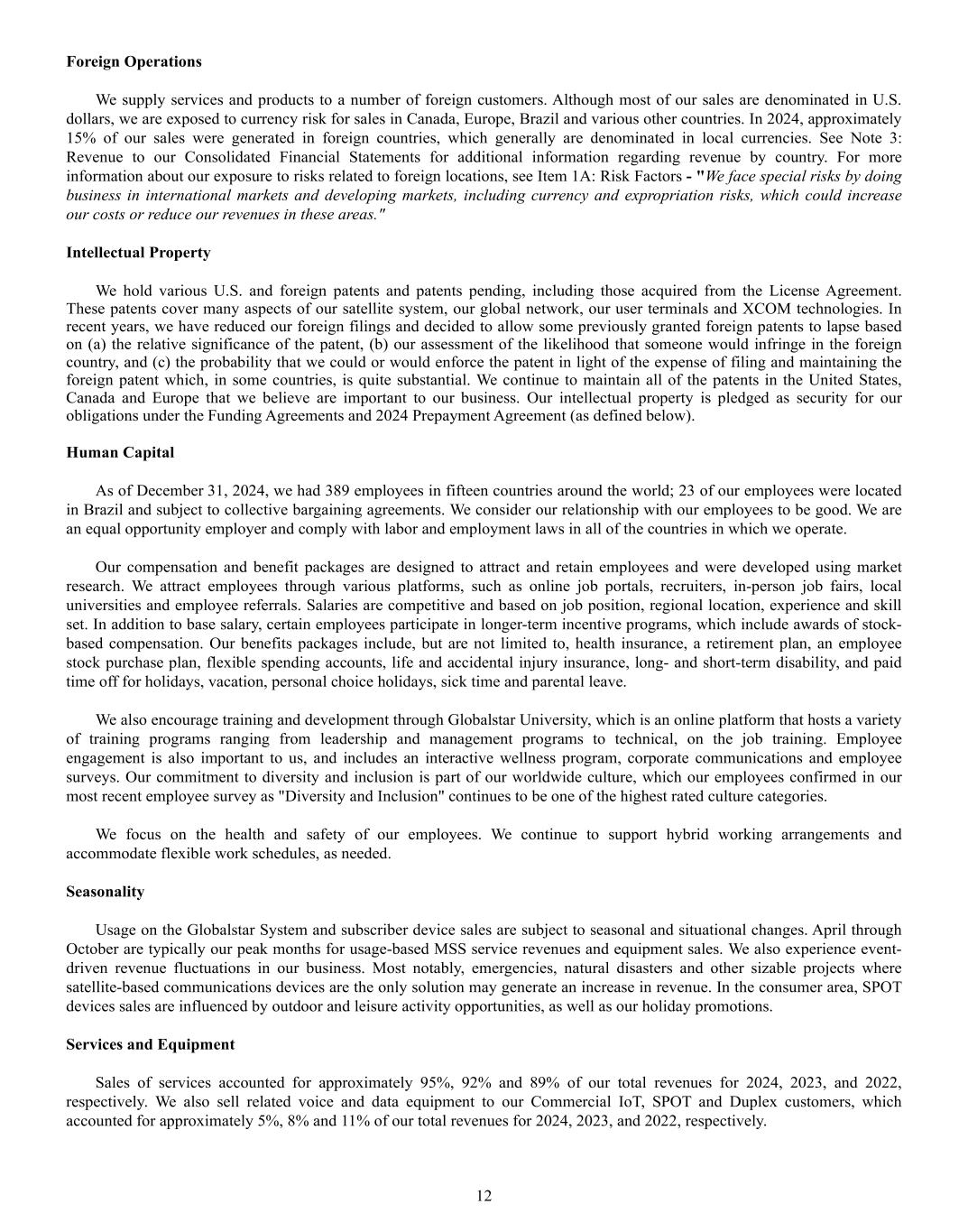
12 Foreign Operations We supply services and products to a number of foreign customers. Although most of our sales are denominated in U.S. dollars, we are exposed to currency risk for sales in Canada, Europe, Brazil and various other countries. In 2024, approximately 15% of our sales were generated in foreign countries, which generally are denominated in local currencies. See Note 3: Revenue to our Consolidated Financial Statements for additional information regarding revenue by country. For more information about our exposure to risks related to foreign locations, see Item 1A: Risk Factors - "We face special risks by doing business in international markets and developing markets, including currency and expropriation risks, which could increase our costs or reduce our revenues in these areas." Intellectual Property We hold various U.S. and foreign patents and patents pending, including those acquired from the License Agreement. These patents cover many aspects of our satellite system, our global network, our user terminals and XCOM technologies. In recent years, we have reduced our foreign filings and decided to allow some previously granted foreign patents to lapse based on (a) the relative significance of the patent, (b) our assessment of the likelihood that someone would infringe in the foreign country, and (c) the probability that we could or would enforce the patent in light of the expense of filing and maintaining the foreign patent which, in some countries, is quite substantial. We continue to maintain all of the patents in the United States, Canada and Europe that we believe are important to our business. Our intellectual property is pledged as security for our obligations under the Funding Agreements and 2024 Prepayment Agreement (as defined below). Human Capital As of December 31, 2024, we had 389 employees in fifteen countries around the world; 23 of our employees were located in Brazil and subject to collective bargaining agreements. We consider our relationship with our employees to be good. We are an equal opportunity employer and comply with labor and employment laws in all of the countries in which we operate. Our compensation and benefit packages are designed to attract and retain employees and were developed using market research. We attract employees through various platforms, such as online job portals, recruiters, in-person job fairs, local universities and employee referrals. Salaries are competitive and based on job position, regional location, experience and skill set. In addition to base salary, certain employees participate in longer-term incentive programs, which include awards of stock- based compensation. Our benefits packages include, but are not limited to, health insurance, a retirement plan, an employee stock purchase plan, flexible spending accounts, life and accidental injury insurance, long- and short-term disability, and paid time off for holidays, vacation, personal choice holidays, sick time and parental leave. We also encourage training and development through Globalstar University, which is an online platform that hosts a variety of training programs ranging from leadership and management programs to technical, on the job training. Employee engagement is also important to us, and includes an interactive wellness program, corporate communications and employee surveys. Our commitment to diversity and inclusion is part of our worldwide culture, which our employees confirmed in our most recent employee survey as "Diversity and Inclusion" continues to be one of the highest rated culture categories. We focus on the health and safety of our employees. We continue to support hybrid working arrangements and accommodate flexible work schedules, as needed. Seasonality Usage on the Globalstar System and subscriber device sales are subject to seasonal and situational changes. April through October are typically our peak months for usage-based MSS service revenues and equipment sales. We also experience event- driven revenue fluctuations in our business. Most notably, emergencies, natural disasters and other sizable projects where satellite-based communications devices are the only solution may generate an increase in revenue. In the consumer area, SPOT devices sales are influenced by outdoor and leisure activity opportunities, as well as our holiday promotions. Services and Equipment Sales of services accounted for approximately 95%, 92% and 89% of our total revenues for 2024, 2023, and 2022, respectively. We also sell related voice and data equipment to our Commercial IoT, SPOT and Duplex customers, which accounted for approximately 5%, 8% and 11% of our total revenues for 2024, 2023, and 2022, respectively.
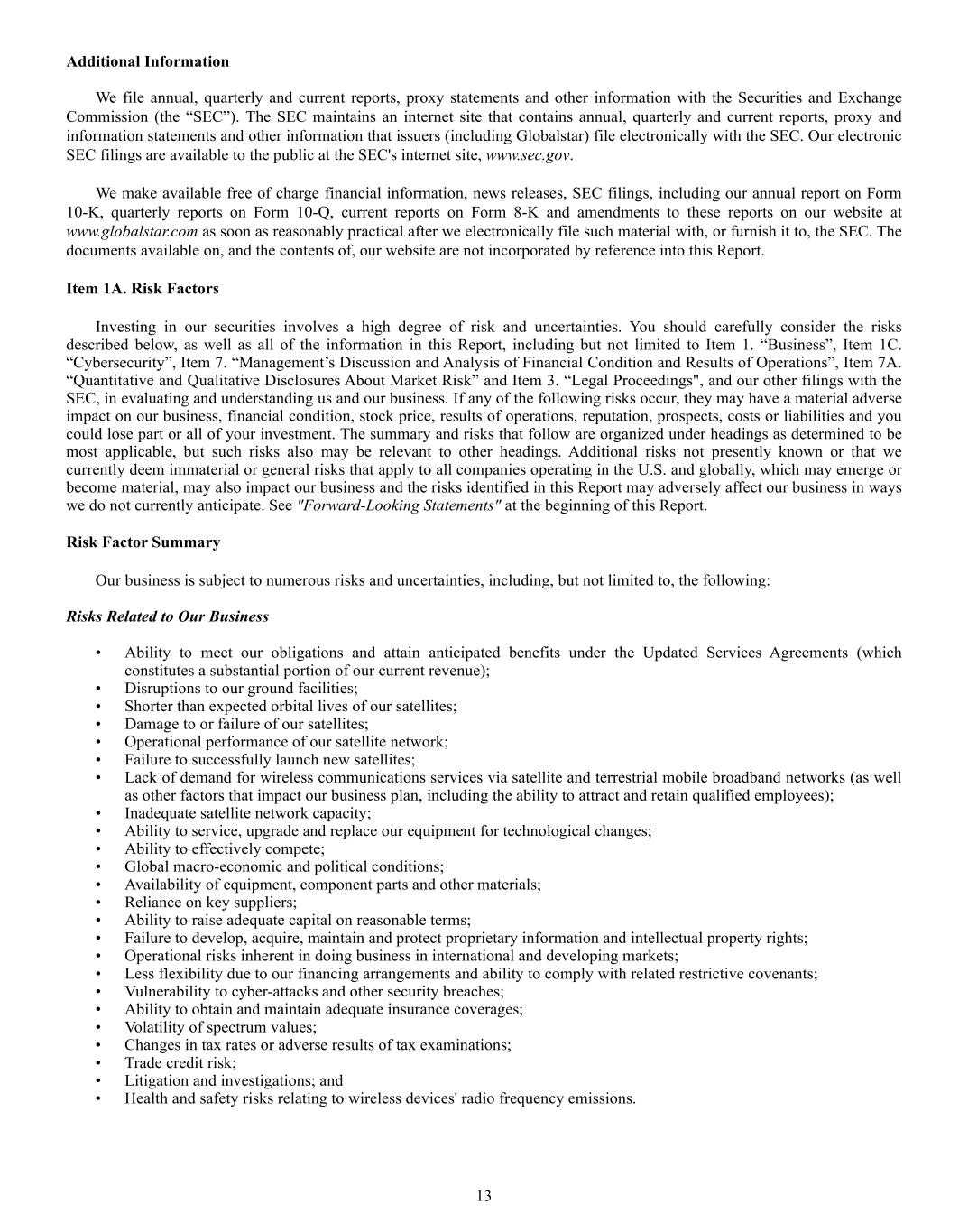
13 Additional Information We file annual, quarterly and current reports, proxy statements and other information with the Securities and Exchange Commission (the “SEC”). The SEC maintains an internet site that contains annual, quarterly and current reports, proxy and information statements and other information that issuers (including Globalstar) file electronically with the SEC. Our electronic SEC filings are available to the public at the SEC's internet site, www.sec.gov. We make available free of charge financial information, news releases, SEC filings, including our annual report on Form 10-K, quarterly reports on Form 10-Q, current reports on Form 8-K and amendments to these reports on our website at www.globalstar.com as soon as reasonably practical after we electronically file such material with, or furnish it to, the SEC. The documents available on, and the contents of, our website are not incorporated by reference into this Report. Item 1A. Risk Factors Investing in our securities involves a high degree of risk and uncertainties. You should carefully consider the risks described below, as well as all of the information in this Report, including but not limited to Item 1. “Business”, Item 1C. “Cybersecurity”, Item 7. “Management’s Discussion and Analysis of Financial Condition and Results of Operations”, Item 7A. “Quantitative and Qualitative Disclosures About Market Risk” and Item 3. “Legal Proceedings", and our other filings with the SEC, in evaluating and understanding us and our business. If any of the following risks occur, they may have a material adverse impact on our business, financial condition, stock price, results of operations, reputation, prospects, costs or liabilities and you could lose part or all of your investment. The summary and risks that follow are organized under headings as determined to be most applicable, but such risks also may be relevant to other headings. Additional risks not presently known or that we currently deem immaterial or general risks that apply to all companies operating in the U.S. and globally, which may emerge or become material, may also impact our business and the risks identified in this Report may adversely affect our business in ways we do not currently anticipate. See "Forward-Looking Statements" at the beginning of this Report. Risk Factor Summary Our business is subject to numerous risks and uncertainties, including, but not limited to, the following: Risks Related to Our Business • Ability to meet our obligations and attain anticipated benefits under the Updated Services Agreements (which constitutes a substantial portion of our current revenue); • Disruptions to our ground facilities; • Shorter than expected orbital lives of our satellites; • Damage to or failure of our satellites; • Operational performance of our satellite network; • Failure to successfully launch new satellites; • Lack of demand for wireless communications services via satellite and terrestrial mobile broadband networks (as well as other factors that impact our business plan, including the ability to attract and retain qualified employees); • Inadequate satellite network capacity; • Ability to service, upgrade and replace our equipment for technological changes; • Ability to effectively compete; • Global macro-economic and political conditions; • Availability of equipment, component parts and other materials; • Reliance on key suppliers; • Ability to raise adequate capital on reasonable terms; • Failure to develop, acquire, maintain and protect proprietary information and intellectual property rights; • Operational risks inherent in doing business in international and developing markets; • Less flexibility due to our financing arrangements and ability to comply with related restrictive covenants; • Vulnerability to cyber-attacks and other security breaches; • Ability to obtain and maintain adequate insurance coverages; • Volatility of spectrum values; • Changes in tax rates or adverse results of tax examinations; • Trade credit risk; • Litigation and investigations; and • Health and safety risks relating to wireless devices' radio frequency emissions.

14 Risks Related to Government Regulations • Compliance with extensive government regulatory framework across jurisdictions and potential changes in such laws and regulations; • Exposure to trade and other regulatory restrictions, liabilities and penalties in various jurisdictions; • Ability to maintain and expand our spectrum rights and reliance on third parties to monetize; • Reduction of spectrum allocation or mandatory additional spectrum sharing agreements; • Revocation, modification or non-renewal of licenses; • Changes in international trade regulations; and • Changes in and interpretation of data privacy laws. Risks Related to Our Common Stock • Restriction on ability to pay dividends; • Limited trading market and market price volatility for our common stock; • Impact of reverse stock split and Nasdaq uplisting; • Ability to meet Nasdaq’s continued listing standards; • Future dilution through issuances of our common stock; • Future issuances of preferred stock or debt securities with rights superior to our common stock; • Interests of our controlling stockholder; and • Impact of anti-takeover provisions in our charter documents and under Delaware law. Risks Related to Our Business Revenue under the Updated Services Agreements constitutes a substantial portion of our current revenue, and there is no assurance that we will receive the revenue expected under the Updated Services Agreements. Consideration received under the Updated Services Agreements constituted approximately 58% of our revenue for the year ended December 31, 2024. The Updated Services Agreements impose a number of substantial obligations on us, provide for certain of our fees to be payable only upon satisfaction of the conditions therein and are terminable by the Customer at any time upon advance notice or force majeure event, or by either party upon the occurrence of certain events of default. It is possible that we may fail to meet these obligations, that the conditions to the payment of such fees may not be satisfied, that the Customer's products that employ the services rendered will not succeed or that the Updated Services Agreements may be terminated. If any of these events were to occur, we would not receive the revenue we currently expect to receive under the Updated Services Agreements, which could materially and adversely affect our business and results of operations. Further, the Updated Services Agreements do not prevent the Customer from allowing their devices to use another network provider's satellite services, which could also negatively impact our revenues that we currently expect to receive under the Updated Services Agreements. If we experience disruptions with respect to our gateways or operations centers, we may not be able to provide service to our customers. Our satellite network traffic is supported by our gateways located around the globe. We operate our satellite constellation from our ground and space operations control centers (referred to as Network Operations Control Centers) at three locations (France, California and Louisiana) to provide geo-redundancy and ongoing coverage. Our gateway facilities are subject to the risk of significant malfunctions or catastrophic loss due to unanticipated events, such as natural disasters, extreme weather events or terrorist attack, and would be difficult to replace or repair and could require substantial lead-time to do so. In North America, we have implemented contingency coverage which allows neighboring gateways to provide services in the event of a gateway failure. Material changes in the operation of these facilities may be subject to prior FCC approval, and the FCC might not give such approval or may subject the approval to other conditions that could be unfavorable to our business. Our gateways and operations centers may also experience service shutdowns or periods of reduced service as a result of equipment failure, delays in deliveries of material, equipment or component parts, regulatory issues or routine system testing, any of which may impede our ability to provide service to our customers, which could have a material impact on our business results and business reputation. The actual orbital lives of our satellites may be shorter than we anticipate, and we may be required to reduce available capacity on our satellite network. Although our second-generation satellites are expected to provide commercial service over a 15-year design life, we can provide no assurance as to whether any or all of them will continue in operation for their full design life. A number of factors will affect the actual commercial service lives of each satellite, including:
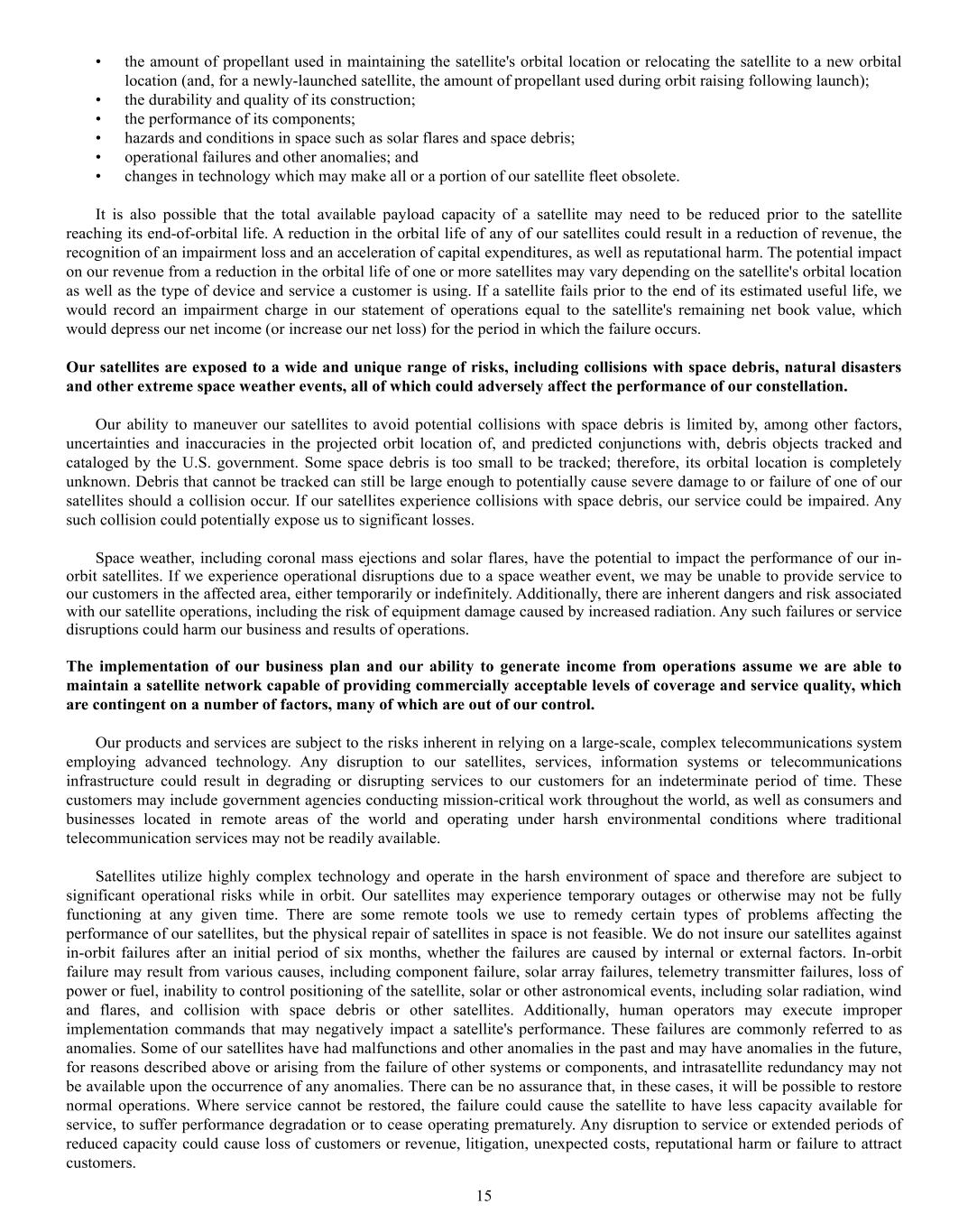
15 • the amount of propellant used in maintaining the satellite's orbital location or relocating the satellite to a new orbital location (and, for a newly-launched satellite, the amount of propellant used during orbit raising following launch); • the durability and quality of its construction; • the performance of its components; • hazards and conditions in space such as solar flares and space debris; • operational failures and other anomalies; and • changes in technology which may make all or a portion of our satellite fleet obsolete. It is also possible that the total available payload capacity of a satellite may need to be reduced prior to the satellite reaching its end-of-orbital life. A reduction in the orbital life of any of our satellites could result in a reduction of revenue, the recognition of an impairment loss and an acceleration of capital expenditures, as well as reputational harm. The potential impact on our revenue from a reduction in the orbital life of one or more satellites may vary depending on the satellite's orbital location as well as the type of device and service a customer is using. If a satellite fails prior to the end of its estimated useful life, we would record an impairment charge in our statement of operations equal to the satellite's remaining net book value, which would depress our net income (or increase our net loss) for the period in which the failure occurs. Our satellites are exposed to a wide and unique range of risks, including collisions with space debris, natural disasters and other extreme space weather events, all of which could adversely affect the performance of our constellation. Our ability to maneuver our satellites to avoid potential collisions with space debris is limited by, among other factors, uncertainties and inaccuracies in the projected orbit location of, and predicted conjunctions with, debris objects tracked and cataloged by the U.S. government. Some space debris is too small to be tracked; therefore, its orbital location is completely unknown. Debris that cannot be tracked can still be large enough to potentially cause severe damage to or failure of one of our satellites should a collision occur. If our satellites experience collisions with space debris, our service could be impaired. Any such collision could potentially expose us to significant losses. Space weather, including coronal mass ejections and solar flares, have the potential to impact the performance of our in- orbit satellites. If we experience operational disruptions due to a space weather event, we may be unable to provide service to our customers in the affected area, either temporarily or indefinitely. Additionally, there are inherent dangers and risk associated with our satellite operations, including the risk of equipment damage caused by increased radiation. Any such failures or service disruptions could harm our business and results of operations. The implementation of our business plan and our ability to generate income from operations assume we are able to maintain a satellite network capable of providing commercially acceptable levels of coverage and service quality, which are contingent on a number of factors, many of which are out of our control. Our products and services are subject to the risks inherent in relying on a large-scale, complex telecommunications system employing advanced technology. Any disruption to our satellites, services, information systems or telecommunications infrastructure could result in degrading or disrupting services to our customers for an indeterminate period of time. These customers may include government agencies conducting mission-critical work throughout the world, as well as consumers and businesses located in remote areas of the world and operating under harsh environmental conditions where traditional telecommunication services may not be readily available. Satellites utilize highly complex technology and operate in the harsh environment of space and therefore are subject to significant operational risks while in orbit. Our satellites may experience temporary outages or otherwise may not be fully functioning at any given time. There are some remote tools we use to remedy certain types of problems affecting the performance of our satellites, but the physical repair of satellites in space is not feasible. We do not insure our satellites against in-orbit failures after an initial period of six months, whether the failures are caused by internal or external factors. In-orbit failure may result from various causes, including component failure, solar array failures, telemetry transmitter failures, loss of power or fuel, inability to control positioning of the satellite, solar or other astronomical events, including solar radiation, wind and flares, and collision with space debris or other satellites. Additionally, human operators may execute improper implementation commands that may negatively impact a satellite's performance. These failures are commonly referred to as anomalies. Some of our satellites have had malfunctions and other anomalies in the past and may have anomalies in the future, for reasons described above or arising from the failure of other systems or components, and intrasatellite redundancy may not be available upon the occurrence of any anomalies. There can be no assurance that, in these cases, it will be possible to restore normal operations. Where service cannot be restored, the failure could cause the satellite to have less capacity available for service, to suffer performance degradation or to cease operating prematurely. Any disruption to service or extended periods of reduced capacity could cause loss of customers or revenue, litigation, unexpected costs, reputational harm or failure to attract customers.
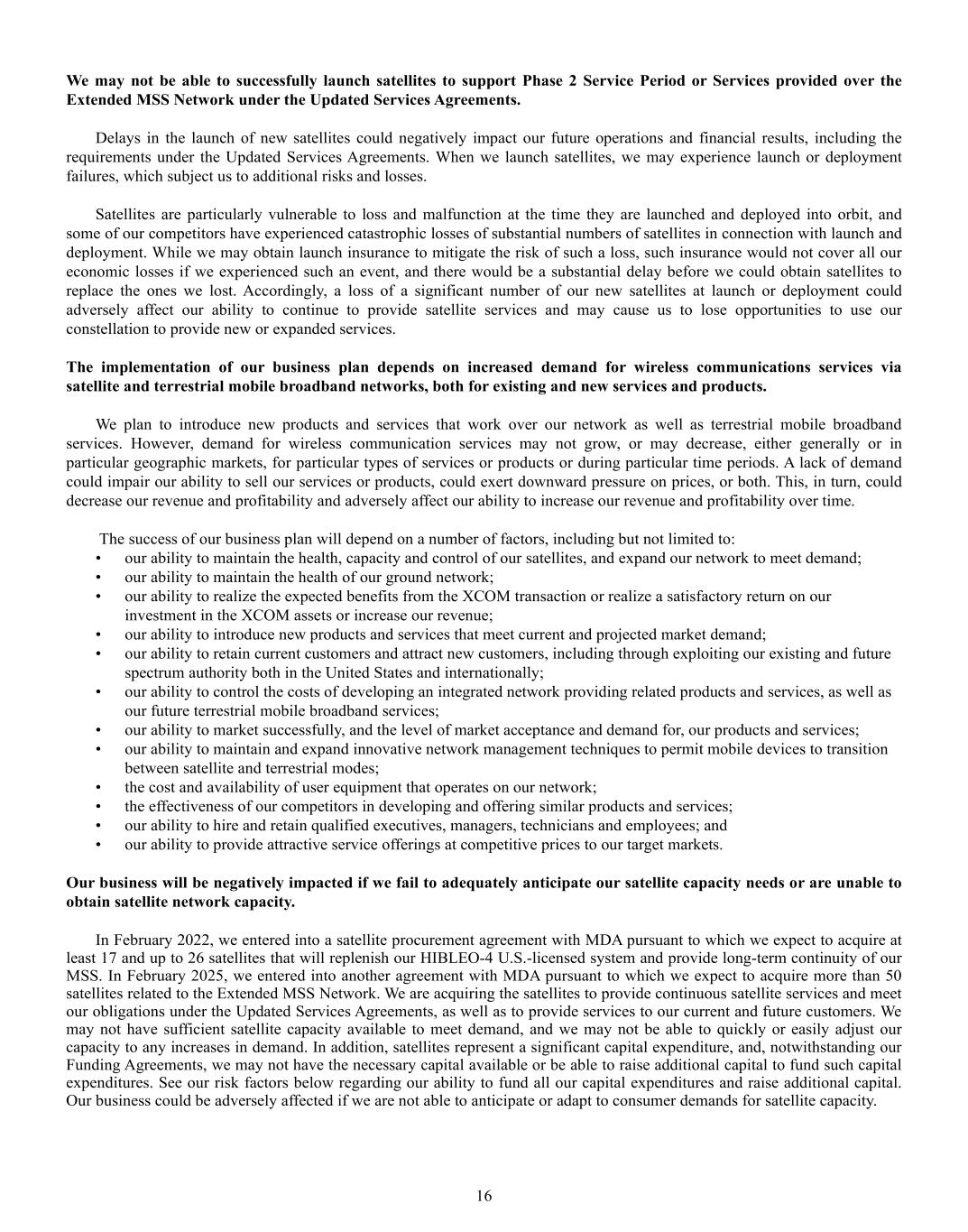
16 We may not be able to successfully launch satellites to support Phase 2 Service Period or Services provided over the Extended MSS Network under the Updated Services Agreements. Delays in the launch of new satellites could negatively impact our future operations and financial results, including the requirements under the Updated Services Agreements. When we launch satellites, we may experience launch or deployment failures, which subject us to additional risks and losses. Satellites are particularly vulnerable to loss and malfunction at the time they are launched and deployed into orbit, and some of our competitors have experienced catastrophic losses of substantial numbers of satellites in connection with launch and deployment. While we may obtain launch insurance to mitigate the risk of such a loss, such insurance would not cover all our economic losses if we experienced such an event, and there would be a substantial delay before we could obtain satellites to replace the ones we lost. Accordingly, a loss of a significant number of our new satellites at launch or deployment could adversely affect our ability to continue to provide satellite services and may cause us to lose opportunities to use our constellation to provide new or expanded services. The implementation of our business plan depends on increased demand for wireless communications services via satellite and terrestrial mobile broadband networks, both for existing and new services and products. We plan to introduce new products and services that work over our network as well as terrestrial mobile broadband services. However, demand for wireless communication services may not grow, or may decrease, either generally or in particular geographic markets, for particular types of services or products or during particular time periods. A lack of demand could impair our ability to sell our services or products, could exert downward pressure on prices, or both. This, in turn, could decrease our revenue and profitability and adversely affect our ability to increase our revenue and profitability over time. The success of our business plan will depend on a number of factors, including but not limited to: • our ability to maintain the health, capacity and control of our satellites, and expand our network to meet demand; • our ability to maintain the health of our ground network; • our ability to realize the expected benefits from the XCOM transaction or realize a satisfactory return on our investment in the XCOM assets or increase our revenue; • our ability to introduce new products and services that meet current and projected market demand; • our ability to retain current customers and attract new customers, including through exploiting our existing and future spectrum authority both in the United States and internationally; • our ability to control the costs of developing an integrated network providing related products and services, as well as our future terrestrial mobile broadband services; • our ability to market successfully, and the level of market acceptance and demand for, our products and services; • our ability to maintain and expand innovative network management techniques to permit mobile devices to transition between satellite and terrestrial modes; • the cost and availability of user equipment that operates on our network; • the effectiveness of our competitors in developing and offering similar products and services; • our ability to hire and retain qualified executives, managers, technicians and employees; and • our ability to provide attractive service offerings at competitive prices to our target markets. Our business will be negatively impacted if we fail to adequately anticipate our satellite capacity needs or are unable to obtain satellite network capacity. In February 2022, we entered into a satellite procurement agreement with MDA pursuant to which we expect to acquire at least 17 and up to 26 satellites that will replenish our HIBLEO-4 U.S.-licensed system and provide long-term continuity of our MSS. In February 2025, we entered into another agreement with MDA pursuant to which we expect to acquire more than 50 satellites related to the Extended MSS Network. We are acquiring the satellites to provide continuous satellite services and meet our obligations under the Updated Services Agreements, as well as to provide services to our current and future customers. We may not have sufficient satellite capacity available to meet demand, and we may not be able to quickly or easily adjust our capacity to any increases in demand. In addition, satellites represent a significant capital expenditure, and, notwithstanding our Funding Agreements, we may not have the necessary capital available or be able to raise additional capital to fund such capital expenditures. See our risk factors below regarding our ability to fund all our capital expenditures and raise additional capital. Our business could be adversely affected if we are not able to anticipate or adapt to consumer demands for satellite capacity.
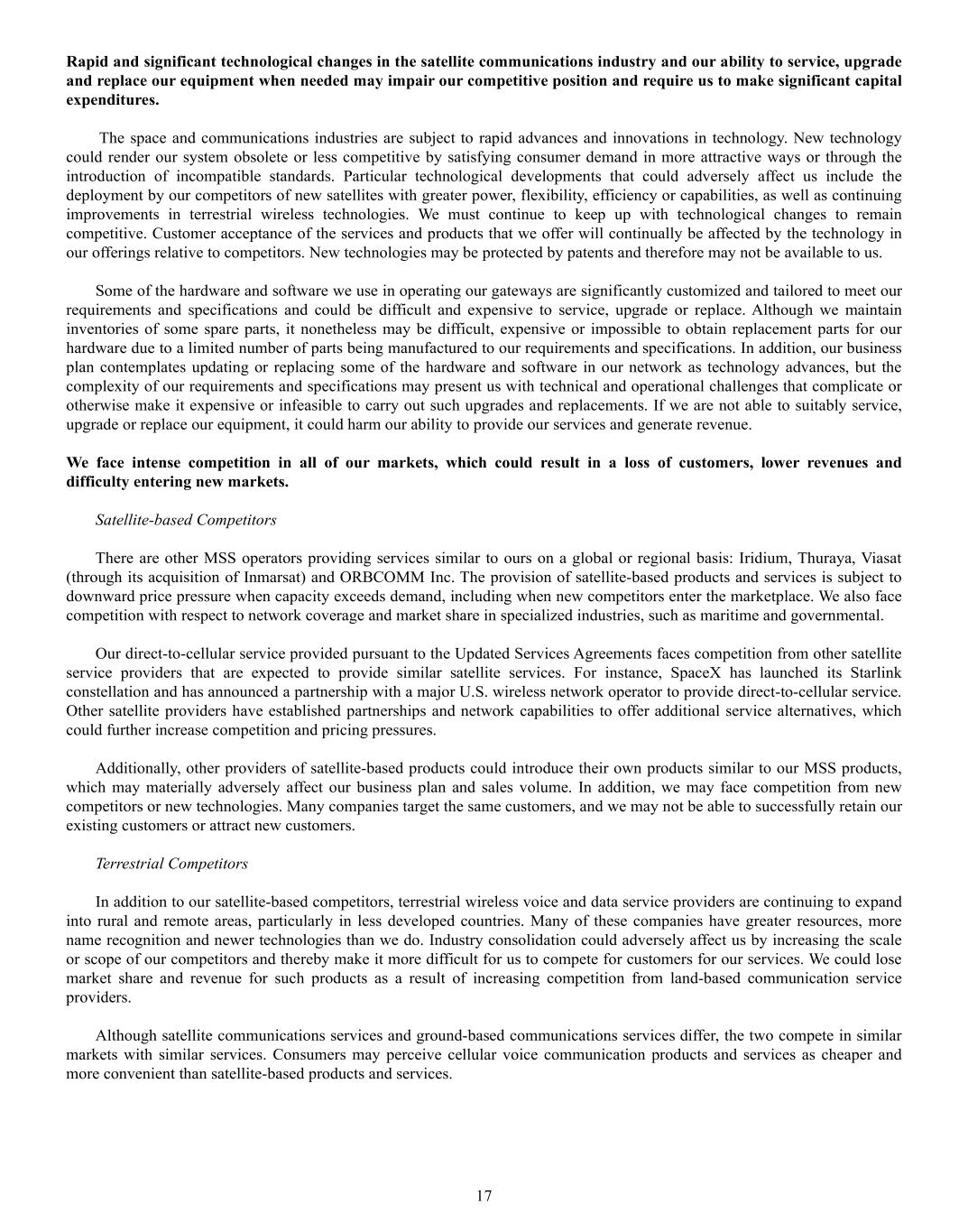
17 Rapid and significant technological changes in the satellite communications industry and our ability to service, upgrade and replace our equipment when needed may impair our competitive position and require us to make significant capital expenditures. The space and communications industries are subject to rapid advances and innovations in technology. New technology could render our system obsolete or less competitive by satisfying consumer demand in more attractive ways or through the introduction of incompatible standards. Particular technological developments that could adversely affect us include the deployment by our competitors of new satellites with greater power, flexibility, efficiency or capabilities, as well as continuing improvements in terrestrial wireless technologies. We must continue to keep up with technological changes to remain competitive. Customer acceptance of the services and products that we offer will continually be affected by the technology in our offerings relative to competitors. New technologies may be protected by patents and therefore may not be available to us. Some of the hardware and software we use in operating our gateways are significantly customized and tailored to meet our requirements and specifications and could be difficult and expensive to service, upgrade or replace. Although we maintain inventories of some spare parts, it nonetheless may be difficult, expensive or impossible to obtain replacement parts for our hardware due to a limited number of parts being manufactured to our requirements and specifications. In addition, our business plan contemplates updating or replacing some of the hardware and software in our network as technology advances, but the complexity of our requirements and specifications may present us with technical and operational challenges that complicate or otherwise make it expensive or infeasible to carry out such upgrades and replacements. If we are not able to suitably service, upgrade or replace our equipment, it could harm our ability to provide our services and generate revenue. We face intense competition in all of our markets, which could result in a loss of customers, lower revenues and difficulty entering new markets. Satellite-based Competitors There are other MSS operators providing services similar to ours on a global or regional basis: Iridium, Thuraya, Viasat (through its acquisition of Inmarsat) and ORBCOMM Inc. The provision of satellite-based products and services is subject to downward price pressure when capacity exceeds demand, including when new competitors enter the marketplace. We also face competition with respect to network coverage and market share in specialized industries, such as maritime and governmental. Our direct-to-cellular service provided pursuant to the Updated Services Agreements faces competition from other satellite service providers that are expected to provide similar satellite services. For instance, SpaceX has launched its Starlink constellation and has announced a partnership with a major U.S. wireless network operator to provide direct-to-cellular service. Other satellite providers have established partnerships and network capabilities to offer additional service alternatives, which could further increase competition and pricing pressures. Additionally, other providers of satellite-based products could introduce their own products similar to our MSS products, which may materially adversely affect our business plan and sales volume. In addition, we may face competition from new competitors or new technologies. Many companies target the same customers, and we may not be able to successfully retain our existing customers or attract new customers. Terrestrial Competitors In addition to our satellite-based competitors, terrestrial wireless voice and data service providers are continuing to expand into rural and remote areas, particularly in less developed countries. Many of these companies have greater resources, more name recognition and newer technologies than we do. Industry consolidation could adversely affect us by increasing the scale or scope of our competitors and thereby make it more difficult for us to compete for customers for our services. We could lose market share and revenue for such products as a result of increasing competition from land-based communication service providers. Although satellite communications services and ground-based communications services differ, the two compete in similar markets with similar services. Consumers may perceive cellular voice communication products and services as cheaper and more convenient than satellite-based products and services.
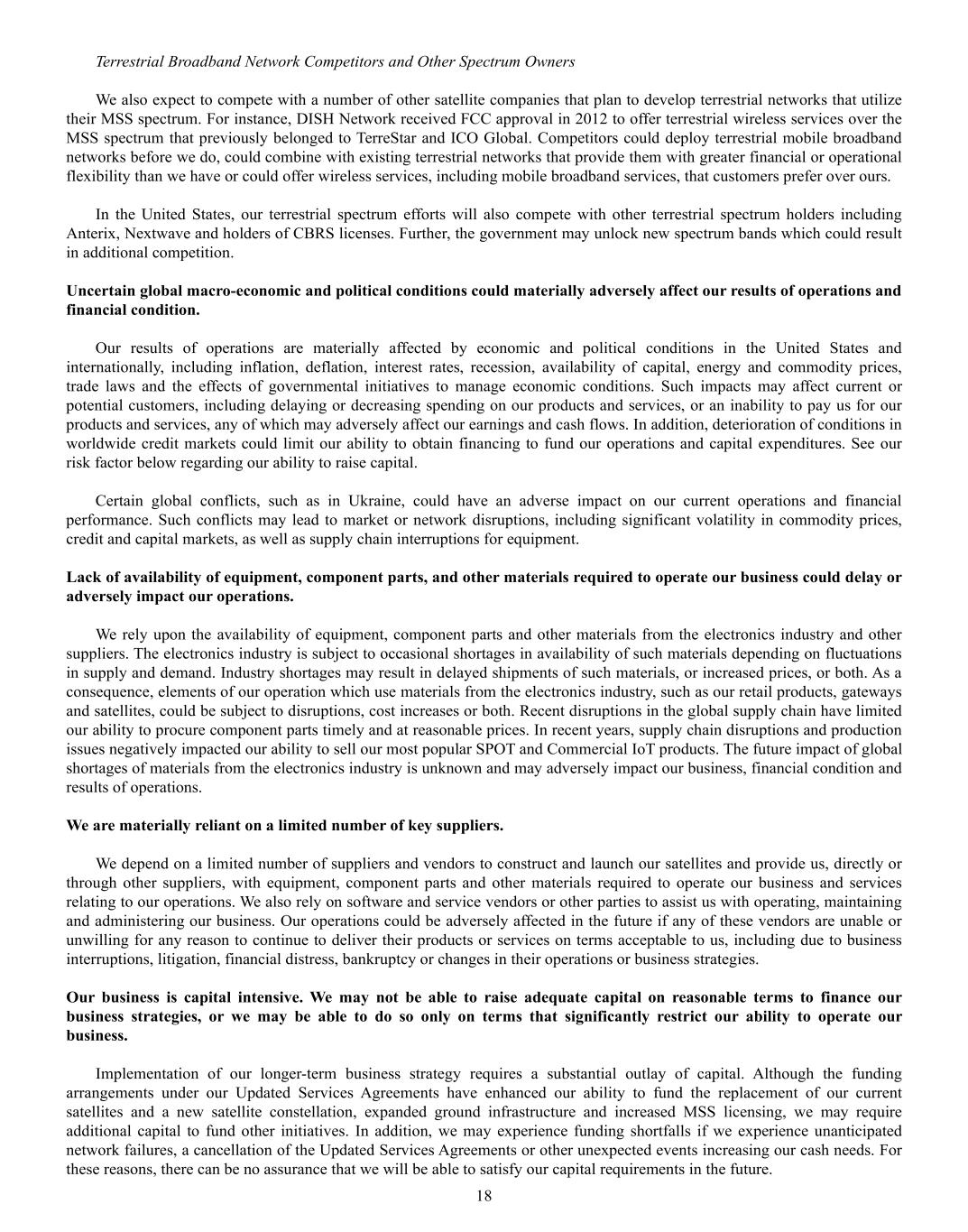
18 Terrestrial Broadband Network Competitors and Other Spectrum Owners We also expect to compete with a number of other satellite companies that plan to develop terrestrial networks that utilize their MSS spectrum. For instance, DISH Network received FCC approval in 2012 to offer terrestrial wireless services over the MSS spectrum that previously belonged to TerreStar and ICO Global. Competitors could deploy terrestrial mobile broadband networks before we do, could combine with existing terrestrial networks that provide them with greater financial or operational flexibility than we have or could offer wireless services, including mobile broadband services, that customers prefer over ours. In the United States, our terrestrial spectrum efforts will also compete with other terrestrial spectrum holders including Anterix, Nextwave and holders of CBRS licenses. Further, the government may unlock new spectrum bands which could result in additional competition. Uncertain global macro-economic and political conditions could materially adversely affect our results of operations and financial condition. Our results of operations are materially affected by economic and political conditions in the United States and internationally, including inflation, deflation, interest rates, recession, availability of capital, energy and commodity prices, trade laws and the effects of governmental initiatives to manage economic conditions. Such impacts may affect current or potential customers, including delaying or decreasing spending on our products and services, or an inability to pay us for our products and services, any of which may adversely affect our earnings and cash flows. In addition, deterioration of conditions in worldwide credit markets could limit our ability to obtain financing to fund our operations and capital expenditures. See our risk factor below regarding our ability to raise capital. Certain global conflicts, such as in Ukraine, could have an adverse impact on our current operations and financial performance. Such conflicts may lead to market or network disruptions, including significant volatility in commodity prices, credit and capital markets, as well as supply chain interruptions for equipment. Lack of availability of equipment, component parts, and other materials required to operate our business could delay or adversely impact our operations. We rely upon the availability of equipment, component parts and other materials from the electronics industry and other suppliers. The electronics industry is subject to occasional shortages in availability of such materials depending on fluctuations in supply and demand. Industry shortages may result in delayed shipments of such materials, or increased prices, or both. As a consequence, elements of our operation which use materials from the electronics industry, such as our retail products, gateways and satellites, could be subject to disruptions, cost increases or both. Recent disruptions in the global supply chain have limited our ability to procure component parts timely and at reasonable prices. In recent years, supply chain disruptions and production issues negatively impacted our ability to sell our most popular SPOT and Commercial IoT products. The future impact of global shortages of materials from the electronics industry is unknown and may adversely impact our business, financial condition and results of operations. We are materially reliant on a limited number of key suppliers. We depend on a limited number of suppliers and vendors to construct and launch our satellites and provide us, directly or through other suppliers, with equipment, component parts and other materials required to operate our business and services relating to our operations. We also rely on software and service vendors or other parties to assist us with operating, maintaining and administering our business. Our operations could be adversely affected in the future if any of these vendors are unable or unwilling for any reason to continue to deliver their products or services on terms acceptable to us, including due to business interruptions, litigation, financial distress, bankruptcy or changes in their operations or business strategies. Our business is capital intensive. We may not be able to raise adequate capital on reasonable terms to finance our business strategies, or we may be able to do so only on terms that significantly restrict our ability to operate our business. Implementation of our longer-term business strategy requires a substantial outlay of capital. Although the funding arrangements under our Updated Services Agreements have enhanced our ability to fund the replacement of our current satellites and a new satellite constellation, expanded ground infrastructure and increased MSS licensing, we may require additional capital to fund other initiatives. In addition, we may experience funding shortfalls if we experience unanticipated network failures, a cancellation of the Updated Services Agreements or other unexpected events increasing our cash needs. For these reasons, there can be no assurance that we will be able to satisfy our capital requirements in the future.
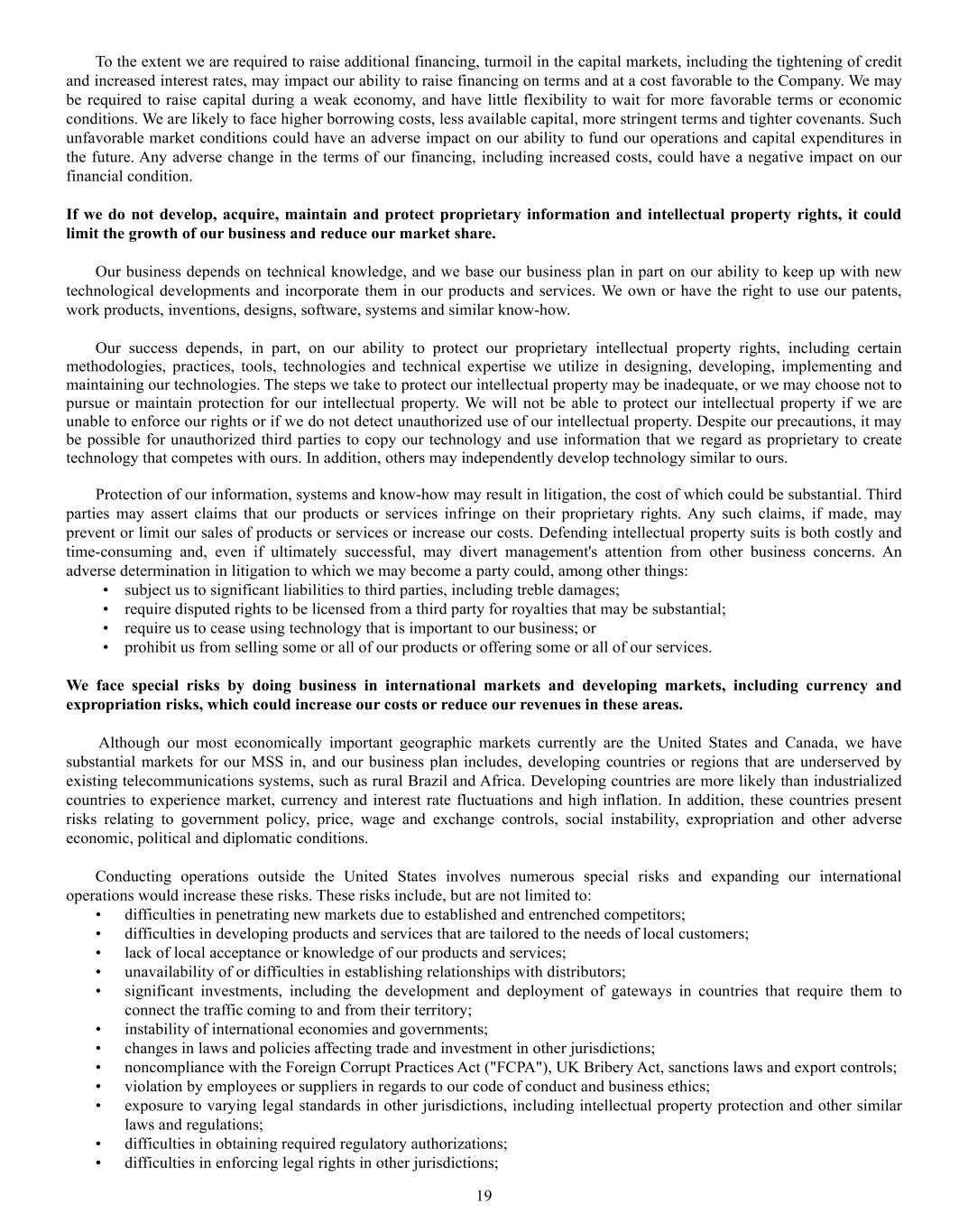
19 To the extent we are required to raise additional financing, turmoil in the capital markets, including the tightening of credit and increased interest rates, may impact our ability to raise financing on terms and at a cost favorable to the Company. We may be required to raise capital during a weak economy, and have little flexibility to wait for more favorable terms or economic conditions. We are likely to face higher borrowing costs, less available capital, more stringent terms and tighter covenants. Such unfavorable market conditions could have an adverse impact on our ability to fund our operations and capital expenditures in the future. Any adverse change in the terms of our financing, including increased costs, could have a negative impact on our financial condition. If we do not develop, acquire, maintain and protect proprietary information and intellectual property rights, it could limit the growth of our business and reduce our market share. Our business depends on technical knowledge, and we base our business plan in part on our ability to keep up with new technological developments and incorporate them in our products and services. We own or have the right to use our patents, work products, inventions, designs, software, systems and similar know-how. Our success depends, in part, on our ability to protect our proprietary intellectual property rights, including certain methodologies, practices, tools, technologies and technical expertise we utilize in designing, developing, implementing and maintaining our technologies. The steps we take to protect our intellectual property may be inadequate, or we may choose not to pursue or maintain protection for our intellectual property. We will not be able to protect our intellectual property if we are unable to enforce our rights or if we do not detect unauthorized use of our intellectual property. Despite our precautions, it may be possible for unauthorized third parties to copy our technology and use information that we regard as proprietary to create technology that competes with ours. In addition, others may independently develop technology similar to ours. Protection of our information, systems and know-how may result in litigation, the cost of which could be substantial. Third parties may assert claims that our products or services infringe on their proprietary rights. Any such claims, if made, may prevent or limit our sales of products or services or increase our costs. Defending intellectual property suits is both costly and time-consuming and, even if ultimately successful, may divert management's attention from other business concerns. An adverse determination in litigation to which we may become a party could, among other things: • subject us to significant liabilities to third parties, including treble damages; • require disputed rights to be licensed from a third party for royalties that may be substantial; • require us to cease using technology that is important to our business; or • prohibit us from selling some or all of our products or offering some or all of our services. We face special risks by doing business in international markets and developing markets, including currency and expropriation risks, which could increase our costs or reduce our revenues in these areas. Although our most economically important geographic markets currently are the United States and Canada, we have substantial markets for our MSS in, and our business plan includes, developing countries or regions that are underserved by existing telecommunications systems, such as rural Brazil and Africa. Developing countries are more likely than industrialized countries to experience market, currency and interest rate fluctuations and high inflation. In addition, these countries present risks relating to government policy, price, wage and exchange controls, social instability, expropriation and other adverse economic, political and diplomatic conditions. Conducting operations outside the United States involves numerous special risks and expanding our international operations would increase these risks. These risks include, but are not limited to: • difficulties in penetrating new markets due to established and entrenched competitors; • difficulties in developing products and services that are tailored to the needs of local customers; • lack of local acceptance or knowledge of our products and services; • unavailability of or difficulties in establishing relationships with distributors; • significant investments, including the development and deployment of gateways in countries that require them to connect the traffic coming to and from their territory; • instability of international economies and governments; • changes in laws and policies affecting trade and investment in other jurisdictions; • noncompliance with the Foreign Corrupt Practices Act ("FCPA"), UK Bribery Act, sanctions laws and export controls; • violation by employees or suppliers in regards to our code of conduct and business ethics; • exposure to varying legal standards in other jurisdictions, including intellectual property protection and other similar laws and regulations; • difficulties in obtaining required regulatory authorizations; • difficulties in enforcing legal rights in other jurisdictions;
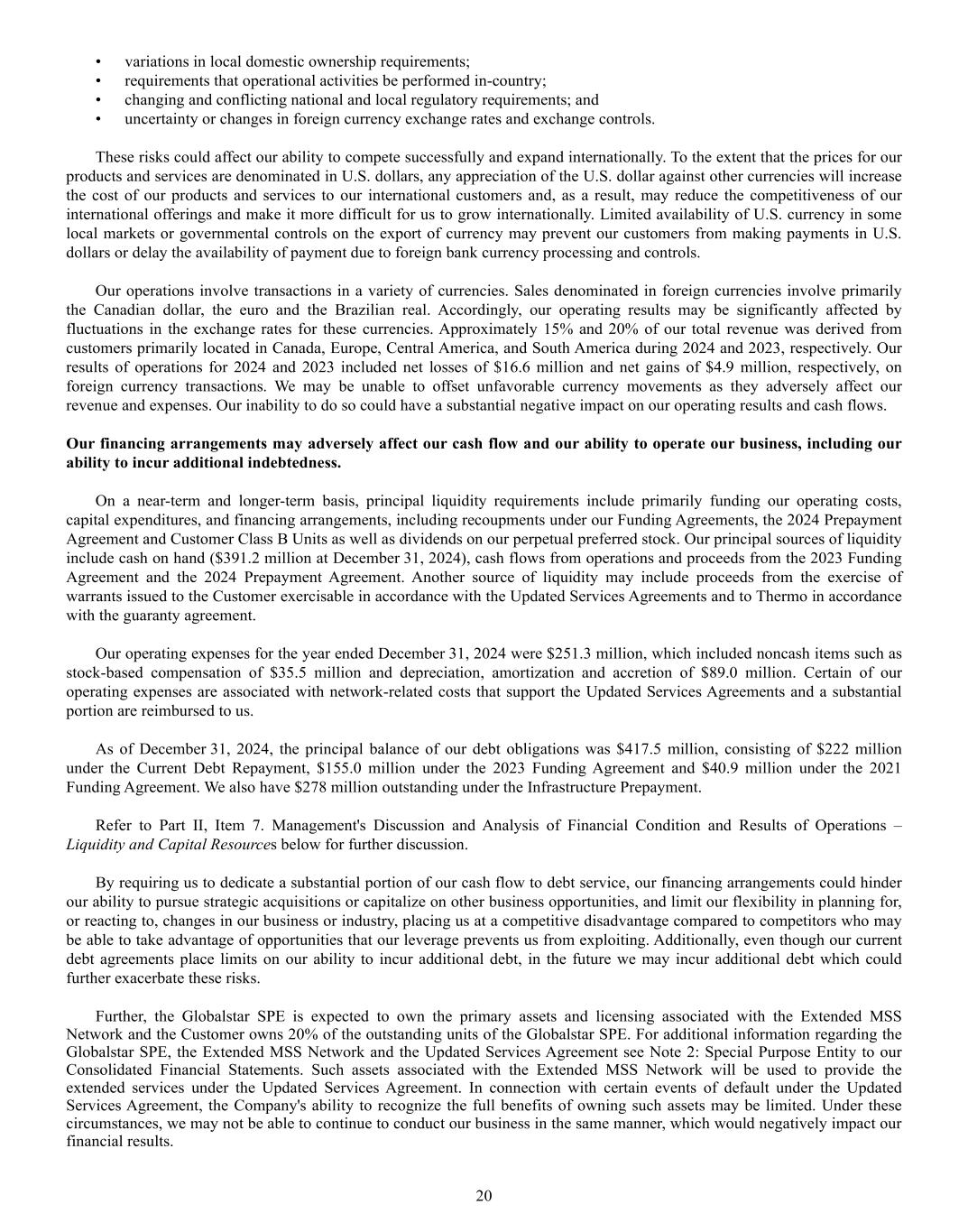
20 • variations in local domestic ownership requirements; • requirements that operational activities be performed in-country; • changing and conflicting national and local regulatory requirements; and • uncertainty or changes in foreign currency exchange rates and exchange controls. These risks could affect our ability to compete successfully and expand internationally. To the extent that the prices for our products and services are denominated in U.S. dollars, any appreciation of the U.S. dollar against other currencies will increase the cost of our products and services to our international customers and, as a result, may reduce the competitiveness of our international offerings and make it more difficult for us to grow internationally. Limited availability of U.S. currency in some local markets or governmental controls on the export of currency may prevent our customers from making payments in U.S. dollars or delay the availability of payment due to foreign bank currency processing and controls. Our operations involve transactions in a variety of currencies. Sales denominated in foreign currencies involve primarily the Canadian dollar, the euro and the Brazilian real. Accordingly, our operating results may be significantly affected by fluctuations in the exchange rates for these currencies. Approximately 15% and 20% of our total revenue was derived from customers primarily located in Canada, Europe, Central America, and South America during 2024 and 2023, respectively. Our results of operations for 2024 and 2023 included net losses of $16.6 million and net gains of $4.9 million, respectively, on foreign currency transactions. We may be unable to offset unfavorable currency movements as they adversely affect our revenue and expenses. Our inability to do so could have a substantial negative impact on our operating results and cash flows. Our financing arrangements may adversely affect our cash flow and our ability to operate our business, including our ability to incur additional indebtedness. On a near-term and longer-term basis, principal liquidity requirements include primarily funding our operating costs, capital expenditures, and financing arrangements, including recoupments under our Funding Agreements, the 2024 Prepayment Agreement and Customer Class B Units as well as dividends on our perpetual preferred stock. Our principal sources of liquidity include cash on hand ($391.2 million at December 31, 2024), cash flows from operations and proceeds from the 2023 Funding Agreement and the 2024 Prepayment Agreement. Another source of liquidity may include proceeds from the exercise of warrants issued to the Customer exercisable in accordance with the Updated Services Agreements and to Thermo in accordance with the guaranty agreement. Our operating expenses for the year ended December 31, 2024 were $251.3 million, which included noncash items such as stock-based compensation of $35.5 million and depreciation, amortization and accretion of $89.0 million. Certain of our operating expenses are associated with network-related costs that support the Updated Services Agreements and a substantial portion are reimbursed to us. As of December 31, 2024, the principal balance of our debt obligations was $417.5 million, consisting of $222 million under the Current Debt Repayment, $155.0 million under the 2023 Funding Agreement and $40.9 million under the 2021 Funding Agreement. We also have $278 million outstanding under the Infrastructure Prepayment. Refer to Part II, Item 7. Management's Discussion and Analysis of Financial Condition and Results of Operations – Liquidity and Capital Resources below for further discussion. By requiring us to dedicate a substantial portion of our cash flow to debt service, our financing arrangements could hinder our ability to pursue strategic acquisitions or capitalize on other business opportunities, and limit our flexibility in planning for, or reacting to, changes in our business or industry, placing us at a competitive disadvantage compared to competitors who may be able to take advantage of opportunities that our leverage prevents us from exploiting. Additionally, even though our current debt agreements place limits on our ability to incur additional debt, in the future we may incur additional debt which could further exacerbate these risks. Further, the Globalstar SPE is expected to own the primary assets and licensing associated with the Extended MSS Network and the Customer owns 20% of the outstanding units of the Globalstar SPE. For additional information regarding the Globalstar SPE, the Extended MSS Network and the Updated Services Agreement see Note 2: Special Purpose Entity to our Consolidated Financial Statements. Such assets associated with the Extended MSS Network will be used to provide the extended services under the Updated Services Agreement. In connection with certain events of default under the Updated Services Agreement, the Company's ability to recognize the full benefits of owning such assets may be limited. Under these circumstances, we may not be able to continue to conduct our business in the same manner, which would negatively impact our financial results.
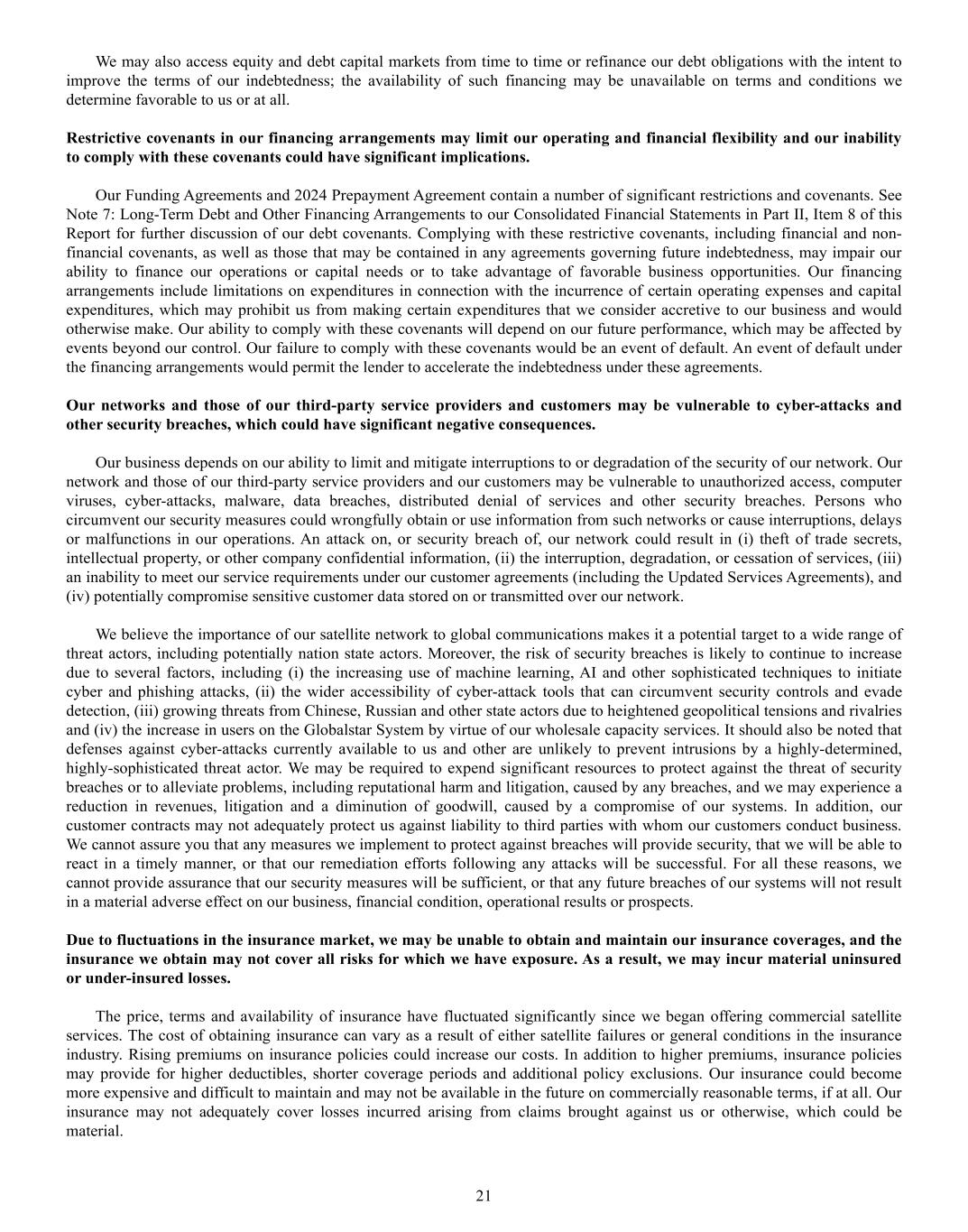
21 We may also access equity and debt capital markets from time to time or refinance our debt obligations with the intent to improve the terms of our indebtedness; the availability of such financing may be unavailable on terms and conditions we determine favorable to us or at all. Restrictive covenants in our financing arrangements may limit our operating and financial flexibility and our inability to comply with these covenants could have significant implications. Our Funding Agreements and 2024 Prepayment Agreement contain a number of significant restrictions and covenants. See Note 7: Long-Term Debt and Other Financing Arrangements to our Consolidated Financial Statements in Part II, Item 8 of this Report for further discussion of our debt covenants. Complying with these restrictive covenants, including financial and non- financial covenants, as well as those that may be contained in any agreements governing future indebtedness, may impair our ability to finance our operations or capital needs or to take advantage of favorable business opportunities. Our financing arrangements include limitations on expenditures in connection with the incurrence of certain operating expenses and capital expenditures, which may prohibit us from making certain expenditures that we consider accretive to our business and would otherwise make. Our ability to comply with these covenants will depend on our future performance, which may be affected by events beyond our control. Our failure to comply with these covenants would be an event of default. An event of default under the financing arrangements would permit the lender to accelerate the indebtedness under these agreements. Our networks and those of our third-party service providers and customers may be vulnerable to cyber-attacks and other security breaches, which could have significant negative consequences. Our business depends on our ability to limit and mitigate interruptions to or degradation of the security of our network. Our network and those of our third-party service providers and our customers may be vulnerable to unauthorized access, computer viruses, cyber-attacks, malware, data breaches, distributed denial of services and other security breaches. Persons who circumvent our security measures could wrongfully obtain or use information from such networks or cause interruptions, delays or malfunctions in our operations. An attack on, or security breach of, our network could result in (i) theft of trade secrets, intellectual property, or other company confidential information, (ii) the interruption, degradation, or cessation of services, (iii) an inability to meet our service requirements under our customer agreements (including the Updated Services Agreements), and (iv) potentially compromise sensitive customer data stored on or transmitted over our network. We believe the importance of our satellite network to global communications makes it a potential target to a wide range of threat actors, including potentially nation state actors. Moreover, the risk of security breaches is likely to continue to increase due to several factors, including (i) the increasing use of machine learning, AI and other sophisticated techniques to initiate cyber and phishing attacks, (ii) the wider accessibility of cyber-attack tools that can circumvent security controls and evade detection, (iii) growing threats from Chinese, Russian and other state actors due to heightened geopolitical tensions and rivalries and (iv) the increase in users on the Globalstar System by virtue of our wholesale capacity services. It should also be noted that defenses against cyber-attacks currently available to us and other are unlikely to prevent intrusions by a highly-determined, highly-sophisticated threat actor. We may be required to expend significant resources to protect against the threat of security breaches or to alleviate problems, including reputational harm and litigation, caused by any breaches, and we may experience a reduction in revenues, litigation and a diminution of goodwill, caused by a compromise of our systems. In addition, our customer contracts may not adequately protect us against liability to third parties with whom our customers conduct business. We cannot assure you that any measures we implement to protect against breaches will provide security, that we will be able to react in a timely manner, or that our remediation efforts following any attacks will be successful. For all these reasons, we cannot provide assurance that our security measures will be sufficient, or that any future breaches of our systems will not result in a material adverse effect on our business, financial condition, operational results or prospects. Due to fluctuations in the insurance market, we may be unable to obtain and maintain our insurance coverages, and the insurance we obtain may not cover all risks for which we have exposure. As a result, we may incur material uninsured or under-insured losses. The price, terms and availability of insurance have fluctuated significantly since we began offering commercial satellite services. The cost of obtaining insurance can vary as a result of either satellite failures or general conditions in the insurance industry. Rising premiums on insurance policies could increase our costs. In addition to higher premiums, insurance policies may provide for higher deductibles, shorter coverage periods and additional policy exclusions. Our insurance could become more expensive and difficult to maintain and may not be available in the future on commercially reasonable terms, if at all. Our insurance may not adequately cover losses incurred arising from claims brought against us or otherwise, which could be material.
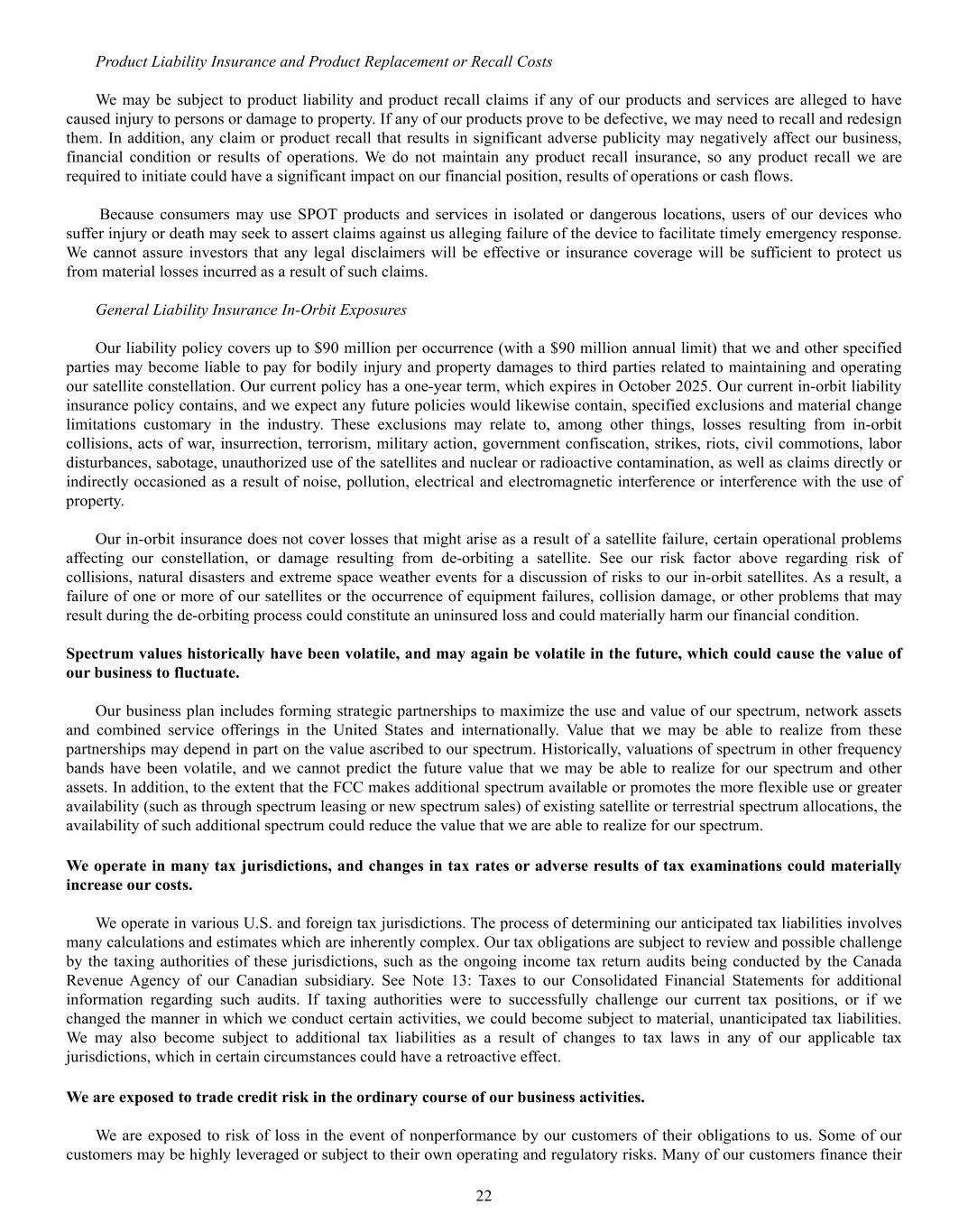
22 Product Liability Insurance and Product Replacement or Recall Costs We may be subject to product liability and product recall claims if any of our products and services are alleged to have caused injury to persons or damage to property. If any of our products prove to be defective, we may need to recall and redesign them. In addition, any claim or product recall that results in significant adverse publicity may negatively affect our business, financial condition or results of operations. We do not maintain any product recall insurance, so any product recall we are required to initiate could have a significant impact on our financial position, results of operations or cash flows. Because consumers may use SPOT products and services in isolated or dangerous locations, users of our devices who suffer injury or death may seek to assert claims against us alleging failure of the device to facilitate timely emergency response. We cannot assure investors that any legal disclaimers will be effective or insurance coverage will be sufficient to protect us from material losses incurred as a result of such claims. General Liability Insurance In-Orbit Exposures Our liability policy covers up to $90 million per occurrence (with a $90 million annual limit) that we and other specified parties may become liable to pay for bodily injury and property damages to third parties related to maintaining and operating our satellite constellation. Our current policy has a one-year term, which expires in October 2025. Our current in-orbit liability insurance policy contains, and we expect any future policies would likewise contain, specified exclusions and material change limitations customary in the industry. These exclusions may relate to, among other things, losses resulting from in-orbit collisions, acts of war, insurrection, terrorism, military action, government confiscation, strikes, riots, civil commotions, labor disturbances, sabotage, unauthorized use of the satellites and nuclear or radioactive contamination, as well as claims directly or indirectly occasioned as a result of noise, pollution, electrical and electromagnetic interference or interference with the use of property. Our in-orbit insurance does not cover losses that might arise as a result of a satellite failure, certain operational problems affecting our constellation, or damage resulting from de-orbiting a satellite. See our risk factor above regarding risk of collisions, natural disasters and extreme space weather events for a discussion of risks to our in-orbit satellites. As a result, a failure of one or more of our satellites or the occurrence of equipment failures, collision damage, or other problems that may result during the de-orbiting process could constitute an uninsured loss and could materially harm our financial condition. Spectrum values historically have been volatile, and may again be volatile in the future, which could cause the value of our business to fluctuate. Our business plan includes forming strategic partnerships to maximize the use and value of our spectrum, network assets and combined service offerings in the United States and internationally. Value that we may be able to realize from these partnerships may depend in part on the value ascribed to our spectrum. Historically, valuations of spectrum in other frequency bands have been volatile, and we cannot predict the future value that we may be able to realize for our spectrum and other assets. In addition, to the extent that the FCC makes additional spectrum available or promotes the more flexible use or greater availability (such as through spectrum leasing or new spectrum sales) of existing satellite or terrestrial spectrum allocations, the availability of such additional spectrum could reduce the value that we are able to realize for our spectrum. We operate in many tax jurisdictions, and changes in tax rates or adverse results of tax examinations could materially increase our costs. We operate in various U.S. and foreign tax jurisdictions. The process of determining our anticipated tax liabilities involves many calculations and estimates which are inherently complex. Our tax obligations are subject to review and possible challenge by the taxing authorities of these jurisdictions, such as the ongoing income tax return audits being conducted by the Canada Revenue Agency of our Canadian subsidiary. See Note 13: Taxes to our Consolidated Financial Statements for additional information regarding such audits. If taxing authorities were to successfully challenge our current tax positions, or if we changed the manner in which we conduct certain activities, we could become subject to material, unanticipated tax liabilities. We may also become subject to additional tax liabilities as a result of changes to tax laws in any of our applicable tax jurisdictions, which in certain circumstances could have a retroactive effect. We are exposed to trade credit risk in the ordinary course of our business activities. We are exposed to risk of loss in the event of nonperformance by our customers of their obligations to us. Some of our customers may be highly leveraged or subject to their own operating and regulatory risks. Many of our customers finance their
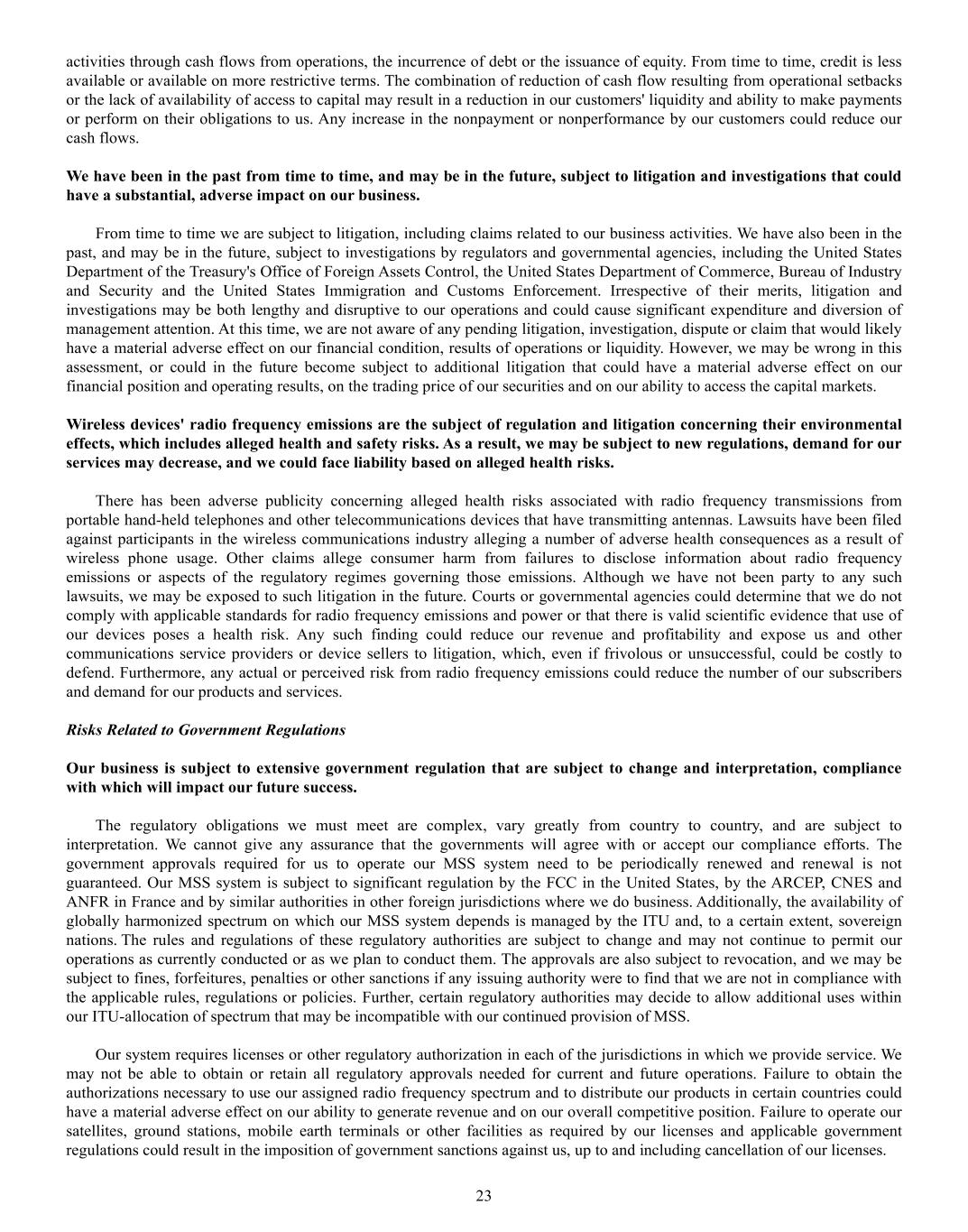
23 activities through cash flows from operations, the incurrence of debt or the issuance of equity. From time to time, credit is less available or available on more restrictive terms. The combination of reduction of cash flow resulting from operational setbacks or the lack of availability of access to capital may result in a reduction in our customers' liquidity and ability to make payments or perform on their obligations to us. Any increase in the nonpayment or nonperformance by our customers could reduce our cash flows. We have been in the past from time to time, and may be in the future, subject to litigation and investigations that could have a substantial, adverse impact on our business. From time to time we are subject to litigation, including claims related to our business activities. We have also been in the past, and may be in the future, subject to investigations by regulators and governmental agencies, including the United States Department of the Treasury's Office of Foreign Assets Control, the United States Department of Commerce, Bureau of Industry and Security and the United States Immigration and Customs Enforcement. Irrespective of their merits, litigation and investigations may be both lengthy and disruptive to our operations and could cause significant expenditure and diversion of management attention. At this time, we are not aware of any pending litigation, investigation, dispute or claim that would likely have a material adverse effect on our financial condition, results of operations or liquidity. However, we may be wrong in this assessment, or could in the future become subject to additional litigation that could have a material adverse effect on our financial position and operating results, on the trading price of our securities and on our ability to access the capital markets. Wireless devices' radio frequency emissions are the subject of regulation and litigation concerning their environmental effects, which includes alleged health and safety risks. As a result, we may be subject to new regulations, demand for our services may decrease, and we could face liability based on alleged health risks. There has been adverse publicity concerning alleged health risks associated with radio frequency transmissions from portable hand-held telephones and other telecommunications devices that have transmitting antennas. Lawsuits have been filed against participants in the wireless communications industry alleging a number of adverse health consequences as a result of wireless phone usage. Other claims allege consumer harm from failures to disclose information about radio frequency emissions or aspects of the regulatory regimes governing those emissions. Although we have not been party to any such lawsuits, we may be exposed to such litigation in the future. Courts or governmental agencies could determine that we do not comply with applicable standards for radio frequency emissions and power or that there is valid scientific evidence that use of our devices poses a health risk. Any such finding could reduce our revenue and profitability and expose us and other communications service providers or device sellers to litigation, which, even if frivolous or unsuccessful, could be costly to defend. Furthermore, any actual or perceived risk from radio frequency emissions could reduce the number of our subscribers and demand for our products and services. Risks Related to Government Regulations Our business is subject to extensive government regulation that are subject to change and interpretation, compliance with which will impact our future success. The regulatory obligations we must meet are complex, vary greatly from country to country, and are subject to interpretation. We cannot give any assurance that the governments will agree with or accept our compliance efforts. The government approvals required for us to operate our MSS system need to be periodically renewed and renewal is not guaranteed. Our MSS system is subject to significant regulation by the FCC in the United States, by the ARCEP, CNES and ANFR in France and by similar authorities in other foreign jurisdictions where we do business. Additionally, the availability of globally harmonized spectrum on which our MSS system depends is managed by the ITU and, to a certain extent, sovereign nations. The rules and regulations of these regulatory authorities are subject to change and may not continue to permit our operations as currently conducted or as we plan to conduct them. The approvals are also subject to revocation, and we may be subject to fines, forfeitures, penalties or other sanctions if any issuing authority were to find that we are not in compliance with the applicable rules, regulations or policies. Further, certain regulatory authorities may decide to allow additional uses within our ITU-allocation of spectrum that may be incompatible with our continued provision of MSS. Our system requires licenses or other regulatory authorization in each of the jurisdictions in which we provide service. We may not be able to obtain or retain all regulatory approvals needed for current and future operations. Failure to obtain the authorizations necessary to use our assigned radio frequency spectrum and to distribute our products in certain countries could have a material adverse effect on our ability to generate revenue and on our overall competitive position. Failure to operate our satellites, ground stations, mobile earth terminals or other facilities as required by our licenses and applicable government regulations could result in the imposition of government sanctions against us, up to and including cancellation of our licenses.
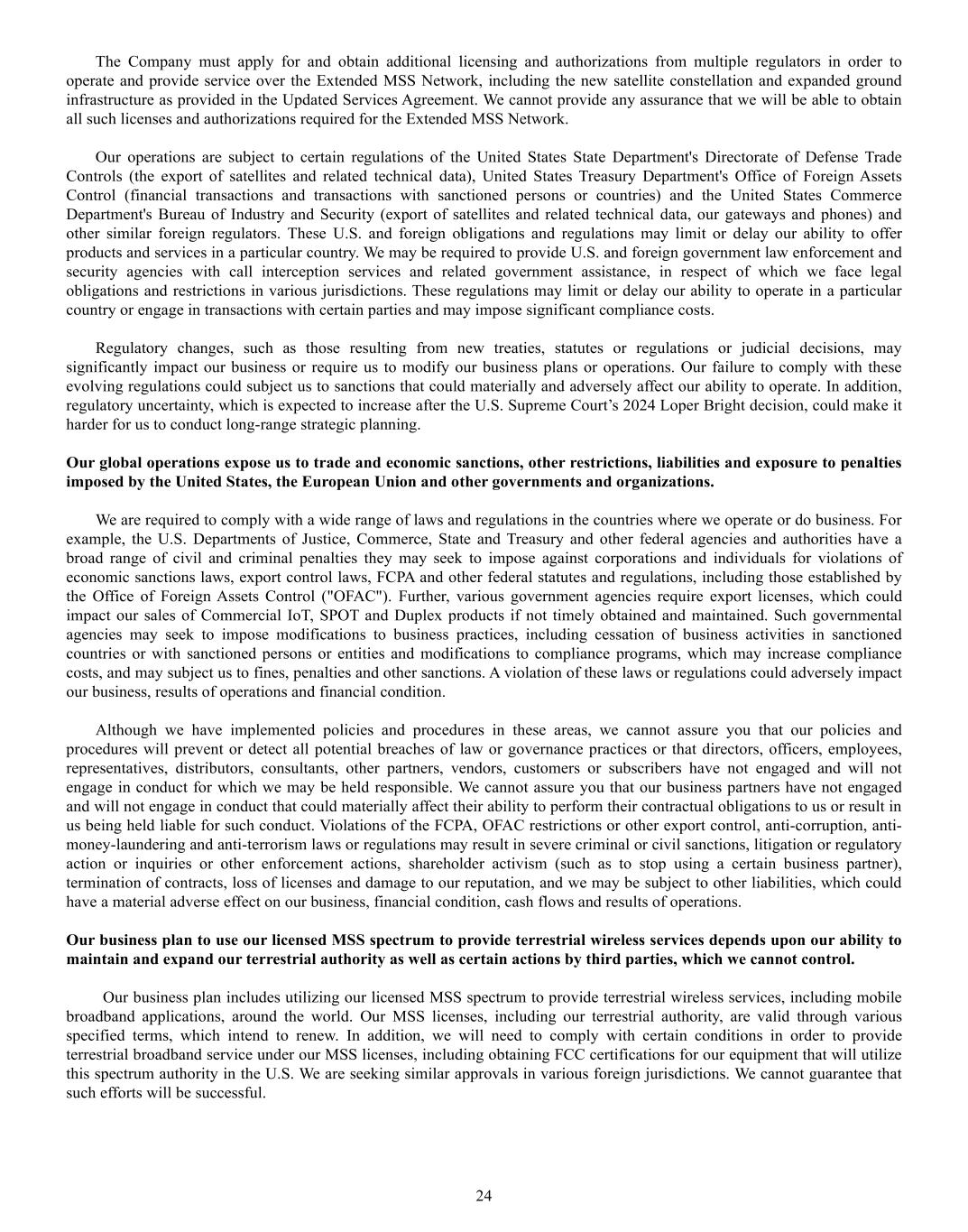
24 The Company must apply for and obtain additional licensing and authorizations from multiple regulators in order to operate and provide service over the Extended MSS Network, including the new satellite constellation and expanded ground infrastructure as provided in the Updated Services Agreement. We cannot provide any assurance that we will be able to obtain all such licenses and authorizations required for the Extended MSS Network. Our operations are subject to certain regulations of the United States State Department's Directorate of Defense Trade Controls (the export of satellites and related technical data), United States Treasury Department's Office of Foreign Assets Control (financial transactions and transactions with sanctioned persons or countries) and the United States Commerce Department's Bureau of Industry and Security (export of satellites and related technical data, our gateways and phones) and other similar foreign regulators. These U.S. and foreign obligations and regulations may limit or delay our ability to offer products and services in a particular country. We may be required to provide U.S. and foreign government law enforcement and security agencies with call interception services and related government assistance, in respect of which we face legal obligations and restrictions in various jurisdictions. These regulations may limit or delay our ability to operate in a particular country or engage in transactions with certain parties and may impose significant compliance costs. Regulatory changes, such as those resulting from new treaties, statutes or regulations or judicial decisions, may significantly impact our business or require us to modify our business plans or operations. Our failure to comply with these evolving regulations could subject us to sanctions that could materially and adversely affect our ability to operate. In addition, regulatory uncertainty, which is expected to increase after the U.S. Supreme Court’s 2024 Loper Bright decision, could make it harder for us to conduct long-range strategic planning. Our global operations expose us to trade and economic sanctions, other restrictions, liabilities and exposure to penalties imposed by the United States, the European Union and other governments and organizations. We are required to comply with a wide range of laws and regulations in the countries where we operate or do business. For example, the U.S. Departments of Justice, Commerce, State and Treasury and other federal agencies and authorities have a broad range of civil and criminal penalties they may seek to impose against corporations and individuals for violations of economic sanctions laws, export control laws, FCPA and other federal statutes and regulations, including those established by the Office of Foreign Assets Control ("OFAC"). Further, various government agencies require export licenses, which could impact our sales of Commercial IoT, SPOT and Duplex products if not timely obtained and maintained. Such governmental agencies may seek to impose modifications to business practices, including cessation of business activities in sanctioned countries or with sanctioned persons or entities and modifications to compliance programs, which may increase compliance costs, and may subject us to fines, penalties and other sanctions. A violation of these laws or regulations could adversely impact our business, results of operations and financial condition. Although we have implemented policies and procedures in these areas, we cannot assure you that our policies and procedures will prevent or detect all potential breaches of law or governance practices or that directors, officers, employees, representatives, distributors, consultants, other partners, vendors, customers or subscribers have not engaged and will not engage in conduct for which we may be held responsible. We cannot assure you that our business partners have not engaged and will not engage in conduct that could materially affect their ability to perform their contractual obligations to us or result in us being held liable for such conduct. Violations of the FCPA, OFAC restrictions or other export control, anti-corruption, anti- money-laundering and anti-terrorism laws or regulations may result in severe criminal or civil sanctions, litigation or regulatory action or inquiries or other enforcement actions, shareholder activism (such as to stop using a certain business partner), termination of contracts, loss of licenses and damage to our reputation, and we may be subject to other liabilities, which could have a material adverse effect on our business, financial condition, cash flows and results of operations. Our business plan to use our licensed MSS spectrum to provide terrestrial wireless services depends upon our ability to maintain and expand our terrestrial authority as well as certain actions by third parties, which we cannot control. Our business plan includes utilizing our licensed MSS spectrum to provide terrestrial wireless services, including mobile broadband applications, around the world. Our MSS licenses, including our terrestrial authority, are valid through various specified terms, which intend to renew. In addition, we will need to comply with certain conditions in order to provide terrestrial broadband service under our MSS licenses, including obtaining FCC certifications for our equipment that will utilize this spectrum authority in the U.S. We are seeking similar approvals in various foreign jurisdictions. We cannot guarantee that such efforts will be successful.
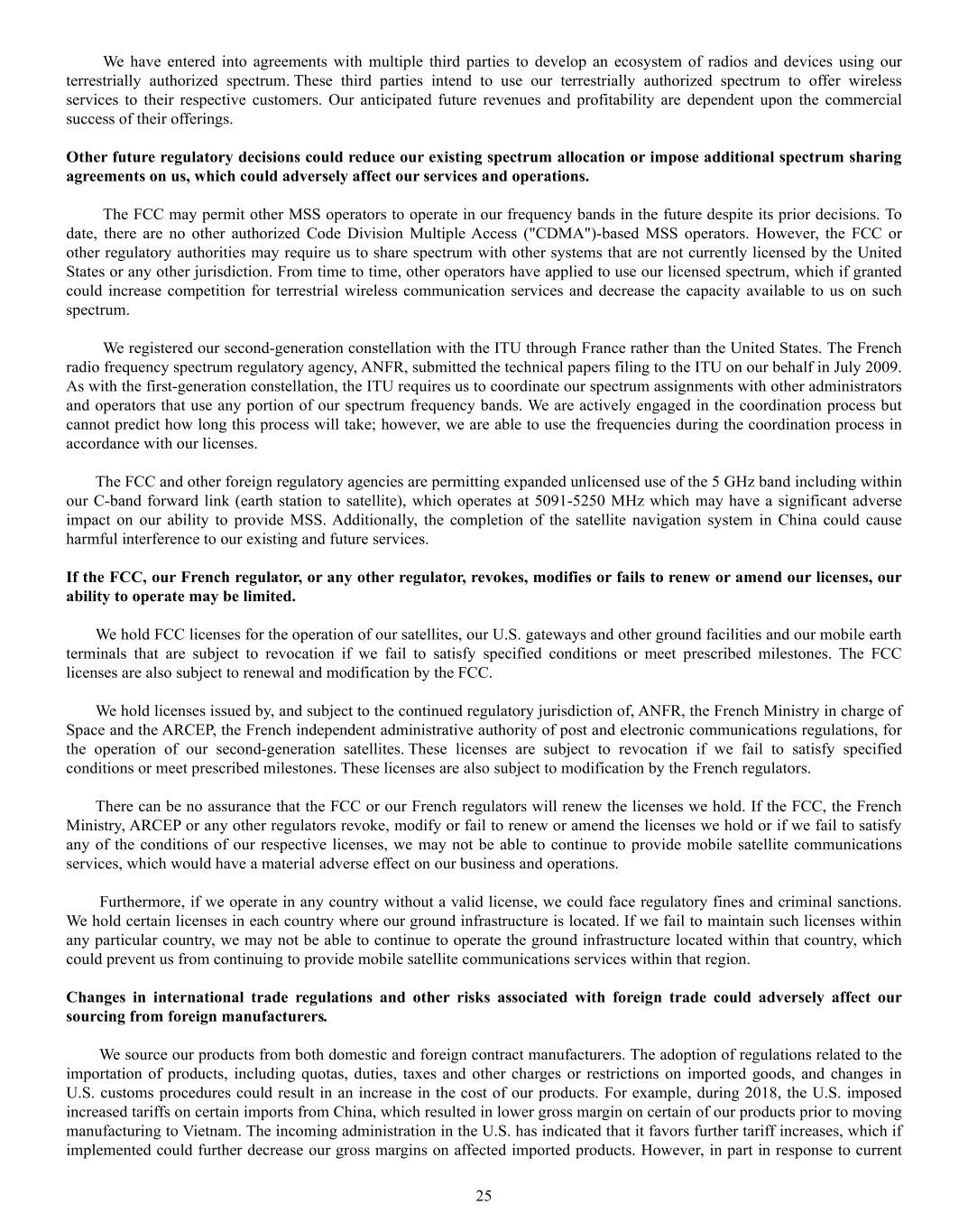
25 We have entered into agreements with multiple third parties to develop an ecosystem of radios and devices using our terrestrially authorized spectrum. These third parties intend to use our terrestrially authorized spectrum to offer wireless services to their respective customers. Our anticipated future revenues and profitability are dependent upon the commercial success of their offerings. Other future regulatory decisions could reduce our existing spectrum allocation or impose additional spectrum sharing agreements on us, which could adversely affect our services and operations. The FCC may permit other MSS operators to operate in our frequency bands in the future despite its prior decisions. To date, there are no other authorized Code Division Multiple Access ("CDMA")-based MSS operators. However, the FCC or other regulatory authorities may require us to share spectrum with other systems that are not currently licensed by the United States or any other jurisdiction. From time to time, other operators have applied to use our licensed spectrum, which if granted could increase competition for terrestrial wireless communication services and decrease the capacity available to us on such spectrum. We registered our second-generation constellation with the ITU through France rather than the United States. The French radio frequency spectrum regulatory agency, ANFR, submitted the technical papers filing to the ITU on our behalf in July 2009. As with the first-generation constellation, the ITU requires us to coordinate our spectrum assignments with other administrators and operators that use any portion of our spectrum frequency bands. We are actively engaged in the coordination process but cannot predict how long this process will take; however, we are able to use the frequencies during the coordination process in accordance with our licenses. The FCC and other foreign regulatory agencies are permitting expanded unlicensed use of the 5 GHz band including within our C-band forward link (earth station to satellite), which operates at 5091-5250 MHz which may have a significant adverse impact on our ability to provide MSS. Additionally, the completion of the satellite navigation system in China could cause harmful interference to our existing and future services. If the FCC, our French regulator, or any other regulator, revokes, modifies or fails to renew or amend our licenses, our ability to operate may be limited. We hold FCC licenses for the operation of our satellites, our U.S. gateways and other ground facilities and our mobile earth terminals that are subject to revocation if we fail to satisfy specified conditions or meet prescribed milestones. The FCC licenses are also subject to renewal and modification by the FCC. We hold licenses issued by, and subject to the continued regulatory jurisdiction of, ANFR, the French Ministry in charge of Space and the ARCEP, the French independent administrative authority of post and electronic communications regulations, for the operation of our second-generation satellites. These licenses are subject to revocation if we fail to satisfy specified conditions or meet prescribed milestones. These licenses are also subject to modification by the French regulators. There can be no assurance that the FCC or our French regulators will renew the licenses we hold. If the FCC, the French Ministry, ARCEP or any other regulators revoke, modify or fail to renew or amend the licenses we hold or if we fail to satisfy any of the conditions of our respective licenses, we may not be able to continue to provide mobile satellite communications services, which would have a material adverse effect on our business and operations. Furthermore, if we operate in any country without a valid license, we could face regulatory fines and criminal sanctions. We hold certain licenses in each country where our ground infrastructure is located. If we fail to maintain such licenses within any particular country, we may not be able to continue to operate the ground infrastructure located within that country, which could prevent us from continuing to provide mobile satellite communications services within that region. Changes in international trade regulations and other risks associated with foreign trade could adversely affect our sourcing from foreign manufacturers. We source our products from both domestic and foreign contract manufacturers. The adoption of regulations related to the importation of products, including quotas, duties, taxes and other charges or restrictions on imported goods, and changes in U.S. customs procedures could result in an increase in the cost of our products. For example, during 2018, the U.S. imposed increased tariffs on certain imports from China, which resulted in lower gross margin on certain of our products prior to moving manufacturing to Vietnam. The incoming administration in the U.S. has indicated that it favors further tariff increases, which if implemented could further decrease our gross margins on affected imported products. However, in part in response to current
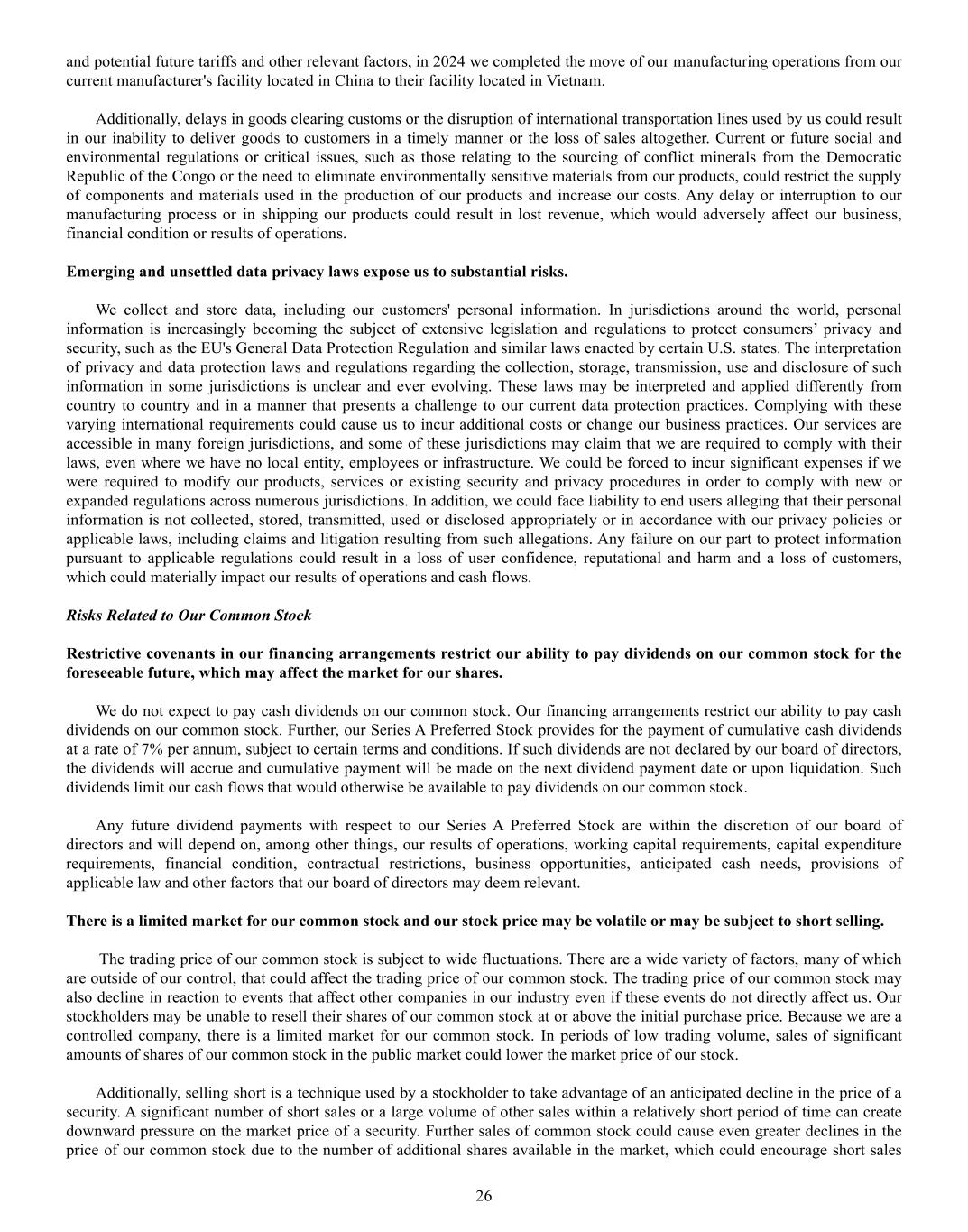
26 and potential future tariffs and other relevant factors, in 2024 we completed the move of our manufacturing operations from our current manufacturer's facility located in China to their facility located in Vietnam. Additionally, delays in goods clearing customs or the disruption of international transportation lines used by us could result in our inability to deliver goods to customers in a timely manner or the loss of sales altogether. Current or future social and environmental regulations or critical issues, such as those relating to the sourcing of conflict minerals from the Democratic Republic of the Congo or the need to eliminate environmentally sensitive materials from our products, could restrict the supply of components and materials used in the production of our products and increase our costs. Any delay or interruption to our manufacturing process or in shipping our products could result in lost revenue, which would adversely affect our business, financial condition or results of operations. Emerging and unsettled data privacy laws expose us to substantial risks. We collect and store data, including our customers' personal information. In jurisdictions around the world, personal information is increasingly becoming the subject of extensive legislation and regulations to protect consumers’ privacy and security, such as the EU's General Data Protection Regulation and similar laws enacted by certain U.S. states. The interpretation of privacy and data protection laws and regulations regarding the collection, storage, transmission, use and disclosure of such information in some jurisdictions is unclear and ever evolving. These laws may be interpreted and applied differently from country to country and in a manner that presents a challenge to our current data protection practices. Complying with these varying international requirements could cause us to incur additional costs or change our business practices. Our services are accessible in many foreign jurisdictions, and some of these jurisdictions may claim that we are required to comply with their laws, even where we have no local entity, employees or infrastructure. We could be forced to incur significant expenses if we were required to modify our products, services or existing security and privacy procedures in order to comply with new or expanded regulations across numerous jurisdictions. In addition, we could face liability to end users alleging that their personal information is not collected, stored, transmitted, used or disclosed appropriately or in accordance with our privacy policies or applicable laws, including claims and litigation resulting from such allegations. Any failure on our part to protect information pursuant to applicable regulations could result in a loss of user confidence, reputational and harm and a loss of customers, which could materially impact our results of operations and cash flows. Risks Related to Our Common Stock Restrictive covenants in our financing arrangements restrict our ability to pay dividends on our common stock for the foreseeable future, which may affect the market for our shares. We do not expect to pay cash dividends on our common stock. Our financing arrangements restrict our ability to pay cash dividends on our common stock. Further, our Series A Preferred Stock provides for the payment of cumulative cash dividends at a rate of 7% per annum, subject to certain terms and conditions. If such dividends are not declared by our board of directors, the dividends will accrue and cumulative payment will be made on the next dividend payment date or upon liquidation. Such dividends limit our cash flows that would otherwise be available to pay dividends on our common stock. Any future dividend payments with respect to our Series A Preferred Stock are within the discretion of our board of directors and will depend on, among other things, our results of operations, working capital requirements, capital expenditure requirements, financial condition, contractual restrictions, business opportunities, anticipated cash needs, provisions of applicable law and other factors that our board of directors may deem relevant. There is a limited market for our common stock and our stock price may be volatile or may be subject to short selling. The trading price of our common stock is subject to wide fluctuations. There are a wide variety of factors, many of which are outside of our control, that could affect the trading price of our common stock. The trading price of our common stock may also decline in reaction to events that affect other companies in our industry even if these events do not directly affect us. Our stockholders may be unable to resell their shares of our common stock at or above the initial purchase price. Because we are a controlled company, there is a limited market for our common stock. In periods of low trading volume, sales of significant amounts of shares of our common stock in the public market could lower the market price of our stock. Additionally, selling short is a technique used by a stockholder to take advantage of an anticipated decline in the price of a security. A significant number of short sales or a large volume of other sales within a relatively short period of time can create downward pressure on the market price of a security. Further sales of common stock could cause even greater declines in the price of our common stock due to the number of additional shares available in the market, which could encourage short sales
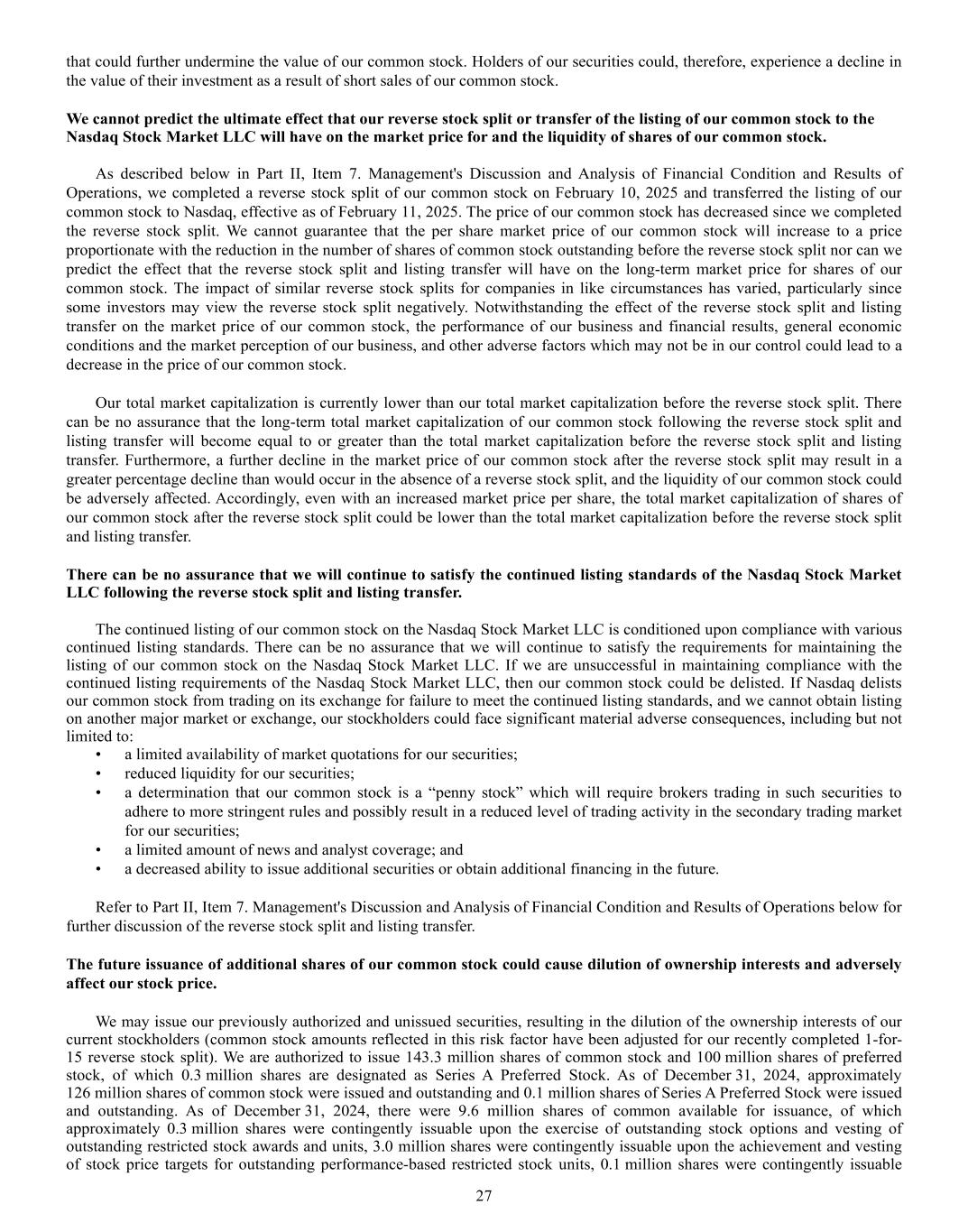
27 that could further undermine the value of our common stock. Holders of our securities could, therefore, experience a decline in the value of their investment as a result of short sales of our common stock. We cannot predict the ultimate effect that our reverse stock split or transfer of the listing of our common stock to the Nasdaq Stock Market LLC will have on the market price for and the liquidity of shares of our common stock. As described below in Part II, Item 7. Management's Discussion and Analysis of Financial Condition and Results of Operations, we completed a reverse stock split of our common stock on February 10, 2025 and transferred the listing of our common stock to Nasdaq, effective as of February 11, 2025. The price of our common stock has decreased since we completed the reverse stock split. We cannot guarantee that the per share market price of our common stock will increase to a price proportionate with the reduction in the number of shares of common stock outstanding before the reverse stock split nor can we predict the effect that the reverse stock split and listing transfer will have on the long-term market price for shares of our common stock. The impact of similar reverse stock splits for companies in like circumstances has varied, particularly since some investors may view the reverse stock split negatively. Notwithstanding the effect of the reverse stock split and listing transfer on the market price of our common stock, the performance of our business and financial results, general economic conditions and the market perception of our business, and other adverse factors which may not be in our control could lead to a decrease in the price of our common stock. Our total market capitalization is currently lower than our total market capitalization before the reverse stock split. There can be no assurance that the long-term total market capitalization of our common stock following the reverse stock split and listing transfer will become equal to or greater than the total market capitalization before the reverse stock split and listing transfer. Furthermore, a further decline in the market price of our common stock after the reverse stock split may result in a greater percentage decline than would occur in the absence of a reverse stock split, and the liquidity of our common stock could be adversely affected. Accordingly, even with an increased market price per share, the total market capitalization of shares of our common stock after the reverse stock split could be lower than the total market capitalization before the reverse stock split and listing transfer. There can be no assurance that we will continue to satisfy the continued listing standards of the Nasdaq Stock Market LLC following the reverse stock split and listing transfer. The continued listing of our common stock on the Nasdaq Stock Market LLC is conditioned upon compliance with various continued listing standards. There can be no assurance that we will continue to satisfy the requirements for maintaining the listing of our common stock on the Nasdaq Stock Market LLC. If we are unsuccessful in maintaining compliance with the continued listing requirements of the Nasdaq Stock Market LLC, then our common stock could be delisted. If Nasdaq delists our common stock from trading on its exchange for failure to meet the continued listing standards, and we cannot obtain listing on another major market or exchange, our stockholders could face significant material adverse consequences, including but not limited to: • a limited availability of market quotations for our securities; • reduced liquidity for our securities; • a determination that our common stock is a “penny stock” which will require brokers trading in such securities to adhere to more stringent rules and possibly result in a reduced level of trading activity in the secondary trading market for our securities; • a limited amount of news and analyst coverage; and • a decreased ability to issue additional securities or obtain additional financing in the future. Refer to Part II, Item 7. Management's Discussion and Analysis of Financial Condition and Results of Operations below for further discussion of the reverse stock split and listing transfer. The future issuance of additional shares of our common stock could cause dilution of ownership interests and adversely affect our stock price. We may issue our previously authorized and unissued securities, resulting in the dilution of the ownership interests of our current stockholders (common stock amounts reflected in this risk factor have been adjusted for our recently completed 1-for- 15 reverse stock split). We are authorized to issue 143.3 million shares of common stock and 100 million shares of preferred stock, of which 0.3 million shares are designated as Series A Preferred Stock. As of December 31, 2024, approximately 126 million shares of common stock were issued and outstanding and 0.1 million shares of Series A Preferred Stock were issued and outstanding. As of December 31, 2024, there were 9.6 million shares of common available for issuance, of which approximately 0.3 million shares were contingently issuable upon the exercise of outstanding stock options and vesting of outstanding restricted stock awards and units, 3.0 million shares were contingently issuable upon the achievement and vesting of stock price targets for outstanding performance-based restricted stock units, 0.1 million shares were contingently issuable
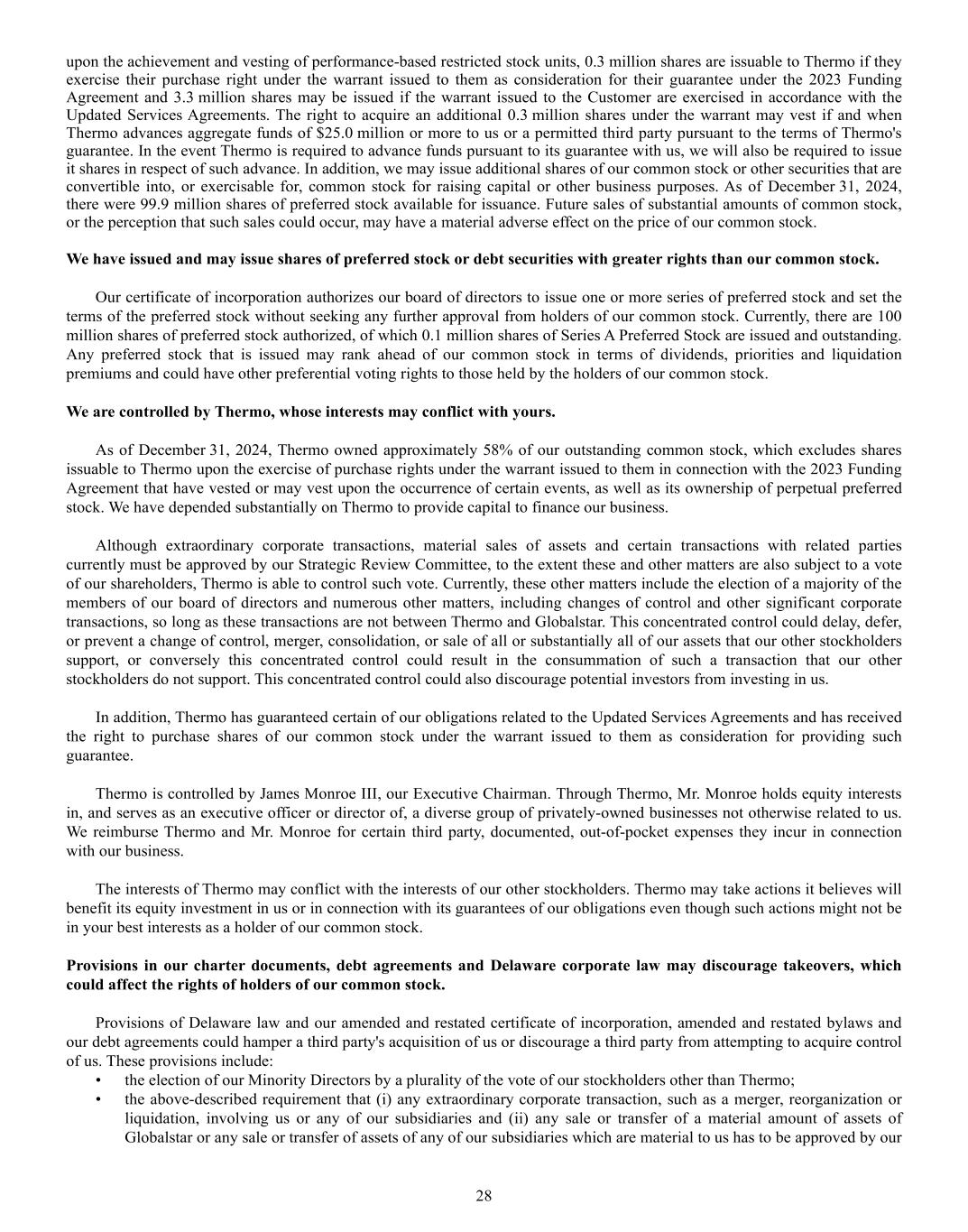
28 upon the achievement and vesting of performance-based restricted stock units, 0.3 million shares are issuable to Thermo if they exercise their purchase right under the warrant issued to them as consideration for their guarantee under the 2023 Funding Agreement and 3.3 million shares may be issued if the warrant issued to the Customer are exercised in accordance with the Updated Services Agreements. The right to acquire an additional 0.3 million shares under the warrant may vest if and when Thermo advances aggregate funds of $25.0 million or more to us or a permitted third party pursuant to the terms of Thermo's guarantee. In the event Thermo is required to advance funds pursuant to its guarantee with us, we will also be required to issue it shares in respect of such advance. In addition, we may issue additional shares of our common stock or other securities that are convertible into, or exercisable for, common stock for raising capital or other business purposes. As of December 31, 2024, there were 99.9 million shares of preferred stock available for issuance. Future sales of substantial amounts of common stock, or the perception that such sales could occur, may have a material adverse effect on the price of our common stock. We have issued and may issue shares of preferred stock or debt securities with greater rights than our common stock. Our certificate of incorporation authorizes our board of directors to issue one or more series of preferred stock and set the terms of the preferred stock without seeking any further approval from holders of our common stock. Currently, there are 100 million shares of preferred stock authorized, of which 0.1 million shares of Series A Preferred Stock are issued and outstanding. Any preferred stock that is issued may rank ahead of our common stock in terms of dividends, priorities and liquidation premiums and could have other preferential voting rights to those held by the holders of our common stock. We are controlled by Thermo, whose interests may conflict with yours. As of December 31, 2024, Thermo owned approximately 58% of our outstanding common stock, which excludes shares issuable to Thermo upon the exercise of purchase rights under the warrant issued to them in connection with the 2023 Funding Agreement that have vested or may vest upon the occurrence of certain events, as well as its ownership of perpetual preferred stock. We have depended substantially on Thermo to provide capital to finance our business. Although extraordinary corporate transactions, material sales of assets and certain transactions with related parties currently must be approved by our Strategic Review Committee, to the extent these and other matters are also subject to a vote of our shareholders, Thermo is able to control such vote. Currently, these other matters include the election of a majority of the members of our board of directors and numerous other matters, including changes of control and other significant corporate transactions, so long as these transactions are not between Thermo and Globalstar. This concentrated control could delay, defer, or prevent a change of control, merger, consolidation, or sale of all or substantially all of our assets that our other stockholders support, or conversely this concentrated control could result in the consummation of such a transaction that our other stockholders do not support. This concentrated control could also discourage potential investors from investing in us. In addition, Thermo has guaranteed certain of our obligations related to the Updated Services Agreements and has received the right to purchase shares of our common stock under the warrant issued to them as consideration for providing such guarantee. Thermo is controlled by James Monroe III, our Executive Chairman. Through Thermo, Mr. Monroe holds equity interests in, and serves as an executive officer or director of, a diverse group of privately-owned businesses not otherwise related to us. We reimburse Thermo and Mr. Monroe for certain third party, documented, out-of-pocket expenses they incur in connection with our business. The interests of Thermo may conflict with the interests of our other stockholders. Thermo may take actions it believes will benefit its equity investment in us or in connection with its guarantees of our obligations even though such actions might not be in your best interests as a holder of our common stock. Provisions in our charter documents, debt agreements and Delaware corporate law may discourage takeovers, which could affect the rights of holders of our common stock. Provisions of Delaware law and our amended and restated certificate of incorporation, amended and restated bylaws and our debt agreements could hamper a third party's acquisition of us or discourage a third party from attempting to acquire control of us. These provisions include: • the election of our Minority Directors by a plurality of the vote of our stockholders other than Thermo; • the above-described requirement that (i) any extraordinary corporate transaction, such as a merger, reorganization or liquidation, involving us or any of our subsidiaries and (ii) any sale or transfer of a material amount of assets of Globalstar or any sale or transfer of assets of any of our subsidiaries which are material to us has to be approved by our
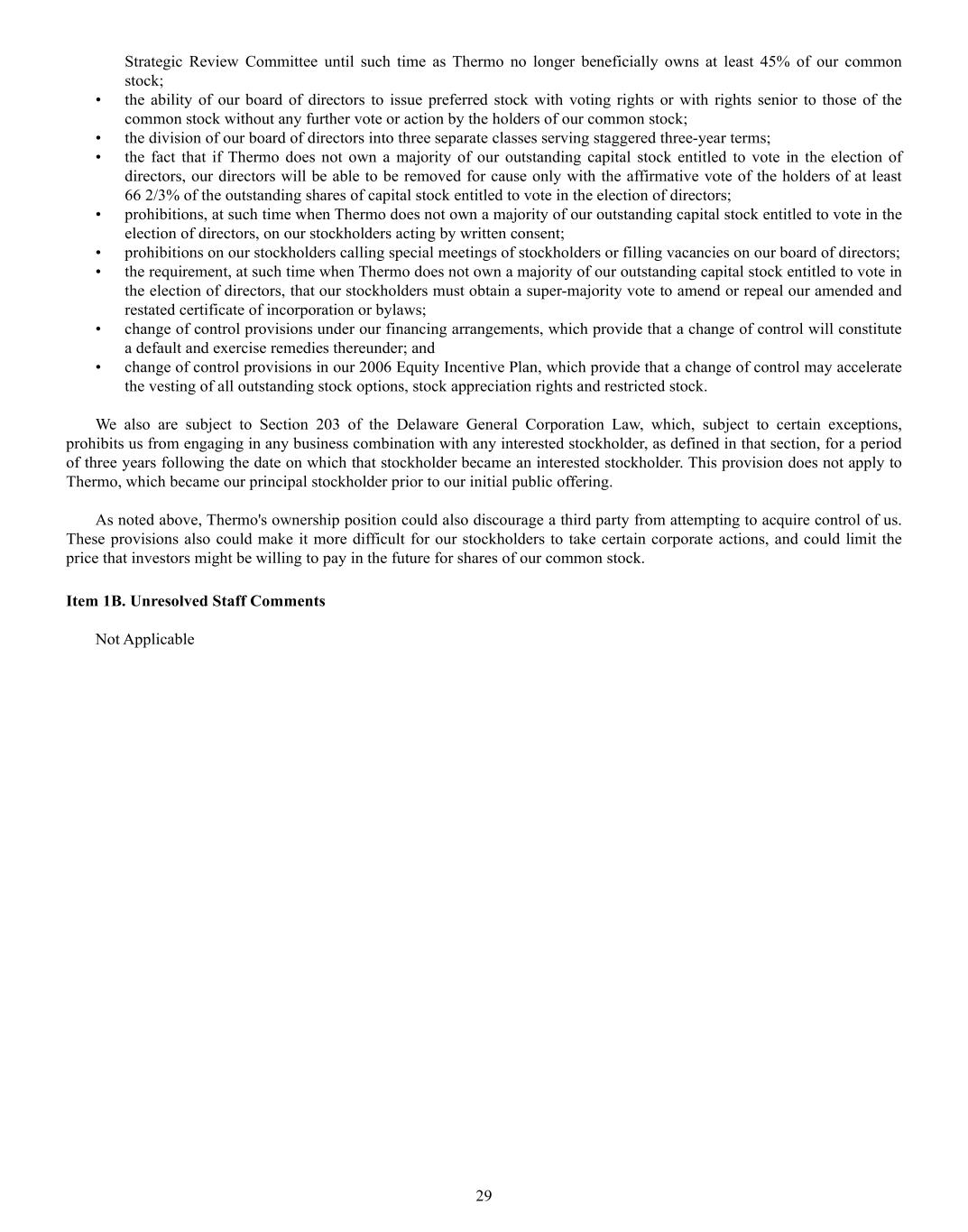
29 Strategic Review Committee until such time as Thermo no longer beneficially owns at least 45% of our common stock; • the ability of our board of directors to issue preferred stock with voting rights or with rights senior to those of the common stock without any further vote or action by the holders of our common stock; • the division of our board of directors into three separate classes serving staggered three-year terms; • the fact that if Thermo does not own a majority of our outstanding capital stock entitled to vote in the election of directors, our directors will be able to be removed for cause only with the affirmative vote of the holders of at least 66 2/3% of the outstanding shares of capital stock entitled to vote in the election of directors; • prohibitions, at such time when Thermo does not own a majority of our outstanding capital stock entitled to vote in the election of directors, on our stockholders acting by written consent; • prohibitions on our stockholders calling special meetings of stockholders or filling vacancies on our board of directors; • the requirement, at such time when Thermo does not own a majority of our outstanding capital stock entitled to vote in the election of directors, that our stockholders must obtain a super-majority vote to amend or repeal our amended and restated certificate of incorporation or bylaws; • change of control provisions under our financing arrangements, which provide that a change of control will constitute a default and exercise remedies thereunder; and • change of control provisions in our 2006 Equity Incentive Plan, which provide that a change of control may accelerate the vesting of all outstanding stock options, stock appreciation rights and restricted stock. We also are subject to Section 203 of the Delaware General Corporation Law, which, subject to certain exceptions, prohibits us from engaging in any business combination with any interested stockholder, as defined in that section, for a period of three years following the date on which that stockholder became an interested stockholder. This provision does not apply to Thermo, which became our principal stockholder prior to our initial public offering. As noted above, Thermo's ownership position could also discourage a third party from attempting to acquire control of us. These provisions also could make it more difficult for our stockholders to take certain corporate actions, and could limit the price that investors might be willing to pay in the future for shares of our common stock. Item 1B. Unresolved Staff Comments Not Applicable

30 Item 1C. Cybersecurity Risk Management and Strategy We have an enterprise-wide information security program designed to identify, protect against, detect, respond to and manage reasonably foreseeable cybersecurity risks and threats. Our information security program is integrated into our overall risk management systems and led by our Data Protection Officer. This program is on par with industry standards and best practices, such as the National Institute of Standards and Technology (“NIST”) Cybersecurity Framework. Internal employees as well as third party advisors are involved in the development and continued maintenance of our cybersecurity program. We also hold cybersecurity insurance as part of our risk management program. The program is evaluated and audited on an annual basis by independent third parties through ongoing IT compliance initiatives. Additionally, each year, we conduct cross-functional tabletop training exercises to rehearse our response to cyber- related breach incidents. We require that all employees complete cybersecurity trainings at least quarterly to mitigate cyber risks. We also randomly test employees with phishing simulations and provide periodic cyber and security updates. As part of the risk management program, we engaged external subject matter experts to develop a comprehensive third party and vendor due diligence program. This program strengthens our cybersecurity program by ensuring the establishment of contractual agreements and data protection clauses, documentation of processing activities performed as part of each service and identifies responsible process owners. Third parties and vendors with access to our information, systems and networks complete additional due diligence verification activities. All vendors with access to internal systems and networks must comply with our IT policies. Formal monitoring procedures of relationships with third parties are performed on at least an annual basis. This level of oversight allows us to maintain proactive visibility and security baseline requirements with our established external relationships. Our formalized cybersecurity incident response plan is a framework to facilitate the detection, identification, containment and eradication of and recovery from cybersecurity incidents. This framework addresses how and which risks impact our operational, financial or reputational standing and/or the ability to comply with regulatory or legal requirements. Governance Oversight of our cybersecurity program is performed by our executive management and board of directors. Specifically, our executive management includes our Vice President of Network IT and Applications, who serves as our Data Protection Officer and has over 25 years of experience in IT systems, cybersecurity and risk management, as well as our Chief Executive Officer and Chief Financial Officer. Our Vice President of Network IT and Applications is responsible for reviewing cybersecurity risks, controls, policies and processes. This includes training, policy development and updates, while also keeping senior leadership informed on cybersecurity matters. We also have a department dedicated to monitoring our systems to prevent cybersecurity attacks. The Board of Directors receives information from management regarding any significant changes to the Company’s cybersecurity policies and procedures, as well as recently identified risks and other recent information relative to cybersecurity, and on at least an annual basis our Data Protection Officer presents the Company’s cybersecurity program to the Board of Directors. As of the date of this report, we are not aware of any material risks from cybersecurity threats, that have materially affected or are reasonably likely to materially affect the Company, including our business strategy, results of operations, or financial condition. However, we are subject to various cybersecurity risks that could adversely affect our business, financial condition and results of operations. Such risks may include harm to our employees or customers, violation of privacy laws, theft, fraud, extortion as well as legal and reputational risk. See Item 1A. Risk Factors, “Our networks and those of our third-party service providers and customers may be vulnerable to cyber-attacks and other security breaches, which could have significant negative consequences." for further discussion.
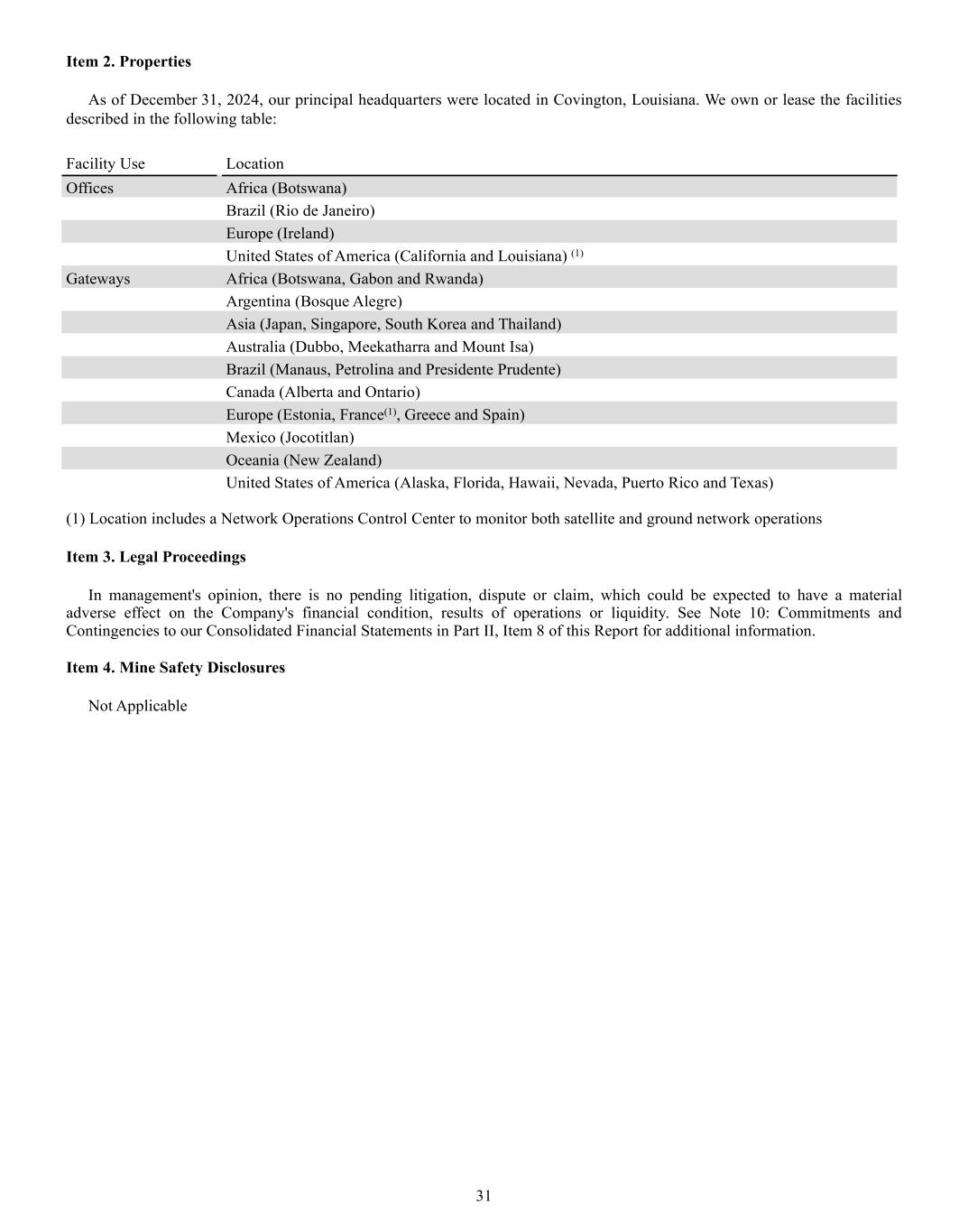
31 Item 2. Properties As of December 31, 2024, our principal headquarters were located in Covington, Louisiana. We own or lease the facilities described in the following table: Facility Use Location Offices Africa (Botswana) Brazil (Rio de Janeiro) Europe (Ireland) United States of America (California and Louisiana) (1) Gateways Africa (Botswana, Gabon and Rwanda) Argentina (Bosque Alegre) Asia (Japan, Singapore, South Korea and Thailand) Australia (Dubbo, Meekatharra and Mount Isa) Brazil (Manaus, Petrolina and Presidente Prudente) Canada (Alberta and Ontario) Europe (Estonia, France(1), Greece and Spain) Mexico (Jocotitlan) Oceania (New Zealand) United States of America (Alaska, Florida, Hawaii, Nevada, Puerto Rico and Texas) (1) Location includes a Network Operations Control Center to monitor both satellite and ground network operations Item 3. Legal Proceedings In management's opinion, there is no pending litigation, dispute or claim, which could be expected to have a material adverse effect on the Company's financial condition, results of operations or liquidity. See Note 10: Commitments and Contingencies to our Consolidated Financial Statements in Part II, Item 8 of this Report for additional information. Item 4. Mine Safety Disclosures Not Applicable
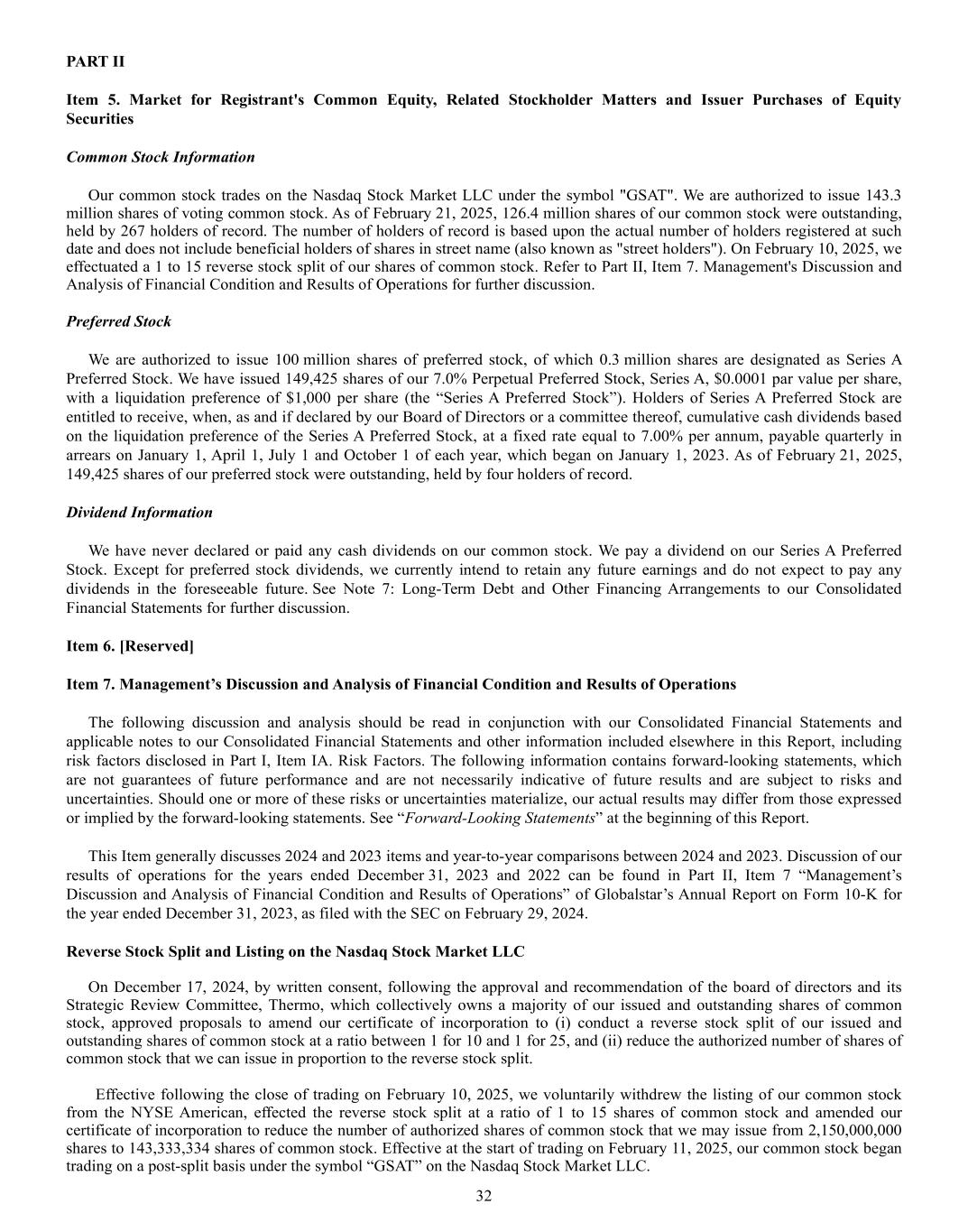
32 PART II Item 5. Market for Registrant's Common Equity, Related Stockholder Matters and Issuer Purchases of Equity Securities Common Stock Information Our common stock trades on the Nasdaq Stock Market LLC under the symbol "GSAT". We are authorized to issue 143.3 million shares of voting common stock. As of February 21, 2025, 126.4 million shares of our common stock were outstanding, held by 267 holders of record. The number of holders of record is based upon the actual number of holders registered at such date and does not include beneficial holders of shares in street name (also known as "street holders"). On February 10, 2025, we effectuated a 1 to 15 reverse stock split of our shares of common stock. Refer to Part II, Item 7. Management's Discussion and Analysis of Financial Condition and Results of Operations for further discussion. Preferred Stock We are authorized to issue 100 million shares of preferred stock, of which 0.3 million shares are designated as Series A Preferred Stock. We have issued 149,425 shares of our 7.0% Perpetual Preferred Stock, Series A, $0.0001 par value per share, with a liquidation preference of $1,000 per share (the “Series A Preferred Stock”). Holders of Series A Preferred Stock are entitled to receive, when, as and if declared by our Board of Directors or a committee thereof, cumulative cash dividends based on the liquidation preference of the Series A Preferred Stock, at a fixed rate equal to 7.00% per annum, payable quarterly in arrears on January 1, April 1, July 1 and October 1 of each year, which began on January 1, 2023. As of February 21, 2025, 149,425 shares of our preferred stock were outstanding, held by four holders of record. Dividend Information We have never declared or paid any cash dividends on our common stock. We pay a dividend on our Series A Preferred Stock. Except for preferred stock dividends, we currently intend to retain any future earnings and do not expect to pay any dividends in the foreseeable future. See Note 7: Long-Term Debt and Other Financing Arrangements to our Consolidated Financial Statements for further discussion. Item 6. [Reserved] Item 7. Management’s Discussion and Analysis of Financial Condition and Results of Operations The following discussion and analysis should be read in conjunction with our Consolidated Financial Statements and applicable notes to our Consolidated Financial Statements and other information included elsewhere in this Report, including risk factors disclosed in Part I, Item IA. Risk Factors. The following information contains forward-looking statements, which are not guarantees of future performance and are not necessarily indicative of future results and are subject to risks and uncertainties. Should one or more of these risks or uncertainties materialize, our actual results may differ from those expressed or implied by the forward-looking statements. See “Forward-Looking Statements” at the beginning of this Report. This Item generally discusses 2024 and 2023 items and year-to-year comparisons between 2024 and 2023. Discussion of our results of operations for the years ended December 31, 2023 and 2022 can be found in Part II, Item 7 “Management’s Discussion and Analysis of Financial Condition and Results of Operations” of Globalstar’s Annual Report on Form 10-K for the year ended December 31, 2023, as filed with the SEC on February 29, 2024. Reverse Stock Split and Listing on the Nasdaq Stock Market LLC On December 17, 2024, by written consent, following the approval and recommendation of the board of directors and its Strategic Review Committee, Thermo, which collectively owns a majority of our issued and outstanding shares of common stock, approved proposals to amend our certificate of incorporation to (i) conduct a reverse stock split of our issued and outstanding shares of common stock at a ratio between 1 for 10 and 1 for 25, and (ii) reduce the authorized number of shares of common stock that we can issue in proportion to the reverse stock split. Effective following the close of trading on February 10, 2025, we voluntarily withdrew the listing of our common stock from the NYSE American, effected the reverse stock split at a ratio of 1 to 15 shares of common stock and amended our certificate of incorporation to reduce the number of authorized shares of common stock that we may issue from 2,150,000,000 shares to 143,333,334 shares of common stock. Effective at the start of trading on February 11, 2025, our common stock began trading on a post-split basis under the symbol “GSAT” on the Nasdaq Stock Market LLC.
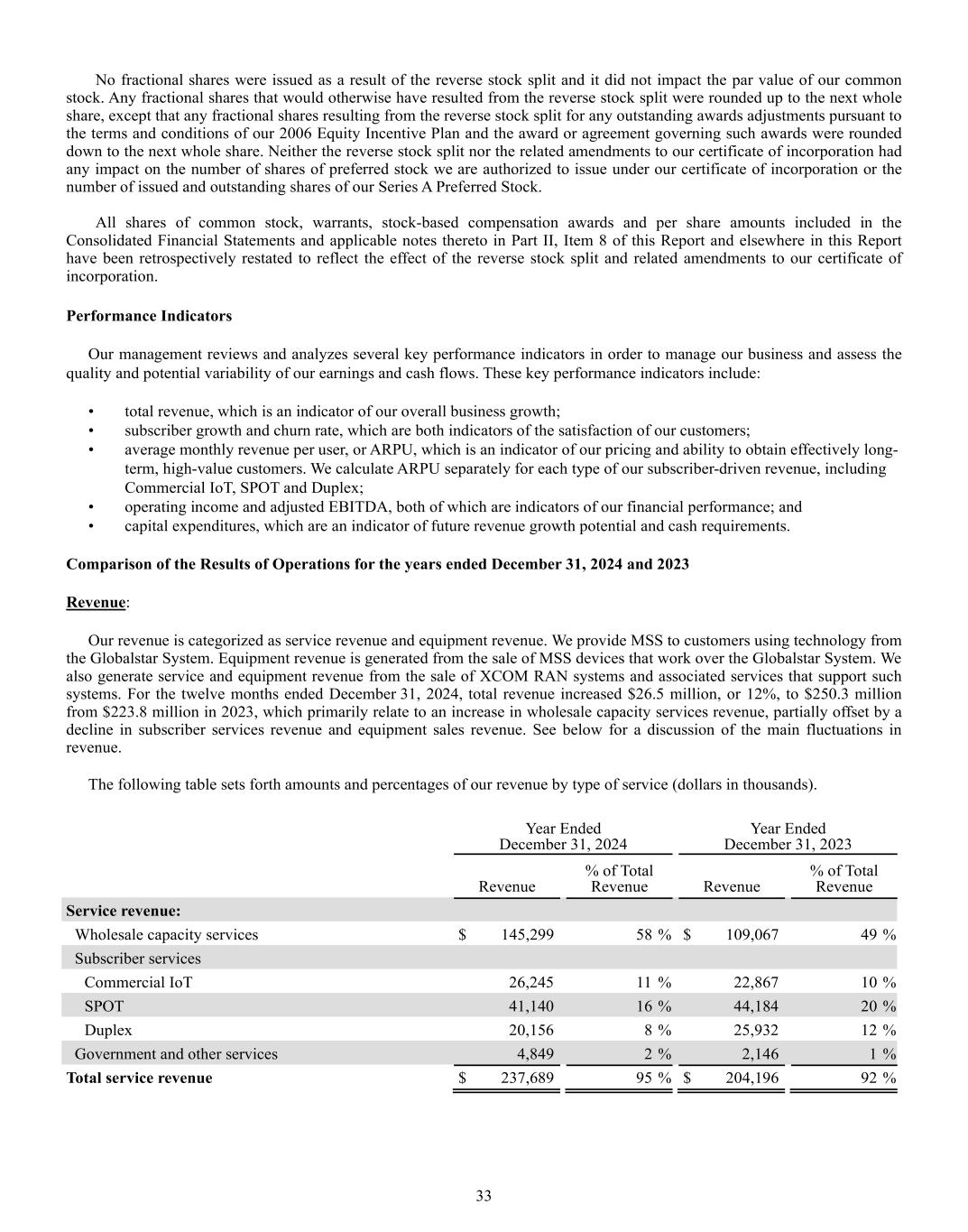
33 No fractional shares were issued as a result of the reverse stock split and it did not impact the par value of our common stock. Any fractional shares that would otherwise have resulted from the reverse stock split were rounded up to the next whole share, except that any fractional shares resulting from the reverse stock split for any outstanding awards adjustments pursuant to the terms and conditions of our 2006 Equity Incentive Plan and the award or agreement governing such awards were rounded down to the next whole share. Neither the reverse stock split nor the related amendments to our certificate of incorporation had any impact on the number of shares of preferred stock we are authorized to issue under our certificate of incorporation or the number of issued and outstanding shares of our Series A Preferred Stock. All shares of common stock, warrants, stock-based compensation awards and per share amounts included in the Consolidated Financial Statements and applicable notes thereto in Part II, Item 8 of this Report and elsewhere in this Report have been retrospectively restated to reflect the effect of the reverse stock split and related amendments to our certificate of incorporation. Performance Indicators Our management reviews and analyzes several key performance indicators in order to manage our business and assess the quality and potential variability of our earnings and cash flows. These key performance indicators include: • total revenue, which is an indicator of our overall business growth; • subscriber growth and churn rate, which are both indicators of the satisfaction of our customers; • average monthly revenue per user, or ARPU, which is an indicator of our pricing and ability to obtain effectively long- term, high-value customers. We calculate ARPU separately for each type of our subscriber-driven revenue, including Commercial IoT, SPOT and Duplex; • operating income and adjusted EBITDA, both of which are indicators of our financial performance; and • capital expenditures, which are an indicator of future revenue growth potential and cash requirements. Comparison of the Results of Operations for the years ended December 31, 2024 and 2023 Revenue: Our revenue is categorized as service revenue and equipment revenue. We provide MSS to customers using technology from the Globalstar System. Equipment revenue is generated from the sale of MSS devices that work over the Globalstar System. We also generate service and equipment revenue from the sale of XCOM RAN systems and associated services that support such systems. For the twelve months ended December 31, 2024, total revenue increased $26.5 million, or 12%, to $250.3 million from $223.8 million in 2023, which primarily relate to an increase in wholesale capacity services revenue, partially offset by a decline in subscriber services revenue and equipment sales revenue. See below for a discussion of the main fluctuations in revenue. The following table sets forth amounts and percentages of our revenue by type of service (dollars in thousands). Year Ended December 31, 2024 Year Ended December 31, 2023 Revenue % of Total Revenue Revenue % of Total Revenue Service revenue: Wholesale capacity services $ 145,299 58 % $ 109,067 49 % Subscriber services Commercial IoT 26,245 11 % 22,867 10 % SPOT 41,140 16 % 44,184 20 % Duplex 20,156 8 % 25,932 12 % Government and other services 4,849 2 % 2,146 1 % Total service revenue $ 237,689 95 % $ 204,196 92 %
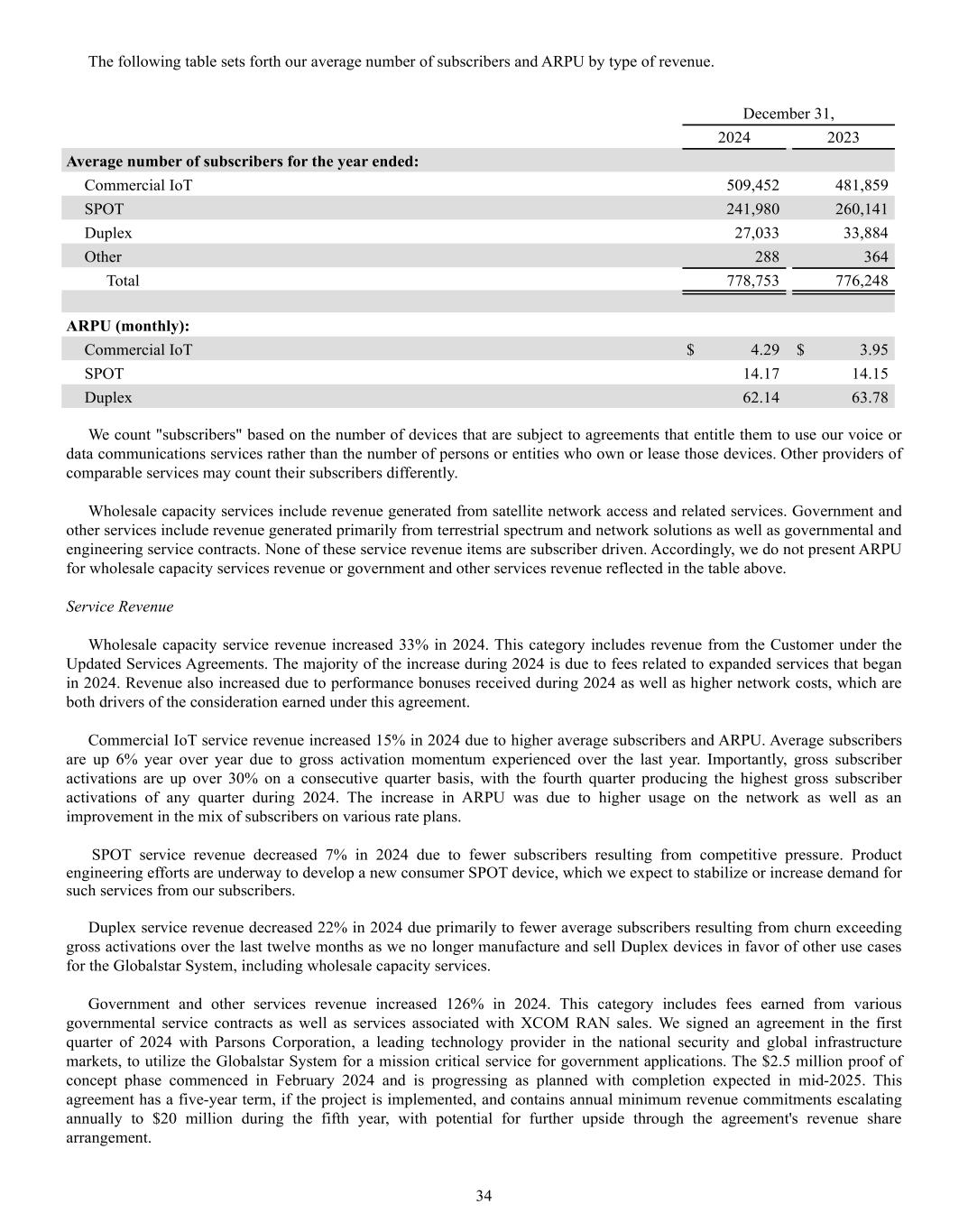
34 The following table sets forth our average number of subscribers and ARPU by type of revenue. December 31, 2024 2023 Average number of subscribers for the year ended: Commercial IoT 509,452 481,859 SPOT 241,980 260,141 Duplex 27,033 33,884 Other 288 364 Total 778,753 776,248 ARPU (monthly): Commercial IoT $ 4.29 $ 3.95 SPOT 14.17 14.15 Duplex 62.14 63.78 We count "subscribers" based on the number of devices that are subject to agreements that entitle them to use our voice or data communications services rather than the number of persons or entities who own or lease those devices. Other providers of comparable services may count their subscribers differently. Wholesale capacity services include revenue generated from satellite network access and related services. Government and other services include revenue generated primarily from terrestrial spectrum and network solutions as well as governmental and engineering service contracts. None of these service revenue items are subscriber driven. Accordingly, we do not present ARPU for wholesale capacity services revenue or government and other services revenue reflected in the table above. Service Revenue Wholesale capacity service revenue increased 33% in 2024. This category includes revenue from the Customer under the Updated Services Agreements. The majority of the increase during 2024 is due to fees related to expanded services that began in 2024. Revenue also increased due to performance bonuses received during 2024 as well as higher network costs, which are both drivers of the consideration earned under this agreement. Commercial IoT service revenue increased 15% in 2024 due to higher average subscribers and ARPU. Average subscribers are up 6% year over year due to gross activation momentum experienced over the last year. Importantly, gross subscriber activations are up over 30% on a consecutive quarter basis, with the fourth quarter producing the highest gross subscriber activations of any quarter during 2024. The increase in ARPU was due to higher usage on the network as well as an improvement in the mix of subscribers on various rate plans. SPOT service revenue decreased 7% in 2024 due to fewer subscribers resulting from competitive pressure. Product engineering efforts are underway to develop a new consumer SPOT device, which we expect to stabilize or increase demand for such services from our subscribers. Duplex service revenue decreased 22% in 2024 due primarily to fewer average subscribers resulting from churn exceeding gross activations over the last twelve months as we no longer manufacture and sell Duplex devices in favor of other use cases for the Globalstar System, including wholesale capacity services. Government and other services revenue increased 126% in 2024. This category includes fees earned from various governmental service contracts as well as services associated with XCOM RAN sales. We signed an agreement in the first quarter of 2024 with Parsons Corporation, a leading technology provider in the national security and global infrastructure markets, to utilize the Globalstar System for a mission critical service for government applications. The $2.5 million proof of concept phase commenced in February 2024 and is progressing as planned with completion expected in mid-2025. This agreement has a five-year term, if the project is implemented, and contains annual minimum revenue commitments escalating annually to $20 million during the fifth year, with potential for further upside through the agreement's revenue share arrangement.

35 Subscriber Equipment Sales Revenue generated from subscriber equipment sales decreased $7.0 million due primarily to the timing of Commercial IoT and SPOT device sales. During 2023, we recovered from inventory shortages that impacted both device categories and experienced higher sales as a result of improved product availability. Additionally, during 2023 we shipped a large volume of SmartOne Solar devices to a single value added reseller ("VAR"), roughly half of the decrease in Commercial IoT device revenue year over was due to this one customer. We are currently developing new MSS subscriber devices, which we expect will increase equipment sales in the future. Operating Expenses: Total operating expenses increased 12% to $251.3 million in 2024 from $224.0 million in 2023, which is primarily related to an increase in cost of services and stock-based compensation, partially offset by reduced cost of subscriber equipment sales. The main contributors to the variances in operating expenses are explained in detail below. In February 2025, we were notified that we will receive an employee retention credit as a result of our eligibility under the provisions of the Coronavirus Aid, Relief and Economic Security Act (the "CARES Act") for the second quarter of 2021. We expect to receive this refund, totaling $2.0 million, in the near future. When received, this refund will reduce operating expenses and will be allocated between Cost of Services and MG&A (defined below), based on the employee costs incurred during the eligible period. Cost of Services Cost of services increased $19.7 million, or 37%, to $73.2 million in 2024 from $53.5 million in 2023. This increase was due primarily to network expansion in connection with services provided under the Service Agreements; a substantial portion of network-related costs are reimbursed thereunder and this consideration is recognized as revenue in accordance with the terms of the Updated Services Agreements. As expected with our new and upgraded ground infrastructure, gateway operating costs, such as maintenance and personnel costs, increased $11.0 million. We do not expect the operating costs that support existing services under the Updated Services Agreements during the Phase 1 Service Period to increase meaningfully beyond current levels. We expect that over the next few years in anticipation of the Services provided over the Extended MSS Network, costs to support the Updated Services Agreements will increase substantially. See Note 2: Special Purpose Entity to our Consolidated Financial Statements for a description of the different phases of services under the Updated Services Agreements. In connection with the August 2023 License Agreement with XCOM, we entered into a Support Services Agreement (the “SSA”). During 2024, we recognized $3.1 million in expense associated with the SSA and other ancillary costs, of which the majority were noncash. Costs to support new product development totaling $2.5 million also contributed to the increase in operating expenses during 2024. Cost of Subscriber Equipment Sales Cost of subscriber equipment sales decreased 42% in 2024. This cost decrease is generally consistent with the decrease in revenue generated from subscriber equipment sales during the year; however, it is also related to margin improvement due to the mix of products sold in each period as well as the cost improvement from moving our manufacturing from China to Vietnam, which reduced tariffs incurred for U.S. imports during a portion of 2024. Stock-Based Compensation Stock-based compensation expense increased $13.0 million to $35.5 million in 2024 from $22.5 million in 2023. The increase was due primarily to restricted stock units ("RSUs") granted to certain executives in connection with the License Agreement in August 2023, the majority of the cost of which was recognized in 2024. During 2023, we granted 44.5 million RSUs, which are earned over a four-year performance period and vest upon Globalstar common stock trading at various price levels throughout the performance period. The total fair value of the RSUs was $39.5 million and is being recognized over the derived service period of 2.6 years; with nearly 60% of the compensation cost for these RSUs is being recognized during 2024.

36 Other (Expense) Income: (Loss) gain on extinguishment of debt We recorded a loss on extinguishment of debt of $27.4 million during 2024. In November 2024, we refinanced the 2023 13% Notes, resulting in a loss on extinguishment of debt due to the unamortized debt discount and deferred financing costs remaining prior to extinguishment as well as the make-whole fees at pay down. In 2023, we recorded a loss on extinguishment of debt of $10.4 million following the full pay-off of the 2019 Facility Agreement. The extinguishment loss was recognized due to the remaining deferred financing costs and debt discount associated with the instrument at the time of repayment. Loss on equity issuance Loss on equity issuance was $5.0 million for 2023. In connection with Thermo's guarantee of the 2023 Funding Agreement, we issued a warrant to purchase shares of our common stock to Thermo, a portion of which vested upon the effectiveness of the guarantee and occurred in December 2023. The portion of the fair value associated with the credit enhancement, as recorded pursuant to applicable accounting guidance, was recorded as a loss on equity issuance. Similar activity did not occur in 2024. Interest Income and Expense Interest income and expense, net, decreased $1.0 million to $13.6 million for 2024 compared to $14.6 million for 2023 due to higher capitalized interest (which decreases interest expense) of $8.3 million. As we continue to capitalize costs associated with upgrades to our network, our average CIP balance increases, which results in higher interest capitalized. Higher interest income of $2.1 million also decreased "interest income and expense, net" during 2024. These factors were offset partially by higher gross interest costs of $9.3 million due primarily to the average balance outstanding under the 2023 Funding Agreement and the Current Debt Repayment during the respective periods, as well as interest expense associated with a significant financing component related to proceeds funded under the 2024 Prepayment Agreement. Foreign currency (loss) gain Changes in foreign currency gains and losses are driven by the remeasurement of financial statement items, which are denominated in various currencies, at the end of each reporting period. We recorded foreign currency losses of $16.6 million in 2024. We recorded foreign currency gains of $4.9 million in 2023. Many of our foreign subsidiaries have USD-denominated intercompany payable balances, which impact the foreign currency gains and losses recorded each reporting period. In these instances, foreign currency gains result from other currencies strengthening relative to the U.S. dollar; inversely, foreign currency losses result from the U.S. dollar strengthening relative to other currencies. Income Tax Expense (Benefit) Income tax expense (benefit) fluctuated by $1.0 million to an expense of $2.1 million in 2024 from an expense of $1.1 million in 2023. The increase during 2024 was due primarily to $1.0 million in expense for uncertain tax positions associated with interest on withholding tax related to the Canadian tax audit. In both periods, income tax was recorded due to withholding tax expense associated with our global transfer pricing allocations in certain foreign jurisdictions. See Note 13: Taxes to our Consolidated Financial Statements for further information on the Canadian tax audit.
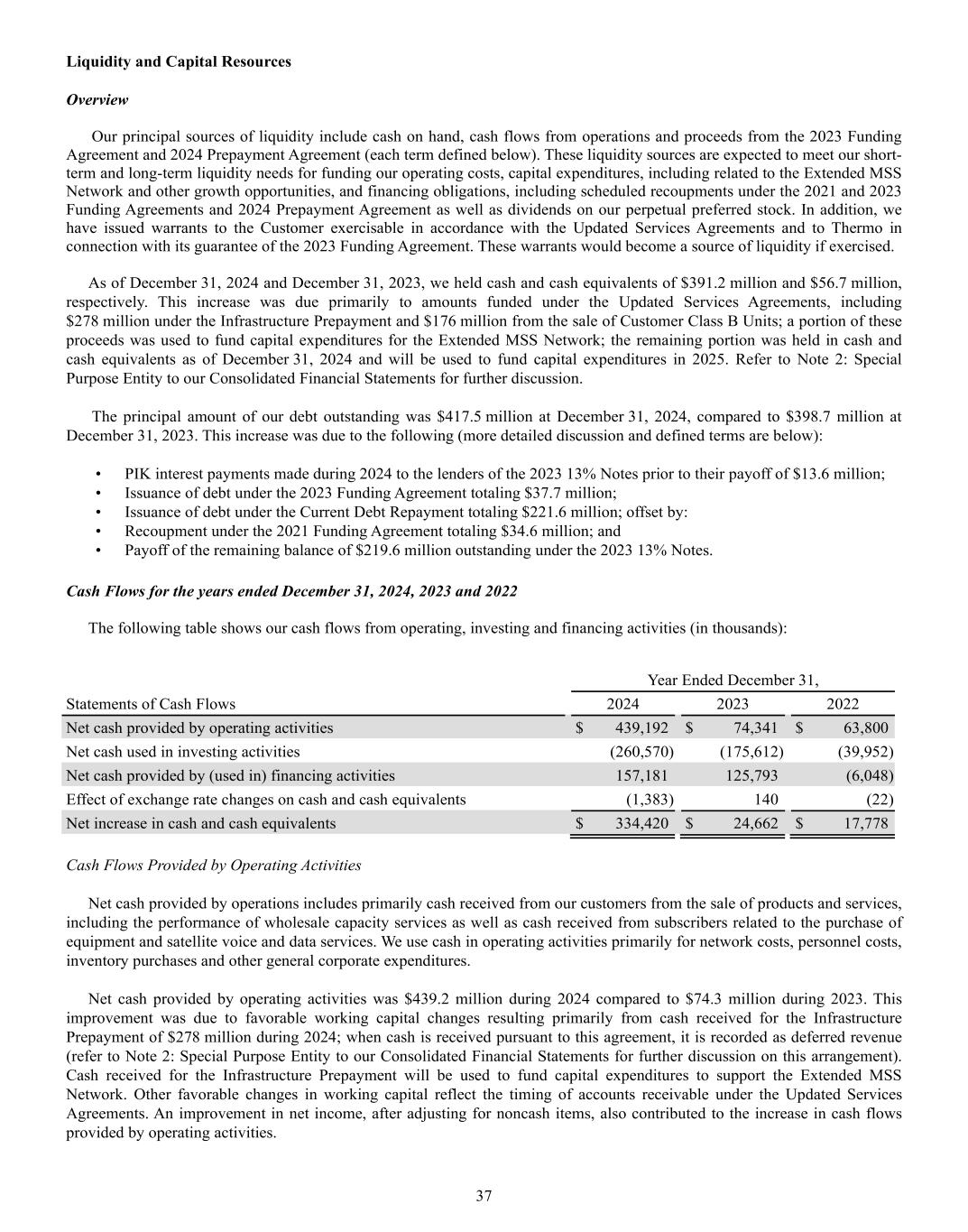
37 Liquidity and Capital Resources Overview Our principal sources of liquidity include cash on hand, cash flows from operations and proceeds from the 2023 Funding Agreement and 2024 Prepayment Agreement (each term defined below). These liquidity sources are expected to meet our short- term and long-term liquidity needs for funding our operating costs, capital expenditures, including related to the Extended MSS Network and other growth opportunities, and financing obligations, including scheduled recoupments under the 2021 and 2023 Funding Agreements and 2024 Prepayment Agreement as well as dividends on our perpetual preferred stock. In addition, we have issued warrants to the Customer exercisable in accordance with the Updated Services Agreements and to Thermo in connection with its guarantee of the 2023 Funding Agreement. These warrants would become a source of liquidity if exercised. As of December 31, 2024 and December 31, 2023, we held cash and cash equivalents of $391.2 million and $56.7 million, respectively. This increase was due primarily to amounts funded under the Updated Services Agreements, including $278 million under the Infrastructure Prepayment and $176 million from the sale of Customer Class B Units; a portion of these proceeds was used to fund capital expenditures for the Extended MSS Network; the remaining portion was held in cash and cash equivalents as of December 31, 2024 and will be used to fund capital expenditures in 2025. Refer to Note 2: Special Purpose Entity to our Consolidated Financial Statements for further discussion. The principal amount of our debt outstanding was $417.5 million at December 31, 2024, compared to $398.7 million at December 31, 2023. This increase was due to the following (more detailed discussion and defined terms are below): • PIK interest payments made during 2024 to the lenders of the 2023 13% Notes prior to their payoff of $13.6 million; • Issuance of debt under the 2023 Funding Agreement totaling $37.7 million; • Issuance of debt under the Current Debt Repayment totaling $221.6 million; offset by: • Recoupment under the 2021 Funding Agreement totaling $34.6 million; and • Payoff of the remaining balance of $219.6 million outstanding under the 2023 13% Notes. Cash Flows for the years ended December 31, 2024, 2023 and 2022 The following table shows our cash flows from operating, investing and financing activities (in thousands): Year Ended December 31, Statements of Cash Flows 2024 2023 2022 Net cash provided by operating activities $ 439,192 $ 74,341 $ 63,800 Net cash used in investing activities (260,570) (175,612) (39,952) Net cash provided by (used in) financing activities 157,181 125,793 (6,048) Effect of exchange rate changes on cash and cash equivalents (1,383) 140 (22) Net increase in cash and cash equivalents $ 334,420 $ 24,662 $ 17,778 Cash Flows Provided by Operating Activities Net cash provided by operations includes primarily cash received from our customers from the sale of products and services, including the performance of wholesale capacity services as well as cash received from subscribers related to the purchase of equipment and satellite voice and data services. We use cash in operating activities primarily for network costs, personnel costs, inventory purchases and other general corporate expenditures. Net cash provided by operating activities was $439.2 million during 2024 compared to $74.3 million during 2023. This improvement was due to favorable working capital changes resulting primarily from cash received for the Infrastructure Prepayment of $278 million during 2024; when cash is received pursuant to this agreement, it is recorded as deferred revenue (refer to Note 2: Special Purpose Entity to our Consolidated Financial Statements for further discussion on this arrangement). Cash received for the Infrastructure Prepayment will be used to fund capital expenditures to support the Extended MSS Network. Other favorable changes in working capital reflect the timing of accounts receivable under the Updated Services Agreements. An improvement in net income, after adjusting for noncash items, also contributed to the increase in cash flows provided by operating activities.

38 Cash Flows Used in Investing Activities Net cash used in investing activities was $260.6 million during 2024 compared to $175.6 million during 2023. Net cash used in investing activities during both periods primarily included network upgrades associated with the Updated Services Agreements and payments of capitalized interest. The increase from 2023 to 2024 was due primarily to the timing of payments made to MDA and SpaceX, including particularly amounts paid pursuant to the agreement entered into with SpaceX in October 2024 as discussed below in "Contractual Obligations and Commitments". Cash Flows Provided by Financing Activities Net cash provided by financing activities was $157.2 million in 2024 compared to net cash provided by financing activities of $125.8 million in 2023. During 2024, we received cash to fund the paydown of the outstanding principal balance (including a make-whole payment at paydown) due under the 2023 13% Notes of $234.9 million. We also received cash of $176 million for the sale of the Customer Class B Units in the Globalstar SPE; a portion of these funds was used (and the remaining amount will be used) to fund capital expenditures for the Extended MSS Network. During 2023, we received proceeds from the sale of the 2023 13% Notes, which were used to pay the remaining principal amount due under the 2019 Facility Agreement and financing costs. During 2024 and 2023, we received proceeds from the 2023 Funding Agreement totaling $37.7 million and $117.3 million, respectively, which were used to pay amounts owed to MDA. Pursuant to the terms of the 2021 Funding Agreement, scheduled recoupment payments began in the third quarter of 2023 and totaled $34.6 million and $12.5 million during 2024 and 2023, respectively. We also paid cash dividends in respect to our Series A Preferred Stock totaling $10.6 million and $11.9 million during 2024 and 2023, respectively. Indebtedness Below is a summary description of our debt and other financing arrangements as of December 31, 2024. For more information, see Note 7: Long-Term Debt and Other Financing Arrangements to our Consolidated Financial Statements. 2024 Prepayment Agreement (including Current Debt Repayment) The Updated Services Agreements provide that the Customer will make cash prepayments to us, including for approved capital expenditures in connection with the Extended MSS Network. These prepayments consist of: (1) an infrastructure prepayment (the “Infrastructure Prepayment”) of up to $1.1 billion, which is to be funded over the construction period on a quarterly basis, the proceeds of which the Globalstar SPE will use, together with the proceeds from the sale of the Customer Class B Units, to pay amounts due for the Extended MSS Network (including, but not limited to, construction and launch costs) and (2) the amount necessary for us to retire our 2023 13% Notes (the "Current Debt Repayment"). The 2023 13% Notes were repurchased in full on the Closing Date. The terms of the Infrastructure Prepayment and the Current Debt Repayment are contained within one prepayment agreement (the “2024 Prepayment Agreement”). The outstanding balance of the Current Debt Repayment was $222 million as of December 31, 2024. Additionally, through December 31, 2024, we have received $278 million under the Infrastructure Prepayment. As we receive proceeds from the Infrastructure Prepayment, we record a contract liability on our balance sheet for our obligation to perform future services to the Customer. As we provide these services, we will receive additional service fees and use these fees to fully reduce the Infrastructure Prepayment liability as well as to repurchase or redeem all Customer Class B Units. This period is expected to begin at the commencement of the Services provided over the Extended MSS Network and be completed within the design useful life of the new satellites. The Current Debt Repayment and $225 million of the Infrastructure Prepayment may accrue fees (while the remaining amount of the Infrastructure Prepayment does not accrue fees). Such fees payable to the Customer will be reduced or eliminated entirely if we meet certain defined milestones, at which time prior accruals will be reduced or eliminated. See Note 2: Special Purpose Entity to our Consolidated Financial Statements for discussion of the different phases of services under the Updated Services Agreements, and Note 7: Long-Term Debt and Other Financing Arrangements and Note 11: Accrued Expenses and Other Non-Current Liabilities for discussion of the accrual of fees.
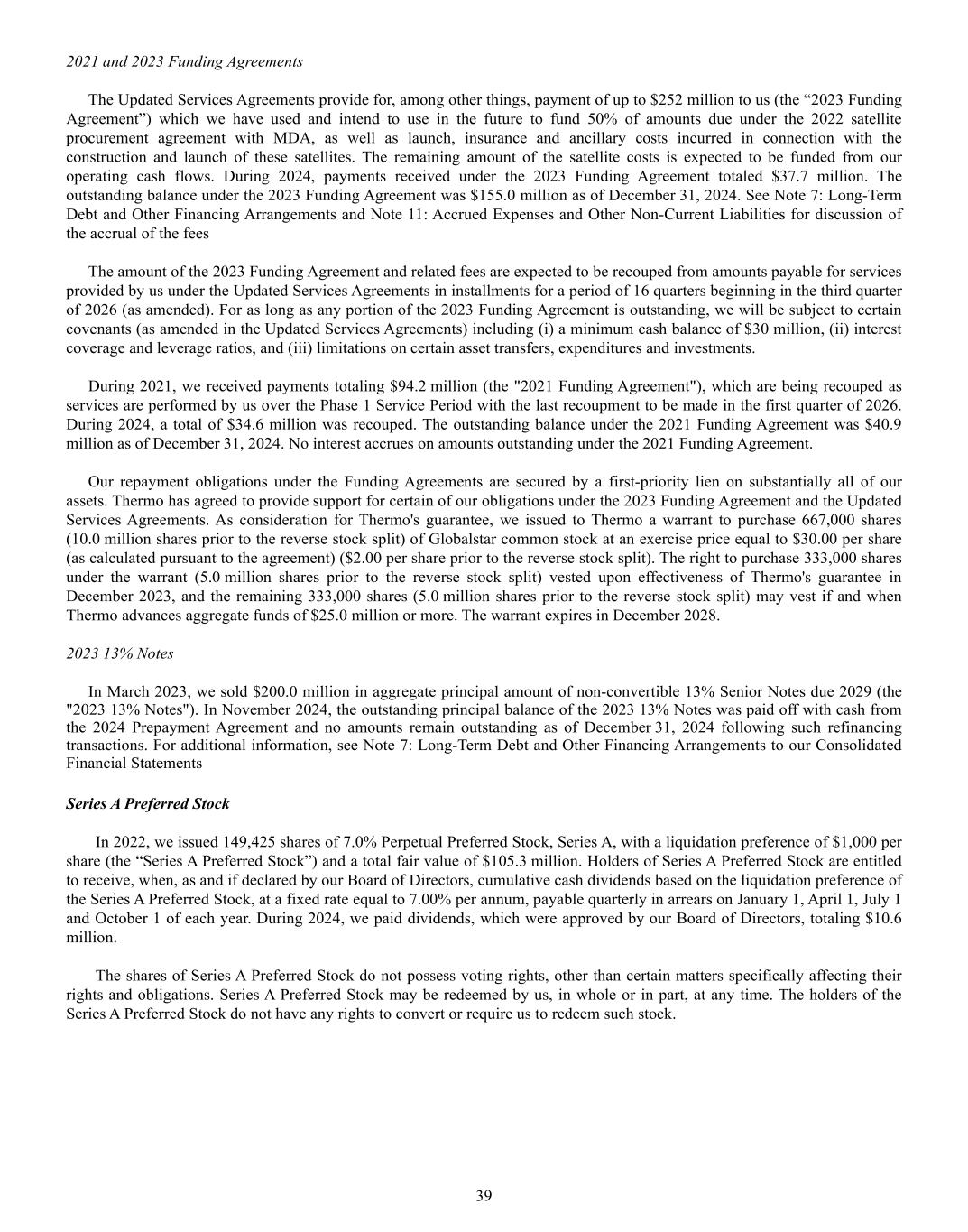
39 2021 and 2023 Funding Agreements The Updated Services Agreements provide for, among other things, payment of up to $252 million to us (the “2023 Funding Agreement”) which we have used and intend to use in the future to fund 50% of amounts due under the 2022 satellite procurement agreement with MDA, as well as launch, insurance and ancillary costs incurred in connection with the construction and launch of these satellites. The remaining amount of the satellite costs is expected to be funded from our operating cash flows. During 2024, payments received under the 2023 Funding Agreement totaled $37.7 million. The outstanding balance under the 2023 Funding Agreement was $155.0 million as of December 31, 2024. See Note 7: Long-Term Debt and Other Financing Arrangements and Note 11: Accrued Expenses and Other Non-Current Liabilities for discussion of the accrual of the fees The amount of the 2023 Funding Agreement and related fees are expected to be recouped from amounts payable for services provided by us under the Updated Services Agreements in installments for a period of 16 quarters beginning in the third quarter of 2026 (as amended). For as long as any portion of the 2023 Funding Agreement is outstanding, we will be subject to certain covenants (as amended in the Updated Services Agreements) including (i) a minimum cash balance of $30 million, (ii) interest coverage and leverage ratios, and (iii) limitations on certain asset transfers, expenditures and investments. During 2021, we received payments totaling $94.2 million (the "2021 Funding Agreement"), which are being recouped as services are performed by us over the Phase 1 Service Period with the last recoupment to be made in the first quarter of 2026. During 2024, a total of $34.6 million was recouped. The outstanding balance under the 2021 Funding Agreement was $40.9 million as of December 31, 2024. No interest accrues on amounts outstanding under the 2021 Funding Agreement. Our repayment obligations under the Funding Agreements are secured by a first-priority lien on substantially all of our assets. Thermo has agreed to provide support for certain of our obligations under the 2023 Funding Agreement and the Updated Services Agreements. As consideration for Thermo's guarantee, we issued to Thermo a warrant to purchase 667,000 shares (10.0 million shares prior to the reverse stock split) of Globalstar common stock at an exercise price equal to $30.00 per share (as calculated pursuant to the agreement) ($2.00 per share prior to the reverse stock split). The right to purchase 333,000 shares under the warrant (5.0 million shares prior to the reverse stock split) vested upon effectiveness of Thermo's guarantee in December 2023, and the remaining 333,000 shares (5.0 million shares prior to the reverse stock split) may vest if and when Thermo advances aggregate funds of $25.0 million or more. The warrant expires in December 2028. 2023 13% Notes In March 2023, we sold $200.0 million in aggregate principal amount of non-convertible 13% Senior Notes due 2029 (the "2023 13% Notes"). In November 2024, the outstanding principal balance of the 2023 13% Notes was paid off with cash from the 2024 Prepayment Agreement and no amounts remain outstanding as of December 31, 2024 following such refinancing transactions. For additional information, see Note 7: Long-Term Debt and Other Financing Arrangements to our Consolidated Financial Statements Series A Preferred Stock In 2022, we issued 149,425 shares of 7.0% Perpetual Preferred Stock, Series A, with a liquidation preference of $1,000 per share (the “Series A Preferred Stock”) and a total fair value of $105.3 million. Holders of Series A Preferred Stock are entitled to receive, when, as and if declared by our Board of Directors, cumulative cash dividends based on the liquidation preference of the Series A Preferred Stock, at a fixed rate equal to 7.00% per annum, payable quarterly in arrears on January 1, April 1, July 1 and October 1 of each year. During 2024, we paid dividends, which were approved by our Board of Directors, totaling $10.6 million. The shares of Series A Preferred Stock do not possess voting rights, other than certain matters specifically affecting their rights and obligations. Series A Preferred Stock may be redeemed by us, in whole or in part, at any time. The holders of the Series A Preferred Stock do not have any rights to convert or require us to redeem such stock.

40 Contractual Obligations and Commitments Contractual obligations arising in the normal course of business consist primarily of debt and financing obligations (as discussed above), purchase commitments with vendors related to the procurement, deployment and maintenance of the Globalstar System (discussed below), obligations for non-cancellable purchase orders for inventory ($4.7 million, which we expect to be fulfilled in line with current forecasted equipment sales) and operating lease obligations (see Note 4: Leases to our Consolidated Financial Statements for further discussion). Satellite Procurement Agreements We have a satellite procurement agreement with MDA pursuant to which we expect to acquire at least 17 satellites (and up to 26 satellites) that are intended to replenish our HIBLEO-4 U.S.-licensed system and ensure long-term continuity of our MSS. The satellite procurement agreement requires delivery of the initial 17 satellites during 2025. The amended contract price for these satellites is $329.3 million, and we have the option to purchase up to nine additional satellites at a lower per unit cost, subject to certain conditions. In addition, MDA will procure equipment to be incorporated into a satellite operations control center ("SOCC") totaling $5.0 million as well as other equipment for $4.2 million. To date, the parties have accepted milestones totaling $224.3 million associated with the new satellites and related infrastructure. We paid to MDA $14.0 million, $135.9 million and $67.1 million during 2022, 2023 and 2024, respectively. We expect to continue to fund a portion of the future milestone payments using the 2023 Funding Agreement. In February 2025, we entered into another agreement with MDA pursuant to which we expect to acquire more than 50 satellites related to the Extended MSS Network. The total contract price for these satellites is $775.0 million. The satellite procurement agreements with MDA contains customary termination provisions including our right to terminate the contract for convenience at any time, subject to certain conditions and payment obligations. Launch Services Agreements As more fully described in our Current Report on Form 8-K filed with the SEC on August 31, 2023, we have a Launch Services Agreement and certain related ancillary agreements with SpaceX, providing for the launch of the first set of the satellites we are acquiring pursuant to the satellite procurement agreement with MDA. The Launch Services Agreements provide a launch window from April to September 2025. To date, the parties have accepted milestones totaling $23.6 million associated with this agreement. We paid to SpaceX $9.6 million and $29.7 million during 2023 and 2024, respectively. In October 2024, we entered into another agreement with SpaceX for the launch of satellites related to the Extended MSS Network. To date, the parties have accepted milestones totaling $17.3 million associated with this agreement. During 2024, we paid $129.6 million to SpaceX under this agreement, including $112 million as a long-term prepaid for future milestones. The Launch Services Agreements with SpaceX contains customary termination provisions including our right to terminate the contract for convenience at any time, subject to certain conditions, including SpaceX retaining certain amounts of the contract value. Funding for Phase 2 Service Period Asset Procurement Under the Service Agreements, subject to certain terms and conditions, we expect to receive payments equal to 95% of the approved capital expenditures under the satellite procurement agreement for the HIBLEO-4 satellites and Launch Services Agreements for such satellites (to be paid on a straight-line basis over the design life of the satellites) beginning with the commencement of the Phase 2 Service Period. The Phase 2 Service Period is expected to begin when the new satellites are successfully utilized to provide Services. Funding for Extended MSS Network Asset Procurement As discussed in more detail in Note 2: Special Purpose Entity to our Consolidated Financial Statements, the Updated Services Agreements provide for prepayments from the Customer for approved capital expenditures associated with the Extended MSS Network. As of December 31, 2024, we have outstanding purchase orders for this project totaling $290 million to vendors for various satellite and ground components of the Extended MSS Network. These costs will continue until the construction period is complete.
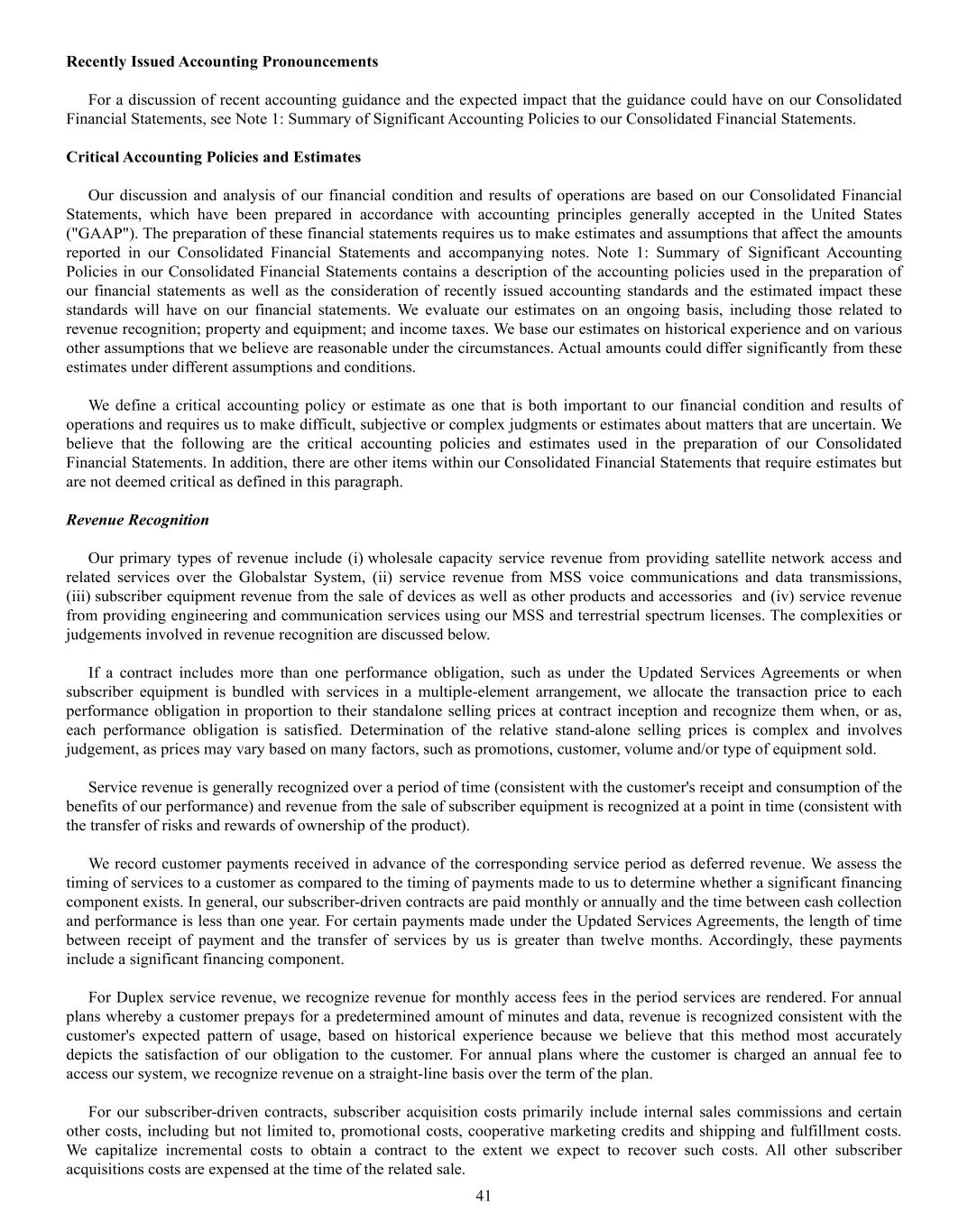
41 Recently Issued Accounting Pronouncements For a discussion of recent accounting guidance and the expected impact that the guidance could have on our Consolidated Financial Statements, see Note 1: Summary of Significant Accounting Policies to our Consolidated Financial Statements. Critical Accounting Policies and Estimates Our discussion and analysis of our financial condition and results of operations are based on our Consolidated Financial Statements, which have been prepared in accordance with accounting principles generally accepted in the United States ("GAAP"). The preparation of these financial statements requires us to make estimates and assumptions that affect the amounts reported in our Consolidated Financial Statements and accompanying notes. Note 1: Summary of Significant Accounting Policies in our Consolidated Financial Statements contains a description of the accounting policies used in the preparation of our financial statements as well as the consideration of recently issued accounting standards and the estimated impact these standards will have on our financial statements. We evaluate our estimates on an ongoing basis, including those related to revenue recognition; property and equipment; and income taxes. We base our estimates on historical experience and on various other assumptions that we believe are reasonable under the circumstances. Actual amounts could differ significantly from these estimates under different assumptions and conditions. We define a critical accounting policy or estimate as one that is both important to our financial condition and results of operations and requires us to make difficult, subjective or complex judgments or estimates about matters that are uncertain. We believe that the following are the critical accounting policies and estimates used in the preparation of our Consolidated Financial Statements. In addition, there are other items within our Consolidated Financial Statements that require estimates but are not deemed critical as defined in this paragraph. Revenue Recognition Our primary types of revenue include (i) wholesale capacity service revenue from providing satellite network access and related services over the Globalstar System, (ii) service revenue from MSS voice communications and data transmissions, (iii) subscriber equipment revenue from the sale of devices as well as other products and accessories and (iv) service revenue from providing engineering and communication services using our MSS and terrestrial spectrum licenses. The complexities or judgements involved in revenue recognition are discussed below. If a contract includes more than one performance obligation, such as under the Updated Services Agreements or when subscriber equipment is bundled with services in a multiple-element arrangement, we allocate the transaction price to each performance obligation in proportion to their standalone selling prices at contract inception and recognize them when, or as, each performance obligation is satisfied. Determination of the relative stand-alone selling prices is complex and involves judgement, as prices may vary based on many factors, such as promotions, customer, volume and/or type of equipment sold. Service revenue is generally recognized over a period of time (consistent with the customer's receipt and consumption of the benefits of our performance) and revenue from the sale of subscriber equipment is recognized at a point in time (consistent with the transfer of risks and rewards of ownership of the product). We record customer payments received in advance of the corresponding service period as deferred revenue. We assess the timing of services to a customer as compared to the timing of payments made to us to determine whether a significant financing component exists. In general, our subscriber-driven contracts are paid monthly or annually and the time between cash collection and performance is less than one year. For certain payments made under the Updated Services Agreements, the length of time between receipt of payment and the transfer of services by us is greater than twelve months. Accordingly, these payments include a significant financing component. For Duplex service revenue, we recognize revenue for monthly access fees in the period services are rendered. For annual plans whereby a customer prepays for a predetermined amount of minutes and data, revenue is recognized consistent with the customer's expected pattern of usage, based on historical experience because we believe that this method most accurately depicts the satisfaction of our obligation to the customer. For annual plans where the customer is charged an annual fee to access our system, we recognize revenue on a straight-line basis over the term of the plan. For our subscriber-driven contracts, subscriber acquisition costs primarily include internal sales commissions and certain other costs, including but not limited to, promotional costs, cooperative marketing credits and shipping and fulfillment costs. We capitalize incremental costs to obtain a contract to the extent we expect to recover such costs. All other subscriber acquisitions costs are expensed at the time of the related sale.
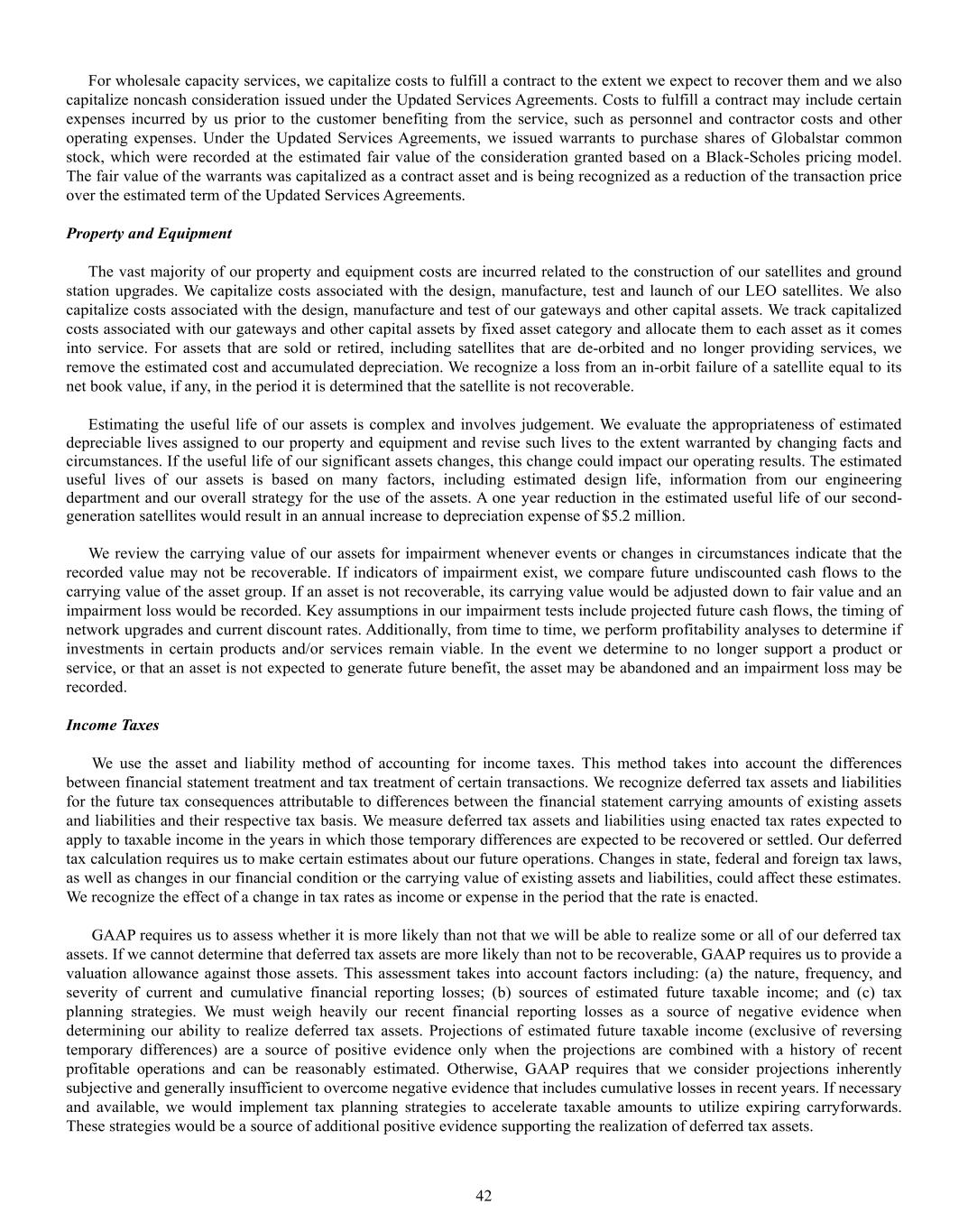
42 For wholesale capacity services, we capitalize costs to fulfill a contract to the extent we expect to recover them and we also capitalize noncash consideration issued under the Updated Services Agreements. Costs to fulfill a contract may include certain expenses incurred by us prior to the customer benefiting from the service, such as personnel and contractor costs and other operating expenses. Under the Updated Services Agreements, we issued warrants to purchase shares of Globalstar common stock, which were recorded at the estimated fair value of the consideration granted based on a Black-Scholes pricing model. The fair value of the warrants was capitalized as a contract asset and is being recognized as a reduction of the transaction price over the estimated term of the Updated Services Agreements. Property and Equipment The vast majority of our property and equipment costs are incurred related to the construction of our satellites and ground station upgrades. We capitalize costs associated with the design, manufacture, test and launch of our LEO satellites. We also capitalize costs associated with the design, manufacture and test of our gateways and other capital assets. We track capitalized costs associated with our gateways and other capital assets by fixed asset category and allocate them to each asset as it comes into service. For assets that are sold or retired, including satellites that are de-orbited and no longer providing services, we remove the estimated cost and accumulated depreciation. We recognize a loss from an in-orbit failure of a satellite equal to its net book value, if any, in the period it is determined that the satellite is not recoverable. Estimating the useful life of our assets is complex and involves judgement. We evaluate the appropriateness of estimated depreciable lives assigned to our property and equipment and revise such lives to the extent warranted by changing facts and circumstances. If the useful life of our significant assets changes, this change could impact our operating results. The estimated useful lives of our assets is based on many factors, including estimated design life, information from our engineering department and our overall strategy for the use of the assets. A one year reduction in the estimated useful life of our second- generation satellites would result in an annual increase to depreciation expense of $5.2 million. We review the carrying value of our assets for impairment whenever events or changes in circumstances indicate that the recorded value may not be recoverable. If indicators of impairment exist, we compare future undiscounted cash flows to the carrying value of the asset group. If an asset is not recoverable, its carrying value would be adjusted down to fair value and an impairment loss would be recorded. Key assumptions in our impairment tests include projected future cash flows, the timing of network upgrades and current discount rates. Additionally, from time to time, we perform profitability analyses to determine if investments in certain products and/or services remain viable. In the event we determine to no longer support a product or service, or that an asset is not expected to generate future benefit, the asset may be abandoned and an impairment loss may be recorded. Income Taxes We use the asset and liability method of accounting for income taxes. This method takes into account the differences between financial statement treatment and tax treatment of certain transactions. We recognize deferred tax assets and liabilities for the future tax consequences attributable to differences between the financial statement carrying amounts of existing assets and liabilities and their respective tax basis. We measure deferred tax assets and liabilities using enacted tax rates expected to apply to taxable income in the years in which those temporary differences are expected to be recovered or settled. Our deferred tax calculation requires us to make certain estimates about our future operations. Changes in state, federal and foreign tax laws, as well as changes in our financial condition or the carrying value of existing assets and liabilities, could affect these estimates. We recognize the effect of a change in tax rates as income or expense in the period that the rate is enacted. GAAP requires us to assess whether it is more likely than not that we will be able to realize some or all of our deferred tax assets. If we cannot determine that deferred tax assets are more likely than not to be recoverable, GAAP requires us to provide a valuation allowance against those assets. This assessment takes into account factors including: (a) the nature, frequency, and severity of current and cumulative financial reporting losses; (b) sources of estimated future taxable income; and (c) tax planning strategies. We must weigh heavily our recent financial reporting losses as a source of negative evidence when determining our ability to realize deferred tax assets. Projections of estimated future taxable income (exclusive of reversing temporary differences) are a source of positive evidence only when the projections are combined with a history of recent profitable operations and can be reasonably estimated. Otherwise, GAAP requires that we consider projections inherently subjective and generally insufficient to overcome negative evidence that includes cumulative losses in recent years. If necessary and available, we would implement tax planning strategies to accelerate taxable amounts to utilize expiring carryforwards. These strategies would be a source of additional positive evidence supporting the realization of deferred tax assets.
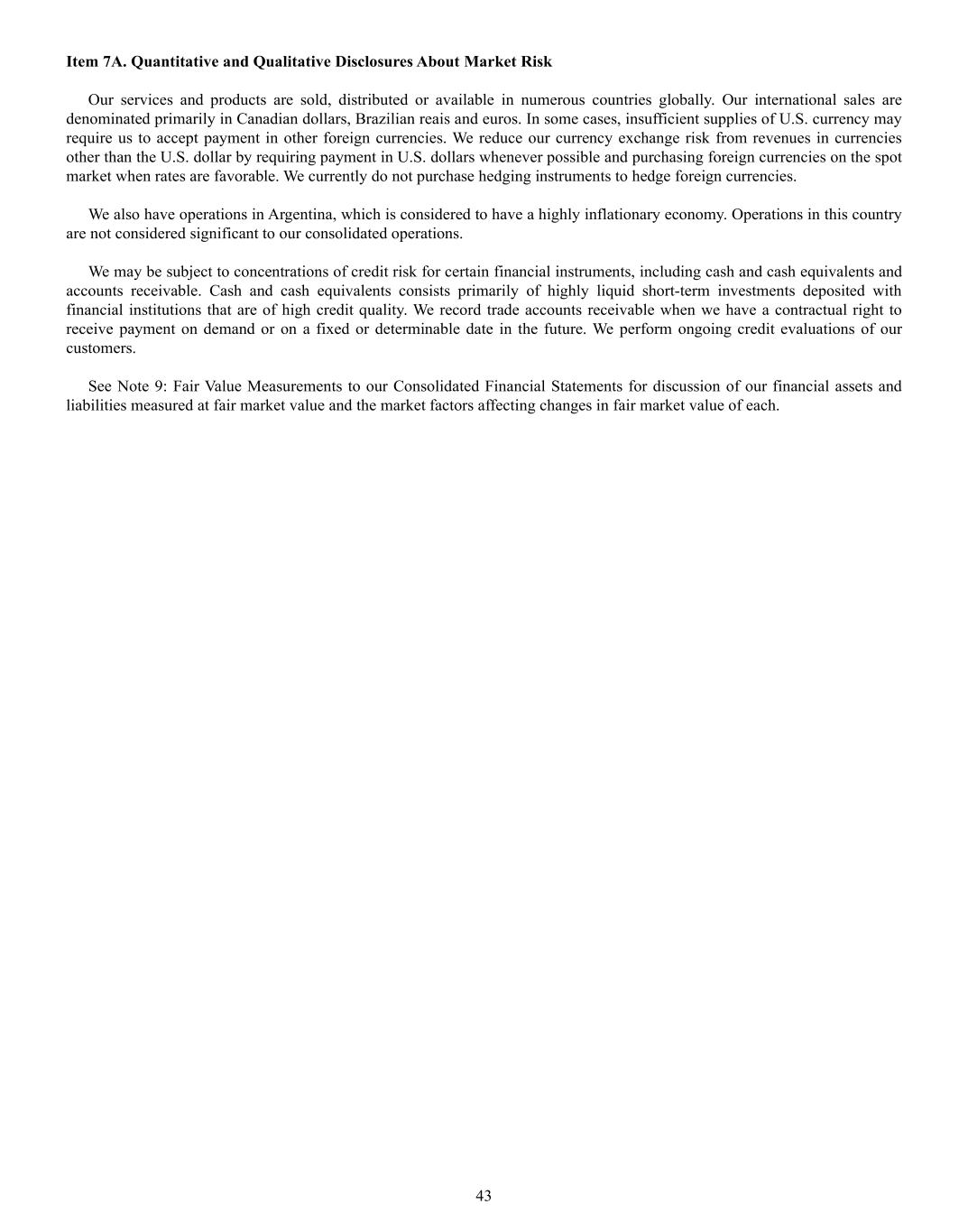
43 Item 7A. Quantitative and Qualitative Disclosures About Market Risk Our services and products are sold, distributed or available in numerous countries globally. Our international sales are denominated primarily in Canadian dollars, Brazilian reais and euros. In some cases, insufficient supplies of U.S. currency may require us to accept payment in other foreign currencies. We reduce our currency exchange risk from revenues in currencies other than the U.S. dollar by requiring payment in U.S. dollars whenever possible and purchasing foreign currencies on the spot market when rates are favorable. We currently do not purchase hedging instruments to hedge foreign currencies. We also have operations in Argentina, which is considered to have a highly inflationary economy. Operations in this country are not considered significant to our consolidated operations. We may be subject to concentrations of credit risk for certain financial instruments, including cash and cash equivalents and accounts receivable. Cash and cash equivalents consists primarily of highly liquid short-term investments deposited with financial institutions that are of high credit quality. We record trade accounts receivable when we have a contractual right to receive payment on demand or on a fixed or determinable date in the future. We perform ongoing credit evaluations of our customers. See Note 9: Fair Value Measurements to our Consolidated Financial Statements for discussion of our financial assets and liabilities measured at fair market value and the market factors affecting changes in fair market value of each.

44 Item 8. Financial Statements and Supplementary Data INDEX TO CONSOLIDATED FINANCIAL STATEMENTS Page Audited Consolidated Financial Statements of Globalstar, Inc. 45 Report of Ernst & Young LLP, independent registered public accounting firm (PCAOB ID 42) 45 Consolidated balance sheets at December 31, 2024 and 2023 48 Consolidated statements of operations for the years ended December 31, 2024, 2023 and 2022 49 Consolidated statements of comprehensive income (loss) for the years ended December 31, 2024, 2023 and 2022 50 Consolidated statements of stockholders’ equity for the years ended December 31, 2024, 2023 and 2022 51 Consolidated statements of cash flows for the years ended December 31, 2024, 2023 and 2022 52 Notes to Consolidated Financial Statements 54
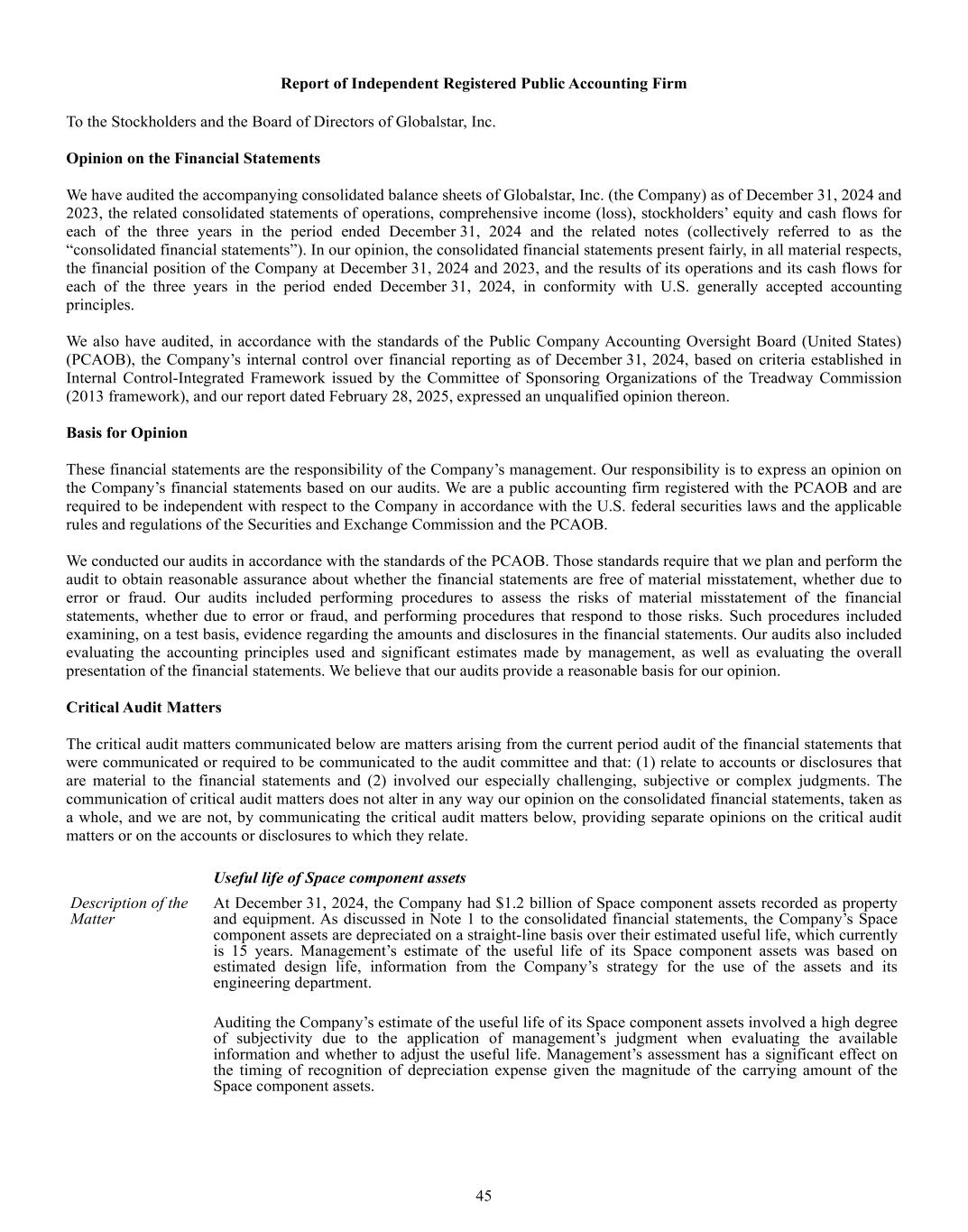
45 Report of Independent Registered Public Accounting Firm To the Stockholders and the Board of Directors of Globalstar, Inc. Opinion on the Financial Statements We have audited the accompanying consolidated balance sheets of Globalstar, Inc. (the Company) as of December 31, 2024 and 2023, the related consolidated statements of operations, comprehensive income (loss), stockholders’ equity and cash flows for each of the three years in the period ended December 31, 2024 and the related notes (collectively referred to as the “consolidated financial statements”). In our opinion, the consolidated financial statements present fairly, in all material respects, the financial position of the Company at December 31, 2024 and 2023, and the results of its operations and its cash flows for each of the three years in the period ended December 31, 2024, in conformity with U.S. generally accepted accounting principles. We also have audited, in accordance with the standards of the Public Company Accounting Oversight Board (United States) (PCAOB), the Company’s internal control over financial reporting as of December 31, 2024, based on criteria established in Internal Control-Integrated Framework issued by the Committee of Sponsoring Organizations of the Treadway Commission (2013 framework), and our report dated February 28, 2025, expressed an unqualified opinion thereon. Basis for Opinion These financial statements are the responsibility of the Company’s management. Our responsibility is to express an opinion on the Company’s financial statements based on our audits. We are a public accounting firm registered with the PCAOB and are required to be independent with respect to the Company in accordance with the U.S. federal securities laws and the applicable rules and regulations of the Securities and Exchange Commission and the PCAOB. We conducted our audits in accordance with the standards of the PCAOB. Those standards require that we plan and perform the audit to obtain reasonable assurance about whether the financial statements are free of material misstatement, whether due to error or fraud. Our audits included performing procedures to assess the risks of material misstatement of the financial statements, whether due to error or fraud, and performing procedures that respond to those risks. Such procedures included examining, on a test basis, evidence regarding the amounts and disclosures in the financial statements. Our audits also included evaluating the accounting principles used and significant estimates made by management, as well as evaluating the overall presentation of the financial statements. We believe that our audits provide a reasonable basis for our opinion. Critical Audit Matters The critical audit matters communicated below are matters arising from the current period audit of the financial statements that were communicated or required to be communicated to the audit committee and that: (1) relate to accounts or disclosures that are material to the financial statements and (2) involved our especially challenging, subjective or complex judgments. The communication of critical audit matters does not alter in any way our opinion on the consolidated financial statements, taken as a whole, and we are not, by communicating the critical audit matters below, providing separate opinions on the critical audit matters or on the accounts or disclosures to which they relate. Useful life of Space component assets Description of the Matter At December 31, 2024, the Company had $1.2 billion of Space component assets recorded as property and equipment. As discussed in Note 1 to the consolidated financial statements, the Company’s Space component assets are depreciated on a straight-line basis over their estimated useful life, which currently is 15 years. Management’s estimate of the useful life of its Space component assets was based on estimated design life, information from the Company’s strategy for the use of the assets and its engineering department. Auditing the Company’s estimate of the useful life of its Space component assets involved a high degree of subjectivity due to the application of management’s judgment when evaluating the available information and whether to adjust the useful life. Management’s assessment has a significant effect on the timing of recognition of depreciation expense given the magnitude of the carrying amount of the Space component assets.
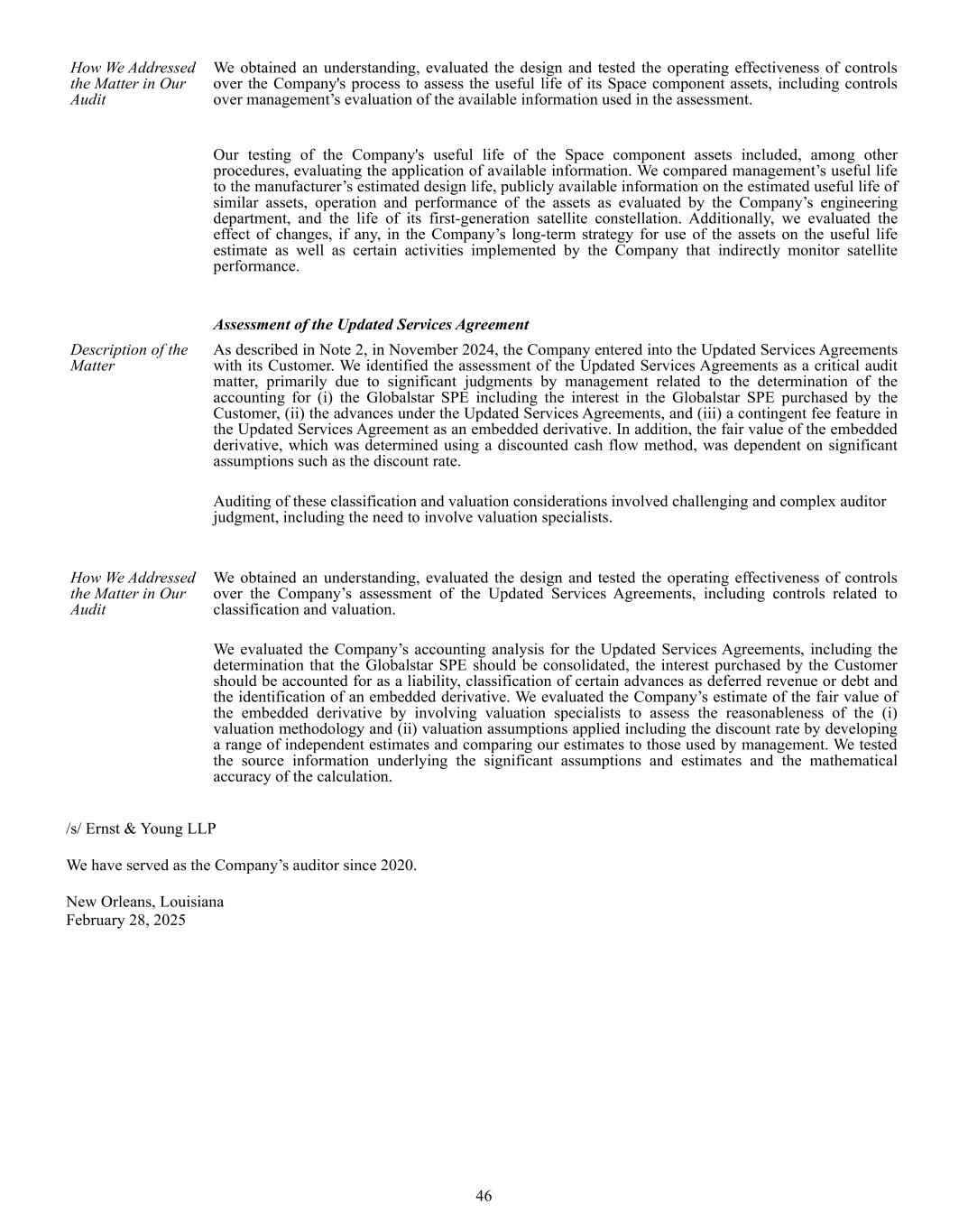
46 How We Addressed the Matter in Our Audit We obtained an understanding, evaluated the design and tested the operating effectiveness of controls over the Company's process to assess the useful life of its Space component assets, including controls over management’s evaluation of the available information used in the assessment. Our testing of the Company's useful life of the Space component assets included, among other procedures, evaluating the application of available information. We compared management’s useful life to the manufacturer’s estimated design life, publicly available information on the estimated useful life of similar assets, operation and performance of the assets as evaluated by the Company’s engineering department, and the life of its first-generation satellite constellation. Additionally, we evaluated the effect of changes, if any, in the Company’s long-term strategy for use of the assets on the useful life estimate as well as certain activities implemented by the Company that indirectly monitor satellite performance. Assessment of the Updated Services Agreement Description of the Matter As described in Note 2, in November 2024, the Company entered into the Updated Services Agreements with its Customer. We identified the assessment of the Updated Services Agreements as a critical audit matter, primarily due to significant judgments by management related to the determination of the accounting for (i) the Globalstar SPE including the interest in the Globalstar SPE purchased by the Customer, (ii) the advances under the Updated Services Agreements, and (iii) a contingent fee feature in the Updated Services Agreement as an embedded derivative. In addition, the fair value of the embedded derivative, which was determined using a discounted cash flow method, was dependent on significant assumptions such as the discount rate. Auditing of these classification and valuation considerations involved challenging and complex auditor judgment, including the need to involve valuation specialists. How We Addressed the Matter in Our Audit We obtained an understanding, evaluated the design and tested the operating effectiveness of controls over the Company’s assessment of the Updated Services Agreements, including controls related to classification and valuation. We evaluated the Company’s accounting analysis for the Updated Services Agreements, including the determination that the Globalstar SPE should be consolidated, the interest purchased by the Customer should be accounted for as a liability, classification of certain advances as deferred revenue or debt and the identification of an embedded derivative. We evaluated the Company’s estimate of the fair value of the embedded derivative by involving valuation specialists to assess the reasonableness of the (i) valuation methodology and (ii) valuation assumptions applied including the discount rate by developing a range of independent estimates and comparing our estimates to those used by management. We tested the source information underlying the significant assumptions and estimates and the mathematical accuracy of the calculation. /s/ Ernst & Young LLP We have served as the Company’s auditor since 2020. New Orleans, Louisiana February 28, 2025
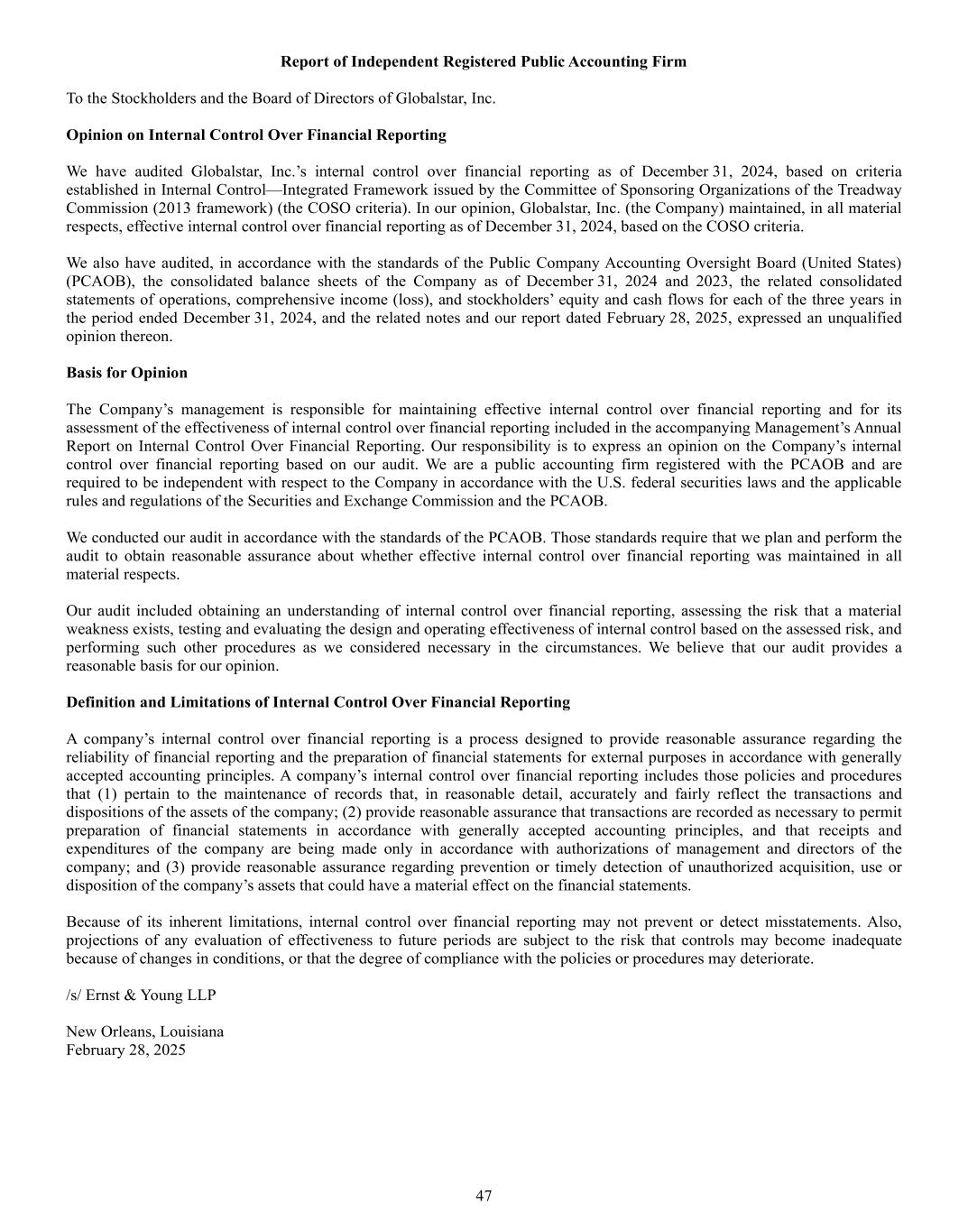
47 Report of Independent Registered Public Accounting Firm To the Stockholders and the Board of Directors of Globalstar, Inc. Opinion on Internal Control Over Financial Reporting We have audited Globalstar, Inc.’s internal control over financial reporting as of December 31, 2024, based on criteria established in Internal Control—Integrated Framework issued by the Committee of Sponsoring Organizations of the Treadway Commission (2013 framework) (the COSO criteria). In our opinion, Globalstar, Inc. (the Company) maintained, in all material respects, effective internal control over financial reporting as of December 31, 2024, based on the COSO criteria. We also have audited, in accordance with the standards of the Public Company Accounting Oversight Board (United States) (PCAOB), the consolidated balance sheets of the Company as of December 31, 2024 and 2023, the related consolidated statements of operations, comprehensive income (loss), and stockholders’ equity and cash flows for each of the three years in the period ended December 31, 2024, and the related notes and our report dated February 28, 2025, expressed an unqualified opinion thereon. Basis for Opinion The Company’s management is responsible for maintaining effective internal control over financial reporting and for its assessment of the effectiveness of internal control over financial reporting included in the accompanying Management’s Annual Report on Internal Control Over Financial Reporting. Our responsibility is to express an opinion on the Company’s internal control over financial reporting based on our audit. We are a public accounting firm registered with the PCAOB and are required to be independent with respect to the Company in accordance with the U.S. federal securities laws and the applicable rules and regulations of the Securities and Exchange Commission and the PCAOB. We conducted our audit in accordance with the standards of the PCAOB. Those standards require that we plan and perform the audit to obtain reasonable assurance about whether effective internal control over financial reporting was maintained in all material respects. Our audit included obtaining an understanding of internal control over financial reporting, assessing the risk that a material weakness exists, testing and evaluating the design and operating effectiveness of internal control based on the assessed risk, and performing such other procedures as we considered necessary in the circumstances. We believe that our audit provides a reasonable basis for our opinion. Definition and Limitations of Internal Control Over Financial Reporting A company’s internal control over financial reporting is a process designed to provide reasonable assurance regarding the reliability of financial reporting and the preparation of financial statements for external purposes in accordance with generally accepted accounting principles. A company’s internal control over financial reporting includes those policies and procedures that (1) pertain to the maintenance of records that, in reasonable detail, accurately and fairly reflect the transactions and dispositions of the assets of the company; (2) provide reasonable assurance that transactions are recorded as necessary to permit preparation of financial statements in accordance with generally accepted accounting principles, and that receipts and expenditures of the company are being made only in accordance with authorizations of management and directors of the company; and (3) provide reasonable assurance regarding prevention or timely detection of unauthorized acquisition, use or disposition of the company’s assets that could have a material effect on the financial statements. Because of its inherent limitations, internal control over financial reporting may not prevent or detect misstatements. Also, projections of any evaluation of effectiveness to future periods are subject to the risk that controls may become inadequate because of changes in conditions, or that the degree of compliance with the policies or procedures may deteriorate. /s/ Ernst & Young LLP New Orleans, Louisiana February 28, 2025
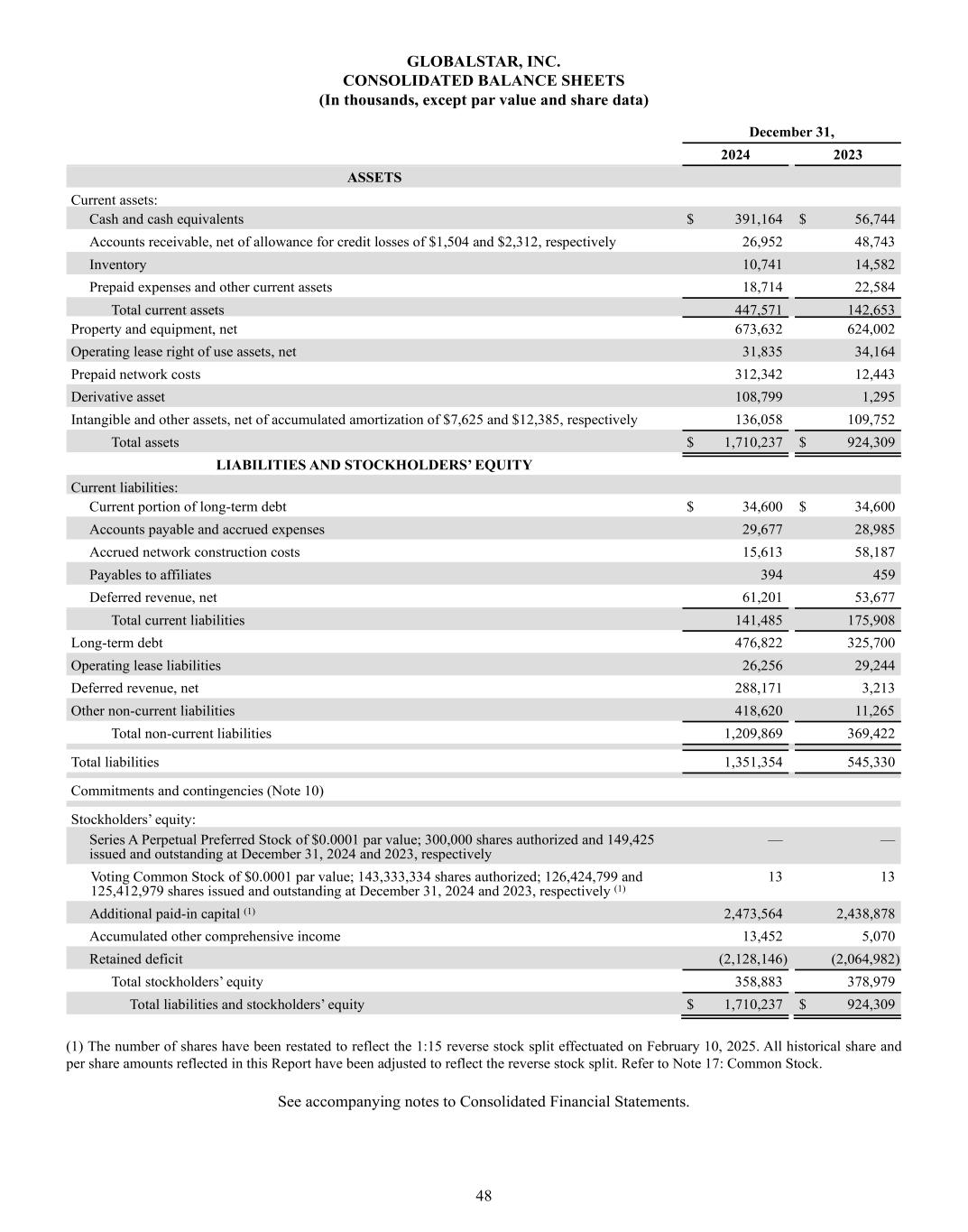
48 GLOBALSTAR, INC. CONSOLIDATED BALANCE SHEETS (In thousands, except par value and share data) December 31, 2024 2023 ASSETS Current assets: Cash and cash equivalents $ 391,164 $ 56,744 Accounts receivable, net of allowance for credit losses of $1,504 and $2,312, respectively 26,952 48,743 Inventory 10,741 14,582 Prepaid expenses and other current assets 18,714 22,584 Total current assets 447,571 142,653 Property and equipment, net 673,632 624,002 Operating lease right of use assets, net 31,835 34,164 Prepaid network costs 312,342 12,443 Derivative asset 108,799 1,295 Intangible and other assets, net of accumulated amortization of $7,625 and $12,385, respectively 136,058 109,752 Total assets $ 1,710,237 $ 924,309 LIABILITIES AND STOCKHOLDERS’ EQUITY Current liabilities: Current portion of long-term debt $ 34,600 $ 34,600 Accounts payable and accrued expenses 29,677 28,985 Accrued network construction costs 15,613 58,187 Payables to affiliates 394 459 Deferred revenue, net 61,201 53,677 Total current liabilities 141,485 175,908 Long-term debt 476,822 325,700 Operating lease liabilities 26,256 29,244 Deferred revenue, net 288,171 3,213 Other non-current liabilities 418,620 11,265 Total non-current liabilities 1,209,869 369,422 Total liabilities 1,351,354 545,330 Commitments and contingencies (Note 10) Stockholders’ equity: Series A Perpetual Preferred Stock of $0.0001 par value; 300,000 shares authorized and 149,425 issued and outstanding at December 31, 2024 and 2023, respectively — — Voting Common Stock of $0.0001 par value; 143,333,334 shares authorized; 126,424,799 and 125,412,979 shares issued and outstanding at December 31, 2024 and 2023, respectively (1) 13 13 Additional paid-in capital (1) 2,473,564 2,438,878 Accumulated other comprehensive income 13,452 5,070 Retained deficit (2,128,146) (2,064,982) Total stockholders’ equity 358,883 378,979 Total liabilities and stockholders’ equity $ 1,710,237 $ 924,309 (1) The number of shares have been restated to reflect the 1:15 reverse stock split effectuated on February 10, 2025. All historical share and per share amounts reflected in this Report have been adjusted to reflect the reverse stock split. Refer to Note 17: Common Stock. See accompanying notes to Consolidated Financial Statements.
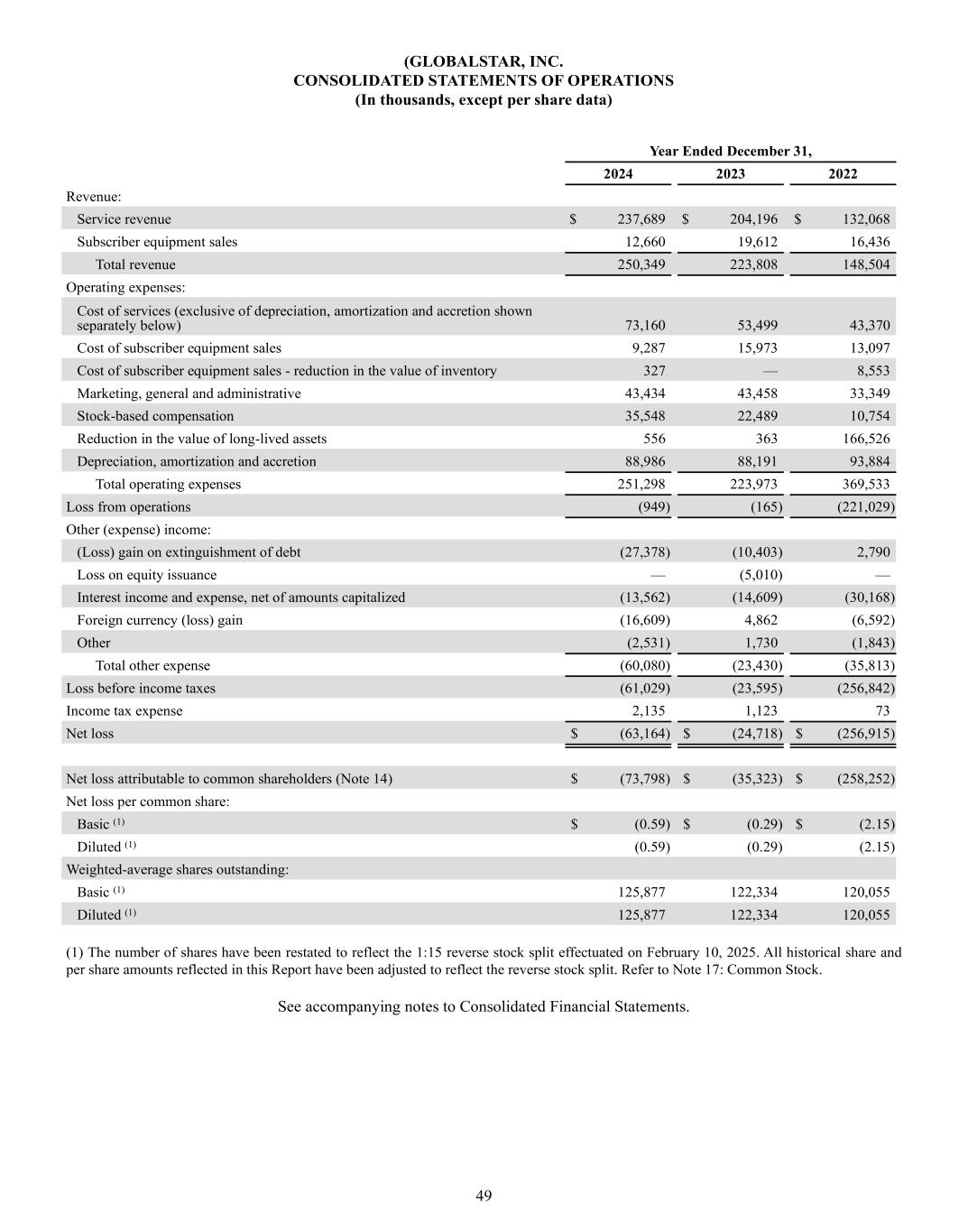
49 (GLOBALSTAR, INC. CONSOLIDATED STATEMENTS OF OPERATIONS (In thousands, except per share data) Year Ended December 31, 2024 2023 2022 Revenue: Service revenue $ 237,689 $ 204,196 $ 132,068 Subscriber equipment sales 12,660 19,612 16,436 Total revenue 250,349 223,808 148,504 Operating expenses: Cost of services (exclusive of depreciation, amortization and accretion shown separately below) 73,160 53,499 43,370 Cost of subscriber equipment sales 9,287 15,973 13,097 Cost of subscriber equipment sales - reduction in the value of inventory 327 — 8,553 Marketing, general and administrative 43,434 43,458 33,349 Stock-based compensation 35,548 22,489 10,754 Reduction in the value of long-lived assets 556 363 166,526 Depreciation, amortization and accretion 88,986 88,191 93,884 Total operating expenses 251,298 223,973 369,533 Loss from operations (949) (165) (221,029) Other (expense) income: (Loss) gain on extinguishment of debt (27,378) (10,403) 2,790 Loss on equity issuance — (5,010) — Interest income and expense, net of amounts capitalized (13,562) (14,609) (30,168) Foreign currency (loss) gain (16,609) 4,862 (6,592) Other (2,531) 1,730 (1,843) Total other expense (60,080) (23,430) (35,813) Loss before income taxes (61,029) (23,595) (256,842) Income tax expense 2,135 1,123 73 Net loss $ (63,164) $ (24,718) $ (256,915) Net loss attributable to common shareholders (Note 14) $ (73,798) $ (35,323) $ (258,252) Net loss per common share: Basic (1) $ (0.59) $ (0.29) $ (2.15) Diluted (1) (0.59) (0.29) (2.15) Weighted-average shares outstanding: Basic (1) 125,877 122,334 120,055 Diluted (1) 125,877 122,334 120,055 (1) The number of shares have been restated to reflect the 1:15 reverse stock split effectuated on February 10, 2025. All historical share and per share amounts reflected in this Report have been adjusted to reflect the reverse stock split. Refer to Note 17: Common Stock. See accompanying notes to Consolidated Financial Statements.
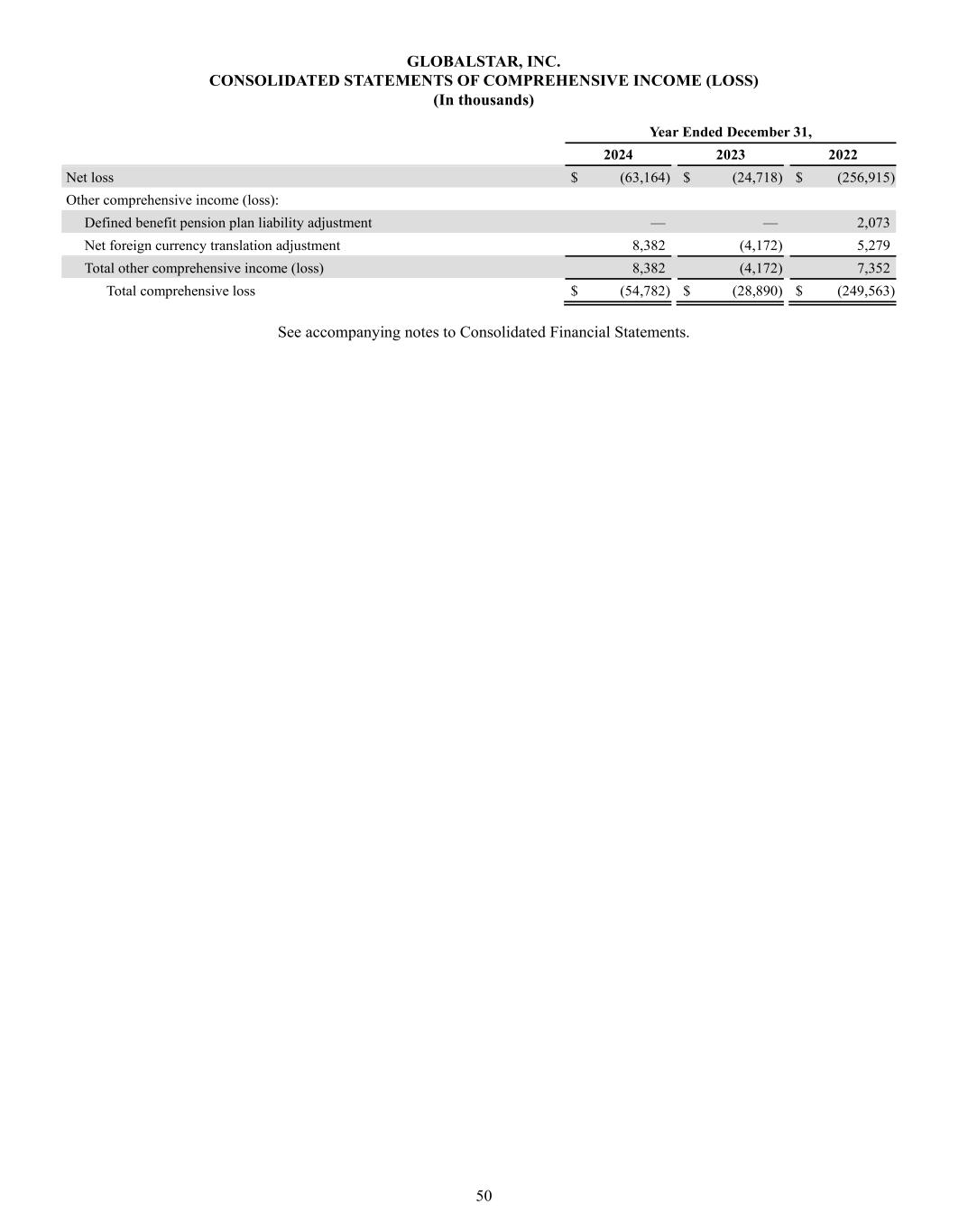
50 GLOBALSTAR, INC. CONSOLIDATED STATEMENTS OF COMPREHENSIVE INCOME (LOSS) (In thousands) Year Ended December 31, 2024 2023 2022 Net loss $ (63,164) $ (24,718) $ (256,915) Other comprehensive income (loss): Defined benefit pension plan liability adjustment — — 2,073 Net foreign currency translation adjustment 8,382 (4,172) 5,279 Total other comprehensive income (loss) 8,382 (4,172) 7,352 Total comprehensive loss $ (54,782) $ (28,890) $ (249,563) See accompanying notes to Consolidated Financial Statements.
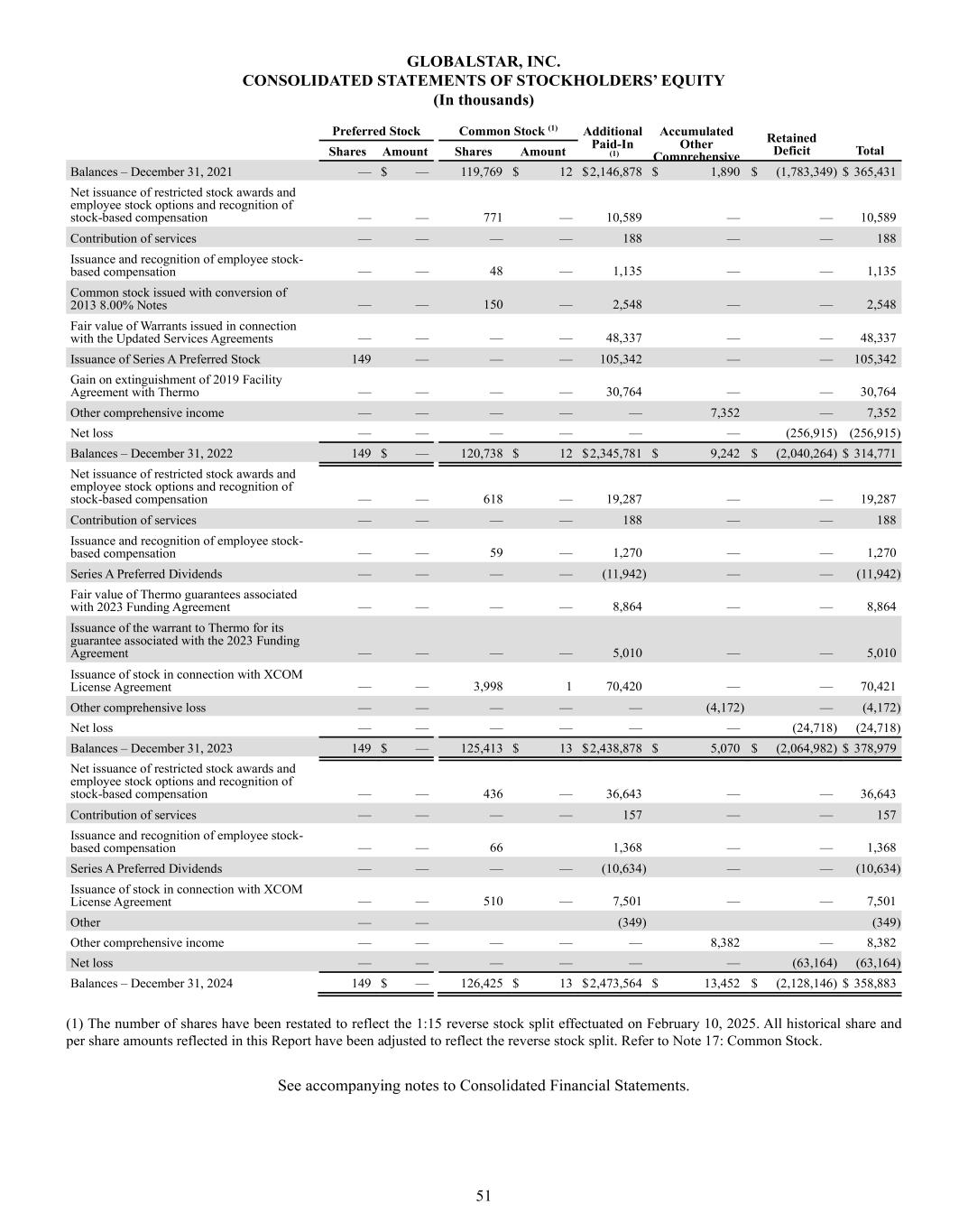
51 GLOBALSTAR, INC. CONSOLIDATED STATEMENTS OF STOCKHOLDERS’ EQUITY (In thousands) Preferred Stock Common Stock (1) Additional Paid-In (1) Accumulated Other Comprehensive Retained Deficit Total Shares Amount Shares Amount Balances – December 31, 2021 — $ — 119,769 $ 12 $ 2,146,878 $ 1,890 $ (1,783,349) $ 365,431 Net issuance of restricted stock awards and employee stock options and recognition of stock-based compensation — — 771 — 10,589 — — 10,589 Contribution of services — — — — 188 — — 188 Issuance and recognition of employee stock- based compensation — — 48 — 1,135 — — 1,135 Common stock issued with conversion of 2013 8.00% Notes — — 150 — 2,548 — — 2,548 Fair value of Warrants issued in connection with the Updated Services Agreements — — — — 48,337 — — 48,337 Issuance of Series A Preferred Stock 149 — — — 105,342 — — 105,342 Gain on extinguishment of 2019 Facility Agreement with Thermo — — — — 30,764 — — 30,764 Other comprehensive income — — — — — 7,352 — 7,352 Net loss — — — — — — (256,915) (256,915) Balances – December 31, 2022 149 $ — 120,738 $ 12 $ 2,345,781 $ 9,242 $ (2,040,264) $ 314,771 Net issuance of restricted stock awards and employee stock options and recognition of stock-based compensation — — 618 — 19,287 — — 19,287 Contribution of services — — — — 188 — — 188 Issuance and recognition of employee stock- based compensation — — 59 — 1,270 — — 1,270 Series A Preferred Dividends — — — — (11,942) — — (11,942) Fair value of Thermo guarantees associated with 2023 Funding Agreement — — — — 8,864 — — 8,864 Issuance of the warrant to Thermo for its guarantee associated with the 2023 Funding Agreement — — — — 5,010 — — 5,010 Issuance of stock in connection with XCOM License Agreement — — 3,998 1 70,420 — — 70,421 Other comprehensive loss — — — — — (4,172) — (4,172) Net loss — — — — — — (24,718) (24,718) Balances – December 31, 2023 149 $ — 125,413 $ 13 $ 2,438,878 $ 5,070 $ (2,064,982) $ 378,979 Net issuance of restricted stock awards and employee stock options and recognition of stock-based compensation — — 436 — 36,643 — — 36,643 Contribution of services — — — — 157 — — 157 Issuance and recognition of employee stock- based compensation — — 66 1,368 — — 1,368 Series A Preferred Dividends — — — — (10,634) — — (10,634) Issuance of stock in connection with XCOM License Agreement — — 510 — 7,501 — — 7,501 Other — — (349) (349) Other comprehensive income — — — — — 8,382 — 8,382 Net loss — — — — — — (63,164) (63,164) Balances – December 31, 2024 149 $ — 126,425 $ 13 $ 2,473,564 $ 13,452 $ (2,128,146) $ 358,883 (1) The number of shares have been restated to reflect the 1:15 reverse stock split effectuated on February 10, 2025. All historical share and per share amounts reflected in this Report have been adjusted to reflect the reverse stock split. Refer to Note 17: Common Stock. See accompanying notes to Consolidated Financial Statements.

52 GLOBALSTAR, INC. CONSOLIDATED STATEMENTS OF CASH FLOWS (In thousands) Year Ended December 31, 2024 2023 2022 Cash flows provided by operating activities: Net loss $ (63,164) $ (24,718) $ (256,915) Adjustments to reconcile net loss to net cash provided by operating activities: Depreciation, amortization and accretion 88,986 88,191 93,884 Stock-based compensation expense 35,548 22,489 10,754 Reduction in the value of long-lived assets and inventory 883 363 175,079 Noncash interest and accretion expense 6,468 14,739 30,231 Noncash portion of loss (gain) on extinguishment of debt 14,008 10,194 (2,790) Loss on equity issuance — 5,010 — Noncash expenses associated with SSA, net of amortization 7,671 3,070 — Unrealized foreign currency loss (gain) 16,663 (4,972) 6,615 Other, net (657) (4,026) 470 Changes in operating assets and liabilities: Accounts receivable 26,661 12,693 (1,009) Inventory 2,796 (4,154) (2,380) Prepaid expenses and other current assets (856) (3,235) 952 Other assets 294 610 (183) Accounts payable and accrued expenses (1,378) (3,408) (11,371) Payables to affiliates (65) 133 (118) Other non-current liabilities 3,561 (53) (2,561) Deferred revenue 301,773 (38,585) 23,142 Net cash provided by operating activities 439,192 74,341 63,800 Cash flows used in investing activities: Payments for network upgrades to support the Phase 2 Service Period (105,315) (158,798) (32,233) Payments for network upgrades to support the Extended MSS Network (131,683) — — Payments of capitalized interest (9,981) (8,810) — Payments for network upgrades to support product development (6,823) (6,907) (7,076) Purchase of intangible assets (6,768) (1,097) (643) Net cash used in investing activities (260,570) (175,612) (39,952) Cash flows provided by (used in) financing activities: Proceeds from issuance of Customer Class B units 176,189 — — Proceeds from issuance of Current Debt Repayment 221,625 — — Principal and make-whole payment of 2023 13% Notes (234,927) — — Proceeds from 2023 Funding Agreement 37,747 117,253 — Principal payments of 2021 Funding Agreement (34,600) (12,500) — Dividends paid on Series A Preferred Stock (10,634) (11,942) — Principal and interest payments of the 2019 Facility Agreement — (148,281) (6,341) Proceeds from 2023 13% Notes — 190,000 — Payments for debt and equity issuance costs — (8,556) (626) Proceeds from issuance of common stock and exercise of options 1,781 (181) 919 Net cash provided by (used in) financing activities 157,181 125,793 (6,048) Effect of exchange rate changes on cash and cash equivalents (1,383) 140 (22) Net increase in cash and cash equivalents 334,420 24,662 17,778 Cash and cash equivalents, beginning of period 56,744 32,082 14,304
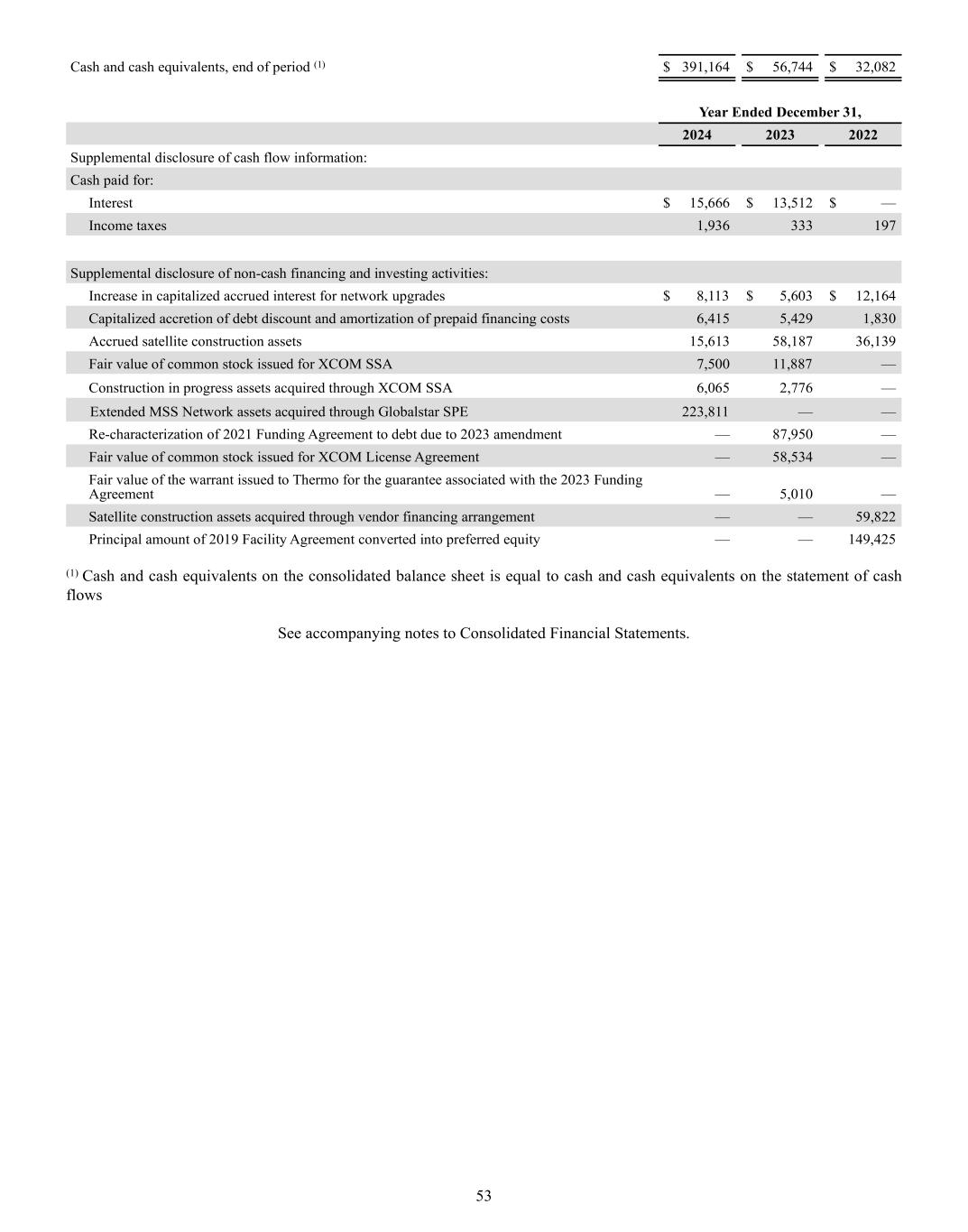
53 Cash and cash equivalents, end of period (1) $ 391,164 $ 56,744 $ 32,082 Year Ended December 31, 2024 2023 2022 Supplemental disclosure of cash flow information: Cash paid for: Interest $ 15,666 $ 13,512 $ — Income taxes 1,936 333 197 Supplemental disclosure of non-cash financing and investing activities: Increase in capitalized accrued interest for network upgrades $ 8,113 $ 5,603 $ 12,164 Capitalized accretion of debt discount and amortization of prepaid financing costs 6,415 5,429 1,830 Accrued satellite construction assets 15,613 58,187 36,139 Fair value of common stock issued for XCOM SSA 7,500 11,887 — Construction in progress assets acquired through XCOM SSA 6,065 2,776 — Extended MSS Network assets acquired through Globalstar SPE 223,811 — — Re-characterization of 2021 Funding Agreement to debt due to 2023 amendment — 87,950 — Fair value of common stock issued for XCOM License Agreement — 58,534 — Fair value of the warrant issued to Thermo for the guarantee associated with the 2023 Funding Agreement — 5,010 — Satellite construction assets acquired through vendor financing arrangement — — 59,822 Principal amount of 2019 Facility Agreement converted into preferred equity — — 149,425 (1) Cash and cash equivalents on the consolidated balance sheet is equal to cash and cash equivalents on the statement of cash flows See accompanying notes to Consolidated Financial Statements.
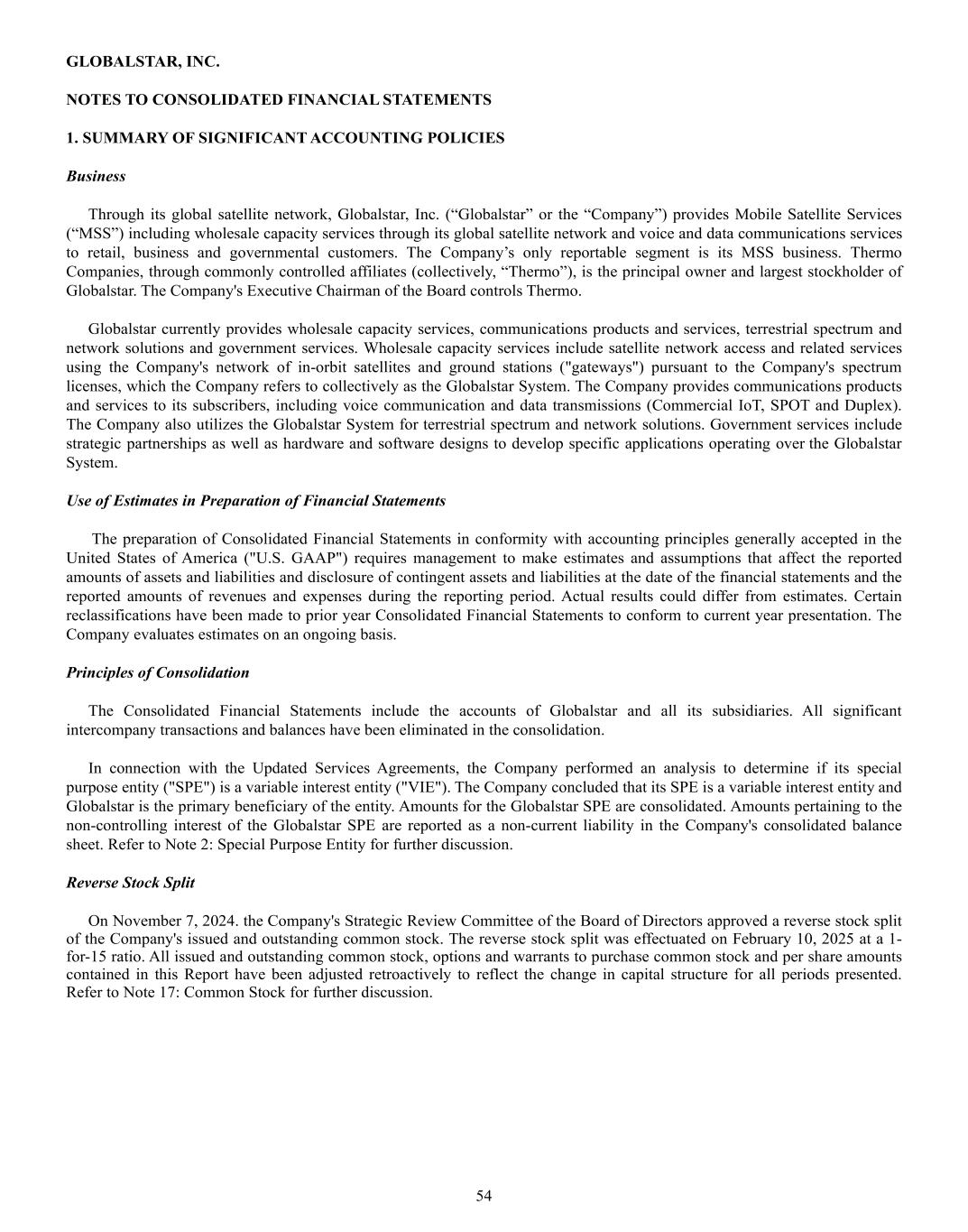
54 GLOBALSTAR, INC. NOTES TO CONSOLIDATED FINANCIAL STATEMENTS 1. SUMMARY OF SIGNIFICANT ACCOUNTING POLICIES Business Through its global satellite network, Globalstar, Inc. (“Globalstar” or the “Company”) provides Mobile Satellite Services (“MSS”) including wholesale capacity services through its global satellite network and voice and data communications services to retail, business and governmental customers. The Company’s only reportable segment is its MSS business. Thermo Companies, through commonly controlled affiliates (collectively, “Thermo”), is the principal owner and largest stockholder of Globalstar. The Company's Executive Chairman of the Board controls Thermo. Globalstar currently provides wholesale capacity services, communications products and services, terrestrial spectrum and network solutions and government services. Wholesale capacity services include satellite network access and related services using the Company's network of in-orbit satellites and ground stations ("gateways") pursuant to the Company's spectrum licenses, which the Company refers to collectively as the Globalstar System. The Company provides communications products and services to its subscribers, including voice communication and data transmissions (Commercial IoT, SPOT and Duplex). The Company also utilizes the Globalstar System for terrestrial spectrum and network solutions. Government services include strategic partnerships as well as hardware and software designs to develop specific applications operating over the Globalstar System. Use of Estimates in Preparation of Financial Statements The preparation of Consolidated Financial Statements in conformity with accounting principles generally accepted in the United States of America ("U.S. GAAP") requires management to make estimates and assumptions that affect the reported amounts of assets and liabilities and disclosure of contingent assets and liabilities at the date of the financial statements and the reported amounts of revenues and expenses during the reporting period. Actual results could differ from estimates. Certain reclassifications have been made to prior year Consolidated Financial Statements to conform to current year presentation. The Company evaluates estimates on an ongoing basis. Principles of Consolidation The Consolidated Financial Statements include the accounts of Globalstar and all its subsidiaries. All significant intercompany transactions and balances have been eliminated in the consolidation. In connection with the Updated Services Agreements, the Company performed an analysis to determine if its special purpose entity ("SPE") is a variable interest entity ("VIE"). The Company concluded that its SPE is a variable interest entity and Globalstar is the primary beneficiary of the entity. Amounts for the Globalstar SPE are consolidated. Amounts pertaining to the non-controlling interest of the Globalstar SPE are reported as a non-current liability in the Company's consolidated balance sheet. Refer to Note 2: Special Purpose Entity for further discussion. Reverse Stock Split On November 7, 2024. the Company's Strategic Review Committee of the Board of Directors approved a reverse stock split of the Company's issued and outstanding common stock. The reverse stock split was effectuated on February 10, 2025 at a 1- for-15 ratio. All issued and outstanding common stock, options and warrants to purchase common stock and per share amounts contained in this Report have been adjusted retroactively to reflect the change in capital structure for all periods presented. Refer to Note 17: Common Stock for further discussion.
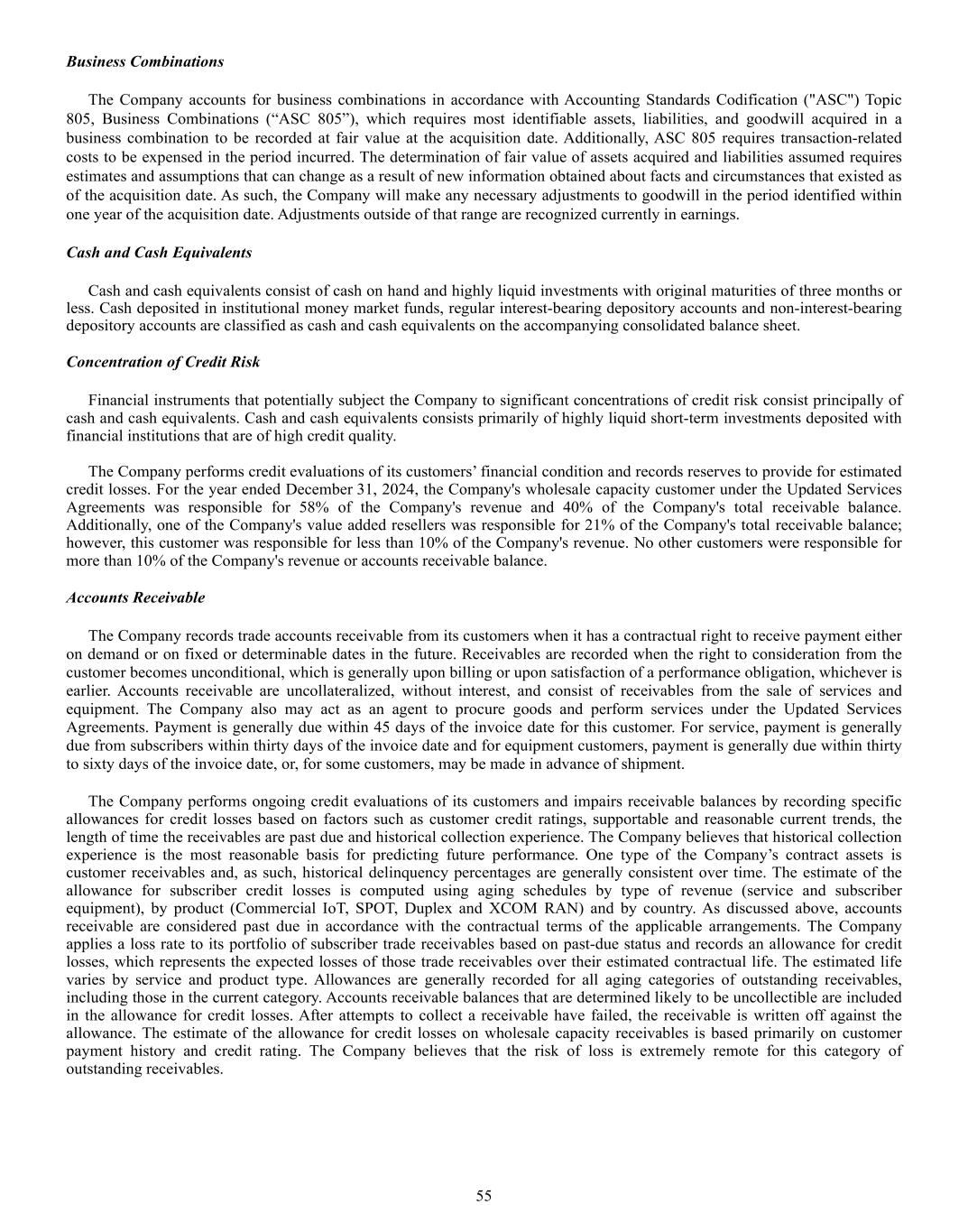
55 Business Combinations The Company accounts for business combinations in accordance with Accounting Standards Codification ("ASC") Topic 805, Business Combinations (“ASC 805”), which requires most identifiable assets, liabilities, and goodwill acquired in a business combination to be recorded at fair value at the acquisition date. Additionally, ASC 805 requires transaction-related costs to be expensed in the period incurred. The determination of fair value of assets acquired and liabilities assumed requires estimates and assumptions that can change as a result of new information obtained about facts and circumstances that existed as of the acquisition date. As such, the Company will make any necessary adjustments to goodwill in the period identified within one year of the acquisition date. Adjustments outside of that range are recognized currently in earnings. Cash and Cash Equivalents Cash and cash equivalents consist of cash on hand and highly liquid investments with original maturities of three months or less. Cash deposited in institutional money market funds, regular interest-bearing depository accounts and non-interest-bearing depository accounts are classified as cash and cash equivalents on the accompanying consolidated balance sheet. Concentration of Credit Risk Financial instruments that potentially subject the Company to significant concentrations of credit risk consist principally of cash and cash equivalents. Cash and cash equivalents consists primarily of highly liquid short-term investments deposited with financial institutions that are of high credit quality. The Company performs credit evaluations of its customers’ financial condition and records reserves to provide for estimated credit losses. For the year ended December 31, 2024, the Company's wholesale capacity customer under the Updated Services Agreements was responsible for 58% of the Company's revenue and 40% of the Company's total receivable balance. Additionally, one of the Company's value added resellers was responsible for 21% of the Company's total receivable balance; however, this customer was responsible for less than 10% of the Company's revenue. No other customers were responsible for more than 10% of the Company's revenue or accounts receivable balance. Accounts Receivable The Company records trade accounts receivable from its customers when it has a contractual right to receive payment either on demand or on fixed or determinable dates in the future. Receivables are recorded when the right to consideration from the customer becomes unconditional, which is generally upon billing or upon satisfaction of a performance obligation, whichever is earlier. Accounts receivable are uncollateralized, without interest, and consist of receivables from the sale of services and equipment. The Company also may act as an agent to procure goods and perform services under the Updated Services Agreements. Payment is generally due within 45 days of the invoice date for this customer. For service, payment is generally due from subscribers within thirty days of the invoice date and for equipment customers, payment is generally due within thirty to sixty days of the invoice date, or, for some customers, may be made in advance of shipment. The Company performs ongoing credit evaluations of its customers and impairs receivable balances by recording specific allowances for credit losses based on factors such as customer credit ratings, supportable and reasonable current trends, the length of time the receivables are past due and historical collection experience. The Company believes that historical collection experience is the most reasonable basis for predicting future performance. One type of the Company’s contract assets is customer receivables and, as such, historical delinquency percentages are generally consistent over time. The estimate of the allowance for subscriber credit losses is computed using aging schedules by type of revenue (service and subscriber equipment), by product (Commercial IoT, SPOT, Duplex and XCOM RAN) and by country. As discussed above, accounts receivable are considered past due in accordance with the contractual terms of the applicable arrangements. The Company applies a loss rate to its portfolio of subscriber trade receivables based on past-due status and records an allowance for credit losses, which represents the expected losses of those trade receivables over their estimated contractual life. The estimated life varies by service and product type. Allowances are generally recorded for all aging categories of outstanding receivables, including those in the current category. Accounts receivable balances that are determined likely to be uncollectible are included in the allowance for credit losses. After attempts to collect a receivable have failed, the receivable is written off against the allowance. The estimate of the allowance for credit losses on wholesale capacity receivables is based primarily on customer payment history and credit rating. The Company believes that the risk of loss is extremely remote for this category of outstanding receivables.
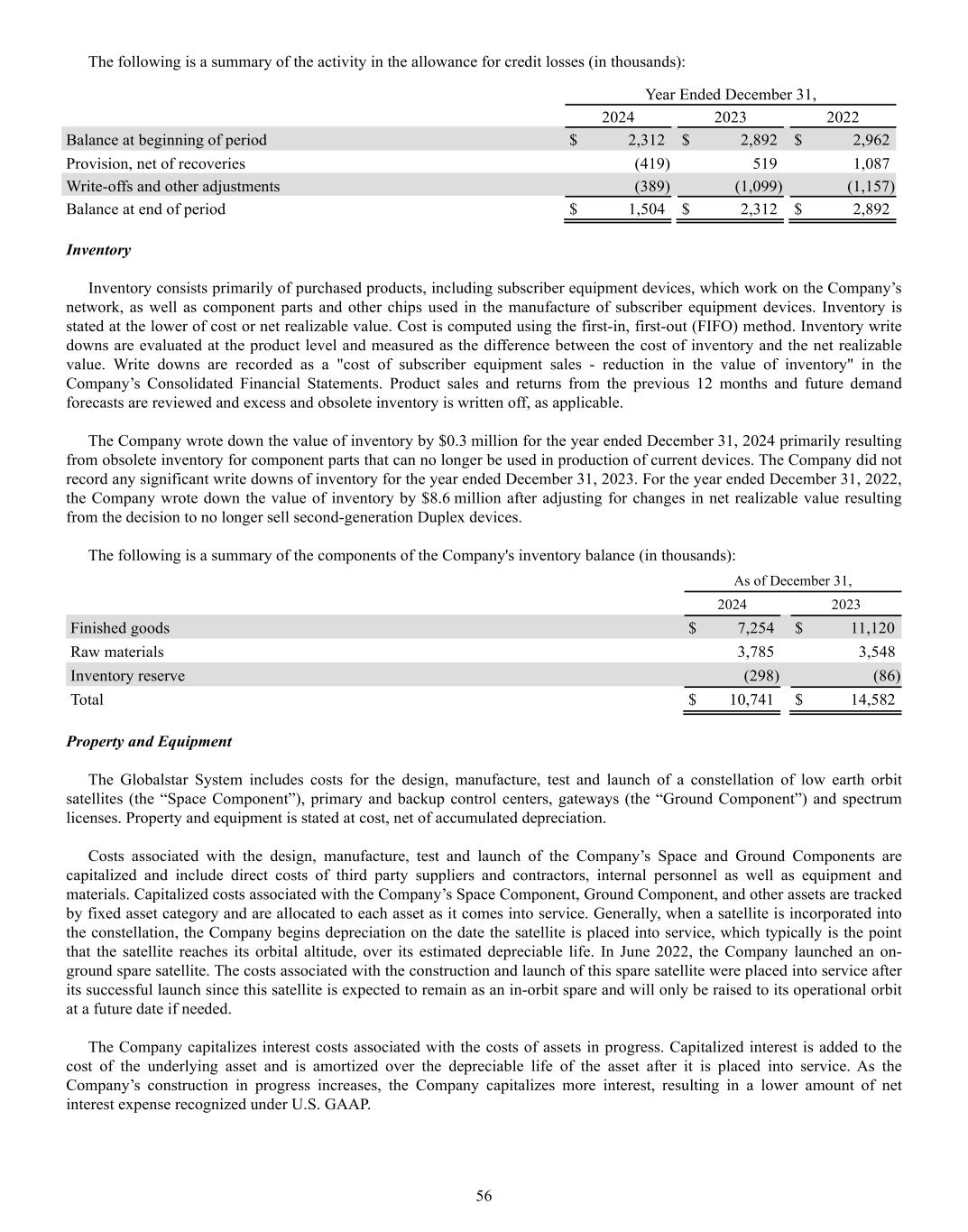
56 The following is a summary of the activity in the allowance for credit losses (in thousands): Year Ended December 31, 2024 2023 2022 Balance at beginning of period $ 2,312 $ 2,892 $ 2,962 Provision, net of recoveries (419) 519 1,087 Write-offs and other adjustments (389) (1,099) (1,157) Balance at end of period $ 1,504 $ 2,312 $ 2,892 Inventory Inventory consists primarily of purchased products, including subscriber equipment devices, which work on the Company’s network, as well as component parts and other chips used in the manufacture of subscriber equipment devices. Inventory is stated at the lower of cost or net realizable value. Cost is computed using the first-in, first-out (FIFO) method. Inventory write downs are evaluated at the product level and measured as the difference between the cost of inventory and the net realizable value. Write downs are recorded as a "cost of subscriber equipment sales - reduction in the value of inventory" in the Company’s Consolidated Financial Statements. Product sales and returns from the previous 12 months and future demand forecasts are reviewed and excess and obsolete inventory is written off, as applicable. The Company wrote down the value of inventory by $0.3 million for the year ended December 31, 2024 primarily resulting from obsolete inventory for component parts that can no longer be used in production of current devices. The Company did not record any significant write downs of inventory for the year ended December 31, 2023. For the year ended December 31, 2022, the Company wrote down the value of inventory by $8.6 million after adjusting for changes in net realizable value resulting from the decision to no longer sell second-generation Duplex devices. The following is a summary of the components of the Company's inventory balance (in thousands): As of December 31, 2024 2023 Finished goods $ 7,254 $ 11,120 Raw materials 3,785 3,548 Inventory reserve (298) (86) Total $ 10,741 $ 14,582 Property and Equipment The Globalstar System includes costs for the design, manufacture, test and launch of a constellation of low earth orbit satellites (the “Space Component”), primary and backup control centers, gateways (the “Ground Component”) and spectrum licenses. Property and equipment is stated at cost, net of accumulated depreciation. Costs associated with the design, manufacture, test and launch of the Company’s Space and Ground Components are capitalized and include direct costs of third party suppliers and contractors, internal personnel as well as equipment and materials. Capitalized costs associated with the Company’s Space Component, Ground Component, and other assets are tracked by fixed asset category and are allocated to each asset as it comes into service. Generally, when a satellite is incorporated into the constellation, the Company begins depreciation on the date the satellite is placed into service, which typically is the point that the satellite reaches its orbital altitude, over its estimated depreciable life. In June 2022, the Company launched an on- ground spare satellite. The costs associated with the construction and launch of this spare satellite were placed into service after its successful launch since this satellite is expected to remain as an in-orbit spare and will only be raised to its operational orbit at a future date if needed. The Company capitalizes interest costs associated with the costs of assets in progress. Capitalized interest is added to the cost of the underlying asset and is amortized over the depreciable life of the asset after it is placed into service. As the Company’s construction in progress increases, the Company capitalizes more interest, resulting in a lower amount of net interest expense recognized under U.S. GAAP.
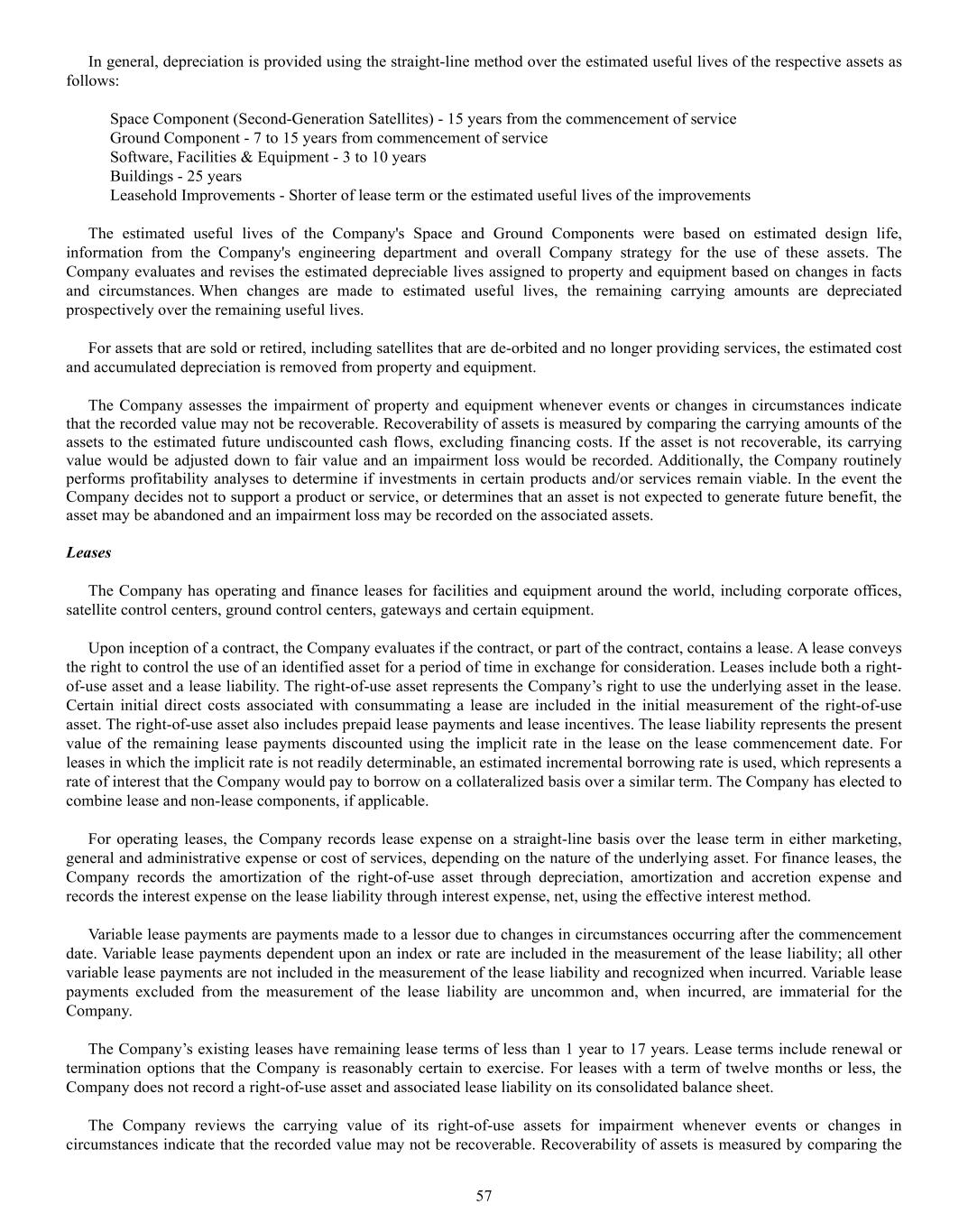
57 In general, depreciation is provided using the straight-line method over the estimated useful lives of the respective assets as follows: Space Component (Second-Generation Satellites) - 15 years from the commencement of service Ground Component - 7 to 15 years from commencement of service Software, Facilities & Equipment - 3 to 10 years Buildings - 25 years Leasehold Improvements - Shorter of lease term or the estimated useful lives of the improvements The estimated useful lives of the Company's Space and Ground Components were based on estimated design life, information from the Company's engineering department and overall Company strategy for the use of these assets. The Company evaluates and revises the estimated depreciable lives assigned to property and equipment based on changes in facts and circumstances. When changes are made to estimated useful lives, the remaining carrying amounts are depreciated prospectively over the remaining useful lives. For assets that are sold or retired, including satellites that are de-orbited and no longer providing services, the estimated cost and accumulated depreciation is removed from property and equipment. The Company assesses the impairment of property and equipment whenever events or changes in circumstances indicate that the recorded value may not be recoverable. Recoverability of assets is measured by comparing the carrying amounts of the assets to the estimated future undiscounted cash flows, excluding financing costs. If the asset is not recoverable, its carrying value would be adjusted down to fair value and an impairment loss would be recorded. Additionally, the Company routinely performs profitability analyses to determine if investments in certain products and/or services remain viable. In the event the Company decides not to support a product or service, or determines that an asset is not expected to generate future benefit, the asset may be abandoned and an impairment loss may be recorded on the associated assets. Leases The Company has operating and finance leases for facilities and equipment around the world, including corporate offices, satellite control centers, ground control centers, gateways and certain equipment. Upon inception of a contract, the Company evaluates if the contract, or part of the contract, contains a lease. A lease conveys the right to control the use of an identified asset for a period of time in exchange for consideration. Leases include both a right- of-use asset and a lease liability. The right-of-use asset represents the Company’s right to use the underlying asset in the lease. Certain initial direct costs associated with consummating a lease are included in the initial measurement of the right-of-use asset. The right-of-use asset also includes prepaid lease payments and lease incentives. The lease liability represents the present value of the remaining lease payments discounted using the implicit rate in the lease on the lease commencement date. For leases in which the implicit rate is not readily determinable, an estimated incremental borrowing rate is used, which represents a rate of interest that the Company would pay to borrow on a collateralized basis over a similar term. The Company has elected to combine lease and non-lease components, if applicable. For operating leases, the Company records lease expense on a straight-line basis over the lease term in either marketing, general and administrative expense or cost of services, depending on the nature of the underlying asset. For finance leases, the Company records the amortization of the right-of-use asset through depreciation, amortization and accretion expense and records the interest expense on the lease liability through interest expense, net, using the effective interest method. Variable lease payments are payments made to a lessor due to changes in circumstances occurring after the commencement date. Variable lease payments dependent upon an index or rate are included in the measurement of the lease liability; all other variable lease payments are not included in the measurement of the lease liability and recognized when incurred. Variable lease payments excluded from the measurement of the lease liability are uncommon and, when incurred, are immaterial for the Company. The Company’s existing leases have remaining lease terms of less than 1 year to 17 years. Lease terms include renewal or termination options that the Company is reasonably certain to exercise. For leases with a term of twelve months or less, the Company does not record a right-of-use asset and associated lease liability on its consolidated balance sheet. The Company reviews the carrying value of its right-of-use assets for impairment whenever events or changes in circumstances indicate that the recorded value may not be recoverable. Recoverability of assets is measured by comparing the
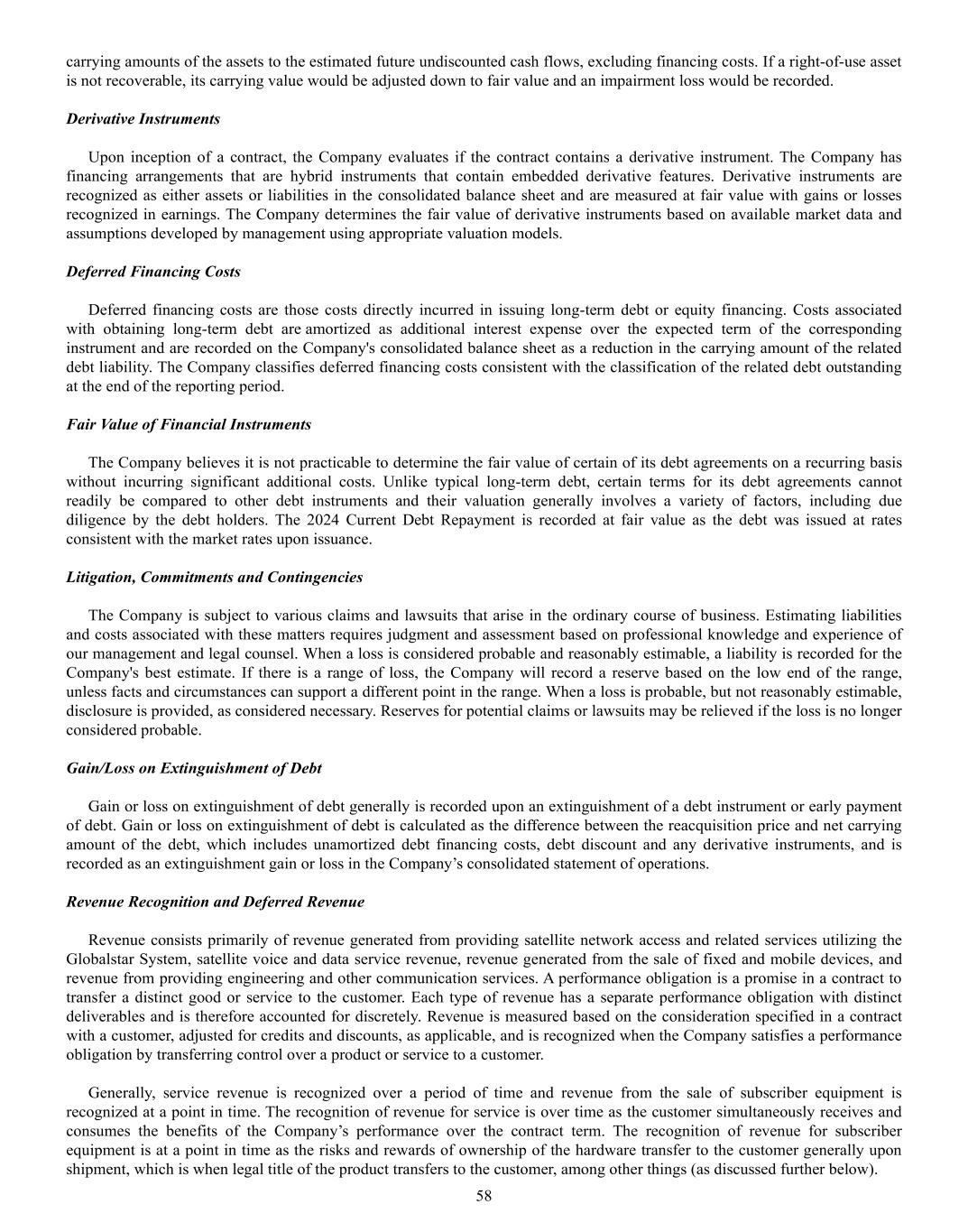
58 carrying amounts of the assets to the estimated future undiscounted cash flows, excluding financing costs. If a right-of-use asset is not recoverable, its carrying value would be adjusted down to fair value and an impairment loss would be recorded. Derivative Instruments Upon inception of a contract, the Company evaluates if the contract contains a derivative instrument. The Company has financing arrangements that are hybrid instruments that contain embedded derivative features. Derivative instruments are recognized as either assets or liabilities in the consolidated balance sheet and are measured at fair value with gains or losses recognized in earnings. The Company determines the fair value of derivative instruments based on available market data and assumptions developed by management using appropriate valuation models. Deferred Financing Costs Deferred financing costs are those costs directly incurred in issuing long-term debt or equity financing. Costs associated with obtaining long-term debt are amortized as additional interest expense over the expected term of the corresponding instrument and are recorded on the Company's consolidated balance sheet as a reduction in the carrying amount of the related debt liability. The Company classifies deferred financing costs consistent with the classification of the related debt outstanding at the end of the reporting period. Fair Value of Financial Instruments The Company believes it is not practicable to determine the fair value of certain of its debt agreements on a recurring basis without incurring significant additional costs. Unlike typical long-term debt, certain terms for its debt agreements cannot readily be compared to other debt instruments and their valuation generally involves a variety of factors, including due diligence by the debt holders. The 2024 Current Debt Repayment is recorded at fair value as the debt was issued at rates consistent with the market rates upon issuance. Litigation, Commitments and Contingencies The Company is subject to various claims and lawsuits that arise in the ordinary course of business. Estimating liabilities and costs associated with these matters requires judgment and assessment based on professional knowledge and experience of our management and legal counsel. When a loss is considered probable and reasonably estimable, a liability is recorded for the Company's best estimate. If there is a range of loss, the Company will record a reserve based on the low end of the range, unless facts and circumstances can support a different point in the range. When a loss is probable, but not reasonably estimable, disclosure is provided, as considered necessary. Reserves for potential claims or lawsuits may be relieved if the loss is no longer considered probable. Gain/Loss on Extinguishment of Debt Gain or loss on extinguishment of debt generally is recorded upon an extinguishment of a debt instrument or early payment of debt. Gain or loss on extinguishment of debt is calculated as the difference between the reacquisition price and net carrying amount of the debt, which includes unamortized debt financing costs, debt discount and any derivative instruments, and is recorded as an extinguishment gain or loss in the Company’s consolidated statement of operations. Revenue Recognition and Deferred Revenue Revenue consists primarily of revenue generated from providing satellite network access and related services utilizing the Globalstar System, satellite voice and data service revenue, revenue generated from the sale of fixed and mobile devices, and revenue from providing engineering and other communication services. A performance obligation is a promise in a contract to transfer a distinct good or service to the customer. Each type of revenue has a separate performance obligation with distinct deliverables and is therefore accounted for discretely. Revenue is measured based on the consideration specified in a contract with a customer, adjusted for credits and discounts, as applicable, and is recognized when the Company satisfies a performance obligation by transferring control over a product or service to a customer. Generally, service revenue is recognized over a period of time and revenue from the sale of subscriber equipment is recognized at a point in time. The recognition of revenue for service is over time as the customer simultaneously receives and consumes the benefits of the Company’s performance over the contract term. The recognition of revenue for subscriber equipment is at a point in time as the risks and rewards of ownership of the hardware transfer to the customer generally upon shipment, which is when legal title of the product transfers to the customer, among other things (as discussed further below).
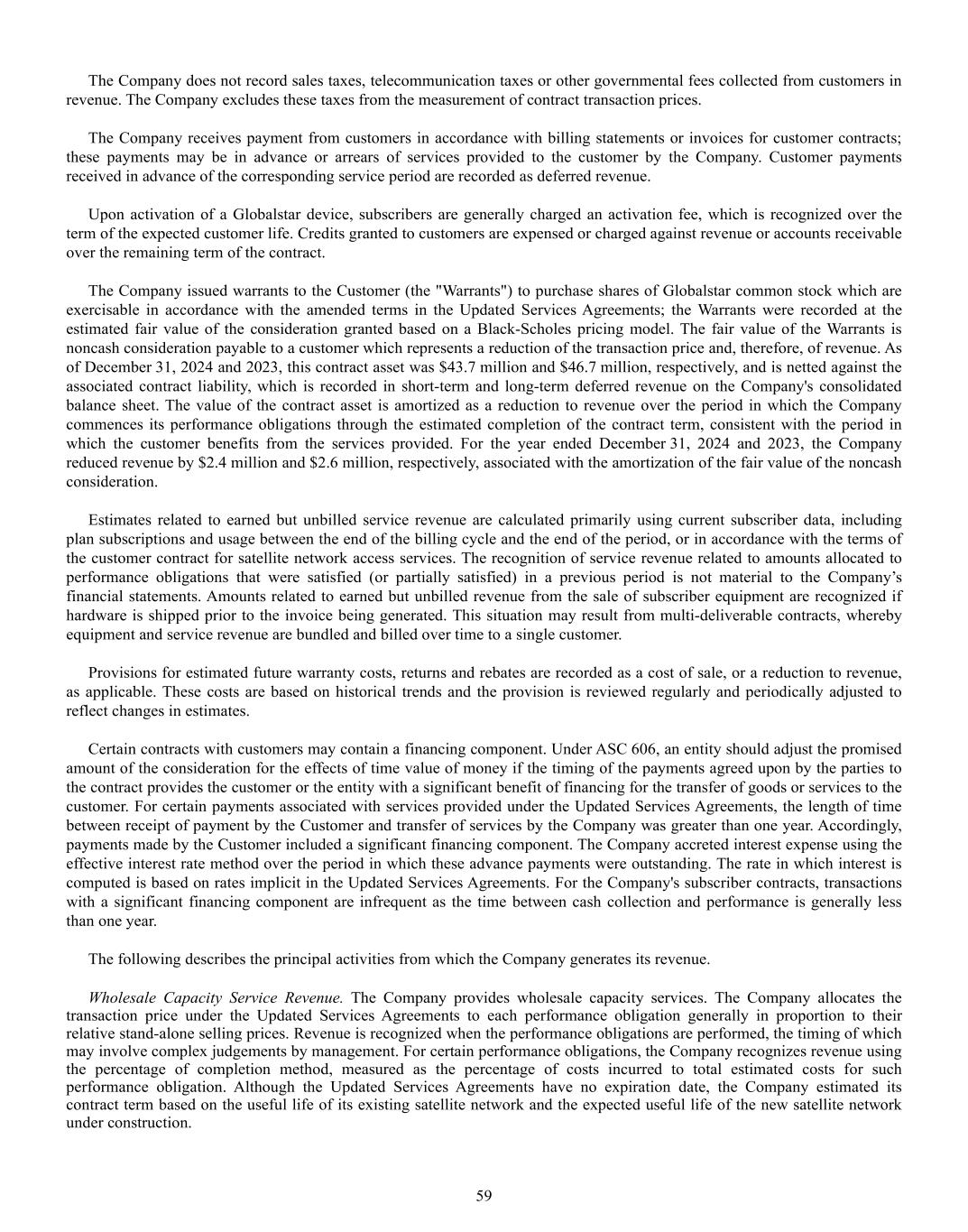
59 The Company does not record sales taxes, telecommunication taxes or other governmental fees collected from customers in revenue. The Company excludes these taxes from the measurement of contract transaction prices. The Company receives payment from customers in accordance with billing statements or invoices for customer contracts; these payments may be in advance or arrears of services provided to the customer by the Company. Customer payments received in advance of the corresponding service period are recorded as deferred revenue. Upon activation of a Globalstar device, subscribers are generally charged an activation fee, which is recognized over the term of the expected customer life. Credits granted to customers are expensed or charged against revenue or accounts receivable over the remaining term of the contract. The Company issued warrants to the Customer (the "Warrants") to purchase shares of Globalstar common stock which are exercisable in accordance with the amended terms in the Updated Services Agreements; the Warrants were recorded at the estimated fair value of the consideration granted based on a Black-Scholes pricing model. The fair value of the Warrants is noncash consideration payable to a customer which represents a reduction of the transaction price and, therefore, of revenue. As of December 31, 2024 and 2023, this contract asset was $43.7 million and $46.7 million, respectively, and is netted against the associated contract liability, which is recorded in short-term and long-term deferred revenue on the Company's consolidated balance sheet. The value of the contract asset is amortized as a reduction to revenue over the period in which the Company commences its performance obligations through the estimated completion of the contract term, consistent with the period in which the customer benefits from the services provided. For the year ended December 31, 2024 and 2023, the Company reduced revenue by $2.4 million and $2.6 million, respectively, associated with the amortization of the fair value of the noncash consideration. Estimates related to earned but unbilled service revenue are calculated primarily using current subscriber data, including plan subscriptions and usage between the end of the billing cycle and the end of the period, or in accordance with the terms of the customer contract for satellite network access services. The recognition of service revenue related to amounts allocated to performance obligations that were satisfied (or partially satisfied) in a previous period is not material to the Company’s financial statements. Amounts related to earned but unbilled revenue from the sale of subscriber equipment are recognized if hardware is shipped prior to the invoice being generated. This situation may result from multi-deliverable contracts, whereby equipment and service revenue are bundled and billed over time to a single customer. Provisions for estimated future warranty costs, returns and rebates are recorded as a cost of sale, or a reduction to revenue, as applicable. These costs are based on historical trends and the provision is reviewed regularly and periodically adjusted to reflect changes in estimates. Certain contracts with customers may contain a financing component. Under ASC 606, an entity should adjust the promised amount of the consideration for the effects of time value of money if the timing of the payments agreed upon by the parties to the contract provides the customer or the entity with a significant benefit of financing for the transfer of goods or services to the customer. For certain payments associated with services provided under the Updated Services Agreements, the length of time between receipt of payment by the Customer and transfer of services by the Company was greater than one year. Accordingly, payments made by the Customer included a significant financing component. The Company accreted interest expense using the effective interest rate method over the period in which these advance payments were outstanding. The rate in which interest is computed is based on rates implicit in the Updated Services Agreements. For the Company's subscriber contracts, transactions with a significant financing component are infrequent as the time between cash collection and performance is generally less than one year. The following describes the principal activities from which the Company generates its revenue. Wholesale Capacity Service Revenue. The Company provides wholesale capacity services. The Company allocates the transaction price under the Updated Services Agreements to each performance obligation generally in proportion to their relative stand-alone selling prices. Revenue is recognized when the performance obligations are performed, the timing of which may involve complex judgements by management. For certain performance obligations, the Company recognizes revenue using the percentage of completion method, measured as the percentage of costs incurred to total estimated costs for such performance obligation. Although the Updated Services Agreements have no expiration date, the Company estimated its contract term based on the useful life of its existing satellite network and the expected useful life of the new satellite network under construction.
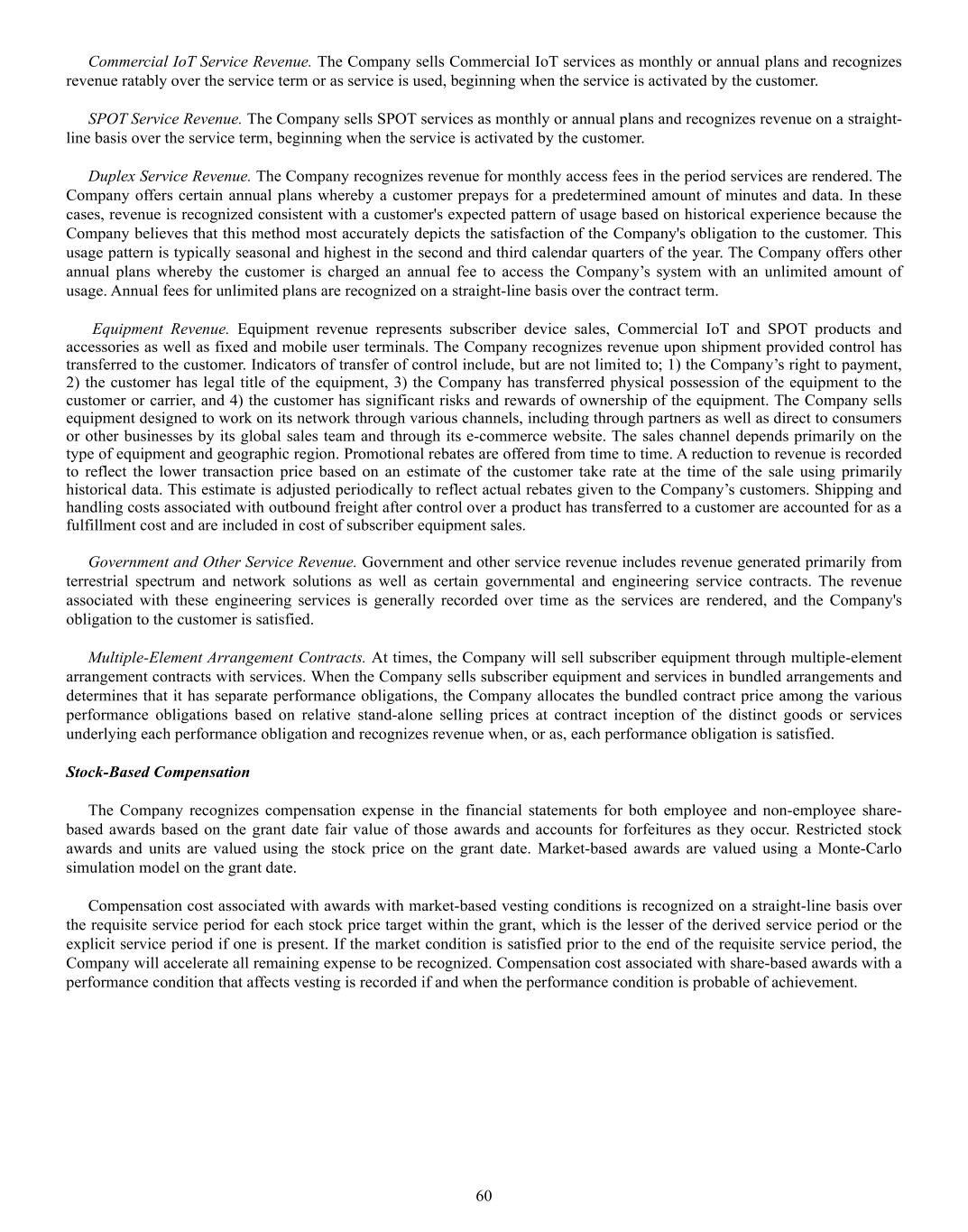
60 Commercial IoT Service Revenue. The Company sells Commercial IoT services as monthly or annual plans and recognizes revenue ratably over the service term or as service is used, beginning when the service is activated by the customer. SPOT Service Revenue. The Company sells SPOT services as monthly or annual plans and recognizes revenue on a straight- line basis over the service term, beginning when the service is activated by the customer. Duplex Service Revenue. The Company recognizes revenue for monthly access fees in the period services are rendered. The Company offers certain annual plans whereby a customer prepays for a predetermined amount of minutes and data. In these cases, revenue is recognized consistent with a customer's expected pattern of usage based on historical experience because the Company believes that this method most accurately depicts the satisfaction of the Company's obligation to the customer. This usage pattern is typically seasonal and highest in the second and third calendar quarters of the year. The Company offers other annual plans whereby the customer is charged an annual fee to access the Company’s system with an unlimited amount of usage. Annual fees for unlimited plans are recognized on a straight-line basis over the contract term. Equipment Revenue. Equipment revenue represents subscriber device sales, Commercial IoT and SPOT products and accessories as well as fixed and mobile user terminals. The Company recognizes revenue upon shipment provided control has transferred to the customer. Indicators of transfer of control include, but are not limited to; 1) the Company’s right to payment, 2) the customer has legal title of the equipment, 3) the Company has transferred physical possession of the equipment to the customer or carrier, and 4) the customer has significant risks and rewards of ownership of the equipment. The Company sells equipment designed to work on its network through various channels, including through partners as well as direct to consumers or other businesses by its global sales team and through its e-commerce website. The sales channel depends primarily on the type of equipment and geographic region. Promotional rebates are offered from time to time. A reduction to revenue is recorded to reflect the lower transaction price based on an estimate of the customer take rate at the time of the sale using primarily historical data. This estimate is adjusted periodically to reflect actual rebates given to the Company’s customers. Shipping and handling costs associated with outbound freight after control over a product has transferred to a customer are accounted for as a fulfillment cost and are included in cost of subscriber equipment sales. Government and Other Service Revenue. Government and other service revenue includes revenue generated primarily from terrestrial spectrum and network solutions as well as certain governmental and engineering service contracts. The revenue associated with these engineering services is generally recorded over time as the services are rendered, and the Company's obligation to the customer is satisfied. Multiple-Element Arrangement Contracts. At times, the Company will sell subscriber equipment through multiple-element arrangement contracts with services. When the Company sells subscriber equipment and services in bundled arrangements and determines that it has separate performance obligations, the Company allocates the bundled contract price among the various performance obligations based on relative stand-alone selling prices at contract inception of the distinct goods or services underlying each performance obligation and recognizes revenue when, or as, each performance obligation is satisfied. Stock-Based Compensation The Company recognizes compensation expense in the financial statements for both employee and non-employee share- based awards based on the grant date fair value of those awards and accounts for forfeitures as they occur. Restricted stock awards and units are valued using the stock price on the grant date. Market-based awards are valued using a Monte-Carlo simulation model on the grant date. Compensation cost associated with awards with market-based vesting conditions is recognized on a straight-line basis over the requisite service period for each stock price target within the grant, which is the lesser of the derived service period or the explicit service period if one is present. If the market condition is satisfied prior to the end of the requisite service period, the Company will accelerate all remaining expense to be recognized. Compensation cost associated with share-based awards with a performance condition that affects vesting is recorded if and when the performance condition is probable of achievement.

61 Foreign Currency The functional currency of the Company’s foreign consolidated subsidiaries is generally their local currency, except in certain scenarios, including when the subsidiary operates in a hyperinflationary economy, such as Argentina. Assets and liabilities of its foreign subsidiaries are translated into United States dollars based on exchange rates at the end of the reporting period. Income and expense items are translated at the average exchange rates prevailing during the reporting period. Translation adjustments are accumulated in a separate component of stockholders’ equity. For 2024, 2023 and 2022, the foreign currency translation adjustments were net gains of $8.4 million, net losses of $4.2 million and net gains of $5.3 million, respectively. Foreign currency transaction gains/losses were approximately net losses of $16.6 million, net gains of $4.9 million and net losses of $6.6 million for each of 2024, 2023, and 2022, respectively. Asset Retirement Obligation Liabilities arising from legal obligations associated with the retirement of the Company's gateway long-lived assets are measured at fair value and recorded as a liability. As of December 31, 2024 and 2023, the Company had accrued approximately $2.9 million and $3.0 million, respectively, for asset retirement obligations. There were no new asset retirement obligations established and no significant settlements during 2024. The Company believes this estimate will be sufficient to satisfy the Company’s obligation under site leases to remove its gateway equipment and restore the lease sites to their original condition. Warranty Expense Warranty terms extend from 90 days on equipment accessories to one year for fixed and mobile user terminals. A provision for estimated future warranty costs is recorded as cost of sales when products are shipped. Warranty costs are based on historical trends in warranty charges as a percentage of gross product shipments. Research and Development Expenses Research and development costs were $6.5 million, $1.4 million and $0.5 million for 2024, 2023 and 2022, respectively. During 2024 and 2023, research and development costs increased resulting from costs incurred pursuant to the SSA under the License Agreement. Research and development costs are expensed as incurred as cost of services and include primarily the cost of new product development, chip set design and other engineering work. Income Taxes The Company is taxed as a C corporation for U.S. tax purposes. The Company recognizes deferred tax assets and liabilities for future tax consequences attributable to differences between the financial statement carrying amounts of existing assets and liabilities and their respective tax basis, operating losses and tax credit carryforwards. The Company measures deferred tax assets and liabilities using tax rates expected to apply to taxable income in the years in which those temporary differences are expected to be recovered or settled. The Company recognizes the effect on deferred tax assets and liabilities of a change in tax rates in income in the period that includes the enactment date; however, as the Company has a full valuation allowance on its deferred tax assets, there is no impact to the consolidated statements of operations and balance sheets. The Company recognizes valuation allowances to reduce deferred tax assets to the amount that is more likely than not to be realized. In assessing the likelihood of realization, management considers: (i) future reversals of existing taxable temporary differences; (ii) future taxable income exclusive of reversing temporary differences and carryforwards; (iii) taxable income in prior carry-back year(s) if carry-back is permitted under applicable tax law; and (iv) tax planning strategies. Comprehensive Income (Loss) All components of comprehensive income (loss), including the foreign currency translation adjustment, are reported in the financial statements in the period in which they are recognized. Comprehensive income (loss) is defined as the change in equity during a period from transactions and other events and circumstances from non-owner sources. For each of the years ended December 31, 2024 and 2023, the change in "Accumulated other comprehensive income" resulted from foreign currency translation adjustments; no amounts were reclassified out of "Accumulated other comprehensive income" during these periods.
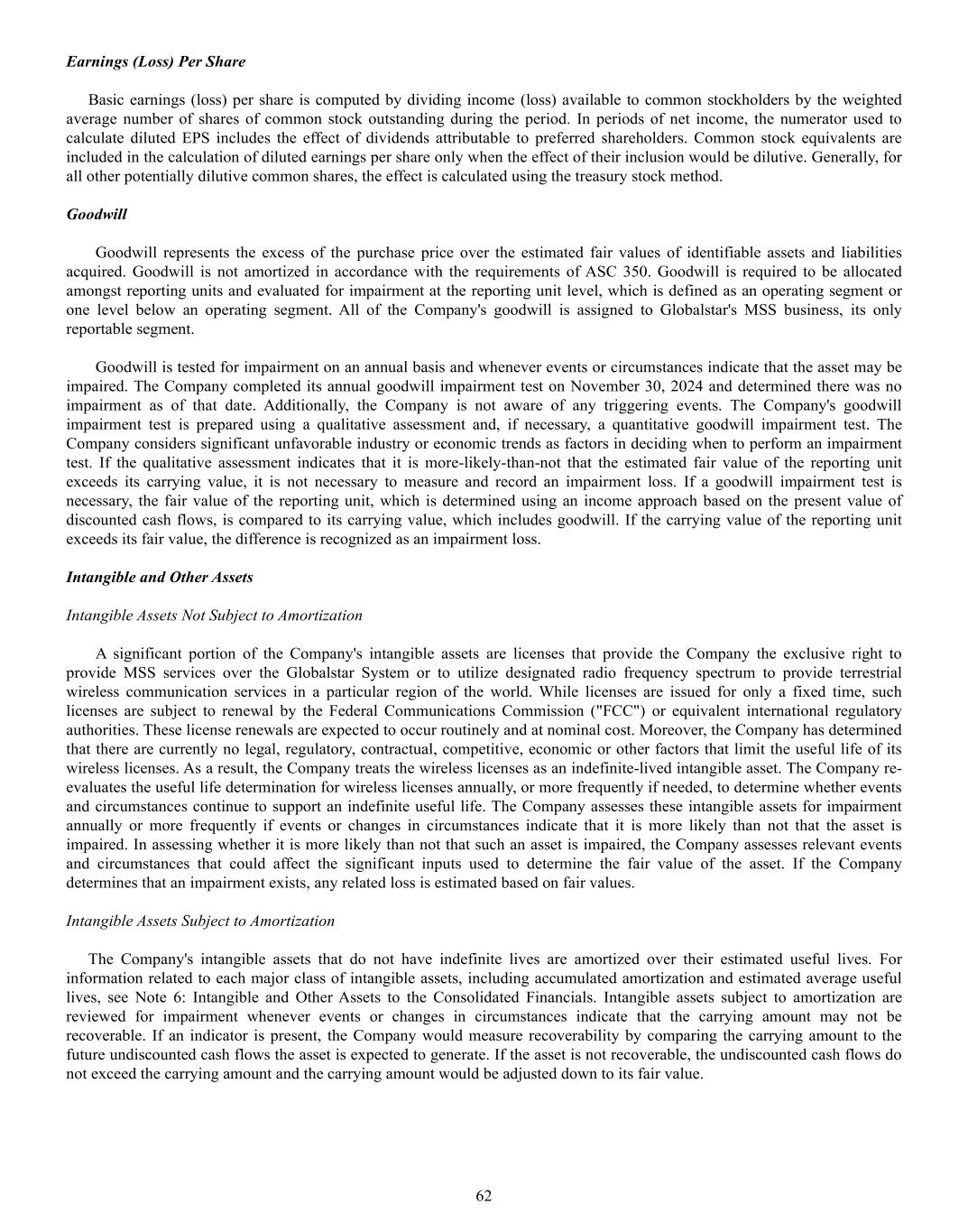
62 Earnings (Loss) Per Share Basic earnings (loss) per share is computed by dividing income (loss) available to common stockholders by the weighted average number of shares of common stock outstanding during the period. In periods of net income, the numerator used to calculate diluted EPS includes the effect of dividends attributable to preferred shareholders. Common stock equivalents are included in the calculation of diluted earnings per share only when the effect of their inclusion would be dilutive. Generally, for all other potentially dilutive common shares, the effect is calculated using the treasury stock method. Goodwill Goodwill represents the excess of the purchase price over the estimated fair values of identifiable assets and liabilities acquired. Goodwill is not amortized in accordance with the requirements of ASC 350. Goodwill is required to be allocated amongst reporting units and evaluated for impairment at the reporting unit level, which is defined as an operating segment or one level below an operating segment. All of the Company's goodwill is assigned to Globalstar's MSS business, its only reportable segment. Goodwill is tested for impairment on an annual basis and whenever events or circumstances indicate that the asset may be impaired. The Company completed its annual goodwill impairment test on November 30, 2024 and determined there was no impairment as of that date. Additionally, the Company is not aware of any triggering events. The Company's goodwill impairment test is prepared using a qualitative assessment and, if necessary, a quantitative goodwill impairment test. The Company considers significant unfavorable industry or economic trends as factors in deciding when to perform an impairment test. If the qualitative assessment indicates that it is more-likely-than-not that the estimated fair value of the reporting unit exceeds its carrying value, it is not necessary to measure and record an impairment loss. If a goodwill impairment test is necessary, the fair value of the reporting unit, which is determined using an income approach based on the present value of discounted cash flows, is compared to its carrying value, which includes goodwill. If the carrying value of the reporting unit exceeds its fair value, the difference is recognized as an impairment loss. Intangible and Other Assets Intangible Assets Not Subject to Amortization A significant portion of the Company's intangible assets are licenses that provide the Company the exclusive right to provide MSS services over the Globalstar System or to utilize designated radio frequency spectrum to provide terrestrial wireless communication services in a particular region of the world. While licenses are issued for only a fixed time, such licenses are subject to renewal by the Federal Communications Commission ("FCC") or equivalent international regulatory authorities. These license renewals are expected to occur routinely and at nominal cost. Moreover, the Company has determined that there are currently no legal, regulatory, contractual, competitive, economic or other factors that limit the useful life of its wireless licenses. As a result, the Company treats the wireless licenses as an indefinite-lived intangible asset. The Company re- evaluates the useful life determination for wireless licenses annually, or more frequently if needed, to determine whether events and circumstances continue to support an indefinite useful life. The Company assesses these intangible assets for impairment annually or more frequently if events or changes in circumstances indicate that it is more likely than not that the asset is impaired. In assessing whether it is more likely than not that such an asset is impaired, the Company assesses relevant events and circumstances that could affect the significant inputs used to determine the fair value of the asset. If the Company determines that an impairment exists, any related loss is estimated based on fair values. Intangible Assets Subject to Amortization The Company's intangible assets that do not have indefinite lives are amortized over their estimated useful lives. For information related to each major class of intangible assets, including accumulated amortization and estimated average useful lives, see Note 6: Intangible and Other Assets to the Consolidated Financials. Intangible assets subject to amortization are reviewed for impairment whenever events or changes in circumstances indicate that the carrying amount may not be recoverable. If an indicator is present, the Company would measure recoverability by comparing the carrying amount to the future undiscounted cash flows the asset is expected to generate. If the asset is not recoverable, the undiscounted cash flows do not exceed the carrying amount and the carrying amount would be adjusted down to its fair value.

63 Assets Recognized from the Costs to Obtain and Fulfill Contracts The Company capitalizes incremental costs to obtain and/or fulfill a contract to the extent it expects to recover them. For subscriber-driven contracts, these capitalized contract acquisition costs primarily include deferred subscriber acquisition costs and are amortized consistently with the pattern of transfer of the good or delivery of the service to which the asset relates. For wholesale capacity services, the Company capitalizes certain costs incurred by the Company prior to the customer benefiting from the service. If a contract terminates prior to the end of its expected life, the remaining capitalized contract costs associated with it becomes impaired and the amount is expensed. For subscriber-driven revenue, total contract acquisition costs were $0.9 million and $1.2 million as of December 31, 2024 and 2023, respectively, and are recorded in "Intangible and other assets" on the Company's consolidated balance sheet. These costs are amortized to marketing, general and administrative expenses over the estimated completion of the contract term, which is three years and considers anticipated contract renewals. For the years ended December 31, 2024, 2023 and 2022, the amount of amortization related to contract acquisition costs was $0.6 million, $0.7 million and $1.2 million, respectively. For wholesale capacity services, total costs to fulfill the customer contract associated with the Updated Services Agreements were $5.3 million and $5.7 million as of December 31, 2024 and 2023, respectively, and are recorded in "Intangible and other assets" on the Company's consolidated balance sheet. These costs are amortized to cost of services and marketing, general and administrative expenses over the estimated completion of the contract term, consistent with the period in which the customer benefits from the services provided. For the years ended December 31, 2024, 2023 and 2022, the amount of amortization related to costs to fulfill a contract was $0.3 million, $0.4 million and $0.1 million, respectively. Advertising Expenses Advertising costs were $3.0 million, $2.8 million and $2.0 million for 2024, 2023, and 2022, respectively. These costs are expensed as incurred as marketing, general and administrative expenses. Recently Issued Accounting Pronouncements In December 2023, the Financial Accounting Standards Board (“FASB”) issued Accounting Standards Update ("ASU") 2023-09, Income Taxes (Topic 740): Improvements to Income Tax Disclosures, which updates qualitative and quantitative disclosures for the rate reconciliation and income taxes paid. The amendments in ASU 2023-09 are effective for fiscal years beginning after December 15, 2024, with early adoption permitted. The amendments should be applied prospectively; however, retrospective application is also permitted. The Company adopted this standard when it became effective on January 1, 2025. The Company is evaluating the impact this ASU may have on its financial statement disclosures. In November 2024, the FASB issued ASU 2024-03, Income Statement — Reporting Comprehensive Income — Expense Disaggregation Disclosures. This ASU requires public business entities to disclose, on an annual and interim basis, disaggregated information about certain income statement expense line items. The amendments should be applied prospectively; however, retrospective application is also permitted. The Company plans to adopt this standard when it becomes effective on January 1, 2027. The Company is evaluating the impact this ASU may have on its financial statement disclosures. Recently Adopted Accounting Pronouncements In November 2023, the FASB issued ASU 2023-07, Segment Reporting (Topic 280): Improvements to Reportable Segment Disclosures, which provides updates to qualitative and quantitative reportable segment disclosure requirements, including enhanced disclosures about significant segment expenses and increased interim disclosure requirements, among others. This ASU also explicitly requires public entities with a single reportable segment to provide all segment disclosures under ASC 280, including the new disclosures in this ASU. The amendments in ASU 2023-07 are effective for fiscal years beginning after December 15, 2023, and interim periods within fiscal years beginning after December 15, 2024. The Company adopted this ASU for its fiscal year end December 31, 2024 disclosures. For further discussion, refer to Note 16: Segment Reporting. 2. SPECIAL PURPOSE ENTITY The Company is the operator for certain satellite-enabled services (the "Services") offered by Apple Inc. (the "Customer") pursuant to a service agreement (the “Service Agreement”) and certain related ancillary agreements (such agreements, together with the Service Agreement, the “Service Agreements”) for the Phase 1 Service Period and Phase 2 Service Period (as defined below). The Service Agreements generally require Globalstar to allocate network capacity to support the Services, which launched in November 2022.
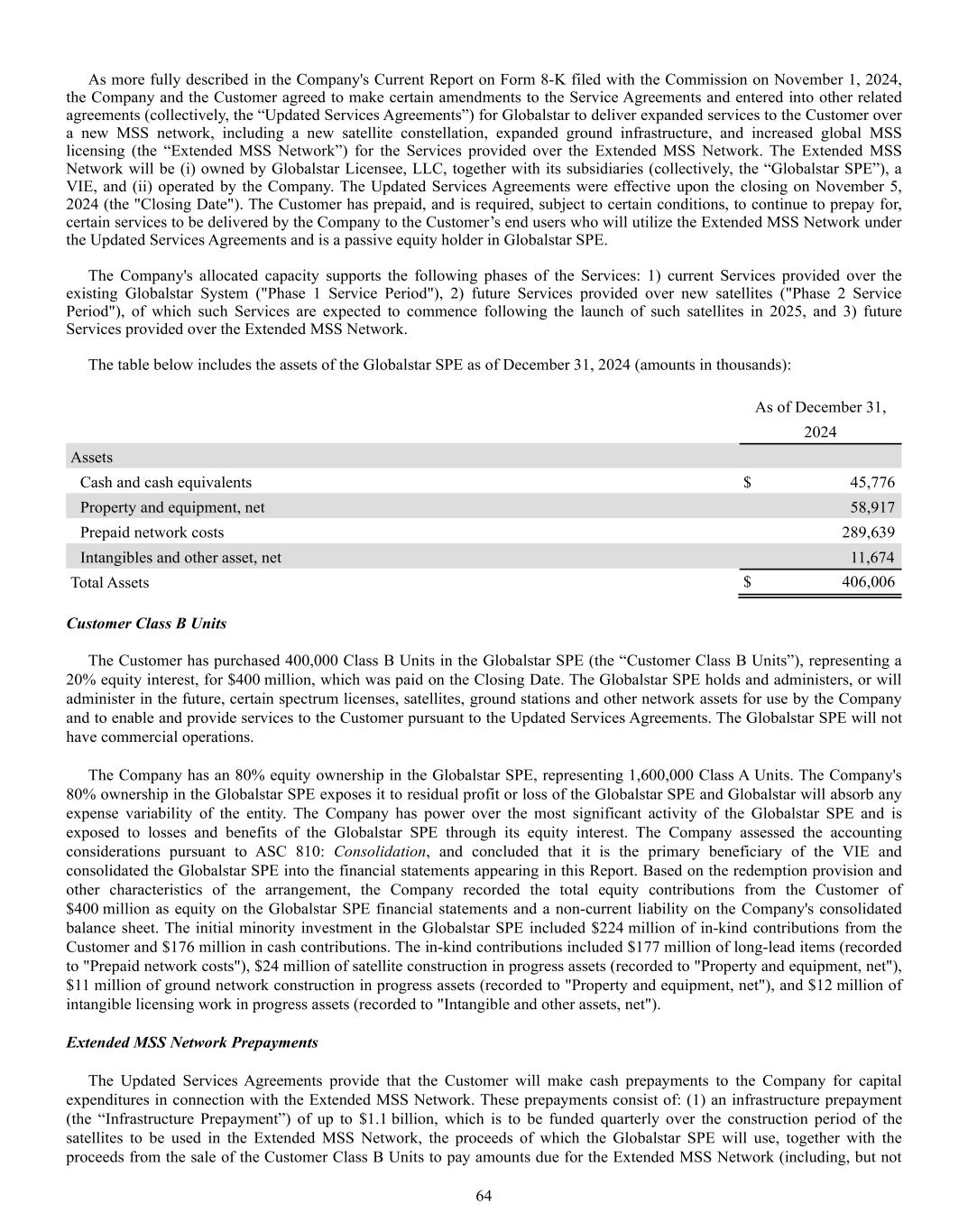
64 As more fully described in the Company's Current Report on Form 8-K filed with the Commission on November 1, 2024, the Company and the Customer agreed to make certain amendments to the Service Agreements and entered into other related agreements (collectively, the “Updated Services Agreements”) for Globalstar to deliver expanded services to the Customer over a new MSS network, including a new satellite constellation, expanded ground infrastructure, and increased global MSS licensing (the “Extended MSS Network”) for the Services provided over the Extended MSS Network. The Extended MSS Network will be (i) owned by Globalstar Licensee, LLC, together with its subsidiaries (collectively, the “Globalstar SPE”), a VIE, and (ii) operated by the Company. The Updated Services Agreements were effective upon the closing on November 5, 2024 (the "Closing Date"). The Customer has prepaid, and is required, subject to certain conditions, to continue to prepay for, certain services to be delivered by the Company to the Customer’s end users who will utilize the Extended MSS Network under the Updated Services Agreements and is a passive equity holder in Globalstar SPE. The Company's allocated capacity supports the following phases of the Services: 1) current Services provided over the existing Globalstar System ("Phase 1 Service Period"), 2) future Services provided over new satellites ("Phase 2 Service Period"), of which such Services are expected to commence following the launch of such satellites in 2025, and 3) future Services provided over the Extended MSS Network. The table below includes the assets of the Globalstar SPE as of December 31, 2024 (amounts in thousands): As of December 31, 2024 Assets Cash and cash equivalents $ 45,776 Property and equipment, net 58,917 Prepaid network costs 289,639 Intangibles and other asset, net 11,674 Total Assets $ 406,006 Customer Class B Units The Customer has purchased 400,000 Class B Units in the Globalstar SPE (the “Customer Class B Units”), representing a 20% equity interest, for $400 million, which was paid on the Closing Date. The Globalstar SPE holds and administers, or will administer in the future, certain spectrum licenses, satellites, ground stations and other network assets for use by the Company and to enable and provide services to the Customer pursuant to the Updated Services Agreements. The Globalstar SPE will not have commercial operations. The Company has an 80% equity ownership in the Globalstar SPE, representing 1,600,000 Class A Units. The Company's 80% ownership in the Globalstar SPE exposes it to residual profit or loss of the Globalstar SPE and Globalstar will absorb any expense variability of the entity. The Company has power over the most significant activity of the Globalstar SPE and is exposed to losses and benefits of the Globalstar SPE through its equity interest. The Company assessed the accounting considerations pursuant to ASC 810: Consolidation, and concluded that it is the primary beneficiary of the VIE and consolidated the Globalstar SPE into the financial statements appearing in this Report. Based on the redemption provision and other characteristics of the arrangement, the Company recorded the total equity contributions from the Customer of $400 million as equity on the Globalstar SPE financial statements and a non-current liability on the Company's consolidated balance sheet. The initial minority investment in the Globalstar SPE included $224 million of in-kind contributions from the Customer and $176 million in cash contributions. The in-kind contributions included $177 million of long-lead items (recorded to "Prepaid network costs"), $24 million of satellite construction in progress assets (recorded to "Property and equipment, net"), $11 million of ground network construction in progress assets (recorded to "Property and equipment, net"), and $12 million of intangible licensing work in progress assets (recorded to "Intangible and other assets, net"). Extended MSS Network Prepayments The Updated Services Agreements provide that the Customer will make cash prepayments to the Company for capital expenditures in connection with the Extended MSS Network. These prepayments consist of: (1) an infrastructure prepayment (the “Infrastructure Prepayment”) of up to $1.1 billion, which is to be funded quarterly over the construction period of the satellites to be used in the Extended MSS Network, the proceeds of which the Globalstar SPE will use, together with the proceeds from the sale of the Customer Class B Units to pay amounts due for the Extended MSS Network (including, but not
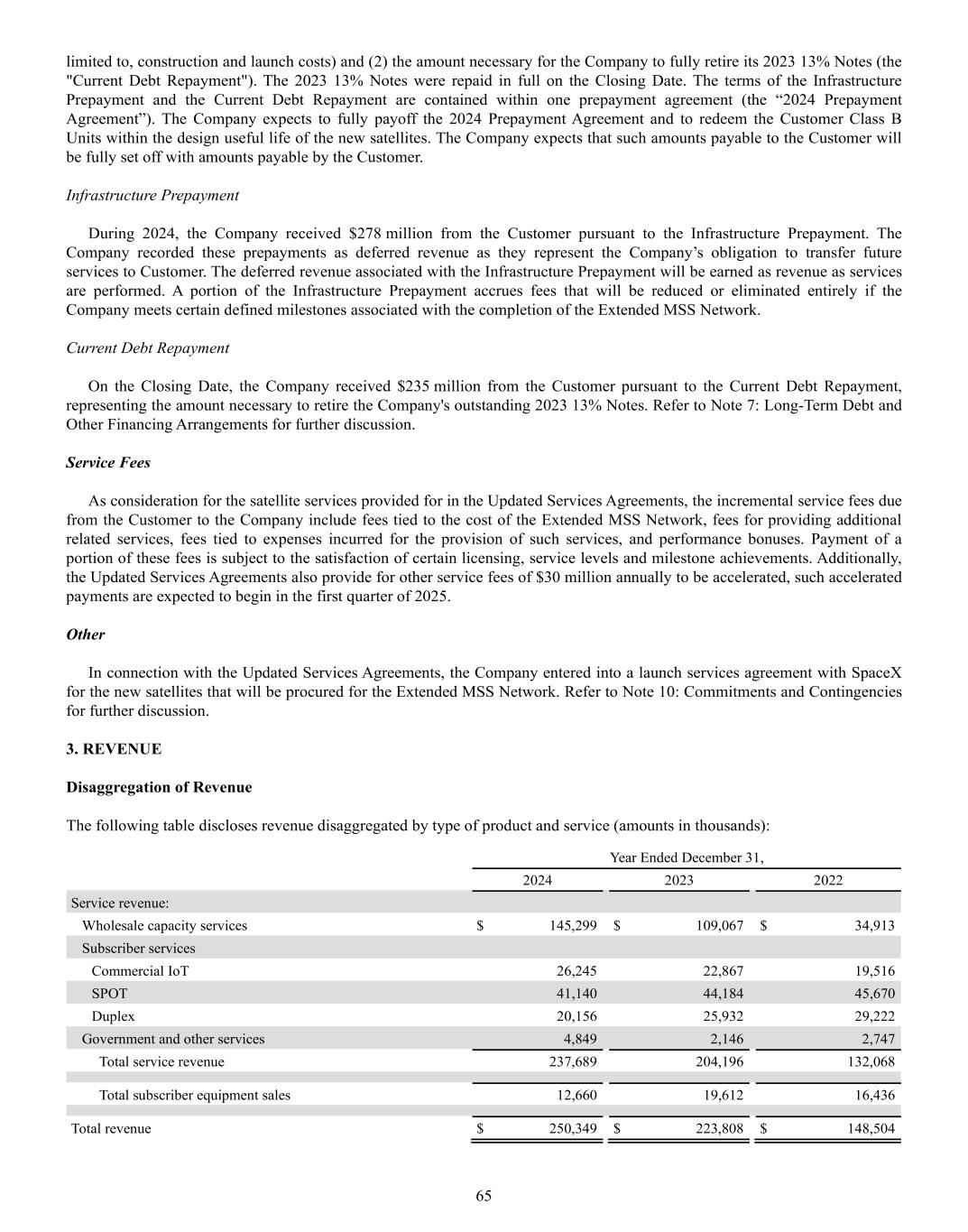
65 limited to, construction and launch costs) and (2) the amount necessary for the Company to fully retire its 2023 13% Notes (the "Current Debt Repayment"). The 2023 13% Notes were repaid in full on the Closing Date. The terms of the Infrastructure Prepayment and the Current Debt Repayment are contained within one prepayment agreement (the “2024 Prepayment Agreement”). The Company expects to fully payoff the 2024 Prepayment Agreement and to redeem the Customer Class B Units within the design useful life of the new satellites. The Company expects that such amounts payable to the Customer will be fully set off with amounts payable by the Customer. Infrastructure Prepayment During 2024, the Company received $278 million from the Customer pursuant to the Infrastructure Prepayment. The Company recorded these prepayments as deferred revenue as they represent the Company’s obligation to transfer future services to Customer. The deferred revenue associated with the Infrastructure Prepayment will be earned as revenue as services are performed. A portion of the Infrastructure Prepayment accrues fees that will be reduced or eliminated entirely if the Company meets certain defined milestones associated with the completion of the Extended MSS Network. Current Debt Repayment On the Closing Date, the Company received $235 million from the Customer pursuant to the Current Debt Repayment, representing the amount necessary to retire the Company's outstanding 2023 13% Notes. Refer to Note 7: Long-Term Debt and Other Financing Arrangements for further discussion. Service Fees As consideration for the satellite services provided for in the Updated Services Agreements, the incremental service fees due from the Customer to the Company include fees tied to the cost of the Extended MSS Network, fees for providing additional related services, fees tied to expenses incurred for the provision of such services, and performance bonuses. Payment of a portion of these fees is subject to the satisfaction of certain licensing, service levels and milestone achievements. Additionally, the Updated Services Agreements also provide for other service fees of $30 million annually to be accelerated, such accelerated payments are expected to begin in the first quarter of 2025. Other In connection with the Updated Services Agreements, the Company entered into a launch services agreement with SpaceX for the new satellites that will be procured for the Extended MSS Network. Refer to Note 10: Commitments and Contingencies for further discussion. 3. REVENUE Disaggregation of Revenue The following table discloses revenue disaggregated by type of product and service (amounts in thousands): Year Ended December 31, 2024 2023 2022 Service revenue: Wholesale capacity services $ 145,299 $ 109,067 $ 34,913 Subscriber services Commercial IoT 26,245 22,867 19,516 SPOT 41,140 44,184 45,670 Duplex 20,156 25,932 29,222 Government and other services 4,849 2,146 2,747 Total service revenue 237,689 204,196 132,068 Total subscriber equipment sales 12,660 19,612 16,436 Total revenue $ 250,349 $ 223,808 $ 148,504
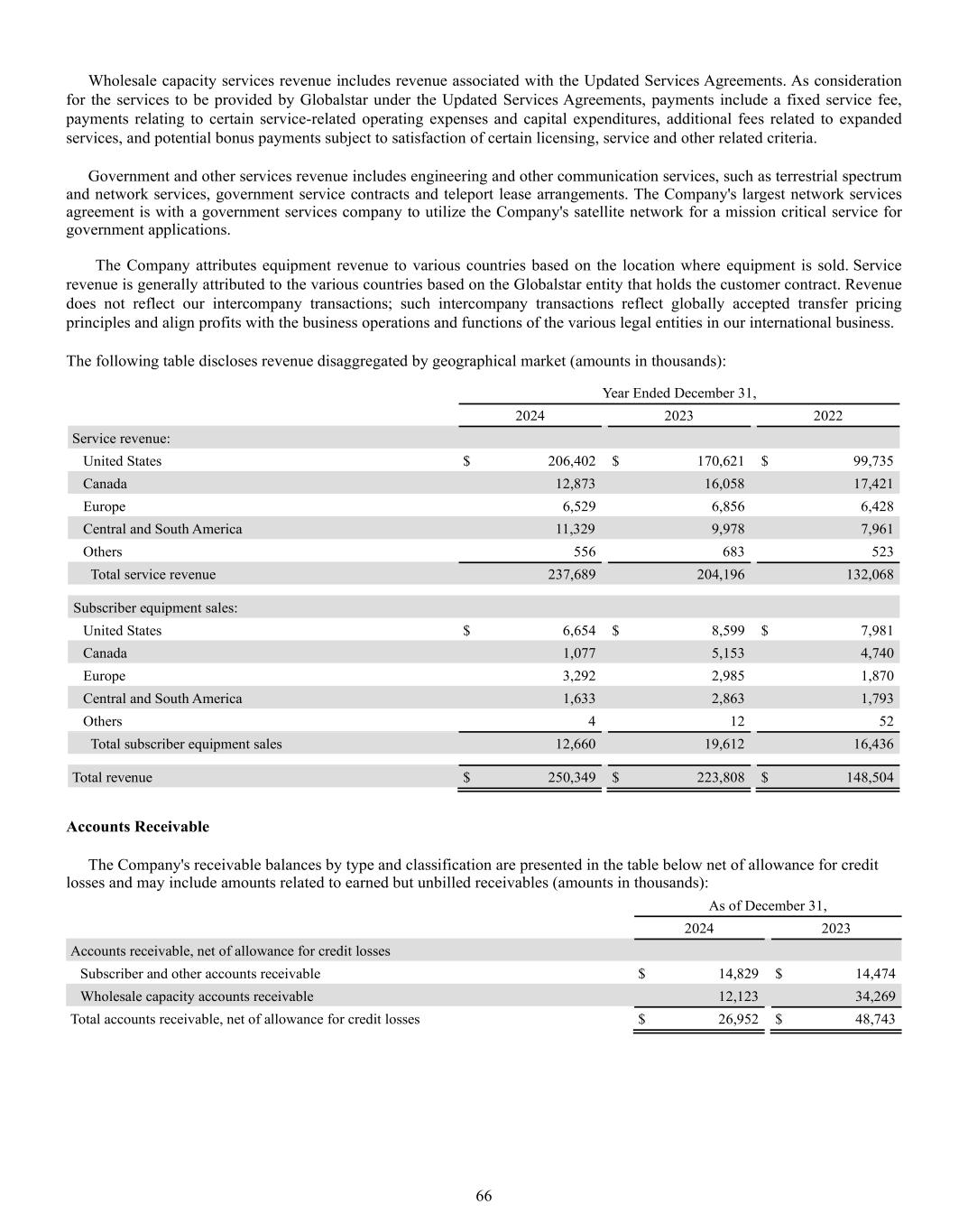
66 Wholesale capacity services revenue includes revenue associated with the Updated Services Agreements. As consideration for the services to be provided by Globalstar under the Updated Services Agreements, payments include a fixed service fee, payments relating to certain service-related operating expenses and capital expenditures, additional fees related to expanded services, and potential bonus payments subject to satisfaction of certain licensing, service and other related criteria. Government and other services revenue includes engineering and other communication services, such as terrestrial spectrum and network services, government service contracts and teleport lease arrangements. The Company's largest network services agreement is with a government services company to utilize the Company's satellite network for a mission critical service for government applications. The Company attributes equipment revenue to various countries based on the location where equipment is sold. Service revenue is generally attributed to the various countries based on the Globalstar entity that holds the customer contract. Revenue does not reflect our intercompany transactions; such intercompany transactions reflect globally accepted transfer pricing principles and align profits with the business operations and functions of the various legal entities in our international business. The following table discloses revenue disaggregated by geographical market (amounts in thousands): Year Ended December 31, 2024 2023 2022 Service revenue: United States $ 206,402 $ 170,621 $ 99,735 Canada 12,873 16,058 17,421 Europe 6,529 6,856 6,428 Central and South America 11,329 9,978 7,961 Others 556 683 523 Total service revenue 237,689 204,196 132,068 Subscriber equipment sales: United States $ 6,654 $ 8,599 $ 7,981 Canada 1,077 5,153 4,740 Europe 3,292 2,985 1,870 Central and South America 1,633 2,863 1,793 Others 4 12 52 Total subscriber equipment sales 12,660 19,612 16,436 Total revenue $ 250,349 $ 223,808 $ 148,504 Accounts Receivable The Company's receivable balances by type and classification are presented in the table below net of allowance for credit losses and may include amounts related to earned but unbilled receivables (amounts in thousands): As of December 31, 2024 2023 Accounts receivable, net of allowance for credit losses Subscriber and other accounts receivable $ 14,829 $ 14,474 Wholesale capacity accounts receivable 12,123 34,269 Total accounts receivable, net of allowance for credit losses $ 26,952 $ 48,743
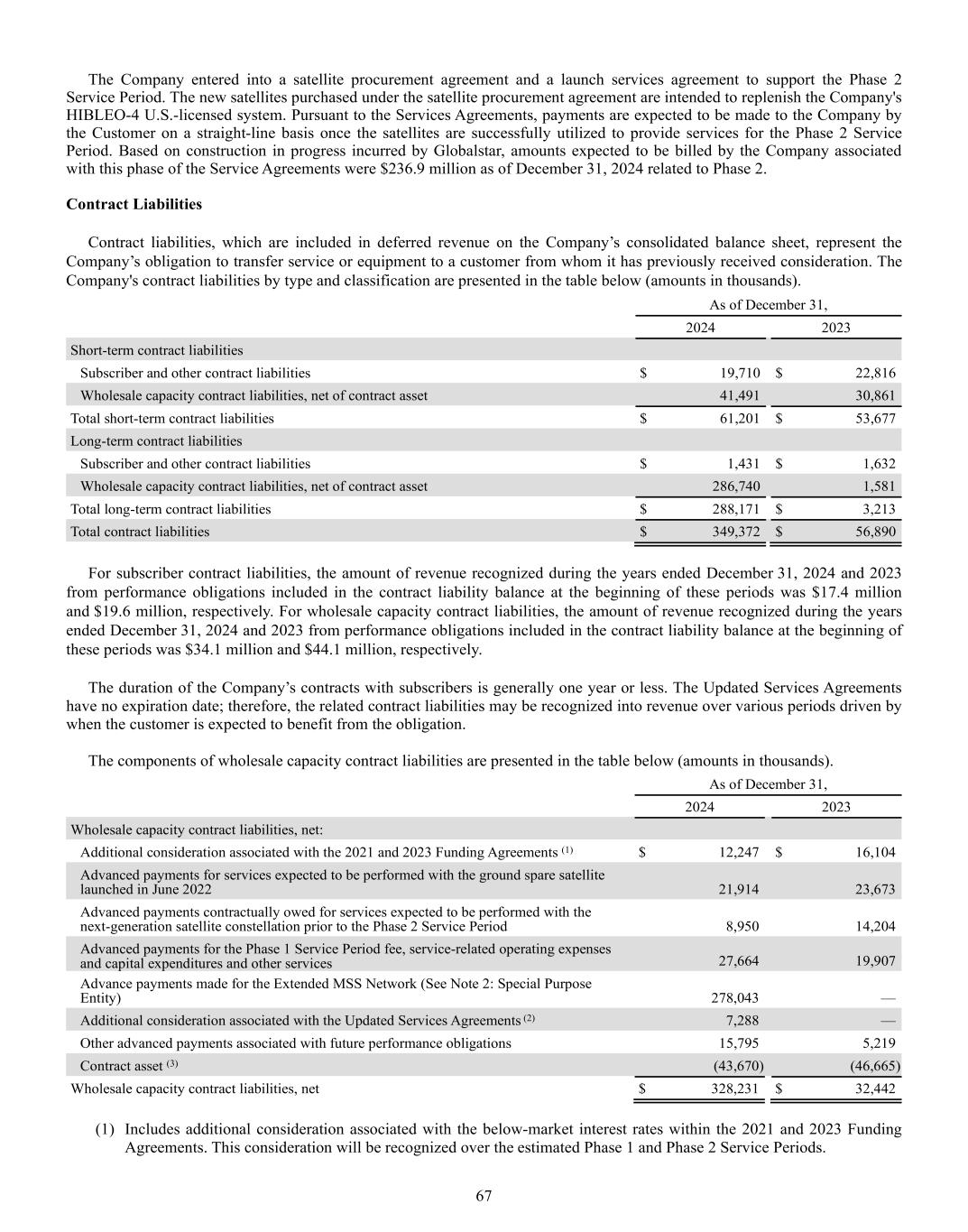
67 The Company entered into a satellite procurement agreement and a launch services agreement to support the Phase 2 Service Period. The new satellites purchased under the satellite procurement agreement are intended to replenish the Company's HIBLEO-4 U.S.-licensed system. Pursuant to the Services Agreements, payments are expected to be made to the Company by the Customer on a straight-line basis once the satellites are successfully utilized to provide services for the Phase 2 Service Period. Based on construction in progress incurred by Globalstar, amounts expected to be billed by the Company associated with this phase of the Service Agreements were $236.9 million as of December 31, 2024 related to Phase 2. Contract Liabilities Contract liabilities, which are included in deferred revenue on the Company’s consolidated balance sheet, represent the Company’s obligation to transfer service or equipment to a customer from whom it has previously received consideration. The Company's contract liabilities by type and classification are presented in the table below (amounts in thousands). As of December 31, 2024 2023 Short-term contract liabilities Subscriber and other contract liabilities $ 19,710 $ 22,816 Wholesale capacity contract liabilities, net of contract asset 41,491 30,861 Total short-term contract liabilities $ 61,201 $ 53,677 Long-term contract liabilities Subscriber and other contract liabilities $ 1,431 $ 1,632 Wholesale capacity contract liabilities, net of contract asset 286,740 1,581 Total long-term contract liabilities $ 288,171 $ 3,213 Total contract liabilities $ 349,372 $ 56,890 For subscriber contract liabilities, the amount of revenue recognized during the years ended December 31, 2024 and 2023 from performance obligations included in the contract liability balance at the beginning of these periods was $17.4 million and $19.6 million, respectively. For wholesale capacity contract liabilities, the amount of revenue recognized during the years ended December 31, 2024 and 2023 from performance obligations included in the contract liability balance at the beginning of these periods was $34.1 million and $44.1 million, respectively. The duration of the Company’s contracts with subscribers is generally one year or less. The Updated Services Agreements have no expiration date; therefore, the related contract liabilities may be recognized into revenue over various periods driven by when the customer is expected to benefit from the obligation. The components of wholesale capacity contract liabilities are presented in the table below (amounts in thousands). As of December 31, 2024 2023 Wholesale capacity contract liabilities, net: Additional consideration associated with the 2021 and 2023 Funding Agreements (1) $ 12,247 $ 16,104 Advanced payments for services expected to be performed with the ground spare satellite launched in June 2022 21,914 23,673 Advanced payments contractually owed for services expected to be performed with the next-generation satellite constellation prior to the Phase 2 Service Period 8,950 14,204 Advanced payments for the Phase 1 Service Period fee, service-related operating expenses and capital expenditures and other services 27,664 19,907 Advance payments made for the Extended MSS Network (See Note 2: Special Purpose Entity) 278,043 — Additional consideration associated with the Updated Services Agreements (2) 7,288 — Other advanced payments associated with future performance obligations 15,795 5,219 Contract asset (3) (43,670) (46,665) Wholesale capacity contract liabilities, net $ 328,231 $ 32,442 (1) Includes additional consideration associated with the below-market interest rates within the 2021 and 2023 Funding Agreements. This consideration will be recognized over the estimated Phase 1 and Phase 2 Service Periods.
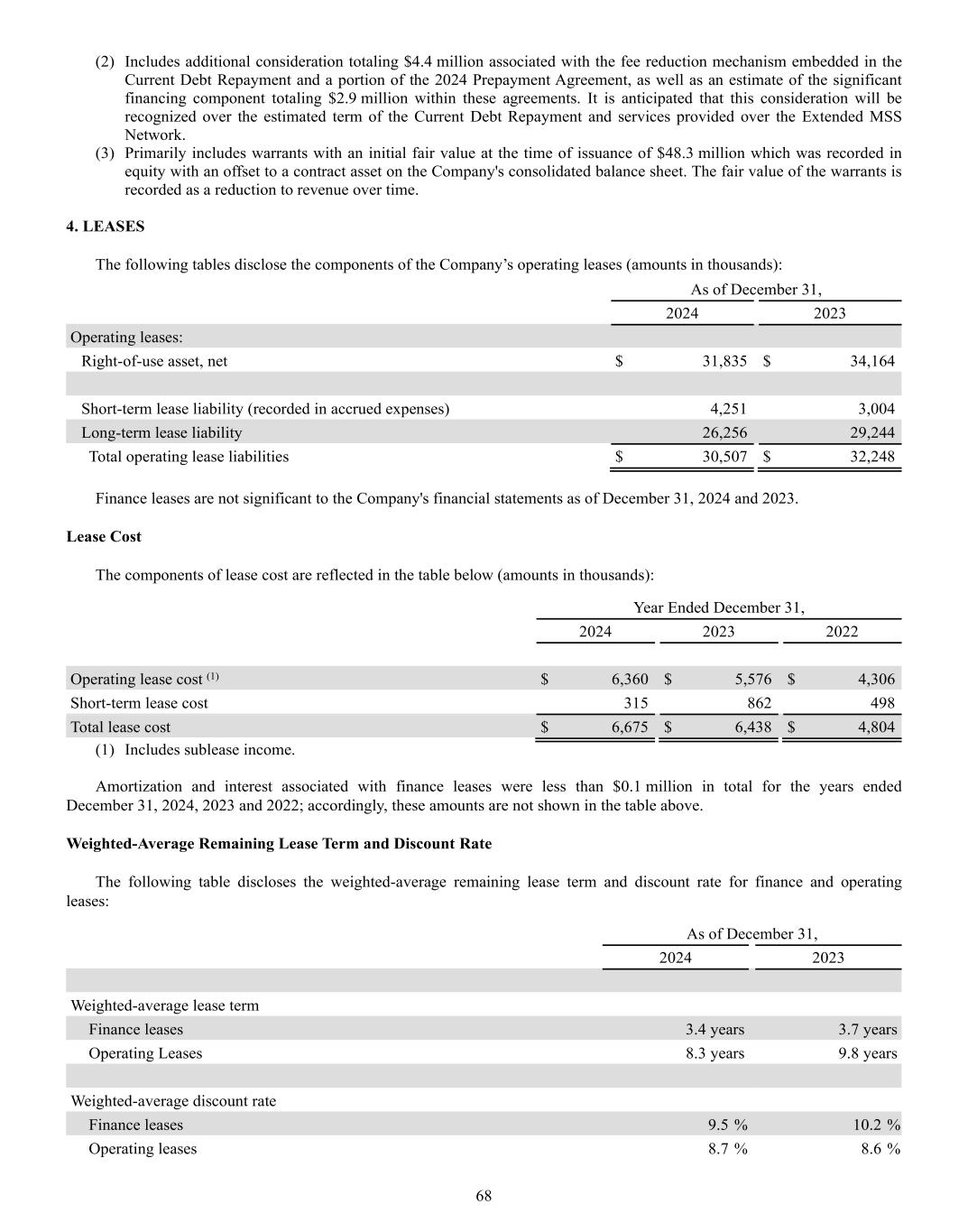
68 (2) Includes additional consideration totaling $4.4 million associated with the fee reduction mechanism embedded in the Current Debt Repayment and a portion of the 2024 Prepayment Agreement, as well as an estimate of the significant financing component totaling $2.9 million within these agreements. It is anticipated that this consideration will be recognized over the estimated term of the Current Debt Repayment and services provided over the Extended MSS Network. (3) Primarily includes warrants with an initial fair value at the time of issuance of $48.3 million which was recorded in equity with an offset to a contract asset on the Company's consolidated balance sheet. The fair value of the warrants is recorded as a reduction to revenue over time. 4. LEASES The following tables disclose the components of the Company’s operating leases (amounts in thousands): As of December 31, 2024 2023 Operating leases: Right-of-use asset, net $ 31,835 $ 34,164 Short-term lease liability (recorded in accrued expenses) 4,251 3,004 Long-term lease liability 26,256 29,244 Total operating lease liabilities $ 30,507 $ 32,248 Finance leases are not significant to the Company's financial statements as of December 31, 2024 and 2023. Lease Cost The components of lease cost are reflected in the table below (amounts in thousands): Year Ended December 31, 2024 2023 2022 Operating lease cost (1) $ 6,360 $ 5,576 $ 4,306 Short-term lease cost 315 862 498 Total lease cost $ 6,675 $ 6,438 $ 4,804 (1) Includes sublease income. Amortization and interest associated with finance leases were less than $0.1 million in total for the years ended December 31, 2024, 2023 and 2022; accordingly, these amounts are not shown in the table above. Weighted-Average Remaining Lease Term and Discount Rate The following table discloses the weighted-average remaining lease term and discount rate for finance and operating leases: As of December 31, 2024 2023 Weighted-average lease term Finance leases 3.4 years 3.7 years Operating Leases 8.3 years 9.8 years Weighted-average discount rate Finance leases 9.5 % 10.2 % Operating leases 8.7 % 8.6 %
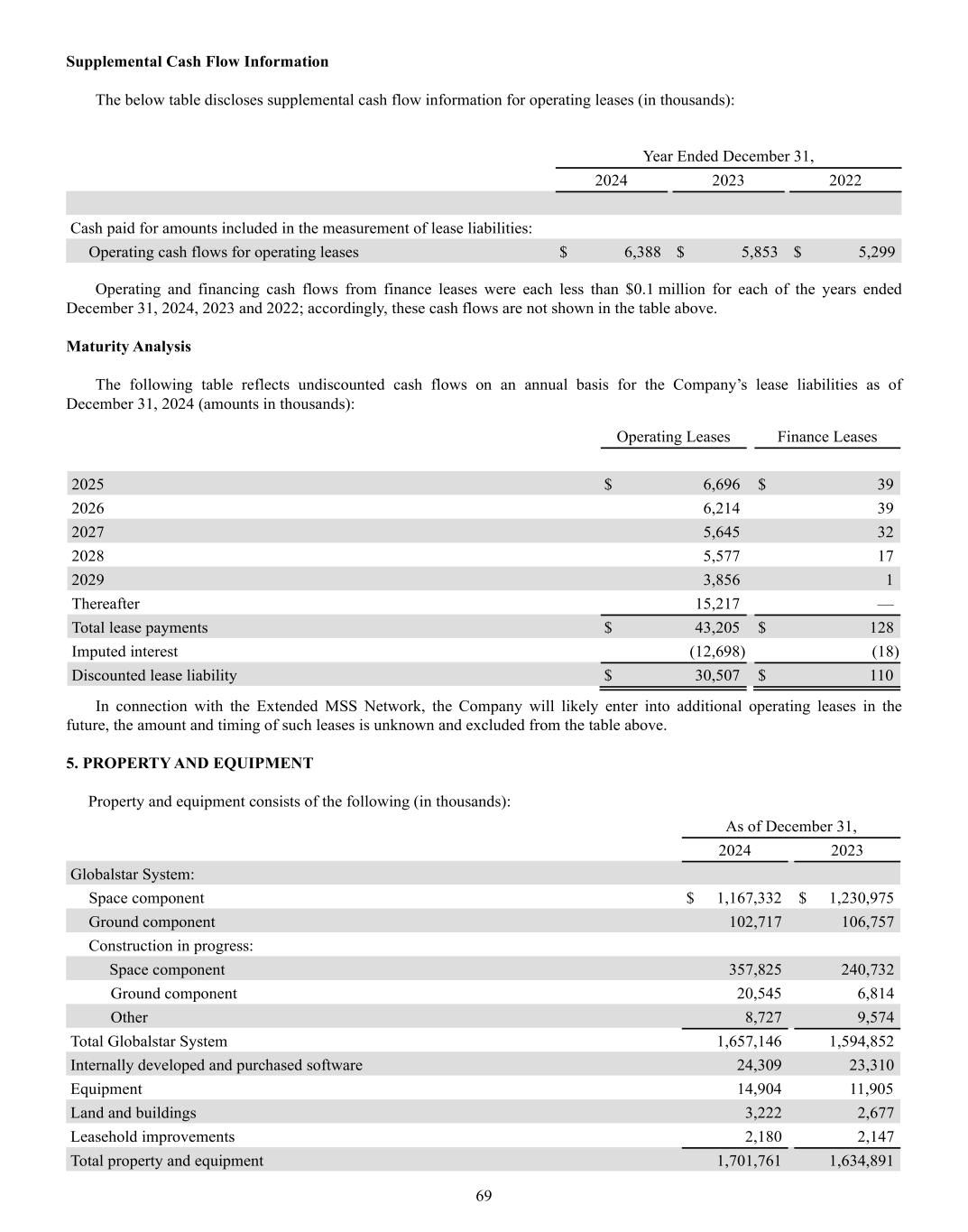
69 Supplemental Cash Flow Information The below table discloses supplemental cash flow information for operating leases (in thousands): Year Ended December 31, 2024 2023 2022 Cash paid for amounts included in the measurement of lease liabilities: Operating cash flows for operating leases $ 6,388 $ 5,853 $ 5,299 Operating and financing cash flows from finance leases were each less than $0.1 million for each of the years ended December 31, 2024, 2023 and 2022; accordingly, these cash flows are not shown in the table above. Maturity Analysis The following table reflects undiscounted cash flows on an annual basis for the Company’s lease liabilities as of December 31, 2024 (amounts in thousands): Operating Leases Finance Leases 2025 $ 6,696 $ 39 2026 6,214 39 2027 5,645 32 2028 5,577 17 2029 3,856 1 Thereafter 15,217 — Total lease payments $ 43,205 $ 128 Imputed interest (12,698) (18) Discounted lease liability $ 30,507 $ 110 In connection with the Extended MSS Network, the Company will likely enter into additional operating leases in the future, the amount and timing of such leases is unknown and excluded from the table above. 5. PROPERTY AND EQUIPMENT Property and equipment consists of the following (in thousands): As of December 31, 2024 2023 Globalstar System: Space component $ 1,167,332 $ 1,230,975 Ground component 102,717 106,757 Construction in progress: Space component 357,825 240,732 Ground component 20,545 6,814 Other 8,727 9,574 Total Globalstar System 1,657,146 1,594,852 Internally developed and purchased software 24,309 23,310 Equipment 14,904 11,905 Land and buildings 3,222 2,677 Leasehold improvements 2,180 2,147 Total property and equipment 1,701,761 1,634,891
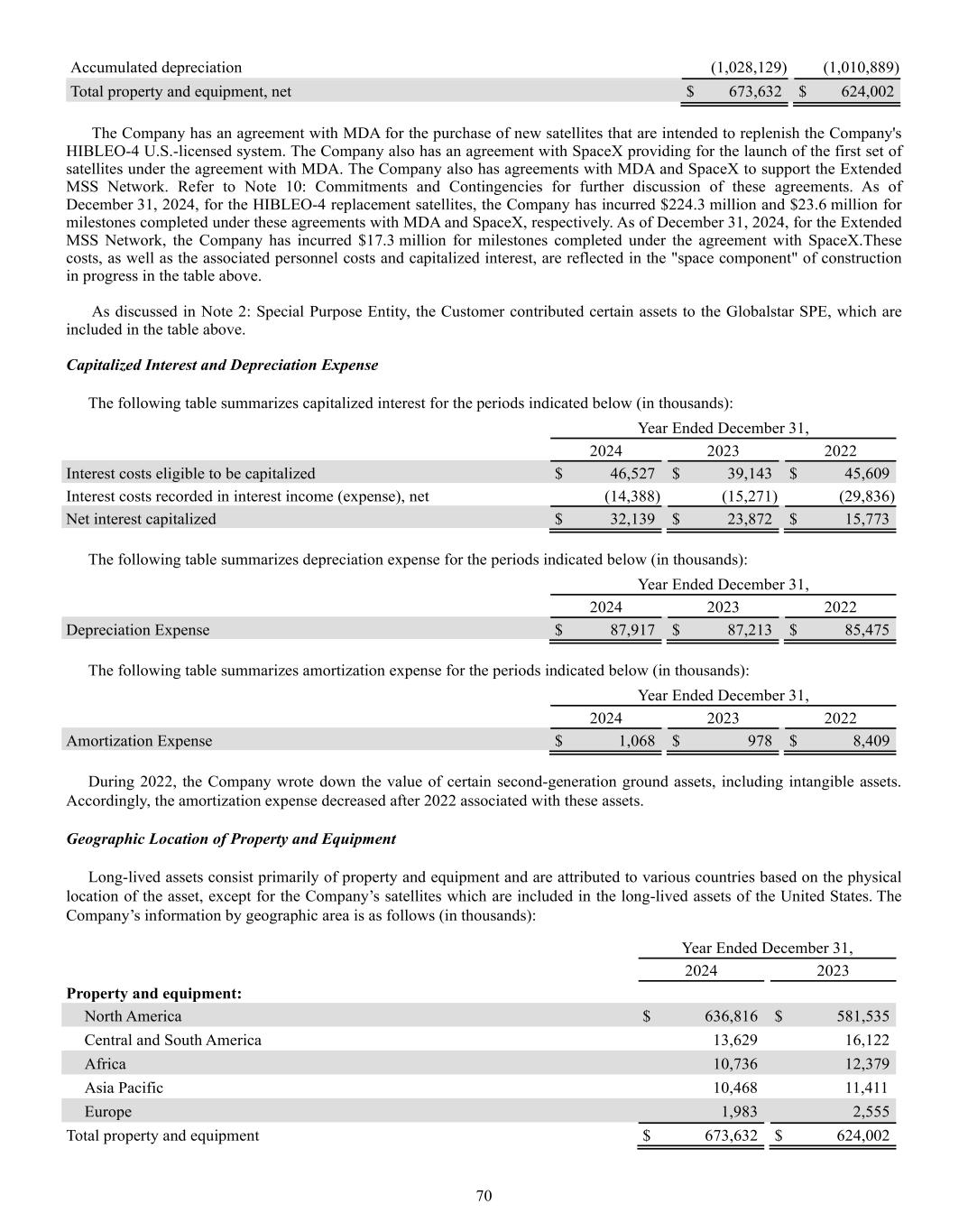
70 Accumulated depreciation (1,028,129) (1,010,889) Total property and equipment, net $ 673,632 $ 624,002 The Company has an agreement with MDA for the purchase of new satellites that are intended to replenish the Company's HIBLEO-4 U.S.-licensed system. The Company also has an agreement with SpaceX providing for the launch of the first set of satellites under the agreement with MDA. The Company also has agreements with MDA and SpaceX to support the Extended MSS Network. Refer to Note 10: Commitments and Contingencies for further discussion of these agreements. As of December 31, 2024, for the HIBLEO-4 replacement satellites, the Company has incurred $224.3 million and $23.6 million for milestones completed under these agreements with MDA and SpaceX, respectively. As of December 31, 2024, for the Extended MSS Network, the Company has incurred $17.3 million for milestones completed under the agreement with SpaceX.These costs, as well as the associated personnel costs and capitalized interest, are reflected in the "space component" of construction in progress in the table above. As discussed in Note 2: Special Purpose Entity, the Customer contributed certain assets to the Globalstar SPE, which are included in the table above. Capitalized Interest and Depreciation Expense The following table summarizes capitalized interest for the periods indicated below (in thousands): Year Ended December 31, 2024 2023 2022 Interest costs eligible to be capitalized $ 46,527 $ 39,143 $ 45,609 Interest costs recorded in interest income (expense), net (14,388) (15,271) (29,836) Net interest capitalized $ 32,139 $ 23,872 $ 15,773 The following table summarizes depreciation expense for the periods indicated below (in thousands): Year Ended December 31, 2024 2023 2022 Depreciation Expense $ 87,917 $ 87,213 $ 85,475 The following table summarizes amortization expense for the periods indicated below (in thousands): Year Ended December 31, 2024 2023 2022 Amortization Expense $ 1,068 $ 978 $ 8,409 During 2022, the Company wrote down the value of certain second-generation ground assets, including intangible assets. Accordingly, the amortization expense decreased after 2022 associated with these assets. Geographic Location of Property and Equipment Long-lived assets consist primarily of property and equipment and are attributed to various countries based on the physical location of the asset, except for the Company’s satellites which are included in the long-lived assets of the United States. The Company’s information by geographic area is as follows (in thousands): Year Ended December 31, 2024 2023 Property and equipment: North America $ 636,816 $ 581,535 Central and South America 13,629 16,122 Africa 10,736 12,379 Asia Pacific 10,468 11,411 Europe 1,983 2,555 Total property and equipment $ 673,632 $ 624,002
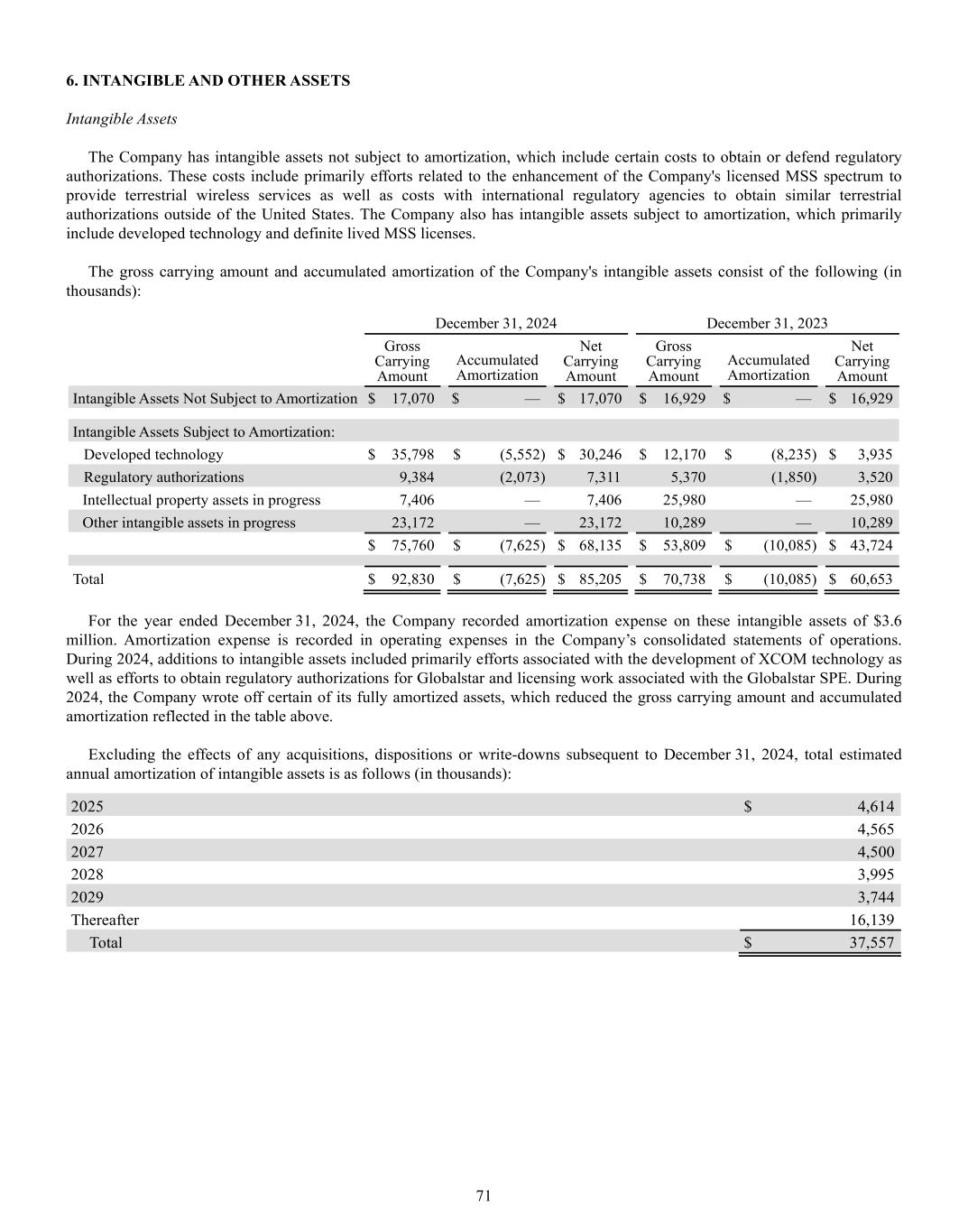
71 6. INTANGIBLE AND OTHER ASSETS Intangible Assets The Company has intangible assets not subject to amortization, which include certain costs to obtain or defend regulatory authorizations. These costs include primarily efforts related to the enhancement of the Company's licensed MSS spectrum to provide terrestrial wireless services as well as costs with international regulatory agencies to obtain similar terrestrial authorizations outside of the United States. The Company also has intangible assets subject to amortization, which primarily include developed technology and definite lived MSS licenses. The gross carrying amount and accumulated amortization of the Company's intangible assets consist of the following (in thousands): December 31, 2024 December 31, 2023 Gross Carrying Amount Accumulated Amortization Net Carrying Amount Gross Carrying Amount Accumulated Amortization Net Carrying Amount Intangible Assets Not Subject to Amortization $ 17,070 $ — $ 17,070 $ 16,929 $ — $ 16,929 Intangible Assets Subject to Amortization: Developed technology $ 35,798 $ (5,552) $ 30,246 $ 12,170 $ (8,235) $ 3,935 Regulatory authorizations 9,384 (2,073) 7,311 5,370 (1,850) 3,520 Intellectual property assets in progress 7,406 — 7,406 25,980 — 25,980 Other intangible assets in progress 23,172 — 23,172 10,289 — 10,289 $ 75,760 $ (7,625) $ 68,135 $ 53,809 $ (10,085) $ 43,724 Total $ 92,830 $ (7,625) $ 85,205 $ 70,738 $ (10,085) $ 60,653 For the year ended December 31, 2024, the Company recorded amortization expense on these intangible assets of $3.6 million. Amortization expense is recorded in operating expenses in the Company’s consolidated statements of operations. During 2024, additions to intangible assets included primarily efforts associated with the development of XCOM technology as well as efforts to obtain regulatory authorizations for Globalstar and licensing work associated with the Globalstar SPE. During 2024, the Company wrote off certain of its fully amortized assets, which reduced the gross carrying amount and accumulated amortization reflected in the table above. Excluding the effects of any acquisitions, dispositions or write-downs subsequent to December 31, 2024, total estimated annual amortization of intangible assets is as follows (in thousands): 2025 $ 4,614 2026 4,565 2027 4,500 2028 3,995 2029 3,744 Thereafter 16,139 Total $ 37,557
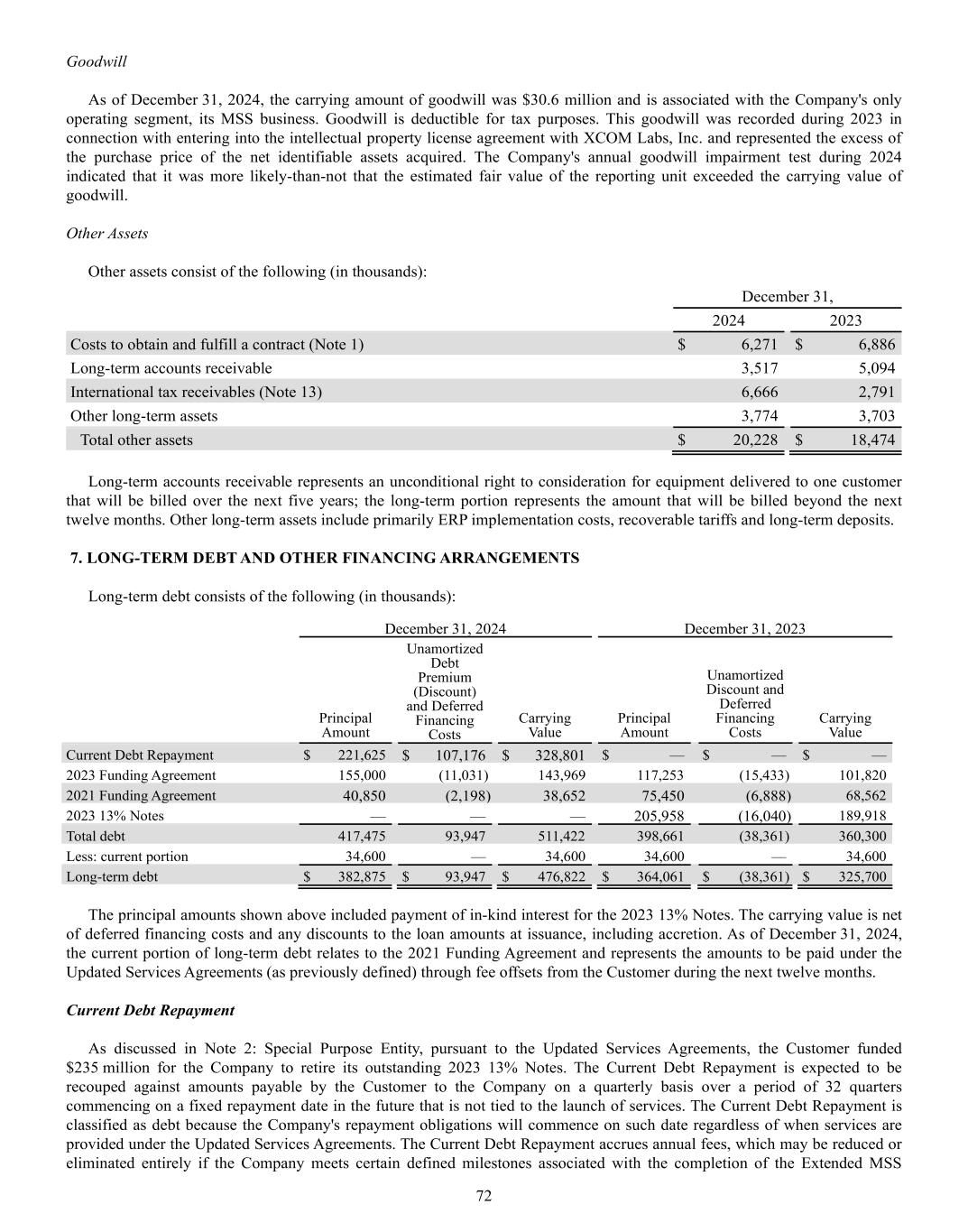
72 Goodwill As of December 31, 2024, the carrying amount of goodwill was $30.6 million and is associated with the Company's only operating segment, its MSS business. Goodwill is deductible for tax purposes. This goodwill was recorded during 2023 in connection with entering into the intellectual property license agreement with XCOM Labs, Inc. and represented the excess of the purchase price of the net identifiable assets acquired. The Company's annual goodwill impairment test during 2024 indicated that it was more likely-than-not that the estimated fair value of the reporting unit exceeded the carrying value of goodwill. Other Assets Other assets consist of the following (in thousands): December 31, 2024 2023 Costs to obtain and fulfill a contract (Note 1) $ 6,271 $ 6,886 Long-term accounts receivable 3,517 5,094 International tax receivables (Note 13) 6,666 2,791 Other long-term assets 3,774 3,703 Total other assets $ 20,228 $ 18,474 Long-term accounts receivable represents an unconditional right to consideration for equipment delivered to one customer that will be billed over the next five years; the long-term portion represents the amount that will be billed beyond the next twelve months. Other long-term assets include primarily ERP implementation costs, recoverable tariffs and long-term deposits. 7. LONG-TERM DEBT AND OTHER FINANCING ARRANGEMENTS Long-term debt consists of the following (in thousands): December 31, 2024 December 31, 2023 Principal Amount Unamortized Debt Premium (Discount) and Deferred Financing Costs Carrying Value Principal Amount Unamortized Discount and Deferred Financing Costs Carrying Value Current Debt Repayment $ 221,625 $ 107,176 $ 328,801 $ — $ — $ — 2023 Funding Agreement 155,000 (11,031) 143,969 117,253 (15,433) 101,820 2021 Funding Agreement 40,850 (2,198) 38,652 75,450 (6,888) 68,562 2023 13% Notes — — — 205,958 (16,040) 189,918 Total debt 417,475 93,947 511,422 398,661 (38,361) 360,300 Less: current portion 34,600 — 34,600 34,600 — 34,600 Long-term debt $ 382,875 $ 93,947 $ 476,822 $ 364,061 $ (38,361) $ 325,700 The principal amounts shown above included payment of in-kind interest for the 2023 13% Notes. The carrying value is net of deferred financing costs and any discounts to the loan amounts at issuance, including accretion. As of December 31, 2024, the current portion of long-term debt relates to the 2021 Funding Agreement and represents the amounts to be paid under the Updated Services Agreements (as previously defined) through fee offsets from the Customer during the next twelve months. Current Debt Repayment As discussed in Note 2: Special Purpose Entity, pursuant to the Updated Services Agreements, the Customer funded $235 million for the Company to retire its outstanding 2023 13% Notes. The Current Debt Repayment is expected to be recouped against amounts payable by the Customer to the Company on a quarterly basis over a period of 32 quarters commencing on a fixed repayment date in the future that is not tied to the launch of services. The Current Debt Repayment is classified as debt because the Company's repayment obligations will commence on such date regardless of when services are provided under the Updated Services Agreements. The Current Debt Repayment accrues annual fees, which may be reduced or eliminated entirely if the Company meets certain defined milestones associated with the completion of the Extended MSS

73 Network, at which time prior accruals will be reduced or eliminated. The balance accrued for these fees is included in long-term deferred revenue on the Company's balance sheet (refer to Note 3: Revenue for further discussion). On the issuance date, the Company recorded the Current Debt Repayment at fair value of $331.2 million. The difference between the principal amount of the Current Debt Repayment and the fair value was $109.6 million and was recorded as a debt premium. Additionally, the Company was required to bifurcate the fair value of the interest reduction mechanism and record a derivative liability upon issuance equal to the debt premium. The Company will amortize the premium as an offset to interest expense over the loan term using the effective interest rate method. Refer to Note 8: Derivatives and Note 9: Fair Value Measurements for further discussion on the embedded derivative bifurcated from the Current Debt Repayment. 2023 Funding Agreement In 2023, the Service Agreements were amended to provide for, among other things, payment of up to $252 million to the Company (the “2023 Funding Agreement”), which the Company intends to use to fund 50% of the amounts due under its 2022 agreement with MDA, as well as launch, insurance and ancillary costs incurred in connection with the construction and launch of satellites purchased under such agreement. As of December 31, 2024, payments under the 2023 Funding Agreement totaled $155.0 million, of which $37.7 million was received during 2024. The total amount paid to the Company under the 2023 Funding Agreement, including fees, is expected to be recouped from amounts payable under the Service Agreements beginning in the third quarter of 2026 (as amended in the Updated Services Agreements) and continuing for no longer than 16 consecutive quarters. Compounded fees are accrued at a fixed rate based on the average outstanding balance of the 2023 Funding Agreement. The balance accrued for these fees is included in "Other non- current liabilities" on the Company's balance sheet (refer to Note 11: Accrued Expenses and Other Non-Current Liabilities for further discussion). For as long as any amount funded under the 2023 Funding Agreement is outstanding, the Company will be subject to certain covenants, including (i) maintenance of a minimum cash balance of $30 million, (ii) interest coverage and leverage ratios, and (iii) other customary negative covenants, including limitations on certain asset transfers, expenditures and investments. The Company’s obligations under the 2023 Funding Agreement are secured by a first priority lien over substantially all of the assets of the Company and its domestic subsidiaries. Thermo guaranteed certain of the Company’s obligations under the 2023 Funding Agreement and Updated Services Agreements. See further discussion regarding Thermo's guarantee in Note 12: Related Party Transactions. As the Company makes draws under the 2023 Funding Agreement, the amount of each draw is recorded at fair value using a discounted cash flow model. The Company records a debt discount, which is netted against the face value of the 2023 Funding Agreement, for the difference between the fair value of the debt and the proceeds received and accretes this debt discount to interest expense through the maturity date using an effective interest rate method. Prior to the amendment in October 2024, prepayment features were included in the 2023 Funding Agreement and required bifurcation from the debt and were valued separately. Refer to Note 8: Derivatives and Note 9: Fair Value Measurements for further discussion on the compound embedded derivative bifurcated from the 2023 Funding Agreement. The table below outlines the components of the draws made under the 2023 Funding Agreement at funding (amounts in thousands): April 2023 November 2023 February 2024 Principal $ 87,730 $ 29,523 $ 37,747 Debt Discount - Thermo Guarantee (6,897) (1,967) — Debt Discount - Customer Relationship (4,509) (3,290) (572) Debt (Discount) Premium - Embedded Derivative (341) 49 — Fair Value at Issuance $ 75,983 $ 24,315 $ 37,175 After the effectiveness of the Thermo Guarantee in December 2023, no debt discount was attributed to the allocation of the fair value of the draw. Additionally, there was no significant discount for the February 2024 draw and, therefore, no embedded derivative required bifurcation.
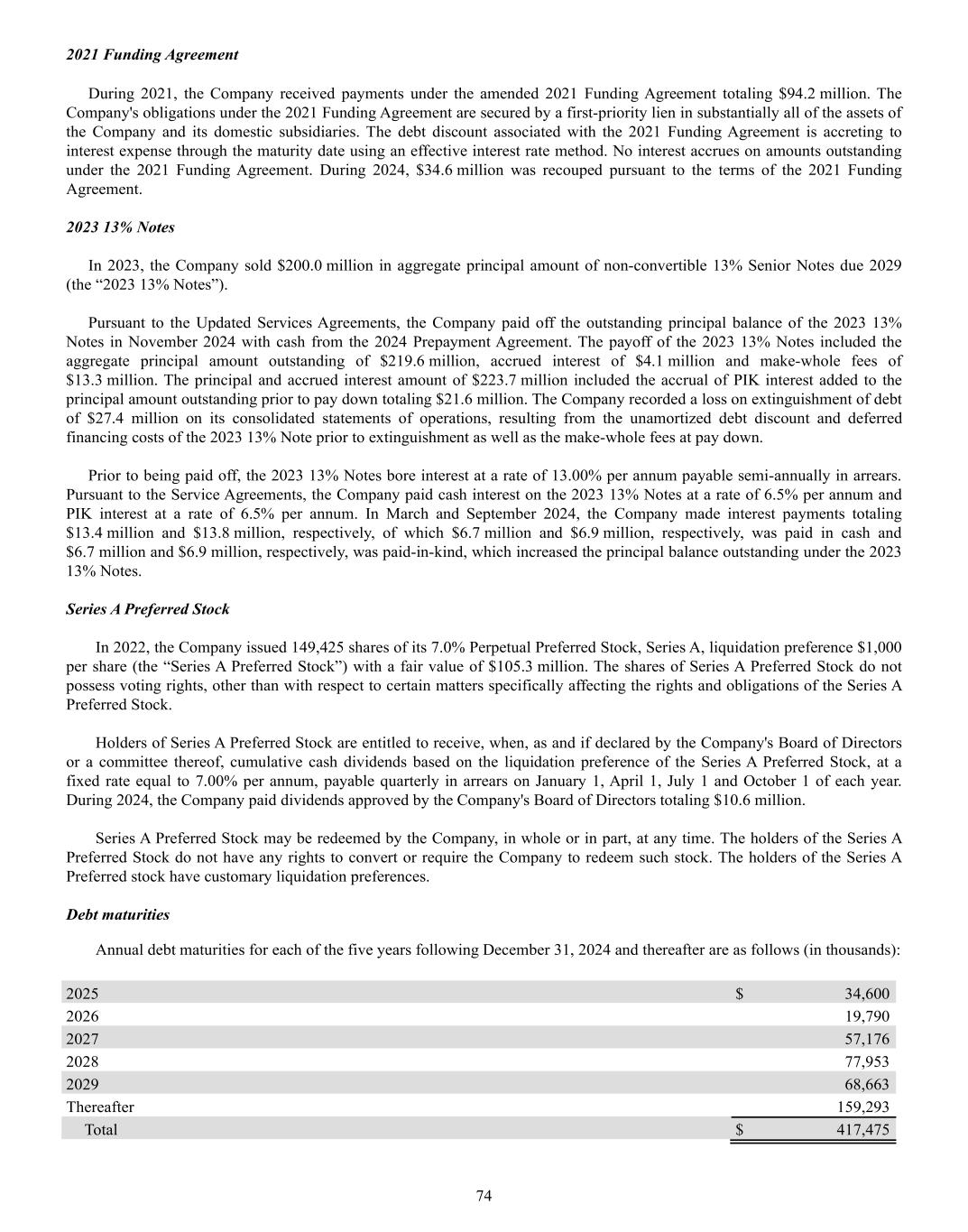
74 During 2021, the Company received payments under the amended 2021 Funding Agreement totaling $94.2 million. The Company's obligations under the 2021 Funding Agreement are secured by a first-priority lien in substantially all of the assets of the Company and its domestic subsidiaries. The debt discount associated with the 2021 Funding Agreement is accreting to interest expense through the maturity date using an effective interest rate method. No interest accrues on amounts outstanding under the 2021 Funding Agreement. During 2024, $34.6 million was recouped pursuant to the terms of the 2021 Funding Agreement. 2023 13% Notes In 2023, the Company sold $200.0 million in aggregate principal amount of non-convertible 13% Senior Notes due 2029 (the “2023 13% Notes”). Pursuant to the Updated Services Agreements, the Company paid off the outstanding principal balance of the 2023 13% Notes in November 2024 with cash from the 2024 Prepayment Agreement. The payoff of the 2023 13% Notes included the aggregate principal amount outstanding of $219.6 million, accrued interest of $4.1 million and make-whole fees of $13.3 million. The principal and accrued interest amount of $223.7 million included the accrual of PIK interest added to the principal amount outstanding prior to pay down totaling $21.6 million. The Company recorded a loss on extinguishment of debt of $27.4 million on its consolidated statements of operations, resulting from the unamortized debt discount and deferred financing costs of the 2023 13% Note prior to extinguishment as well as the make-whole fees at pay down. Prior to being paid off, the 2023 13% Notes bore interest at a rate of 13.00% per annum payable semi-annually in arrears. Pursuant to the Service Agreements, the Company paid cash interest on the 2023 13% Notes at a rate of 6.5% per annum and PIK interest at a rate of 6.5% per annum. In March and September 2024, the Company made interest payments totaling $13.4 million and $13.8 million, respectively, of which $6.7 million and $6.9 million, respectively, was paid in cash and $6.7 million and $6.9 million, respectively, was paid-in-kind, which increased the principal balance outstanding under the 2023 13% Notes. Series A Preferred Stock In 2022, the Company issued 149,425 shares of its 7.0% Perpetual Preferred Stock, Series A, liquidation preference $1,000 per share (the “Series A Preferred Stock”) with a fair value of $105.3 million. The shares of Series A Preferred Stock do not possess voting rights, other than with respect to certain matters specifically affecting the rights and obligations of the Series A Preferred Stock. Holders of Series A Preferred Stock are entitled to receive, when, as and if declared by the Company's Board of Directors or a committee thereof, cumulative cash dividends based on the liquidation preference of the Series A Preferred Stock, at a fixed rate equal to 7.00% per annum, payable quarterly in arrears on January 1, April 1, July 1 and October 1 of each year. During 2024, the Company paid dividends approved by the Company's Board of Directors totaling $10.6 million. Series A Preferred Stock may be redeemed by the Company, in whole or in part, at any time. The holders of the Series A Preferred Stock do not have any rights to convert or require the Company to redeem such stock. The holders of the Series A Preferred stock have customary liquidation preferences. Debt maturities Annual debt maturities for each of the five years following December 31, 2024 and thereafter are as follows (in thousands): 2025 $ 34,600 2026 19,790 2027 57,176 2028 77,953 2029 68,663 Thereafter 159,293 Total $ 417,475 2021 Funding Agreement
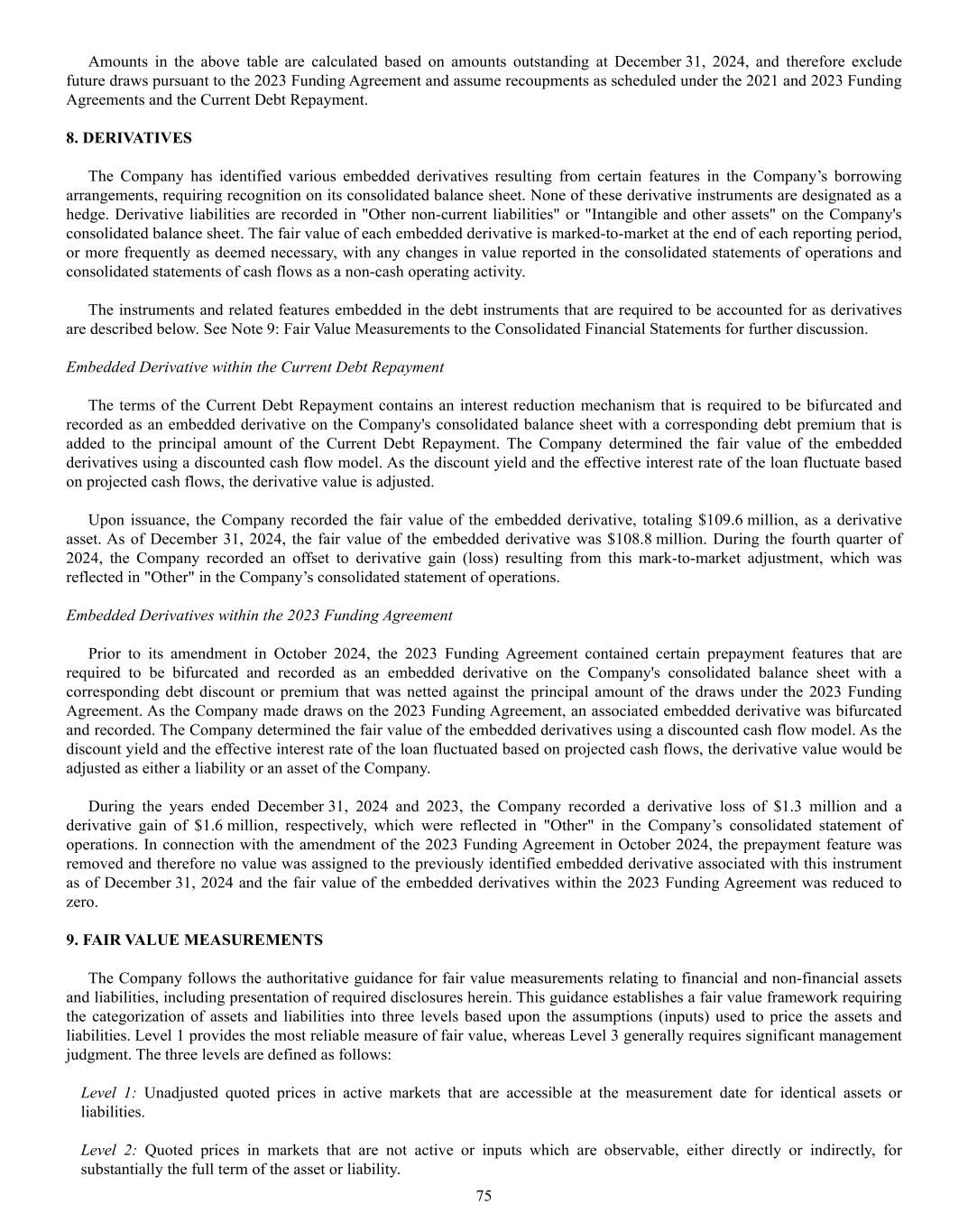
75 Amounts in the above table are calculated based on amounts outstanding at December 31, 2024, and therefore exclude future draws pursuant to the 2023 Funding Agreement and assume recoupments as scheduled under the 2021 and 2023 Funding Agreements and the Current Debt Repayment. 8. DERIVATIVES The Company has identified various embedded derivatives resulting from certain features in the Company’s borrowing arrangements, requiring recognition on its consolidated balance sheet. None of these derivative instruments are designated as a hedge. Derivative liabilities are recorded in "Other non-current liabilities" or "Intangible and other assets" on the Company's consolidated balance sheet. The fair value of each embedded derivative is marked-to-market at the end of each reporting period, or more frequently as deemed necessary, with any changes in value reported in the consolidated statements of operations and consolidated statements of cash flows as a non-cash operating activity. The instruments and related features embedded in the debt instruments that are required to be accounted for as derivatives are described below. See Note 9: Fair Value Measurements to the Consolidated Financial Statements for further discussion. Embedded Derivative within the Current Debt Repayment The terms of the Current Debt Repayment contains an interest reduction mechanism that is required to be bifurcated and recorded as an embedded derivative on the Company's consolidated balance sheet with a corresponding debt premium that is added to the principal amount of the Current Debt Repayment. The Company determined the fair value of the embedded derivatives using a discounted cash flow model. As the discount yield and the effective interest rate of the loan fluctuate based on projected cash flows, the derivative value is adjusted. Upon issuance, the Company recorded the fair value of the embedded derivative, totaling $109.6 million, as a derivative asset. As of December 31, 2024, the fair value of the embedded derivative was $108.8 million. During the fourth quarter of 2024, the Company recorded an offset to derivative gain (loss) resulting from this mark-to-market adjustment, which was reflected in "Other" in the Company’s consolidated statement of operations. Embedded Derivatives within the 2023 Funding Agreement Prior to its amendment in October 2024, the 2023 Funding Agreement contained certain prepayment features that are required to be bifurcated and recorded as an embedded derivative on the Company's consolidated balance sheet with a corresponding debt discount or premium that was netted against the principal amount of the draws under the 2023 Funding Agreement. As the Company made draws on the 2023 Funding Agreement, an associated embedded derivative was bifurcated and recorded. The Company determined the fair value of the embedded derivatives using a discounted cash flow model. As the discount yield and the effective interest rate of the loan fluctuated based on projected cash flows, the derivative value would be adjusted as either a liability or an asset of the Company. During the years ended December 31, 2024 and 2023, the Company recorded a derivative loss of $1.3 million and a derivative gain of $1.6 million, respectively, which were reflected in "Other" in the Company’s consolidated statement of operations. In connection with the amendment of the 2023 Funding Agreement in October 2024, the prepayment feature was removed and therefore no value was assigned to the previously identified embedded derivative associated with this instrument as of December 31, 2024 and the fair value of the embedded derivatives within the 2023 Funding Agreement was reduced to zero. 9. FAIR VALUE MEASUREMENTS The Company follows the authoritative guidance for fair value measurements relating to financial and non-financial assets and liabilities, including presentation of required disclosures herein. This guidance establishes a fair value framework requiring the categorization of assets and liabilities into three levels based upon the assumptions (inputs) used to price the assets and liabilities. Level 1 provides the most reliable measure of fair value, whereas Level 3 generally requires significant management judgment. The three levels are defined as follows: Level 1: Unadjusted quoted prices in active markets that are accessible at the measurement date for identical assets or liabilities. Level 2: Quoted prices in markets that are not active or inputs which are observable, either directly or indirectly, for substantially the full term of the asset or liability.

76 Level 3: Prices or valuation techniques that require inputs that are both significant to the fair value measurement and unobservable (i.e., supported by little or no market activity). Recurring Fair Value Measurements The Company marks-to-market its derivatives at each reporting date, or more frequently as deemed necessary, with the changes in fair value recognized in the Company’s consolidated statements of operations. See Note 8: Derivatives to the Consolidated Financial Statements for further discussion. Embedded Derivative within the Current Debt Repayment The embedded derivative relating to the Current Debt Repayment is valued using a discounted cash flow model. The most significant observable input used in the fair value measurement was the discount yield, which was 7.28% and 7.58% at issuance and December 31, 2024, respectively. As the discount yield used in the valuation process increases, the fair value of the embedded derivative decreases The significant unobservable input used in the fair value measurement included estimated timing of completing certain project milestones associated with the interest fee reduction mechanism. As the probability of reaching the relevant milestones decreases, the fair value of the embedded derivative would also decrease. Embedded Derivatives within the 2023 Funding Agreement Prior to October 2024, the embedded derivatives within the 2023 Funding Agreement were valued using a discounted cash flow model. The most significant observable input used in the fair value measurement was the discount yield. The significant unobservable input used in the fair value measurement included estimated timing and amounts of cash flows associated with the prepayment features within the debt agreement. As projected cash flows increased, the fair value of the embedded derivative increased. As a result of the amendment of the 2023 Funding Agreement in October 2024, this prepayment feature was removed and consequently the embedded derivative was eliminated. Rollforward of Recurring Level 3 Assets and Liabilities The following table presents a rollforward for all assets and liabilities measured at fair value on a recurring basis using significant unobservable inputs (Level 3) (in thousands): Year Ended December 31, 2024 2023 Balances at beginning of period $ 1,295 $ (122) Issuance of embedded derivatives within the Current Debt Repayment 109,601 — Issuance of embedded derivatives within the 2023 Funding Agreement — (292) Derivative adjustment related to extinguishment of debt — 122 Unrealized gain (loss), included in other (2,097) 1,587 Balances at end of period $ 108,799 $ 1,295 Fair Value of Debt Instruments and Other Financing Arrangements The Company believes it is not practicable to determine the fair value of its debt agreements on a recurring basis without incurring significant additional costs. Unlike typical long-term debt, certain terms for these instruments cannot readily be compared to other debt instruments and their valuation generally involve a variety of factors, including due diligence by the debt holders.
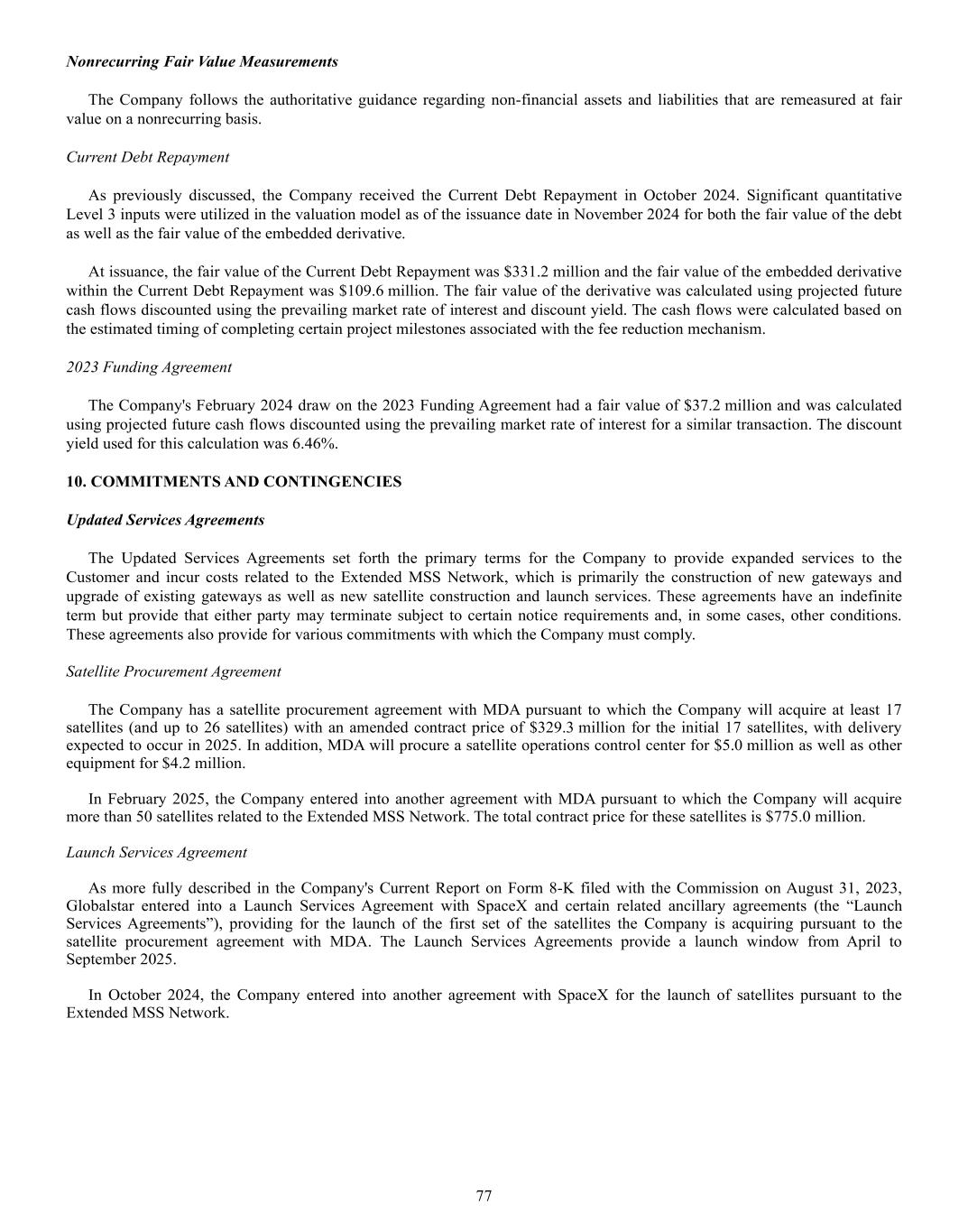
77 Nonrecurring Fair Value Measurements The Company follows the authoritative guidance regarding non-financial assets and liabilities that are remeasured at fair value on a nonrecurring basis. Current Debt Repayment As previously discussed, the Company received the Current Debt Repayment in October 2024. Significant quantitative Level 3 inputs were utilized in the valuation model as of the issuance date in November 2024 for both the fair value of the debt as well as the fair value of the embedded derivative. At issuance, the fair value of the Current Debt Repayment was $331.2 million and the fair value of the embedded derivative within the Current Debt Repayment was $109.6 million. The fair value of the derivative was calculated using projected future cash flows discounted using the prevailing market rate of interest and discount yield. The cash flows were calculated based on the estimated timing of completing certain project milestones associated with the fee reduction mechanism. 2023 Funding Agreement The Company's February 2024 draw on the 2023 Funding Agreement had a fair value of $37.2 million and was calculated using projected future cash flows discounted using the prevailing market rate of interest for a similar transaction. The discount yield used for this calculation was 6.46%. 10. COMMITMENTS AND CONTINGENCIES Updated Services Agreements The Updated Services Agreements set forth the primary terms for the Company to provide expanded services to the Customer and incur costs related to the Extended MSS Network, which is primarily the construction of new gateways and upgrade of existing gateways as well as new satellite construction and launch services. These agreements have an indefinite term but provide that either party may terminate subject to certain notice requirements and, in some cases, other conditions. These agreements also provide for various commitments with which the Company must comply. Satellite Procurement Agreement The Company has a satellite procurement agreement with MDA pursuant to which the Company will acquire at least 17 satellites (and up to 26 satellites) with an amended contract price of $329.3 million for the initial 17 satellites, with delivery expected to occur in 2025. In addition, MDA will procure a satellite operations control center for $5.0 million as well as other equipment for $4.2 million. In February 2025, the Company entered into another agreement with MDA pursuant to which the Company will acquire more than 50 satellites related to the Extended MSS Network. The total contract price for these satellites is $775.0 million. Launch Services Agreement As more fully described in the Company's Current Report on Form 8-K filed with the Commission on August 31, 2023, Globalstar entered into a Launch Services Agreement with SpaceX and certain related ancillary agreements (the “Launch Services Agreements”), providing for the launch of the first set of the satellites the Company is acquiring pursuant to the satellite procurement agreement with MDA. The Launch Services Agreements provide a launch window from April to September 2025. In October 2024, the Company entered into another agreement with SpaceX for the launch of satellites pursuant to the Extended MSS Network.

78 Funding for Phase 2 Service Period Asset Procurement Under the Service Agreements, subject to certain terms and conditions, the Company expects to receive payments equal to 95% of the approved capital expenditures under the satellite procurement agreement for the HIBLEO-4 satellites and Launch Services Agreements for such satellites (to be paid on a straight-line basis over the design life of the satellites) beginning with the commencement of the Phase 2 Service Period. The Phase 2 Service Period is expected to begin when the new satellites are successfully utilized to provide Services. Funding for Extended MSS Network Asset Procurement As discussed in more detail in Note 2: Special Purpose Entity, the Updated Services Agreements provide for prepayments from the Customer for approved capital expenditures associated with the Extended MSS Network. As of December 31, 2024, the Company has outstanding purchase orders for this project totaling $290 million to vendors for various satellite and ground components of the Extended MSS Network, which are expected to be paid with funds from the Infrastructure Prepayment and sale of the Customer Class B Units. These costs will continue until the construction period is complete and the commencement of Services provided over the Extended MSS Network. Inventory Purchase Commitments The Company has inventory purchase commitments with its third party product manufacturers in the normal course of business. These commitments are generally noncancellable and the order quantities are based on sales forecasts. The Company estimates that its open inventory purchase commitments as of December 31, 2024 were approximately $4.7 million. Litigation Due to the nature of the Company's business, the Company is involved, from time to time, in various litigation matters or subject to disputes or routine claims regarding its business activities. Legal costs related to these matters are expensed as incurred. In management's opinion, there is no pending litigation, dispute or claim, which could be expected to have a material adverse effect on the Company's financial condition, results of operations or liquidity. 11. ACCRUED EXPENSES AND OTHER NON-CURRENT LIABILITIES Accrued expenses consist of the following (in thousands): December 31, 2024 2023 Accrued compensation and benefits $ 5,203 $ 4,307 Accrued property and other taxes 7,550 5,586 Accrued customer liabilities and deposits 3,600 4,284 Short-term lease liability 4,251 3,004 Accrued interest — 3,942 Other accrued expenses 4,096 5,835 Total accrued expenses $ 24,700 $ 26,958 Accrued interest as of December 31, 2023 included interest associated with the cash portion of the 13% Notes, which was refinanced in November 2024. Other accrued expenses include primarily vendor services, warranty reserve and occupancy costs.
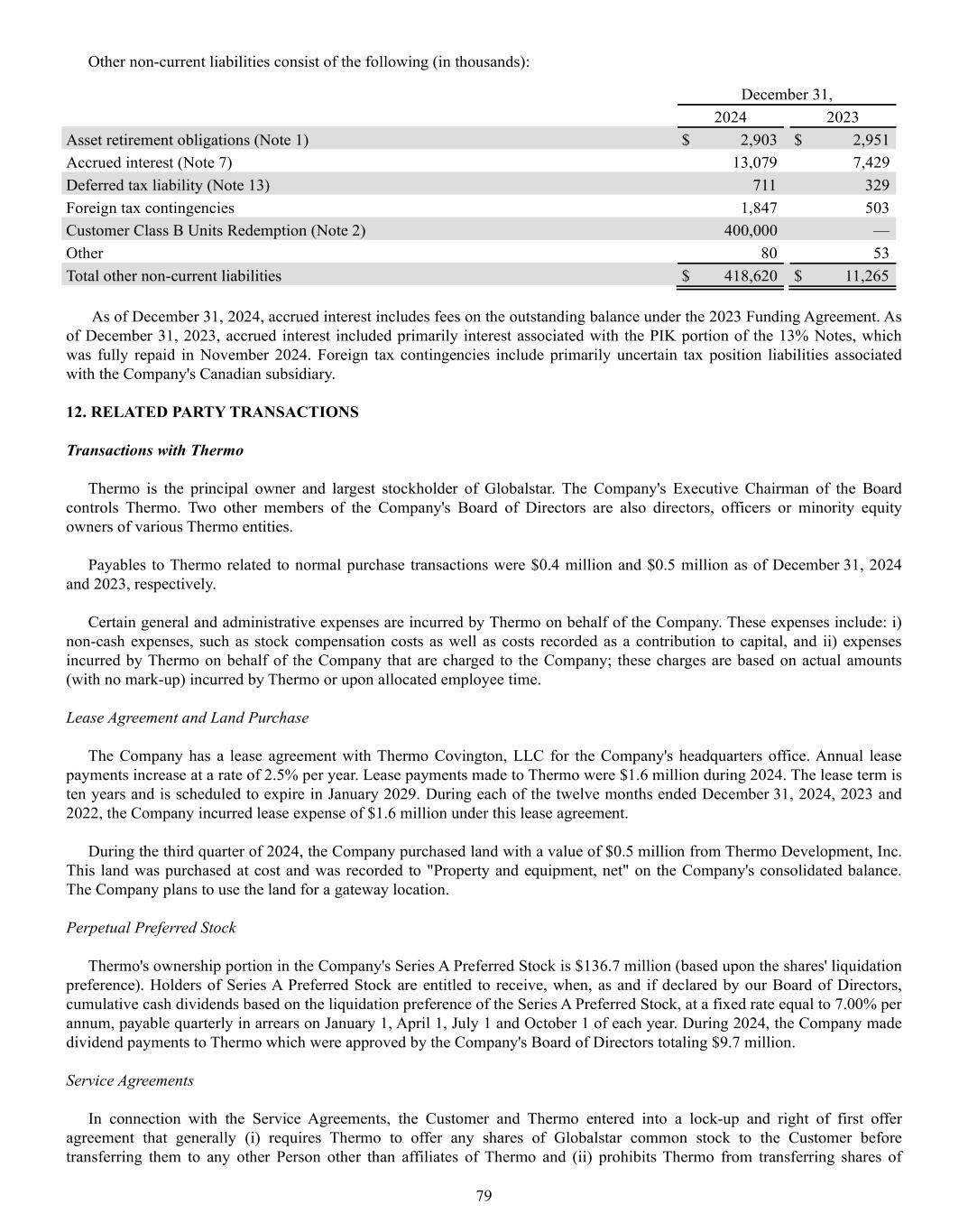
79 Other non-current liabilities consist of the following (in thousands): December 31, 2024 2023 Asset retirement obligations (Note 1) $ 2,903 $ 2,951 Accrued interest (Note 7) 13,079 7,429 Deferred tax liability (Note 13) 711 329 Foreign tax contingencies 1,847 503 Customer Class B Units Redemption (Note 2) 400,000 — Other 80 53 Total other non-current liabilities $ 418,620 $ 11,265 As of December 31, 2024, accrued interest includes fees on the outstanding balance under the 2023 Funding Agreement. As of December 31, 2023, accrued interest included primarily interest associated with the PIK portion of the 13% Notes, which was fully repaid in November 2024. Foreign tax contingencies include primarily uncertain tax position liabilities associated with the Company's Canadian subsidiary. 12. RELATED PARTY TRANSACTIONS Transactions with Thermo Thermo is the principal owner and largest stockholder of Globalstar. The Company's Executive Chairman of the Board controls Thermo. Two other members of the Company's Board of Directors are also directors, officers or minority equity owners of various Thermo entities. Payables to Thermo related to normal purchase transactions were $0.4 million and $0.5 million as of December 31, 2024 and 2023, respectively. Certain general and administrative expenses are incurred by Thermo on behalf of the Company. These expenses include: i) non-cash expenses, such as stock compensation costs as well as costs recorded as a contribution to capital, and ii) expenses incurred by Thermo on behalf of the Company that are charged to the Company; these charges are based on actual amounts (with no mark-up) incurred by Thermo or upon allocated employee time. Lease Agreement and Land Purchase The Company has a lease agreement with Thermo Covington, LLC for the Company's headquarters office. Annual lease payments increase at a rate of 2.5% per year. Lease payments made to Thermo were $1.6 million during 2024. The lease term is ten years and is scheduled to expire in January 2029. During each of the twelve months ended December 31, 2024, 2023 and 2022, the Company incurred lease expense of $1.6 million under this lease agreement. During the third quarter of 2024, the Company purchased land with a value of $0.5 million from Thermo Development, Inc. This land was purchased at cost and was recorded to "Property and equipment, net" on the Company's consolidated balance. The Company plans to use the land for a gateway location. Perpetual Preferred Stock Thermo's ownership portion in the Company's Series A Preferred Stock is $136.7 million (based upon the shares' liquidation preference). Holders of Series A Preferred Stock are entitled to receive, when, as and if declared by our Board of Directors, cumulative cash dividends based on the liquidation preference of the Series A Preferred Stock, at a fixed rate equal to 7.00% per annum, payable quarterly in arrears on January 1, April 1, July 1 and October 1 of each year. During 2024, the Company made dividend payments to Thermo which were approved by the Company's Board of Directors totaling $9.7 million. Service Agreements In connection with the Service Agreements, the Customer and Thermo entered into a lock-up and right of first offer agreement that generally (i) requires Thermo to offer any shares of Globalstar common stock to the Customer before transferring them to any other Person other than affiliates of Thermo and (ii) prohibits Thermo from transferring shares of
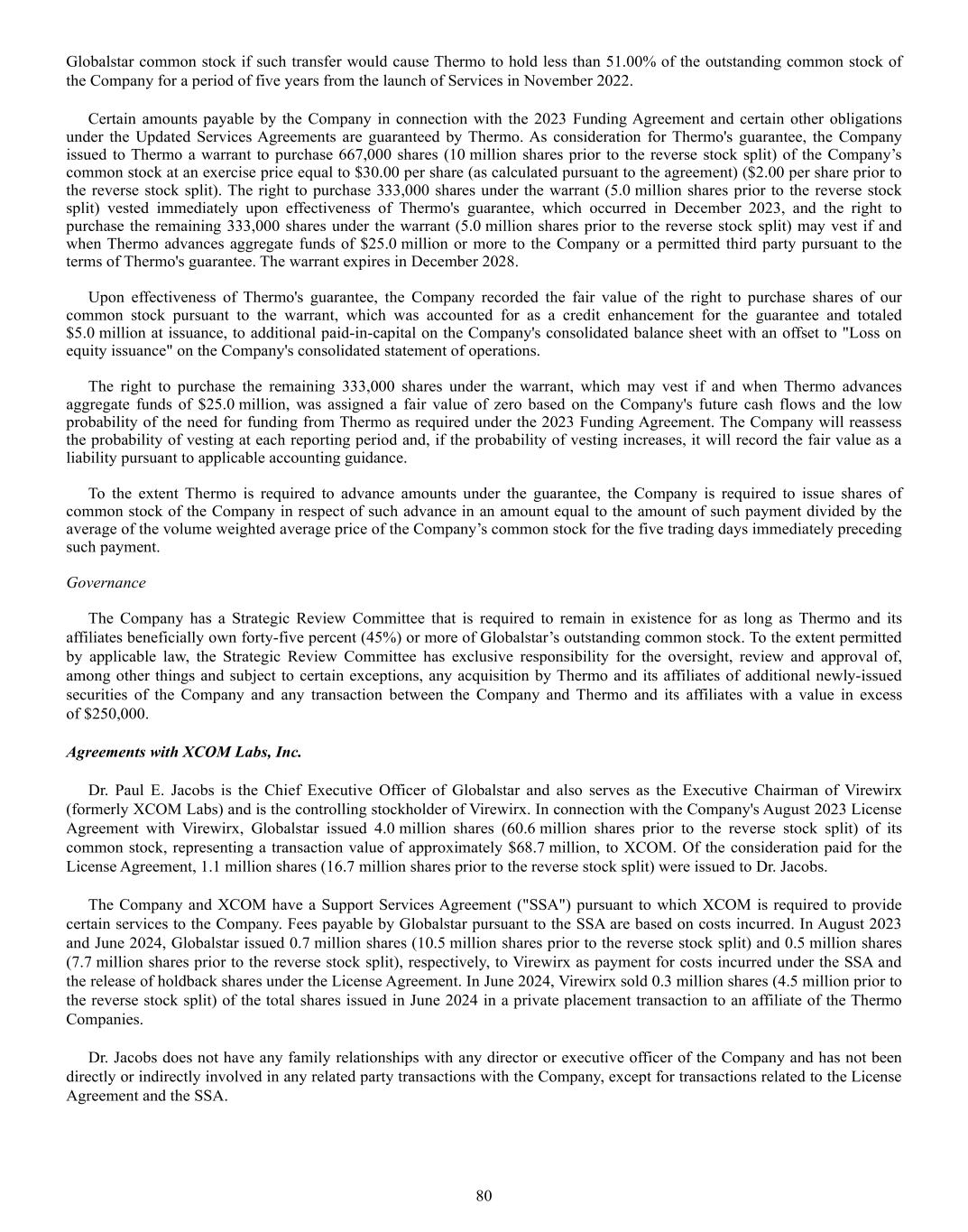
80 Globalstar common stock if such transfer would cause Thermo to hold less than 51.00% of the outstanding common stock of the Company for a period of five years from the launch of Services in November 2022. Certain amounts payable by the Company in connection with the 2023 Funding Agreement and certain other obligations under the Updated Services Agreements are guaranteed by Thermo. As consideration for Thermo's guarantee, the Company issued to Thermo a warrant to purchase 667,000 shares (10 million shares prior to the reverse stock split) of the Company’s common stock at an exercise price equal to $30.00 per share (as calculated pursuant to the agreement) ($2.00 per share prior to the reverse stock split). The right to purchase 333,000 shares under the warrant (5.0 million shares prior to the reverse stock split) vested immediately upon effectiveness of Thermo's guarantee, which occurred in December 2023, and the right to purchase the remaining 333,000 shares under the warrant (5.0 million shares prior to the reverse stock split) may vest if and when Thermo advances aggregate funds of $25.0 million or more to the Company or a permitted third party pursuant to the terms of Thermo's guarantee. The warrant expires in December 2028. Upon effectiveness of Thermo's guarantee, the Company recorded the fair value of the right to purchase shares of our common stock pursuant to the warrant, which was accounted for as a credit enhancement for the guarantee and totaled $5.0 million at issuance, to additional paid-in-capital on the Company's consolidated balance sheet with an offset to "Loss on equity issuance" on the Company's consolidated statement of operations. The right to purchase the remaining 333,000 shares under the warrant, which may vest if and when Thermo advances aggregate funds of $25.0 million, was assigned a fair value of zero based on the Company's future cash flows and the low probability of the need for funding from Thermo as required under the 2023 Funding Agreement. The Company will reassess the probability of vesting at each reporting period and, if the probability of vesting increases, it will record the fair value as a liability pursuant to applicable accounting guidance. To the extent Thermo is required to advance amounts under the guarantee, the Company is required to issue shares of common stock of the Company in respect of such advance in an amount equal to the amount of such payment divided by the average of the volume weighted average price of the Company’s common stock for the five trading days immediately preceding such payment. Governance The Company has a Strategic Review Committee that is required to remain in existence for as long as Thermo and its affiliates beneficially own forty-five percent (45%) or more of Globalstar’s outstanding common stock. To the extent permitted by applicable law, the Strategic Review Committee has exclusive responsibility for the oversight, review and approval of, among other things and subject to certain exceptions, any acquisition by Thermo and its affiliates of additional newly-issued securities of the Company and any transaction between the Company and Thermo and its affiliates with a value in excess of $250,000. Agreements with XCOM Labs, Inc. Dr. Paul E. Jacobs is the Chief Executive Officer of Globalstar and also serves as the Executive Chairman of Virewirx (formerly XCOM Labs) and is the controlling stockholder of Virewirx. In connection with the Company's August 2023 License Agreement with Virewirx, Globalstar issued 4.0 million shares (60.6 million shares prior to the reverse stock split) of its common stock, representing a transaction value of approximately $68.7 million, to XCOM. Of the consideration paid for the License Agreement, 1.1 million shares (16.7 million shares prior to the reverse stock split) were issued to Dr. Jacobs. The Company and XCOM have a Support Services Agreement ("SSA") pursuant to which XCOM is required to provide certain services to the Company. Fees payable by Globalstar pursuant to the SSA are based on costs incurred. In August 2023 and June 2024, Globalstar issued 0.7 million shares (10.5 million shares prior to the reverse stock split) and 0.5 million shares (7.7 million shares prior to the reverse stock split), respectively, to Virewirx as payment for costs incurred under the SSA and the release of holdback shares under the License Agreement. In June 2024, Virewirx sold 0.3 million shares (4.5 million prior to the reverse stock split) of the total shares issued in June 2024 in a private placement transaction to an affiliate of the Thermo Companies. Dr. Jacobs does not have any family relationships with any director or executive officer of the Company and has not been directly or indirectly involved in any related party transactions with the Company, except for transactions related to the License Agreement and the SSA.
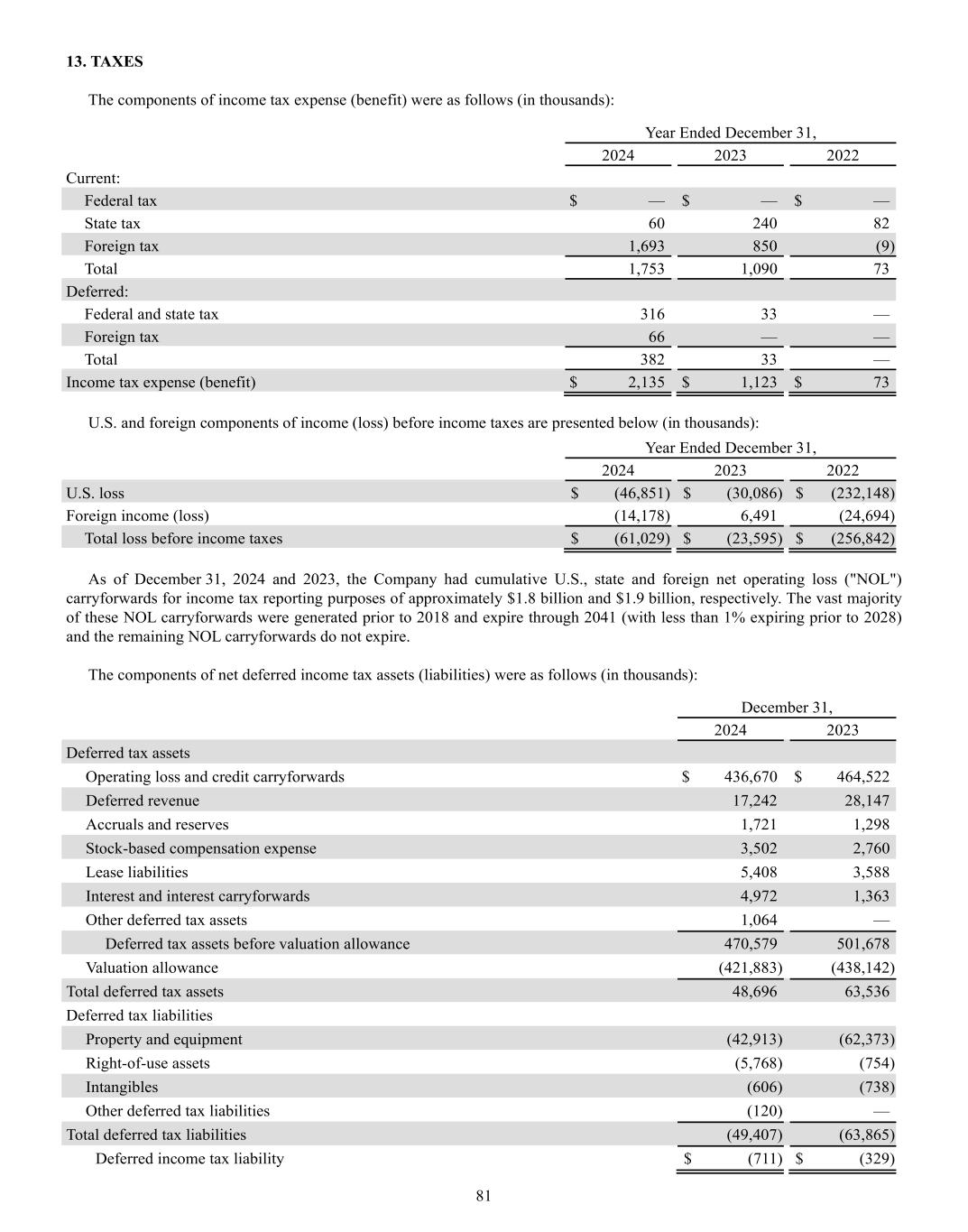
81 13. TAXES The components of income tax expense (benefit) were as follows (in thousands): Year Ended December 31, 2024 2023 2022 Current: Federal tax $ — $ — $ — State tax 60 240 82 Foreign tax 1,693 850 (9) Total 1,753 1,090 73 Deferred: Federal and state tax 316 33 — Foreign tax 66 — — Total 382 33 — Income tax expense (benefit) $ 2,135 $ 1,123 $ 73 U.S. and foreign components of income (loss) before income taxes are presented below (in thousands): Year Ended December 31, 2024 2023 2022 U.S. loss $ (46,851) $ (30,086) $ (232,148) Foreign income (loss) (14,178) 6,491 (24,694) Total loss before income taxes $ (61,029) $ (23,595) $ (256,842) As of December 31, 2024 and 2023, the Company had cumulative U.S., state and foreign net operating loss ("NOL") carryforwards for income tax reporting purposes of approximately $1.8 billion and $1.9 billion, respectively. The vast majority of these NOL carryforwards were generated prior to 2018 and expire through 2041 (with less than 1% expiring prior to 2028) and the remaining NOL carryforwards do not expire. The components of net deferred income tax assets (liabilities) were as follows (in thousands): December 31, 2024 2023 Deferred tax assets Operating loss and credit carryforwards $ 436,670 $ 464,522 Deferred revenue 17,242 28,147 Accruals and reserves 1,721 1,298 Stock-based compensation expense 3,502 2,760 Lease liabilities 5,408 3,588 Interest and interest carryforwards 4,972 1,363 Other deferred tax assets 1,064 — Deferred tax assets before valuation allowance 470,579 501,678 Valuation allowance (421,883) (438,142) Total deferred tax assets 48,696 63,536 Deferred tax liabilities Property and equipment (42,913) (62,373) Right-of-use assets (5,768) (754) Intangibles (606) (738) Other deferred tax liabilities (120) — Total deferred tax liabilities (49,407) (63,865) Deferred income tax liability $ (711) $ (329)
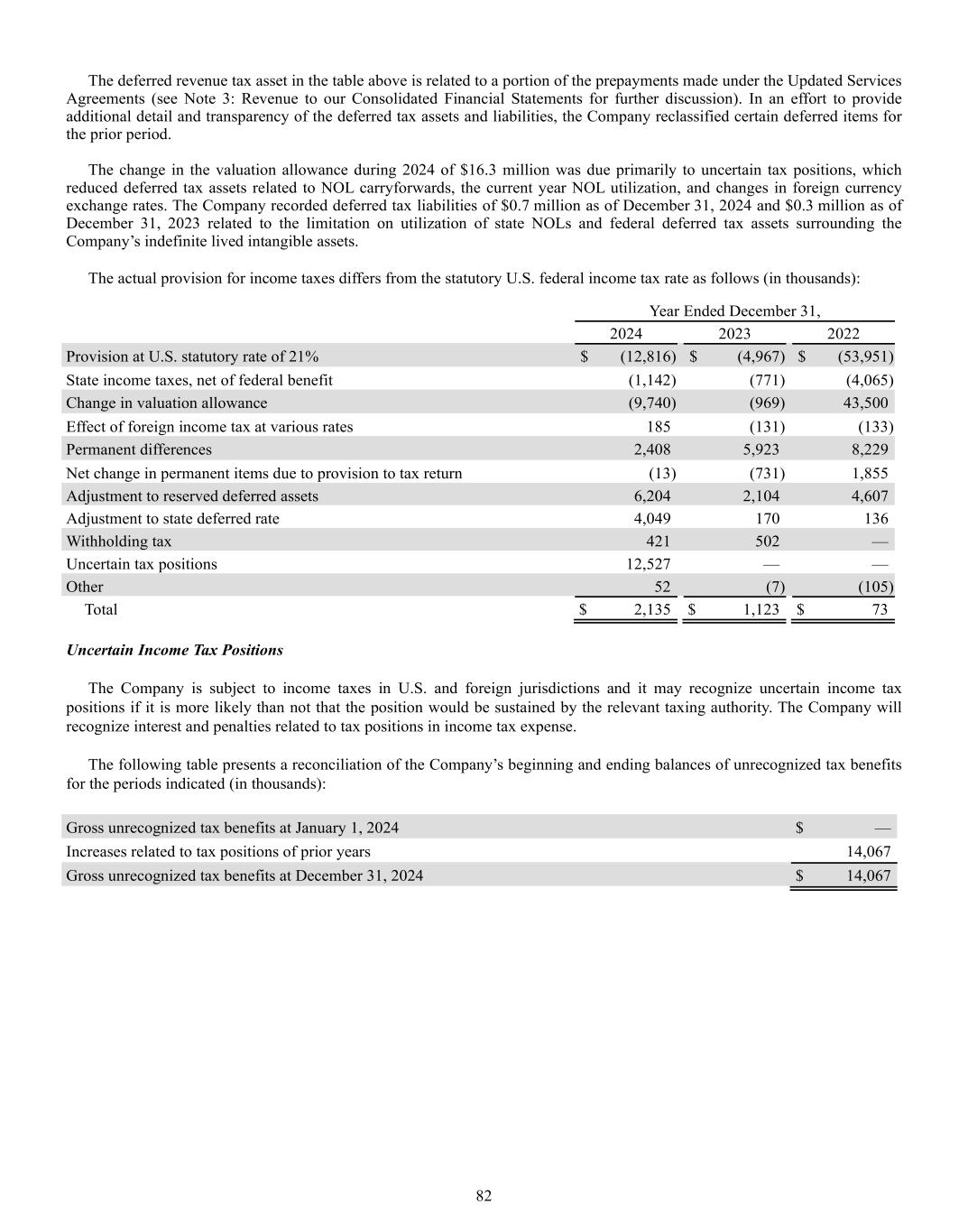
82 The deferred revenue tax asset in the table above is related to a portion of the prepayments made under the Updated Services Agreements (see Note 3: Revenue to our Consolidated Financial Statements for further discussion). In an effort to provide additional detail and transparency of the deferred tax assets and liabilities, the Company reclassified certain deferred items for the prior period. The change in the valuation allowance during 2024 of $16.3 million was due primarily to uncertain tax positions, which reduced deferred tax assets related to NOL carryforwards, the current year NOL utilization, and changes in foreign currency exchange rates. The Company recorded deferred tax liabilities of $0.7 million as of December 31, 2024 and $0.3 million as of December 31, 2023 related to the limitation on utilization of state NOLs and federal deferred tax assets surrounding the Company’s indefinite lived intangible assets. The actual provision for income taxes differs from the statutory U.S. federal income tax rate as follows (in thousands): Year Ended December 31, 2024 2023 2022 Provision at U.S. statutory rate of 21% $ (12,816) $ (4,967) $ (53,951) State income taxes, net of federal benefit (1,142) (771) (4,065) Change in valuation allowance (9,740) (969) 43,500 Effect of foreign income tax at various rates 185 (131) (133) Permanent differences 2,408 5,923 8,229 Net change in permanent items due to provision to tax return (13) (731) 1,855 Adjustment to reserved deferred assets 6,204 2,104 4,607 Adjustment to state deferred rate 4,049 170 136 Withholding tax 421 502 — Uncertain tax positions 12,527 — — Other 52 (7) (105) Total $ 2,135 $ 1,123 $ 73 Uncertain Income Tax Positions The Company is subject to income taxes in U.S. and foreign jurisdictions and it may recognize uncertain income tax positions if it is more likely than not that the position would be sustained by the relevant taxing authority. The Company will recognize interest and penalties related to tax positions in income tax expense. The following table presents a reconciliation of the Company’s beginning and ending balances of unrecognized tax benefits for the periods indicated (in thousands): Gross unrecognized tax benefits at January 1, 2024 $ — Increases related to tax positions of prior years 14,067 Gross unrecognized tax benefits at December 31, 2024 $ 14,067
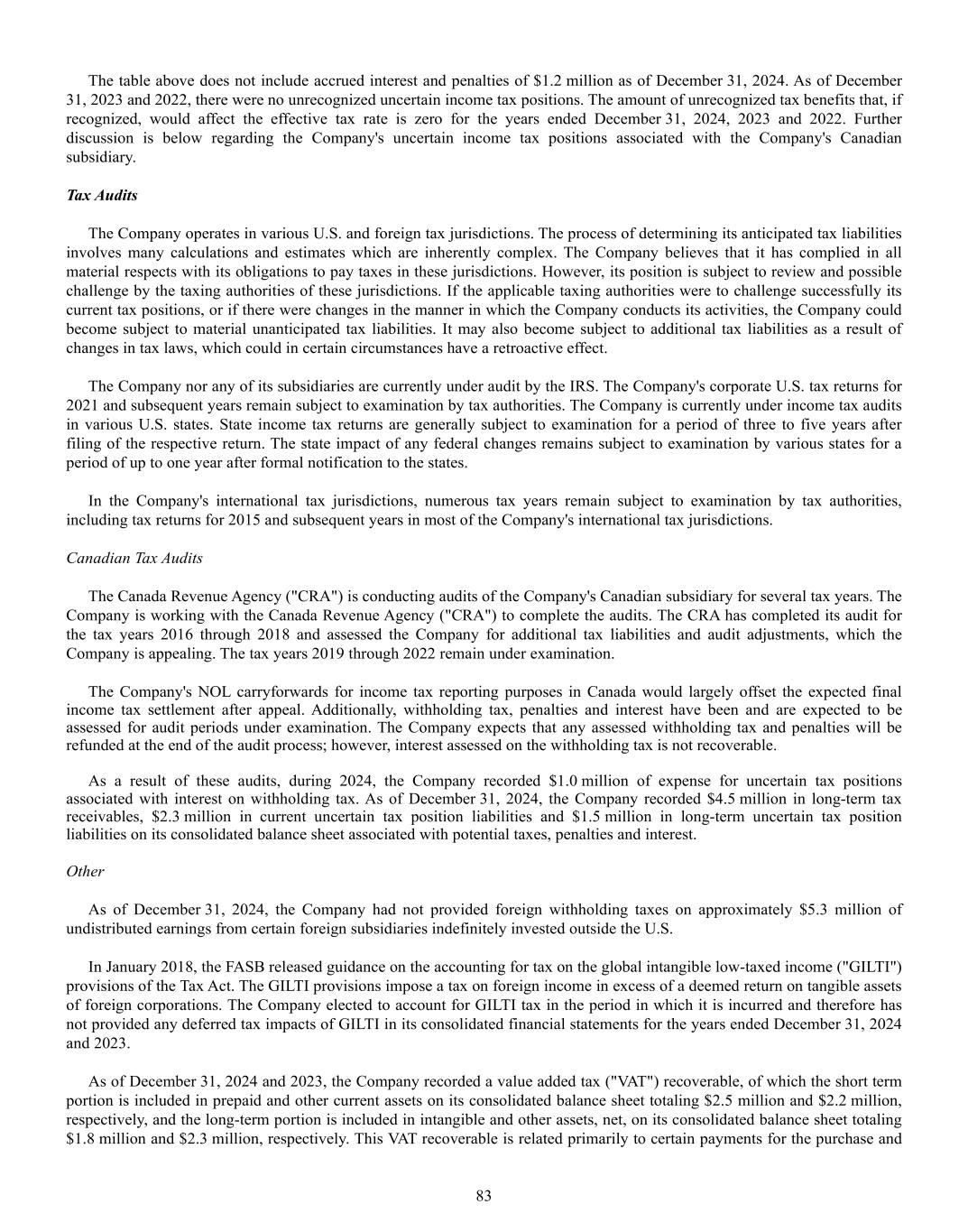
83 The table above does not include accrued interest and penalties of $1.2 million as of December 31, 2024. As of December 31, 2023 and 2022, there were no unrecognized uncertain income tax positions. The amount of unrecognized tax benefits that, if recognized, would affect the effective tax rate is zero for the years ended December 31, 2024, 2023 and 2022. Further discussion is below regarding the Company's uncertain income tax positions associated with the Company's Canadian subsidiary. Tax Audits The Company operates in various U.S. and foreign tax jurisdictions. The process of determining its anticipated tax liabilities involves many calculations and estimates which are inherently complex. The Company believes that it has complied in all material respects with its obligations to pay taxes in these jurisdictions. However, its position is subject to review and possible challenge by the taxing authorities of these jurisdictions. If the applicable taxing authorities were to challenge successfully its current tax positions, or if there were changes in the manner in which the Company conducts its activities, the Company could become subject to material unanticipated tax liabilities. It may also become subject to additional tax liabilities as a result of changes in tax laws, which could in certain circumstances have a retroactive effect. The Company nor any of its subsidiaries are currently under audit by the IRS. The Company's corporate U.S. tax returns for 2021 and subsequent years remain subject to examination by tax authorities. The Company is currently under income tax audits in various U.S. states. State income tax returns are generally subject to examination for a period of three to five years after filing of the respective return. The state impact of any federal changes remains subject to examination by various states for a period of up to one year after formal notification to the states. In the Company's international tax jurisdictions, numerous tax years remain subject to examination by tax authorities, including tax returns for 2015 and subsequent years in most of the Company's international tax jurisdictions. Canadian Tax Audits The Canada Revenue Agency ("CRA") is conducting audits of the Company's Canadian subsidiary for several tax years. The Company is working with the Canada Revenue Agency ("CRA") to complete the audits. The CRA has completed its audit for the tax years 2016 through 2018 and assessed the Company for additional tax liabilities and audit adjustments, which the Company is appealing. The tax years 2019 through 2022 remain under examination. The Company's NOL carryforwards for income tax reporting purposes in Canada would largely offset the expected final income tax settlement after appeal. Additionally, withholding tax, penalties and interest have been and are expected to be assessed for audit periods under examination. The Company expects that any assessed withholding tax and penalties will be refunded at the end of the audit process; however, interest assessed on the withholding tax is not recoverable. As a result of these audits, during 2024, the Company recorded $1.0 million of expense for uncertain tax positions associated with interest on withholding tax. As of December 31, 2024, the Company recorded $4.5 million in long-term tax receivables, $2.3 million in current uncertain tax position liabilities and $1.5 million in long-term uncertain tax position liabilities on its consolidated balance sheet associated with potential taxes, penalties and interest. Other As of December 31, 2024, the Company had not provided foreign withholding taxes on approximately $5.3 million of undistributed earnings from certain foreign subsidiaries indefinitely invested outside the U.S. In January 2018, the FASB released guidance on the accounting for tax on the global intangible low-taxed income ("GILTI") provisions of the Tax Act. The GILTI provisions impose a tax on foreign income in excess of a deemed return on tangible assets of foreign corporations. The Company elected to account for GILTI tax in the period in which it is incurred and therefore has not provided any deferred tax impacts of GILTI in its consolidated financial statements for the years ended December 31, 2024 and 2023. As of December 31, 2024 and 2023, the Company recorded a value added tax ("VAT") recoverable, of which the short term portion is included in prepaid and other current assets on its consolidated balance sheet totaling $2.5 million and $2.2 million, respectively, and the long-term portion is included in intangible and other assets, net, on its consolidated balance sheet totaling $1.8 million and $2.3 million, respectively. This VAT recoverable is related primarily to certain payments for the purchase and

84 importation of gateway equipment in various international jurisdictions in connection with the Company's network upgrade work. 14. LOSS PER SHARE The following table sets forth the computation of basic and diluted loss per common share for the periods indicated (in thousands). The number of shares have been restated to reflect the 1:15 reverse stock split effectuated on February 10, 2025. All historical share and per share amounts reflected in this Report have been adjusted to reflect the reverse stock split. Refer to Note 17: Common Stock for further discussion. Year ended December 31, 2024 2023 2022 Numerator: Net loss $ (63,164) $ (24,718) $ (256,915) Effect of Series A Preferred Stock dividends (10,634) (10,605) (1,337) Adjusted net loss attributable to common shareholders $ (73,798) $ (35,323) $ (258,252) Denominator: Weighted average common shares outstanding 125,877 122,334 120,055 Net loss per common share: Basic $ (0.59) $ (0.29) $ (2.15) Diluted $ (0.59) $ (0.29) $ (2.15) For the years ended December 31, 2024, 2023 and 2022, 1.3 million shares, 1.3 million shares and 0.5 million shares, respectively, of potential common stock were excluded from diluted shares outstanding because the effects of such securities would be anti-dilutive. Included in these shares for all periods presented is a portion of the 3.3 million shares (49.1 million shares prior to the reverse stock split) that may be purchased by the Customer pursuant to the warrants issued under the Updated Services Agreements in 2022 based on the treasury stock method. During 2023, the right to purchase 0.3 million shares of common stock vested pursuant to the warrant (5.0 million shares prior to the reverse stock split) issued to Thermo for its guarantee of the 2023 Funding Agreement; none of these shares are included in the potentially dilutive securities for the applicable periods presented due to the exercise price relative to the average market price of Globalstar common stock during the periods. Also excluded from the amounts above are 0.3 million shares (5.0 million shares prior to the reverse stock split) that may be purchased by Thermo pursuant to the warrant issued in connection with its guarantee of the 2023 Funding Agreement; the right to purchase these shares vests only if Thermo advances aggregate funds of $25.0 million or more to the Company or a permitted third party pursuant to the terms of Thermo's guarantee. 15. STOCK COMPENSATION Share-Based Payment Arrangements with Employees The Company’s Equity Incentive Plan (“Equity Plan”) provides long-term incentives to the Company’s key employees, including officers, directors, consultants and advisers (“Eligible Participants”), and is designed to align stockholder and employee interests. Under the Equity Plan, the Company may grant incentive stock options, nonstatutory stock options, restricted stock awards, restricted stock units, and other stock based awards or any combination thereof to Eligible Participants. The Compensation Committee of the Company’s Board of Directors establishes the terms and conditions of any awards granted under the plans. At the time of grant, the Company takes into consideration the timing of the stock based award and evaluates for conditions that could result in the award to be considered spring loaded. The number of shares have been restated to reflect the 1:15 reverse stock split effectuated on February 10, 2025. All historical share and per share amounts reflected in this Report have been adjusted to reflect the reverse stock split. Refer to Note 17: Common Stock for further discussion. As of December 31, 2024 and 2023, the number of shares of common stock that was authorized and remained available for issuance under the Equity Plan was 3.4 million and 1.4 million, respectively (51.7 million and 20.6 million, respectively prior to the reverse stock split). During 2024, the Company's Board of Directors approved an increase to the Equity Plan reserve totaling 2.5 million shares (37.6 million shares prior to the reverse stock split).
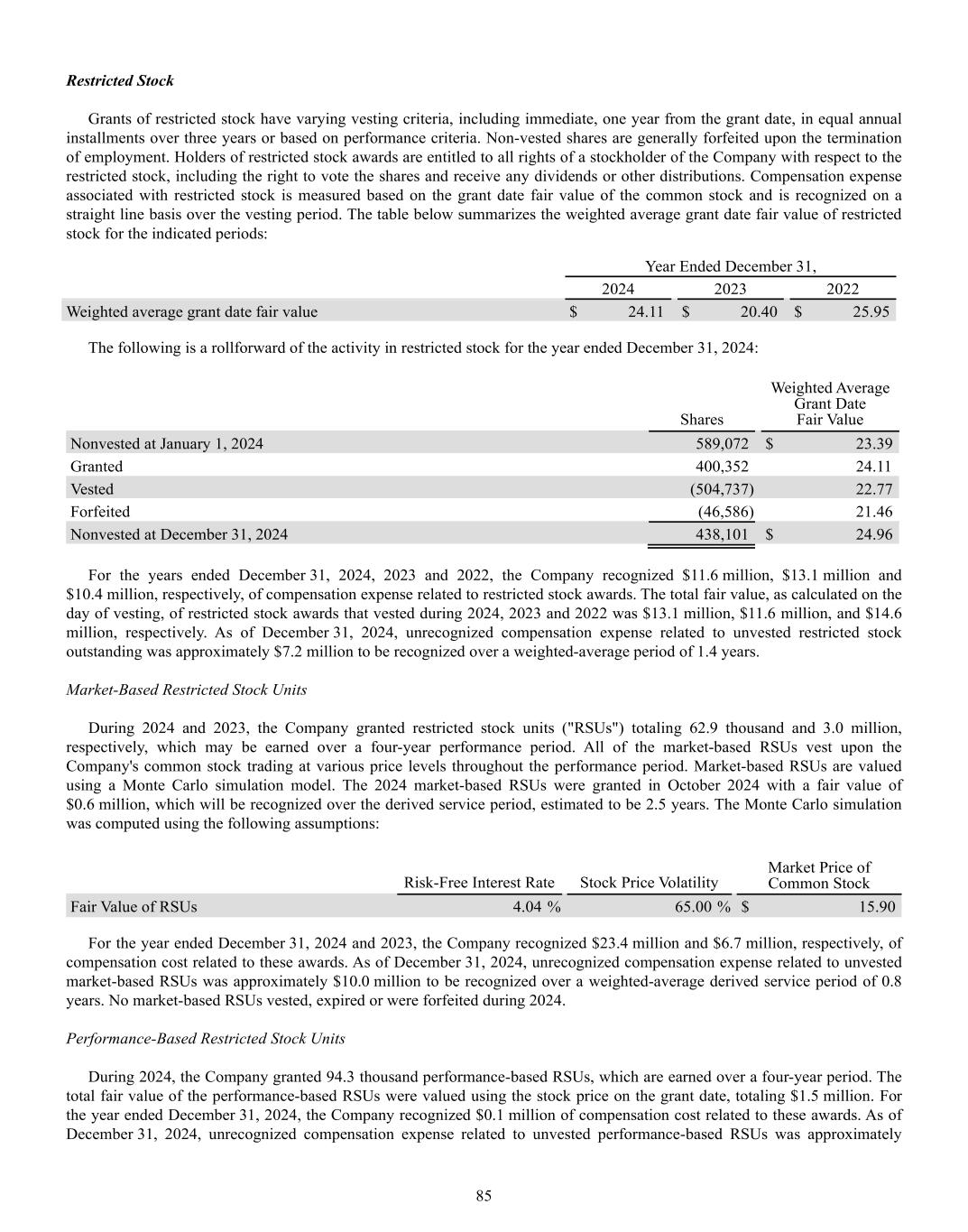
85 Restricted Stock Grants of restricted stock have varying vesting criteria, including immediate, one year from the grant date, in equal annual installments over three years or based on performance criteria. Non-vested shares are generally forfeited upon the termination of employment. Holders of restricted stock awards are entitled to all rights of a stockholder of the Company with respect to the restricted stock, including the right to vote the shares and receive any dividends or other distributions. Compensation expense associated with restricted stock is measured based on the grant date fair value of the common stock and is recognized on a straight line basis over the vesting period. The table below summarizes the weighted average grant date fair value of restricted stock for the indicated periods: Year Ended December 31, 2024 2023 2022 Weighted average grant date fair value $ 24.11 $ 20.40 $ 25.95 The following is a rollforward of the activity in restricted stock for the year ended December 31, 2024: Shares Weighted Average Grant Date Fair Value Nonvested at January 1, 2024 589,072 $ 23.39 Granted 400,352 24.11 Vested (504,737) 22.77 Forfeited (46,586) 21.46 Nonvested at December 31, 2024 438,101 $ 24.96 For the years ended December 31, 2024, 2023 and 2022, the Company recognized $11.6 million, $13.1 million and $10.4 million, respectively, of compensation expense related to restricted stock awards. The total fair value, as calculated on the day of vesting, of restricted stock awards that vested during 2024, 2023 and 2022 was $13.1 million, $11.6 million, and $14.6 million, respectively. As of December 31, 2024, unrecognized compensation expense related to unvested restricted stock outstanding was approximately $7.2 million to be recognized over a weighted-average period of 1.4 years. Market-Based Restricted Stock Units During 2024 and 2023, the Company granted restricted stock units ("RSUs") totaling 62.9 thousand and 3.0 million, respectively, which may be earned over a four-year performance period. All of the market-based RSUs vest upon the Company's common stock trading at various price levels throughout the performance period. Market-based RSUs are valued using a Monte Carlo simulation model. The 2024 market-based RSUs were granted in October 2024 with a fair value of $0.6 million, which will be recognized over the derived service period, estimated to be 2.5 years. The Monte Carlo simulation was computed using the following assumptions: Risk-Free Interest Rate Stock Price Volatility Market Price of Common Stock Fair Value of RSUs 4.04 % 65.00 % $ 15.90 For the year ended December 31, 2024 and 2023, the Company recognized $23.4 million and $6.7 million, respectively, of compensation cost related to these awards. As of December 31, 2024, unrecognized compensation expense related to unvested market-based RSUs was approximately $10.0 million to be recognized over a weighted-average derived service period of 0.8 years. No market-based RSUs vested, expired or were forfeited during 2024. Performance-Based Restricted Stock Units During 2024, the Company granted 94.3 thousand performance-based RSUs, which are earned over a four-year period. The total fair value of the performance-based RSUs were valued using the stock price on the grant date, totaling $1.5 million. For the year ended December 31, 2024, the Company recognized $0.1 million of compensation cost related to these awards. As of December 31, 2024, unrecognized compensation expense related to unvested performance-based RSUs was approximately

86 $1.4 million to be recognized over a weighted-average period of 3.5 years. No performance-based RSUs vested, expired or were forfeited during 2024. Key Employee Bonus Plan The Company has an annual bonus plan designed to reward designated key employees' efforts to exceed the Company's financial performance goals for the designated calendar year ("Plan Year"). The bonus pool available for distribution is determined based on the Company's adjusted EBITDA performance during the Plan Year. The bonus may be paid in cash or the Company's common stock, subject to certain approvals. For the 2024 Plan Year, the Company's adjusted EBITDA performance was within the bonus payout threshold according to the plan document. As of December 31, 2024, $2.7 million was accrued on the Company's consolidated balance sheet related to this bonus payment, which is expected to be paid in a mix of cash and common stock during the first quarter of 2025. 16. SEGMENT REPORTING An operating segment is defined as a component of an enterprise which has discrete financial information that is evaluated regularly by the Company’s Chief Operating Decision Maker ("CODM") to decide how to allocate resources and assess performance. In accordance with ASC 280, Segment Reporting, the Company’s only reportable segment is its MSS business. The Company's Chief Executive Officer, Dr. Paul E. Jacobs, is the Company's CODM. Dr. Jacobs manages the consolidated entity and uses net income (loss) as the measure of profit or loss to assess segment performance and allocate resources. Dr. Jacobs does not review total assets. Dr. Jacobs reviews revenue and certain operating expenses to determine resource allocations. Revenue is reviewed at a disaggregated level, consistent with the Company’s disclosures in Note 3: Revenue. Expenses are reviewed by the nature of the cost (Cost of Services, Marketing, General and Administrative and Cost of Subscriber Equipment Sales), consistent with the Company’s presentation on its Consolidated Statements of Operations. Other operating segment expenses primarily include stock-based compensation, depreciation, amortization and accretion, the reduction in the value of assets and inventory, interest income and expense, foreign currency gains and losses, gains and losses on extinguishment of debt as well as other smaller items. 17. COMMON STOCK On December 17, 2024, by written consent, following the approval and recommendation of the board of directors and its Strategic Review Committee, Thermo, which collectively owns a majority of the Company's issued and outstanding shares of common stock, approved proposals to amend the Company's certificate of incorporation to (i) conduct a reverse stock split of its issued and outstanding shares of common stock at a ratio between 1 for 10 and 1 for 25, and (ii) reduce the authorized number of shares of common stock that the Company can issue in proportion to the reverse stock split. Effective following the close of trading on February 10, 2025, the Company voluntarily withdrew the listing of its common stock from the NYSE American, effected the reverse stock split at a ratio of 1 to 15 shares of common stock and amended its certificate of incorporation to reduce the number of authorized shares of common stock that it may issue from 2,150,000,000 shares to 143,333,334 shares of common stock. Effective at the start of trading on February 11, 2025, the Company's common stock began trading on a post-split basis under the symbol “GSAT” on the Nasdaq Stock Market LLC. The number of shares of common stock outstanding was reduced from 1,896,635,805 to 126,442,583. No fractional shares were issued as a result of the reverse stock split and it did not impact the par value of the Company's common stock. Any fractional shares that would otherwise have resulted from the reverse stock split were rounded up to the next whole share, except that any fractional shares resulting from the reverse stock split for any outstanding awards adjustments pursuant to the terms and conditions of the Company's 2006 Equity Incentive Plan and the award or agreement governing such awards were rounded down to the next whole share. Neither the reverse stock split nor the related amendments to the Company's certificate of incorporation had any impact on the number of shares of preferred stock it is authorized to issue under its certificate of incorporation or the number of issued and outstanding shares of its Series A Preferred Stock. All shares of common stock, warrants, stock-based compensation awards and per share amounts included in the Consolidated Financial Statements and applicable notes thereto in Part II, Item 8 of this Report and elsewhere in this Report have been retrospectively restated to reflect the effect of the reverse stock split and related amendments to our certificate of incorporation.
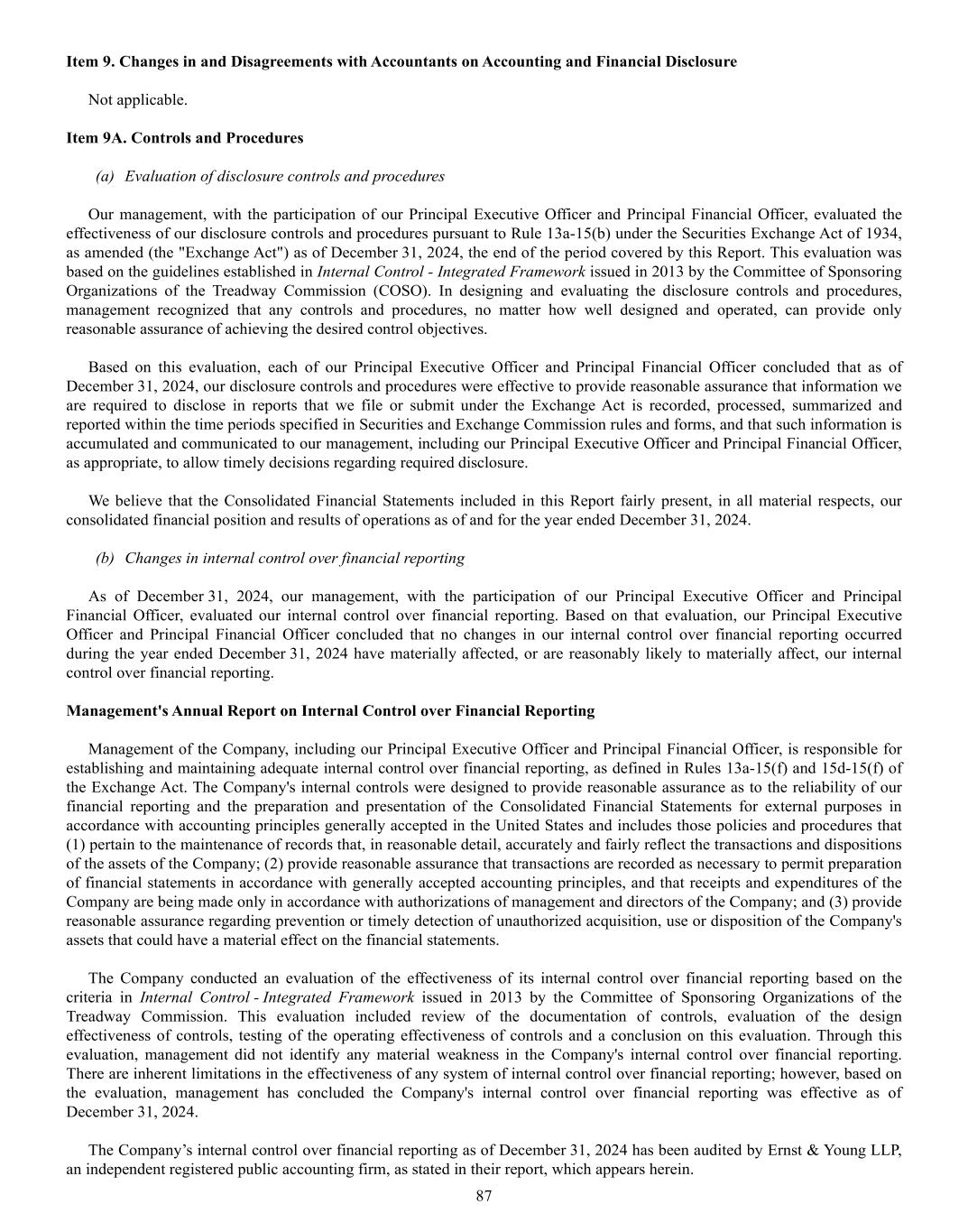
87 Item 9. Changes in and Disagreements with Accountants on Accounting and Financial Disclosure Not applicable. Item 9A. Controls and Procedures (a) Evaluation of disclosure controls and procedures Our management, with the participation of our Principal Executive Officer and Principal Financial Officer, evaluated the effectiveness of our disclosure controls and procedures pursuant to Rule 13a-15(b) under the Securities Exchange Act of 1934, as amended (the "Exchange Act") as of December 31, 2024, the end of the period covered by this Report. This evaluation was based on the guidelines established in Internal Control - Integrated Framework issued in 2013 by the Committee of Sponsoring Organizations of the Treadway Commission (COSO). In designing and evaluating the disclosure controls and procedures, management recognized that any controls and procedures, no matter how well designed and operated, can provide only reasonable assurance of achieving the desired control objectives. Based on this evaluation, each of our Principal Executive Officer and Principal Financial Officer concluded that as of December 31, 2024, our disclosure controls and procedures were effective to provide reasonable assurance that information we are required to disclose in reports that we file or submit under the Exchange Act is recorded, processed, summarized and reported within the time periods specified in Securities and Exchange Commission rules and forms, and that such information is accumulated and communicated to our management, including our Principal Executive Officer and Principal Financial Officer, as appropriate, to allow timely decisions regarding required disclosure. We believe that the Consolidated Financial Statements included in this Report fairly present, in all material respects, our consolidated financial position and results of operations as of and for the year ended December 31, 2024. (b) Changes in internal control over financial reporting As of December 31, 2024, our management, with the participation of our Principal Executive Officer and Principal Financial Officer, evaluated our internal control over financial reporting. Based on that evaluation, our Principal Executive Officer and Principal Financial Officer concluded that no changes in our internal control over financial reporting occurred during the year ended December 31, 2024 have materially affected, or are reasonably likely to materially affect, our internal control over financial reporting. Management's Annual Report on Internal Control over Financial Reporting Management of the Company, including our Principal Executive Officer and Principal Financial Officer, is responsible for establishing and maintaining adequate internal control over financial reporting, as defined in Rules 13a-15(f) and 15d-15(f) of the Exchange Act. The Company's internal controls were designed to provide reasonable assurance as to the reliability of our financial reporting and the preparation and presentation of the Consolidated Financial Statements for external purposes in accordance with accounting principles generally accepted in the United States and includes those policies and procedures that (1) pertain to the maintenance of records that, in reasonable detail, accurately and fairly reflect the transactions and dispositions of the assets of the Company; (2) provide reasonable assurance that transactions are recorded as necessary to permit preparation of financial statements in accordance with generally accepted accounting principles, and that receipts and expenditures of the Company are being made only in accordance with authorizations of management and directors of the Company; and (3) provide reasonable assurance regarding prevention or timely detection of unauthorized acquisition, use or disposition of the Company's assets that could have a material effect on the financial statements. The Company conducted an evaluation of the effectiveness of its internal control over financial reporting based on the criteria in Internal Control - Integrated Framework issued in 2013 by the Committee of Sponsoring Organizations of the Treadway Commission. This evaluation included review of the documentation of controls, evaluation of the design effectiveness of controls, testing of the operating effectiveness of controls and a conclusion on this evaluation. Through this evaluation, management did not identify any material weakness in the Company's internal control over financial reporting. There are inherent limitations in the effectiveness of any system of internal control over financial reporting; however, based on the evaluation, management has concluded the Company's internal control over financial reporting was effective as of December 31, 2024. The Company’s internal control over financial reporting as of December 31, 2024 has been audited by Ernst & Young LLP, an independent registered public accounting firm, as stated in their report, which appears herein.

88 Item 9B. Other Information Rule 10b5-1 Trading Plans During the fiscal quarter ended December 31, 2024, none of our directors or executive officers adopted or terminated any contract, instruction or written plan for the purchase or sale of Company securities that was intended to satisfy the affirmative defense conditions of Rule 10b5-1(c) (each, a “10b5-1 Plan”) or any non-Rule 10b5-1 trading arrangement. However, certain of our directors and executive officers may adopt 10b5-1 Plans or non-Rule 10b5-1 trading arrangements in the future. Item 9C. Disclosure Regarding Foreign Jurisdictions that Prevent Inspections Not applicable.
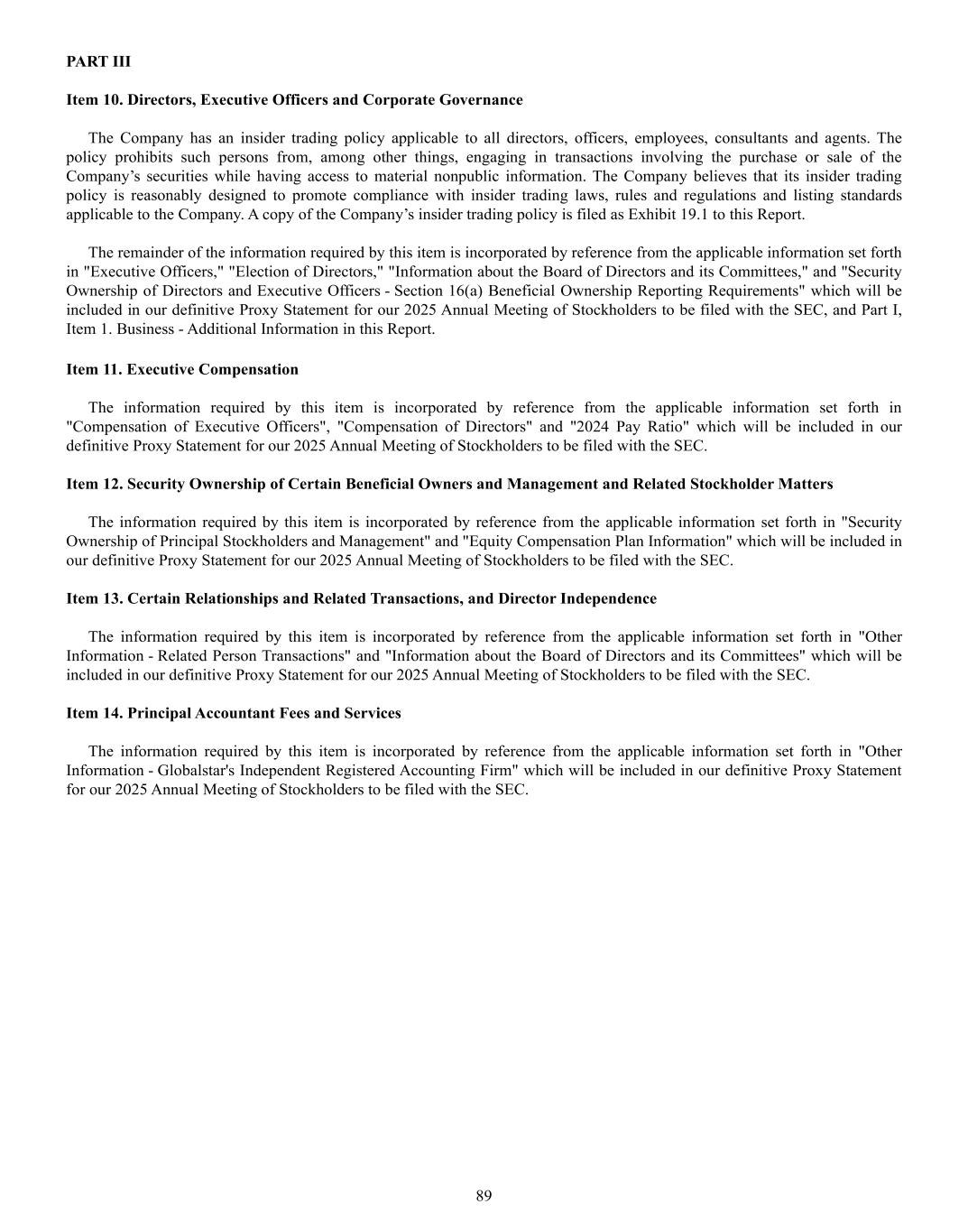
89 PART III Item 10. Directors, Executive Officers and Corporate Governance The Company has an insider trading policy applicable to all directors, officers, employees, consultants and agents. The policy prohibits such persons from, among other things, engaging in transactions involving the purchase or sale of the Company’s securities while having access to material nonpublic information. The Company believes that its insider trading policy is reasonably designed to promote compliance with insider trading laws, rules and regulations and listing standards applicable to the Company. A copy of the Company’s insider trading policy is filed as Exhibit 19.1 to this Report. The remainder of the information required by this item is incorporated by reference from the applicable information set forth in "Executive Officers," "Election of Directors," "Information about the Board of Directors and its Committees," and "Security Ownership of Directors and Executive Officers - Section 16(a) Beneficial Ownership Reporting Requirements" which will be included in our definitive Proxy Statement for our 2025 Annual Meeting of Stockholders to be filed with the SEC, and Part I, Item 1. Business - Additional Information in this Report. Item 11. Executive Compensation The information required by this item is incorporated by reference from the applicable information set forth in "Compensation of Executive Officers", "Compensation of Directors" and "2024 Pay Ratio" which will be included in our definitive Proxy Statement for our 2025 Annual Meeting of Stockholders to be filed with the SEC. Item 12. Security Ownership of Certain Beneficial Owners and Management and Related Stockholder Matters The information required by this item is incorporated by reference from the applicable information set forth in "Security Ownership of Principal Stockholders and Management" and "Equity Compensation Plan Information" which will be included in our definitive Proxy Statement for our 2025 Annual Meeting of Stockholders to be filed with the SEC. Item 13. Certain Relationships and Related Transactions, and Director Independence The information required by this item is incorporated by reference from the applicable information set forth in "Other Information - Related Person Transactions" and "Information about the Board of Directors and its Committees" which will be included in our definitive Proxy Statement for our 2025 Annual Meeting of Stockholders to be filed with the SEC. Item 14. Principal Accountant Fees and Services The information required by this item is incorporated by reference from the applicable information set forth in "Other Information - Globalstar's Independent Registered Accounting Firm" which will be included in our definitive Proxy Statement for our 2025 Annual Meeting of Stockholders to be filed with the SEC.

90 PART IV Item 15. Exhibits and Financial Statement Schedules (a) The following documents are filed as part of this Report: (1) Financial Statements and Report of Independent Registered Public Accounting Firm Report of Independent Registered Public Accounting Firm Consolidated balance sheets at December 31, 2024 and 2023 Consolidated statements of operations for the years ended December 31, 2024, 2023 and 2022 Consolidated statements of comprehensive income (loss) for the years ended December 31, 2024, 2023 and 2022 Consolidated statements of stockholders’ equity for the years ended December 31, 2024, 2023 and 2022 Consolidated statements of cash flows for the years ended December 31, 2024, 2023 and 2022 Notes to Consolidated Financial Statements (2) Financial Statement Schedules All schedules are omitted because they are not applicable or the required information is in the financial statements or notes thereto. (3) Exhibits See Exhibit Index Item 16. Form 10-K Summary None.

91 EXHIBIT INDEX Exhibit Number Description 3.1 Composite Certificate of Incorporation of Globalstar, Inc. 3.2* Fifth Amended and Restated Bylaws of Globalstar, Inc. (Exhibit 3.1 to Form 8-K filed on August 31, 2023) 3.3* Certificate of Designation filed November 15, 2022 (Exhibit 3.1 to Form 8-K filed on November 16, 2022) 4.1 Description of Registrant's Securities Registered Pursuant to Section 12 of the Securities Exchange Act of 1934 10.1* Settlement Agreement dated December 14, 2018 (Exhibit 10.1 to form 8-K filed December 17, 2018) 10.2* Lease Agreement by and between Globalstar, Inc. and Thermo Covington, LLC dated February 1, 2019 (Exhibit 10.1 to Form 10-Q filed May 2, 2019) 10.3*# Form of Indemnification Agreement between Globalstar, Inc. and its Directors dated February 26, 2019 (Exhibit 10.50 to Form 10-K filed February 28, 2019) 10.4*# Third Amended and Restated Globalstar, Inc. 2006 Equity Incentive Plan (Appendix A to Definitive Proxy Statement filed April 16, 2019) 10.5*# Amended and Restated Employee Stock Purchase Plan (Appendix B to Definitive Proxy Statement filed April 16, 2019) 10.6*# Form of Restricted Stock Units Agreement for Non-U.S. Designated Executives under the Globalstar, Inc. 2006 Equity Incentive Plan (Exhibit 10.2 to Form 10-Q filed August 14, 2007) 10.7*# Form of Notice of Grant and Restricted Stock Agreement under the Globalstar, Inc. 2006 Equity Incentive Plan (Exhibit 10.29 to Form 10-K filed March 17, 2008) 10.8*# Form of Non-Qualified Stock Option Award Agreement for Members of the Board of Directors under the Globalstar, Inc. 2006 Equity Incentive Plan (Exhibit 10.1 to Form 8-K filed November 20, 2008) 10.9*# Form of Stock Option Award Agreement for use with executive officers (Exhibit 10.45 to Form 10-K filed March 31, 2011) 10.10*††# 2022 Key Employee Bonus Plan (Exhibit 10.21 to Form 10-K filed February 25, 2022) 10.11*††# 2023 Key Employee Bonus Plan (Exhibit 10.5 to Form 10-Q filed May 5, 2023) 10.12††# 2024 Key Employee Bonus Plan 10.13*†† Satellite Procurement Agreement dated February 21, 2022 between Globalstar, Inc. and Macdonald, Dettwiler and Associates Corporation (Exhibit 10.1 to Form 10-Q filed May 5, 2022) 10.14*†† Exchange Agreement dated November 15, 2022 (Exhibit 10.1 to Form 8-K filed November 16, 2022) 10.15* Purchase Agreement, dated March 28, 2023, by and among Globalstar, Inc., the Subsidiary Guarantors party thereto and the Purchasers party thereto (Exhibit 10.1 to Form 8-K filed March 29, 2023) 10.16* Indenture (including form of Note) dated March 31, 2023, by and among Globalstar, Inc., the Subsidiary Guarantors party thereto and Wilmington Trust, National Association (Exhibit 10.1 to Form 8-K filed April 6, 2023) 10.17*†† Collateral Agreement dated April 6, 2023 by and among Globalstar, Inc. the grantors and guarantors party thereto and Customer (Exhibit 10.2 to Form 8-K filed April 6, 2023) 10.18*†† Amended and Restated Prepayment Agreement dated May 19, 2021 (Exhibit 10.1 to Form 10-Q filed August 5, 2021) 10.19*†† 2023 Prepayment Agreement (Exhibit 10.6 to Form 10-Q filed May 5, 2023) 10.20†† Amendment No. 2 to 2023 Prepayment Agreement by and between Globalstar, Inc. and Customer dated as of November 5, 2024 10.21†† 2024 Prepayment Agreement by and between Globalstar, Inc. and Customer dated as of November 5, 2024 10.22*†† Conformed Copy of Key Terms Agreement reflecting amendments through September 7, 2022 (Exhibit 10.1 to Form 8-K filed September 7, 2022) 10.23*†† Amendment No. 4 to the Key Terms Agreement (Exhibit 10.7 to Form 10-Q filed May 5, 2023) 10.24†† Amendment No. 5 to the Key Terms Agreement between Customer and Globalstar dated November 5, 2024

92 10.25†† Statement of Work by and between Customer Parent and Globalstar, Inc. dated as of November 5, 2024 10.26*†† Intellectual Property License Agreement between XCOM Labs, Inc. and Globalstar, Inc. dated August 29, 2023 (Exhibit 10.37 to Form S-1 filed September 8, 2023) 10.27*†† Support Services Agreement by and between XCOM Labs, Inc. and Globalstar, Inc. dated August 29, 2023 (Exhibit 10.38 to Form S-1 filed September 8, 2023) 10.28*††# Amended and Restated Employment Agreement dated January 24, 2024 by and between Globalstar, Inc. and Paul Jacobs (Exhibit 10.24 to Form 10-K filed February 29, 2024) 10.29*†† Guaranty dated as of December 7, 2023 made by Thermo Funding II, LLC (Exhibit 10.25 to Form 10-K filed February 29, 2024) 10.30* Common Stock Purchase Warrant between Thermo Funding II, LLC and Globalstar, Inc. dated December 7, 2023 (Exhibit 10.26 to Form 10-K filed February 29, 2024) 10.31*†† Second Forbearance Agreement among Globalstar, Inc., Macdonald, Dettwiler and Associates Corporation and Rocket Lab USA, Inc. dated January 31, 2023 (Exhibit 10.30 to Form 10-K filed March 1, 2023) 10.32*†† Conformed copy of Amendment to Support Services Agreement by and between Virewirx, Inc. and Globalstar, Inc. dated June 28, 2024 (Exhibit 10.1 to Form 10-Q filed August 8, 2024) 10.33†† Purchase Agreement by and among Globalstar, Inc., Globalstar Licensee LLC and Customer Parent dated as of October 29, 2024 10.34†† Contribution Agreement by and among Globalstar, Inc., GCL Licensee LLC and Globalstar Licensee LLC dated as of November 5, 2024 10.35†† Second Amended and Restated Limited Liability Company Agreement for Globalstar Licensee LLC by and among Globalstar, Inc. and Customer Parent dated as of November 5, 2024 10.36†† First Amendment to Guarantee and Collateral Agreement by and among Globalstar, Inc., the other Guarantors signatory hereto, and Customer dated as of November 5, 2024 19.1 Globalstar, Inc. Insider Trading Policy 21.1 Subsidiaries of Globalstar, Inc. 23.1 Consent of Ernst & Young LLP 24.1 Power of Attorney (included as part of page titled "Signatures") 31.1 Section 302 Certification of Principal Executive Officer of Globalstar, Inc. 31.2 Section 302 Certification of Principal Financial Officer of Globalstar, Inc. 32.1 Section 906 Certification of Principal Executive Officer of Globalstar, Inc. 32.2 Section 906 Certification of Principal Financial Officer of Globalstar, Inc. 97.1 Globalstar, Inc. Executive Compensation Clawback Policy 101.INS XBRL Instance Document 101.SCH XBRL Taxonomy Extension Schema Document 101.CAL XBRL Taxonomy Extension Calculation Linkbase Document 101.DEF XBRL Taxonomy Extension Definition Linkbase Document 101.PRE XBRL Taxonomy Extension Presentation Linkbase Document 101.LAB XBRL Taxonomy Extension Label Linkbase Document * Incorporated by reference. †† Portions of the exhibit have been omitted pursuant to Item 601(b)(10) of Regulation S-K. # Management contract or compensatory plan or arrangement.
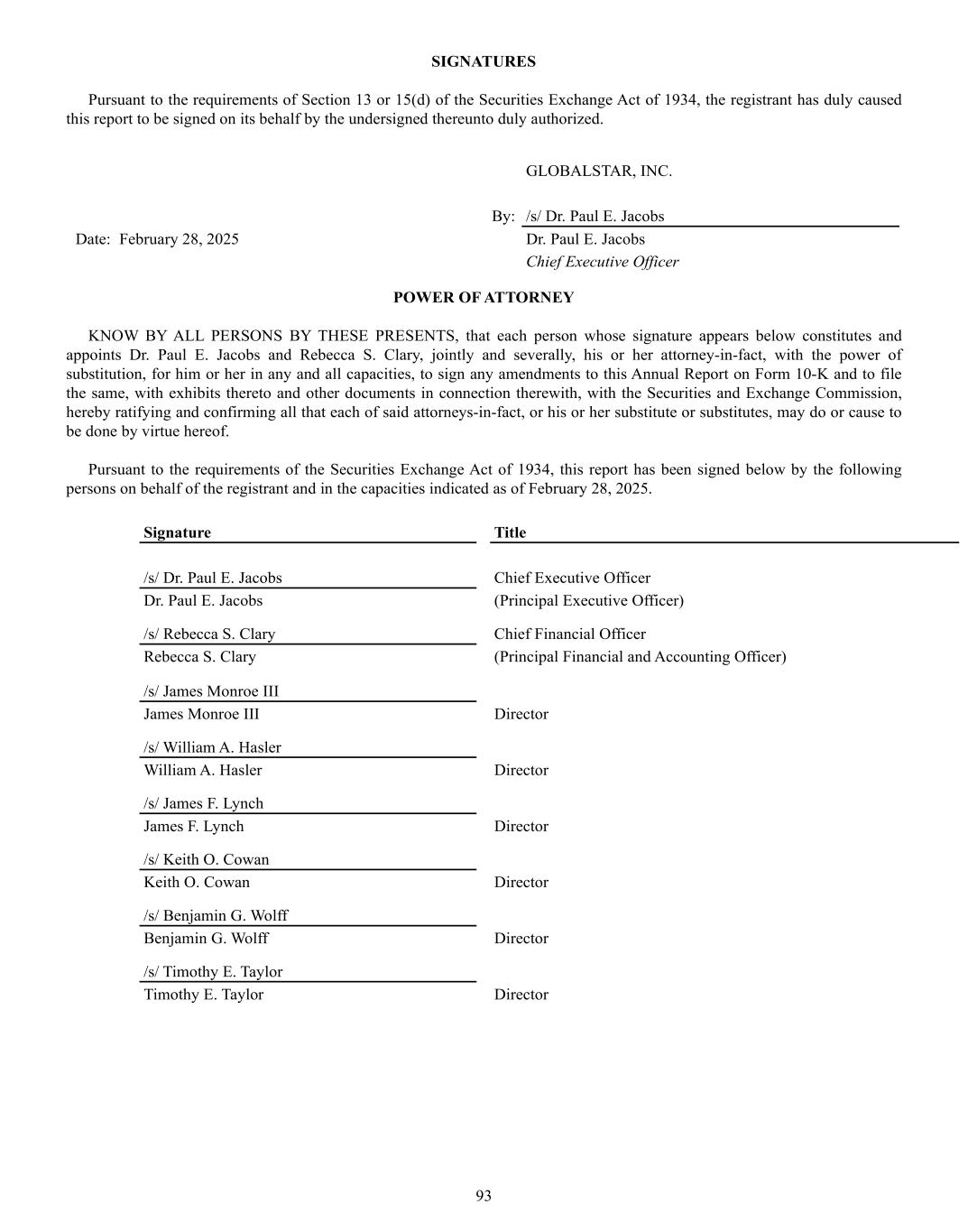
93 SIGNATURES Pursuant to the requirements of Section 13 or 15(d) of the Securities Exchange Act of 1934, the registrant has duly caused this report to be signed on its behalf by the undersigned thereunto duly authorized. GLOBALSTAR, INC. By: /s/ Dr. Paul E. Jacobs Date: February 28, 2025 Dr. Paul E. Jacobs Chief Executive Officer POWER OF ATTORNEY KNOW BY ALL PERSONS BY THESE PRESENTS, that each person whose signature appears below constitutes and appoints Dr. Paul E. Jacobs and Rebecca S. Clary, jointly and severally, his or her attorney-in-fact, with the power of substitution, for him or her in any and all capacities, to sign any amendments to this Annual Report on Form 10-K and to file the same, with exhibits thereto and other documents in connection therewith, with the Securities and Exchange Commission, hereby ratifying and confirming all that each of said attorneys-in-fact, or his or her substitute or substitutes, may do or cause to be done by virtue hereof. Pursuant to the requirements of the Securities Exchange Act of 1934, this report has been signed below by the following persons on behalf of the registrant and in the capacities indicated as of February 28, 2025. Signature Title /s/ Dr. Paul E. Jacobs Chief Executive Officer Dr. Paul E. Jacobs (Principal Executive Officer) /s/ Rebecca S. Clary Chief Financial Officer Rebecca S. Clary (Principal Financial and Accounting Officer) /s/ James Monroe III James Monroe III Director /s/ William A. Hasler William A. Hasler Director /s/ James F. Lynch James F. Lynch Director /s/ Keith O. Cowan Keith O. Cowan Director /s/ Benjamin G. Wolff Benjamin G. Wolff Director /s/ Timothy E. Taylor Timothy E. Taylor Director

Exhibit 31.1 Certification of Principal Executive Officer of Globalstar, Inc. Pursuant to Rule 13a-14(a) and Rule 15d-14(a) of the Securities Exchange Act of 1934, as amended I, Dr. Paul E. Jacobs, certify that: 1. I have reviewed this annual report on Form 10-K of Globalstar, Inc.; 2. Based on my knowledge, this report does not contain any untrue statement of a material fact or omit to state a material fact necessary to make the statements made, in light of the circumstances under which such statements were made, not misleading with respect to the period covered by this report; 3. Based on my knowledge, the financial statements, and other financial information included in this report, fairly present in all material respects the financial condition, results of operations and cash flows of the registrant as of, and for, the periods presented in this report; 4. I am responsible for establishing and maintaining disclosure controls and procedures (as defined in Exchange Act Rules 13a-15(e) and 15(d)-15(e)) and internal control over financial reporting (as defined in Exchange Act Rule 13a- 15(f) and 15d-15(f)) for the registrant and have: (a) Designed such disclosure controls and procedures, or caused such disclosure controls and procedures to be designed under my supervision, to ensure that material information relating to the registrant, including its consolidated subsidiaries, is made known to me by others within those entities, particularly during the period in which this report is being prepared; (b) Designed such internal control over financial reporting, or caused such internal control over financial reporting to be designed under my supervision, to provide reasonable assurance regarding the reliability of financial reporting and the preparation of financial statements for external purposes in accordance with generally accepted accounting principles; (c) Evaluated the effectiveness of the registrant’s disclosure controls and procedures and presented in this report my conclusion about the effectiveness of the disclosure controls and procedures, as of the end of the period covered by this report based on such evaluation; and (d) Disclosed in this report any change in the registrant’s internal control over financial reporting that occurred during the registrant’s most recent fiscal quarter (the registrant’s fourth fiscal quarter in the case of an annual report) that has materially affected, or is reasonably likely to materially affect, the registrant’s internal control over financial reporting; and 5. I have disclosed, based on my most recent evaluation of internal control over financial reporting, to the registrant’s auditors and the audit committee of the registrant’s board of directors (or persons performing the equivalent functions): (a) All significant deficiencies and material weaknesses in the design or operation of internal control over financial reporting which are reasonably likely to adversely affect the registrant’s ability to record, process, summarize and report financial information; and (b) Any fraud, whether or not material, that involves management or other employees who have a significant role in the registrant’s internal control over financial reporting. Date: February 28, 2025 By: /s/ Dr. Paul E. Jacobs Dr. Paul E. Jacobs Chief Executive Officer (Principal Executive Officer)
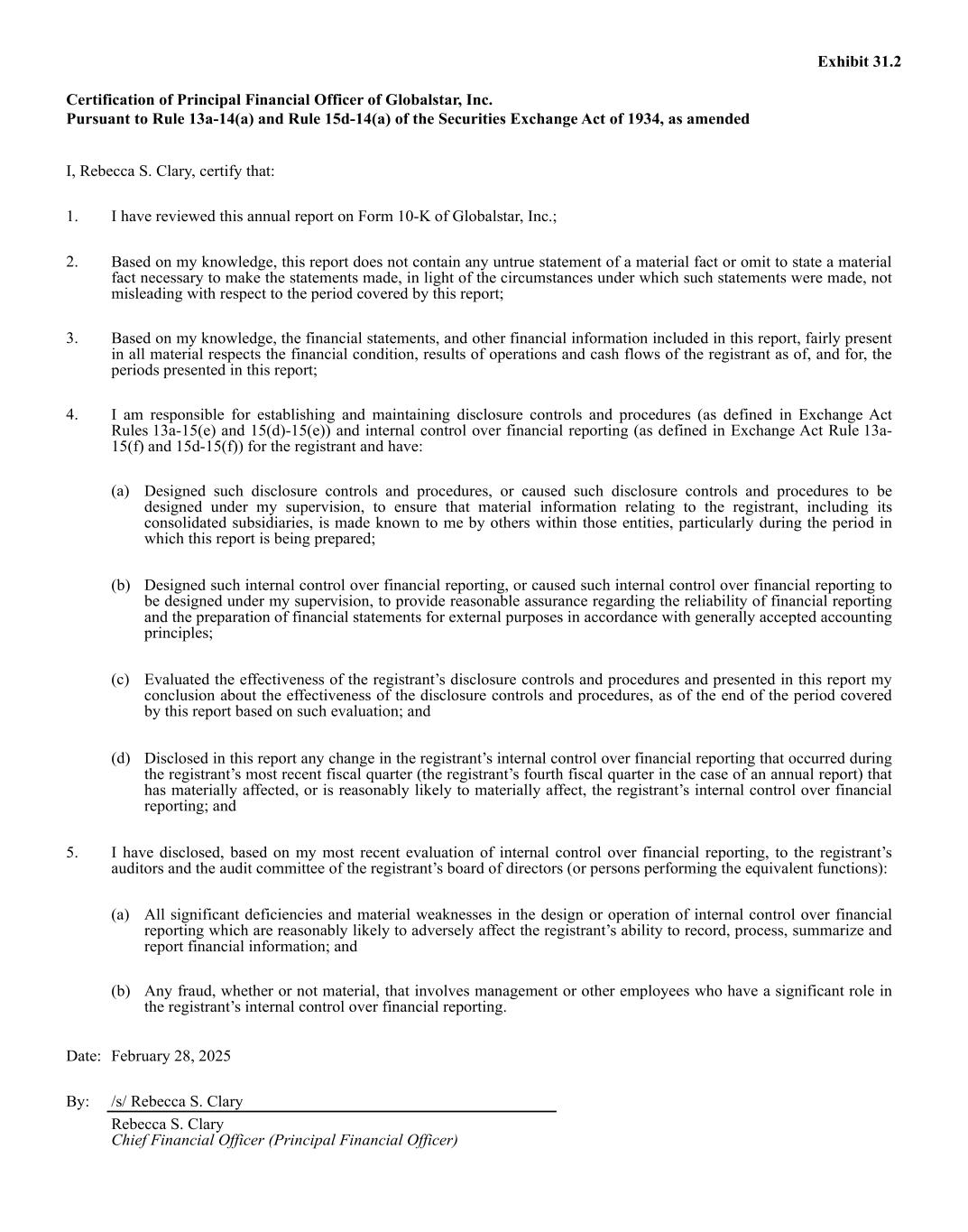
Exhibit 31.2 Certification of Principal Financial Officer of Globalstar, Inc. Pursuant to Rule 13a-14(a) and Rule 15d-14(a) of the Securities Exchange Act of 1934, as amended I, Rebecca S. Clary, certify that: 1. I have reviewed this annual report on Form 10-K of Globalstar, Inc.; 2. Based on my knowledge, this report does not contain any untrue statement of a material fact or omit to state a material fact necessary to make the statements made, in light of the circumstances under which such statements were made, not misleading with respect to the period covered by this report; 3. Based on my knowledge, the financial statements, and other financial information included in this report, fairly present in all material respects the financial condition, results of operations and cash flows of the registrant as of, and for, the periods presented in this report; 4. I am responsible for establishing and maintaining disclosure controls and procedures (as defined in Exchange Act Rules 13a-15(e) and 15(d)-15(e)) and internal control over financial reporting (as defined in Exchange Act Rule 13a- 15(f) and 15d-15(f)) for the registrant and have: (a) Designed such disclosure controls and procedures, or caused such disclosure controls and procedures to be designed under my supervision, to ensure that material information relating to the registrant, including its consolidated subsidiaries, is made known to me by others within those entities, particularly during the period in which this report is being prepared; (b) Designed such internal control over financial reporting, or caused such internal control over financial reporting to be designed under my supervision, to provide reasonable assurance regarding the reliability of financial reporting and the preparation of financial statements for external purposes in accordance with generally accepted accounting principles; (c) Evaluated the effectiveness of the registrant’s disclosure controls and procedures and presented in this report my conclusion about the effectiveness of the disclosure controls and procedures, as of the end of the period covered by this report based on such evaluation; and (d) Disclosed in this report any change in the registrant’s internal control over financial reporting that occurred during the registrant’s most recent fiscal quarter (the registrant’s fourth fiscal quarter in the case of an annual report) that has materially affected, or is reasonably likely to materially affect, the registrant’s internal control over financial reporting; and 5. I have disclosed, based on my most recent evaluation of internal control over financial reporting, to the registrant’s auditors and the audit committee of the registrant’s board of directors (or persons performing the equivalent functions): (a) All significant deficiencies and material weaknesses in the design or operation of internal control over financial reporting which are reasonably likely to adversely affect the registrant’s ability to record, process, summarize and report financial information; and (b) Any fraud, whether or not material, that involves management or other employees who have a significant role in the registrant’s internal control over financial reporting. Date: February 28, 2025 By: /s/ Rebecca S. Clary Rebecca S. Clary Chief Financial Officer (Principal Financial Officer)
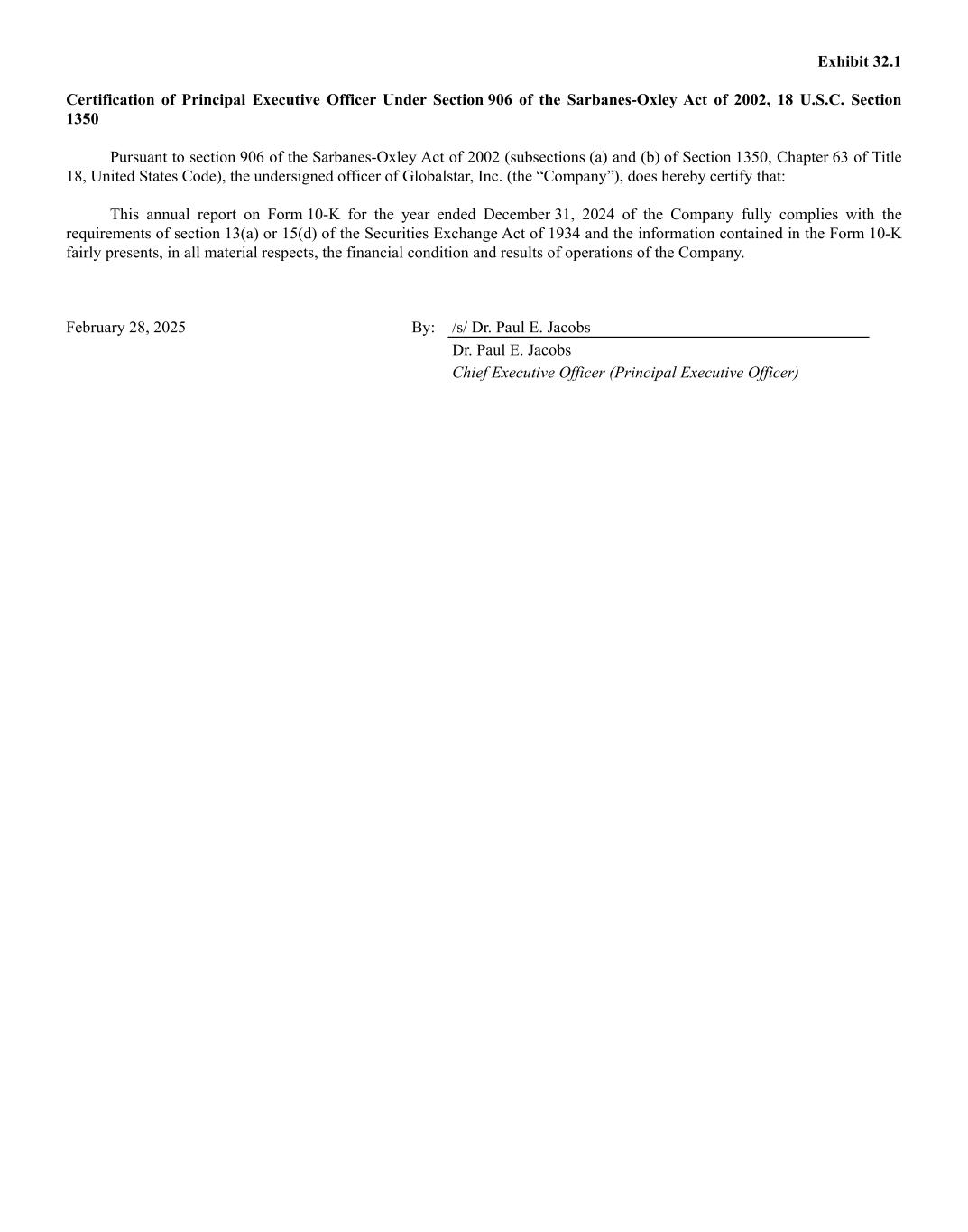
Exhibit 32.1 Certification of Principal Executive Officer Under Section 906 of the Sarbanes-Oxley Act of 2002, 18 U.S.C. Section 1350 Pursuant to section 906 of the Sarbanes-Oxley Act of 2002 (subsections (a) and (b) of Section 1350, Chapter 63 of Title 18, United States Code), the undersigned officer of Globalstar, Inc. (the “Company”), does hereby certify that: This annual report on Form 10-K for the year ended December 31, 2024 of the Company fully complies with the requirements of section 13(a) or 15(d) of the Securities Exchange Act of 1934 and the information contained in the Form 10-K fairly presents, in all material respects, the financial condition and results of operations of the Company. February 28, 2025 By: /s/ Dr. Paul E. Jacobs Dr. Paul E. Jacobs Chief Executive Officer (Principal Executive Officer)
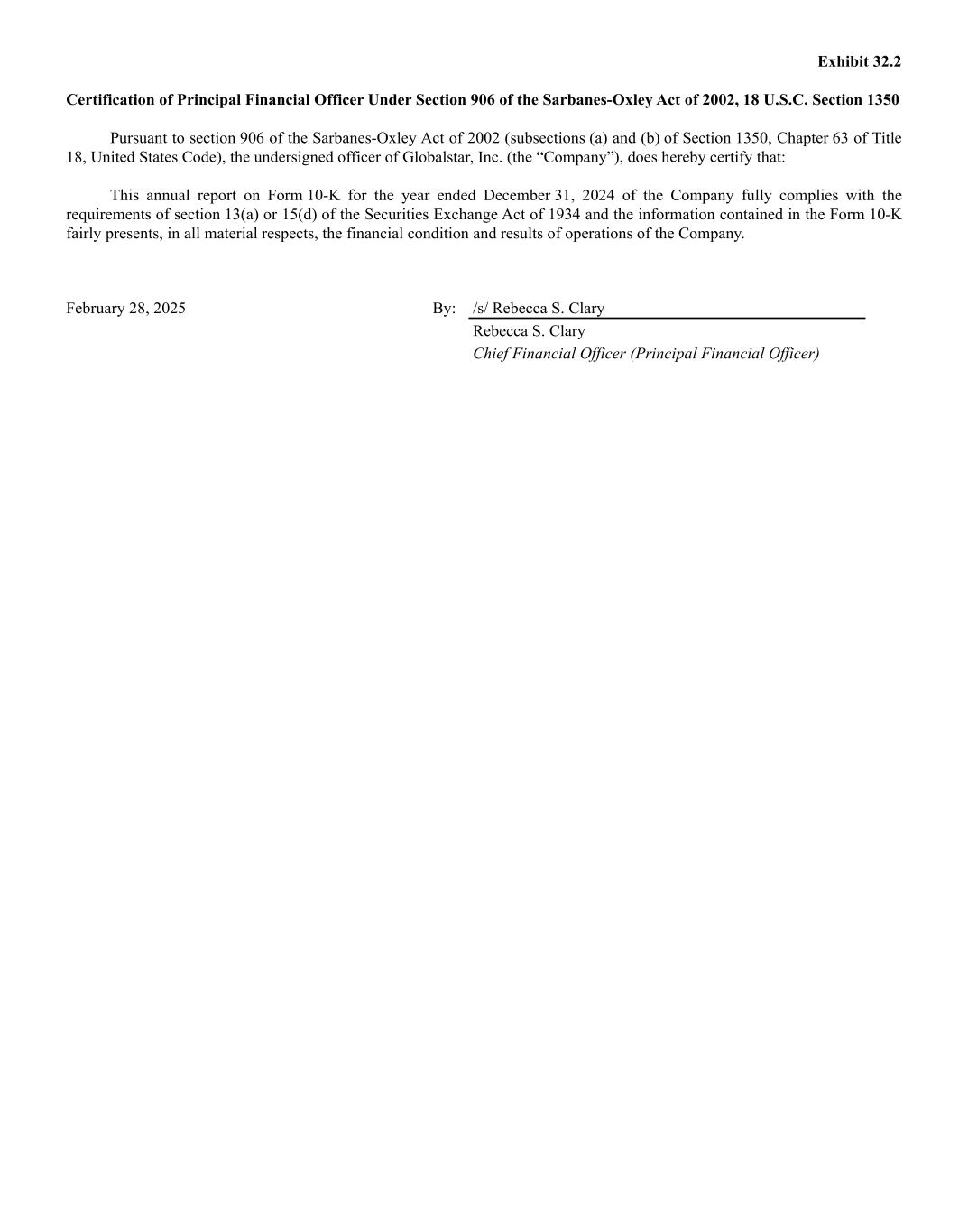
Exhibit 32.2 Certification of Principal Financial Officer Under Section 906 of the Sarbanes-Oxley Act of 2002, 18 U.S.C. Section 1350 Pursuant to section 906 of the Sarbanes-Oxley Act of 2002 (subsections (a) and (b) of Section 1350, Chapter 63 of Title 18, United States Code), the undersigned officer of Globalstar, Inc. (the “Company”), does hereby certify that: This annual report on Form 10-K for the year ended December 31, 2024 of the Company fully complies with the requirements of section 13(a) or 15(d) of the Securities Exchange Act of 1934 and the information contained in the Form 10-K fairly presents, in all material respects, the financial condition and results of operations of the Company. February 28, 2025 By: /s/ Rebecca S. Clary Rebecca S. Clary Chief Financial Officer (Principal Financial Officer)
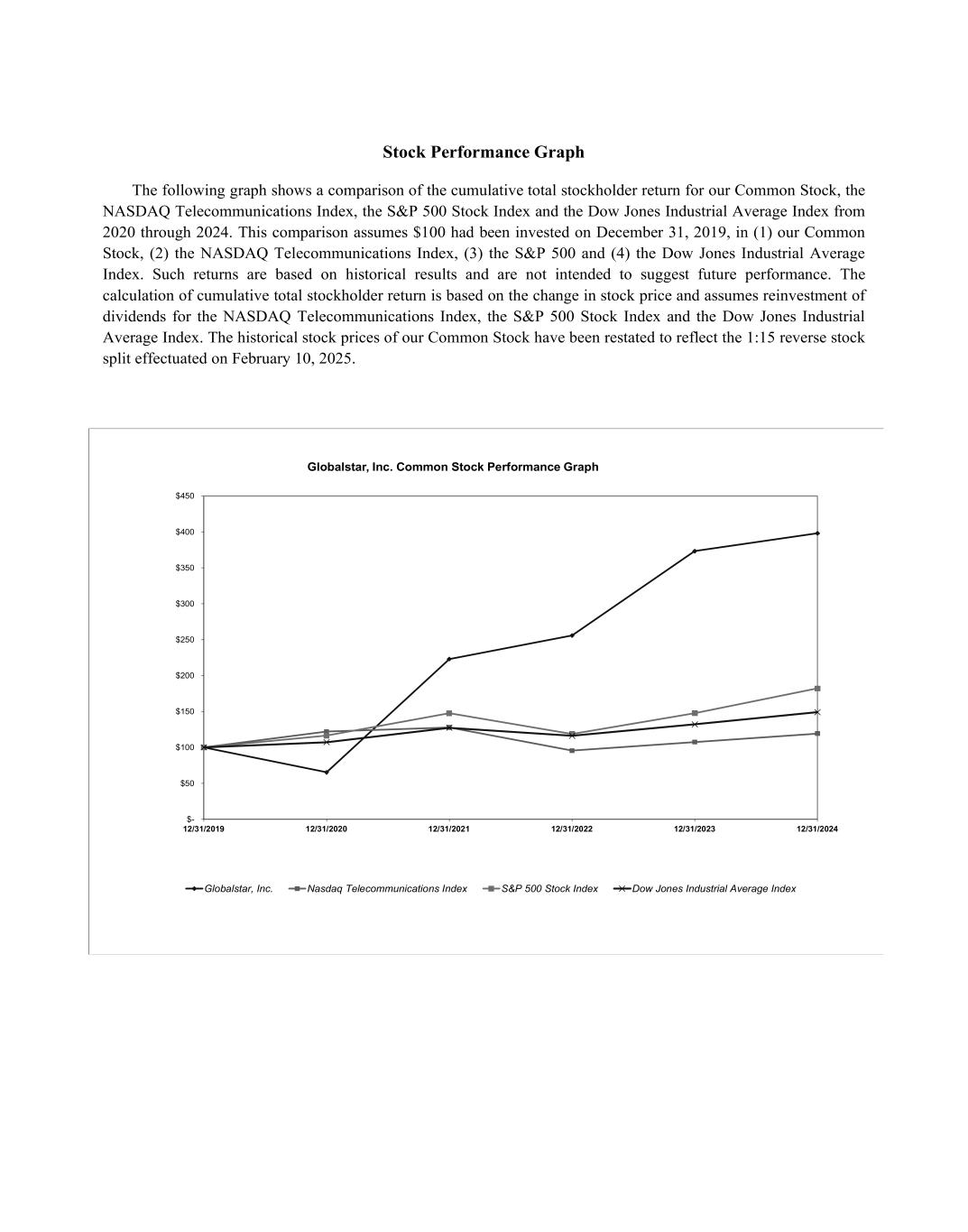
Stock Performance Graph The following graph shows a comparison of the cumulative total stockholder return for our Common Stock, the NASDAQ Telecommunications Index, the S&P 500 Stock Index and the Dow Jones Industrial Average Index from 2020 through 2024. This comparison assumes $100 had been invested on December 31, 2019, in (1) our Common Stock, (2) the NASDAQ Telecommunications Index, (3) the S&P 500 and (4) the Dow Jones Industrial Average Index. Such returns are based on historical results and are not intended to suggest future performance. The calculation of cumulative total stockholder return is based on the change in stock price and assumes reinvestment of dividends for the NASDAQ Telecommunications Index, the S&P 500 Stock Index and the Dow Jones Industrial Average Index. The historical stock prices of our Common Stock have been restated to reflect the 1:15 reverse stock split effectuated on February 10, 2025. $- $50 $100 $150 $200 $250 $300 $350 $400 $450 12/31/2019 12/31/2020 12/31/2021 12/31/2022 12/31/2023 12/31/2024 Globalstar, Inc. Common Stock Performance Graph Globalstar, Inc. Nasdaq Telecommunications Index S&P 500 Stock Index Dow Jones Industrial Average Index
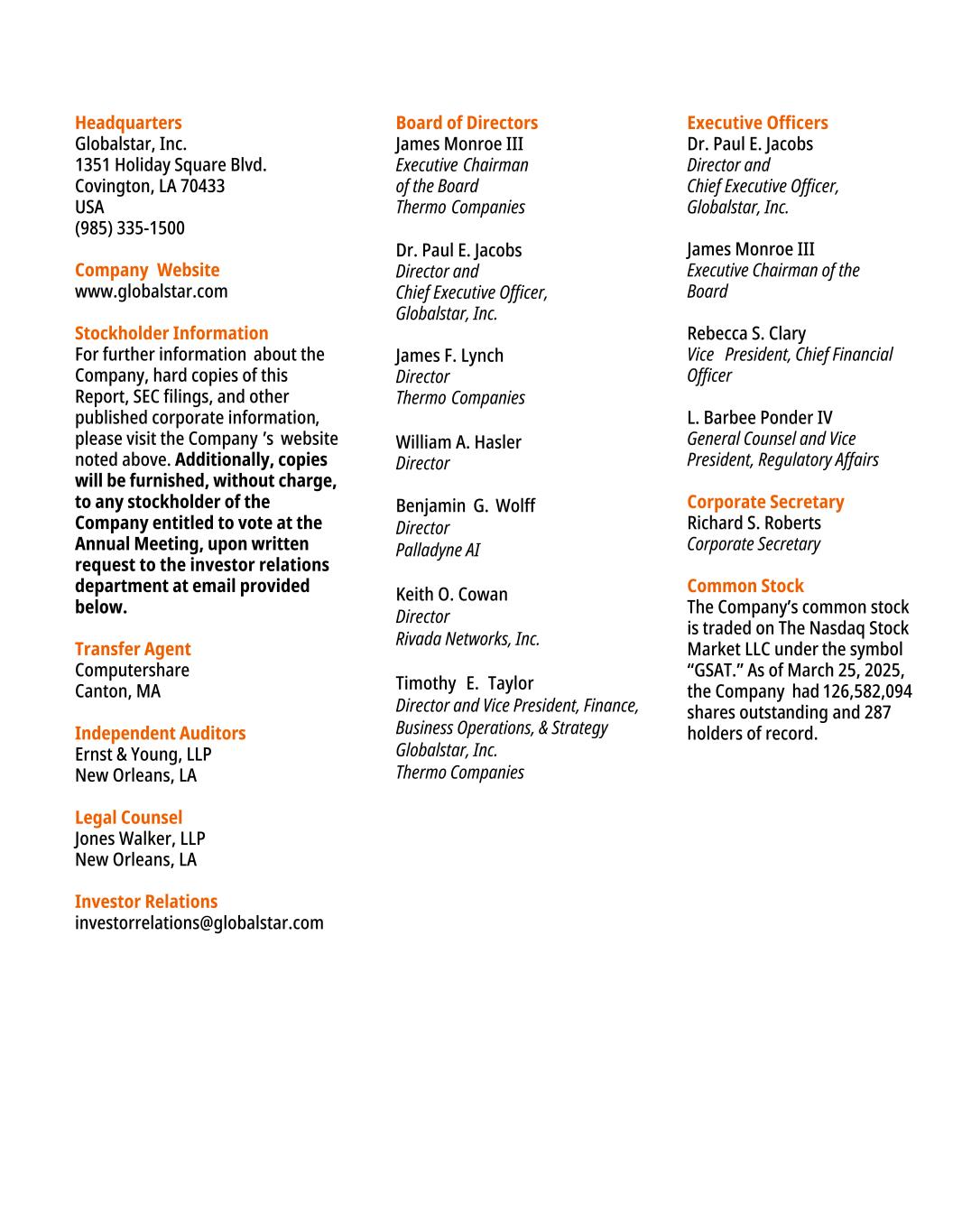
2 Dear Stockholders, As we reflect on the achievements of 2024, I am proud of our strengthened position as a leader in both satellite and terrestrial connectivity markets. This past year has been transformative, marked by strategic milestones, technological advancements, and financial growth that have collectively enhanced our competitive edge, enabling our next phase of growth. During the last twelve months, we have actively engaged with you - our stockholders - as well as industry leaders and other supporters of Globalstar in various forums. In December, it was a pleasure meeting with so many of you during our analyst and investor day, where our executive leadership team outlined our strategic priorities and growth strategy as well as provided updates to our short and long-term financial outlook. These presentations and several customer panels during the event are available for replay on Globalstar’s investor relations website under “Events and Presentations”. Globalstar also had a strong presence at Mobile World Congress in Barcelona, Spain in March 2025. At this premier mobile technology event, we were able to showcase our diverse solution set of connectivity products and services, including a live demonstration of XCOM RAN utilizing Globalstar’s Band 53TM, a milestone described in more detail below. We also hosted the International Telecommunication Union (ITU) Secretary General, Doreen Bogdan-Martin, and her delegation at Globalstar’s booth to express our support for the ITU’s Partner2Connect initiative, as well as held meetings with other international administrations’ delegations who were in attendance. Also in March, we held a grand opening of Globalstar’s new satellite operations control center at the Company’s headquarters in Covington, Louisiana. This milestone marks a significant expansion of our operational capabilities and reinforces our strategic growth as we extend our current network with capabilities for next-generation satellite and connectivity solutions. The grand opening event was attended by notable representatives and local dignitaries, including House Majority Leader Steve Scalise and FCC Chairman Brendan Carr. Operational Highlights and Strategic Developments During the last twelve months, we have seen remarkable progress in our product development capabilities. Under new leadership, our team successfully delivered a full two-way satellite commercial IoT solution, transitioning from our previous one-way tracking and telemetry applications. We believe that this advancement positions us to compete aggressively for subscribers in existing markets ripe for disruption. The globally harmonized L- and S-band mobile satellite spectrum that has been licensed to us for over 30 years continues to provide a stable platform for innovating connectivity solutions. We believe that we have the most successful and well-utilized mobile satellite service (“MSS”) band, with plans to further intensify the usage of our licensed spectrum. Our bent pipe architecture further differentiates Globalstar, allowing for rapid deployment of new innovations while others either borrow spectrum or deploy additional satellites to match our capabilities. ANNUAL REPORT 2024 Headquarters Globalstar, Inc. 1351 Holiday Square Blvd. Covington, LA 70433 USA (985) 335-1500 Company Website www.globalstar.com Stockholder Information For further information about the Company, hard copies of this Report, SEC filings, and other published corporate information, please visit the Company ’s website noted above. Additionally, copies will be furnished, without charge, to any stockholder of the Company entitled to vote at the Annual Meeting, upon written request to the investor relations department at email provided below. Transfer Agent Computershare Canton, MA Independent Auditors Ernst & Young, LLP New Orleans, LA Legal Counsel Jones Walker, LLP New Orleans, LA Investor Relations investorrelations@globalstar.com Executive Officers Dr. Paul E. Jacobs Director and Chief Executive Officer, Globalstar, Inc. James Monroe III Executive Chairman of the Board Rebecca S. Clary Vice President, Chief Financial Officer L. Barbee Ponder IV General Counsel and Vice President, Regulatory Affairs Corporate Secretary Richard S. Roberts Corporate Secretary Common Stock The Company’s common stock is traded on The Nasdaq Stock Market LLC under the symbol “GSAT.” As of March 25, 2025, the Company had 126,582,094 shares outsta nding and 287 holders of record. Board of Directors James Monroe III Executive Chairman of the Board Thermo Companies Dr. Paul E. Jacobs Director and Chief Executive Officer, Globalstar, Inc. James F. Lynch Director Thermo Companies William A. Hasler Director Benjamin G. Wolff Director Palladyne AI Keith O. Cowan Director Rivada Networks, Inc. Timothy E. Taylor Director and Vice President, Finance, Business Operations, & Strategy Globalstar, Inc. Thermo Companies

2 Dear Stockholders, As we reflect on the achievements of 2024, I am proud of our strengthened position as a leader in both satellite and terrestrial connectivity markets. This past year has been transformative, marked by strategic milestones, technological advancements, and financial growth that have collectively enhanced our competitive edge, enabling our next phase of growth. During the last twelve months, we have actively engaged with you - our stockholders - as well as industry leaders and other supporters of Globalstar in various forums. In December, it was a pleasure meeting with so many of you during our analyst and investor day, where our executive leadership team outlined our strategic priorities and growth strategy as well as provided updates to our short and long-term financial outlook. These presentations and several customer panels during the event are available for replay on Globalstar’s investor relations website under “Events and Presentations”. Globalstar also had a strong presence at Mobile World Congress in Barcelona, Spain in March 2025. At this premier mobile technology event, we were able to showcase our diverse solution set of connectivity products and services, including a live demonstration of XCOM RAN utilizing Globalstar’s Band 53TM, a milestone described in more detail below. We also hosted the International Telecommunication Union (ITU) Secretary General, Doreen Bogdan-Martin, and her delegation at Globalstar’s booth to express our support for the ITU’s Partner2Connect initiative, as well as held meetings with other international administrations’ delegations who were in attendance. Also in March, we held a grand opening of Globalstar’s new satellite operations control center at the Company’s headquarters in Covington, Louisiana. This milestone marks a significant expansion of our operational capabilities and reinforces our strategic growth as we extend our current network with capabilities for next-generation satellite and connectivity solutions. The grand opening event was attended by notable representatives and local dignitaries, including House Majority Leader Steve Scalise and FCC Chairman Brendan Carr. Operational Highlights and Strategic Developments During the last twelve months, we have seen remarkable progress in our product development capabilities. Under new leadership, our team successfully delivered a full two-way satellite commercial IoT solution, transitioning from our previous one-way tracking and telemetry applications. We believe that this advancement positions us to compete aggressively for subscribers in existing markets ripe for disruption. The globally harmonized L- and S-band mobile satellite spectrum that has been licensed to us for over 30 years continues to provide a stable platform for innovating connectivity solutions. We believe that we have the most successful and well-utilized mobile satellite service (“MSS”) band, with plans to further intensify the usage of our licensed spectrum. Our bent pipe architecture further differentiates Globalstar, allowing for rapid deployment of new innovations while others either borrow spectrum or deploy additional satellites to match our capabilities. ANNUAL REPORT 2024 1 2024 ANNUAL REPORT Globalstar.com 1351 Holiday Square Blvd | Covington, LA 70433 | 877-452-5782